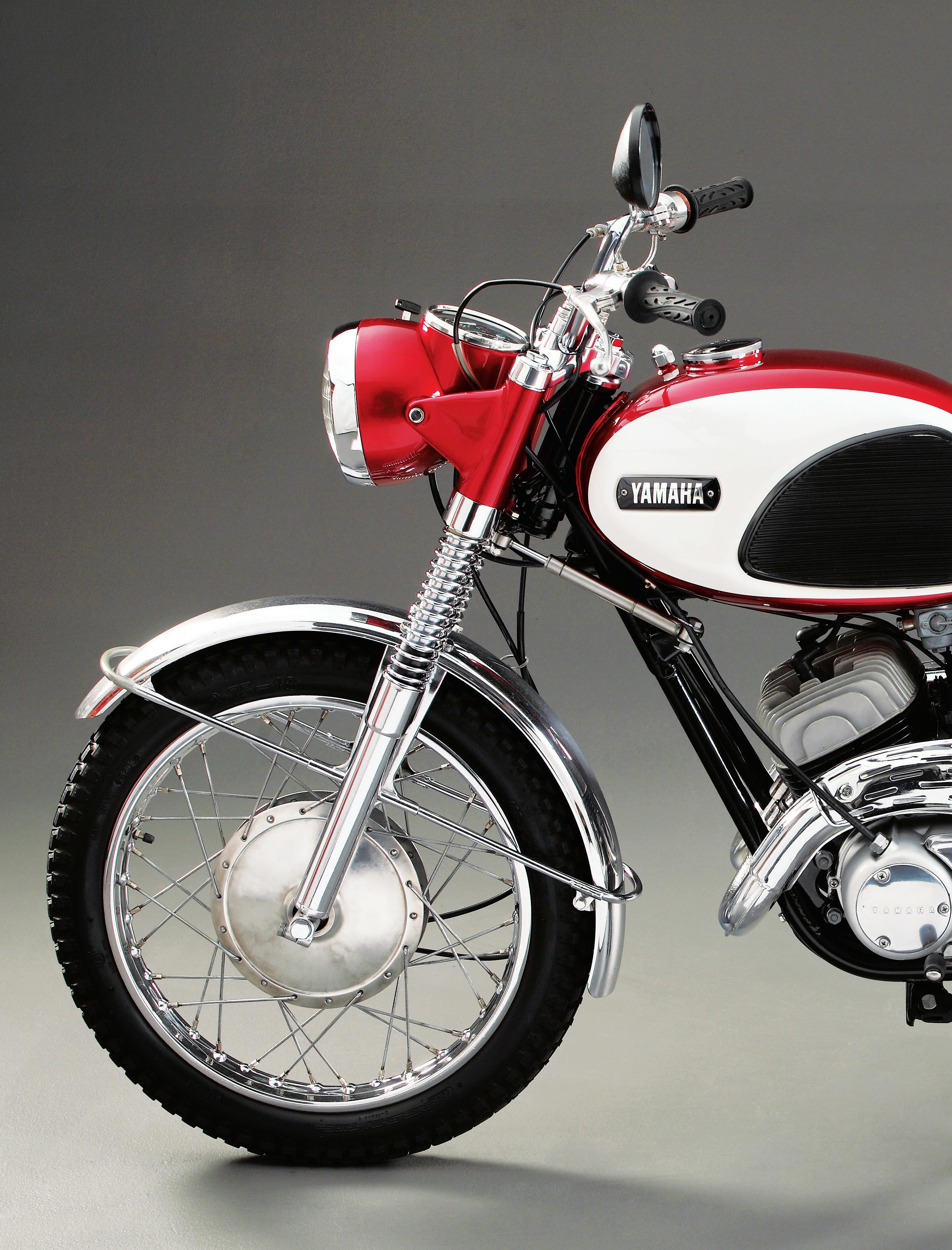

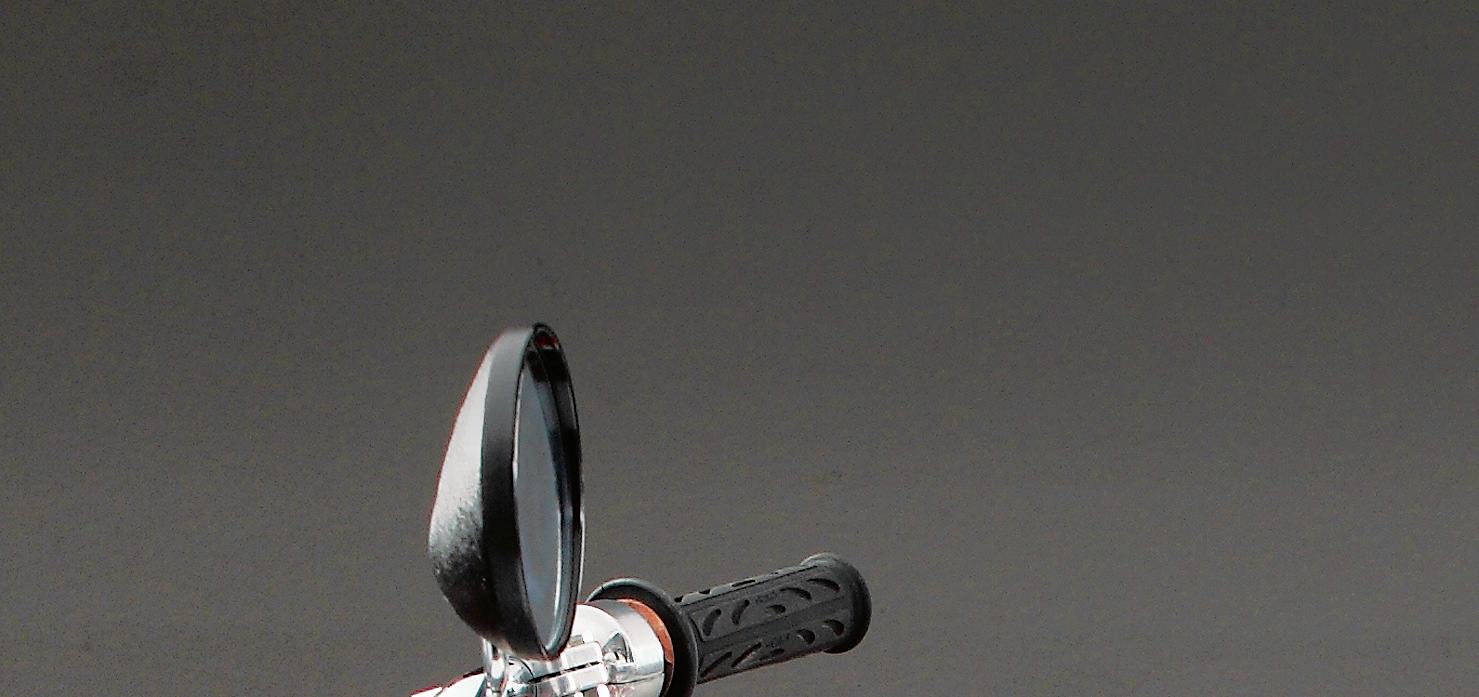
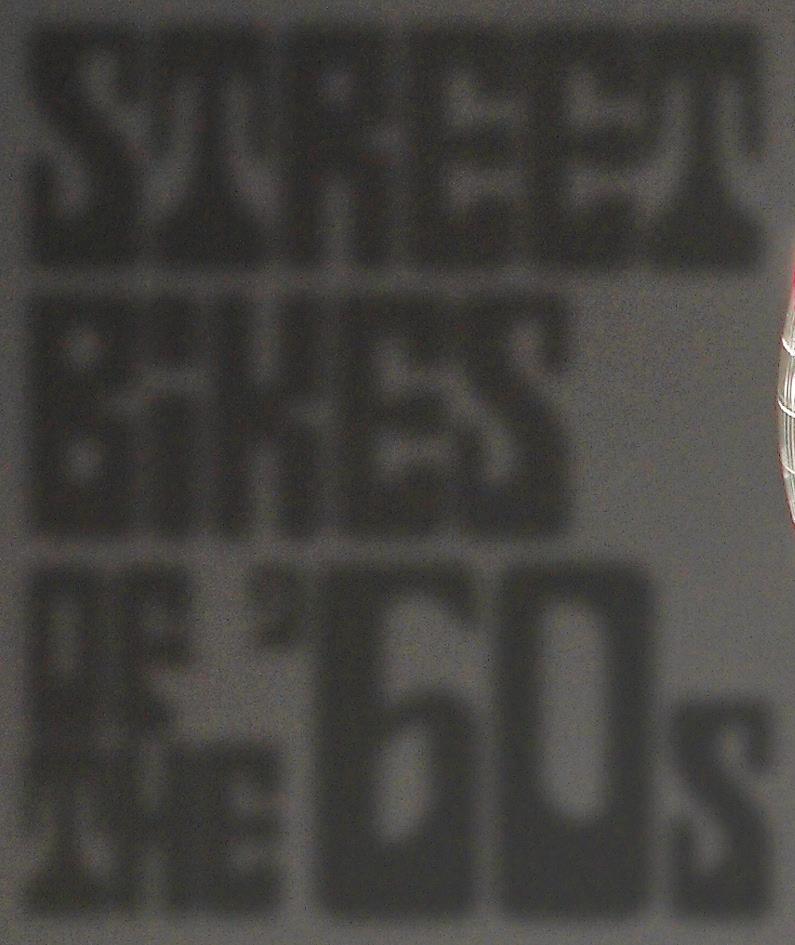
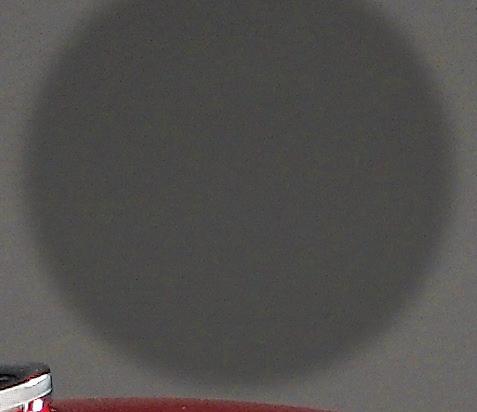



RIDE `EM, DON’T HIDE `EM MOTORCYCLE CLASSICS • SPECIAL COLLECTOR EDITION • STREET BIKES OF THE '60S $6.99 • Special • Display Until Oct. 31










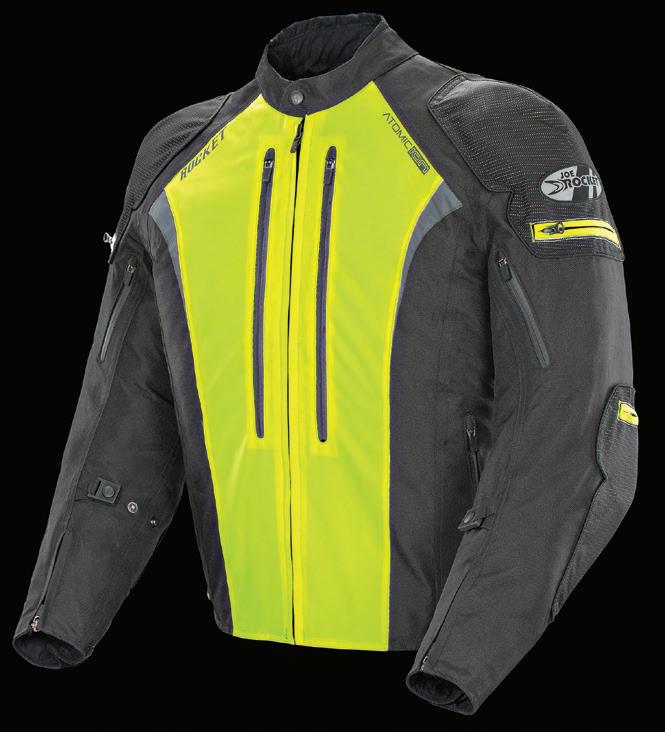
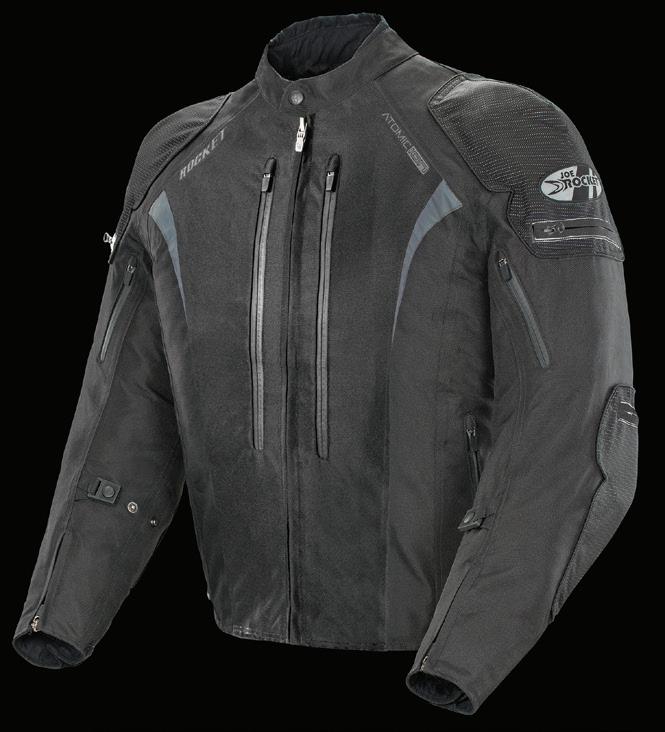
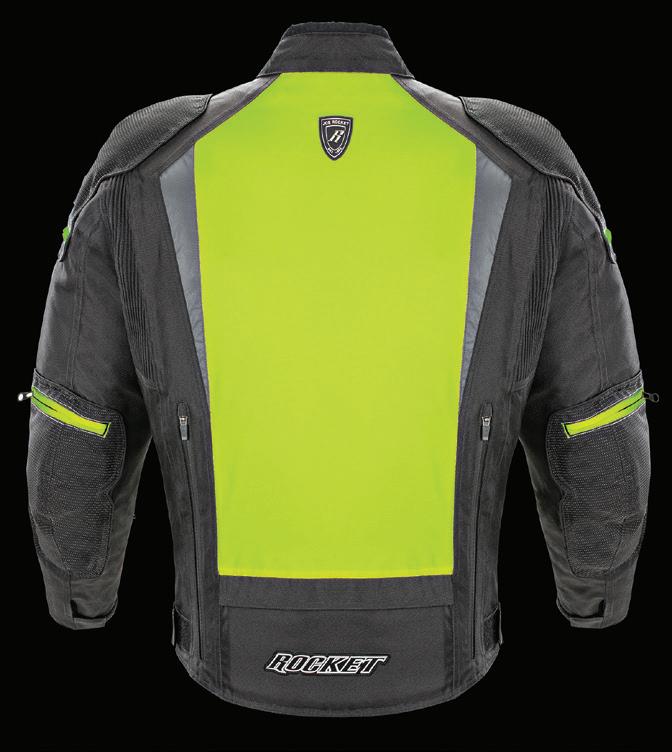



4 BLACK SIDE DOWN


The editor speaks.

6 HOT ROD BSA: 1967 SPITFIRE MARK III
In the 1960s, BSA was known for flashy bikes with bright colors and lots of chrome, but there was more to the English import than just shine.
12 DREAM MACHINE: 1966 HONDA CA77


All dressed up in angular sheet metal, the Honda Dream is instantly recognizable as a machine of the 1960s.
18 VELOCETTE THRUXTON: TWO FISHTAILS
Despite its small size, Veloce Ltd., makers of Velocette motorcycles, was known for its advanced technology.

24 “D” FOR DESMO: 1969 DUCATI 350 MK3 D
Found and bought at the 2010 Barber Vintage Festival, this Ducati has been restored to perfection.
30 ELEGANCE IN MOTION: 1962 BMW R60/2
Lovingly restored and now ridden faithfully, this R60/2 hits the sweet spot.
36 1963 ROYAL ENFIELD INTERCEPTOR

The 750 Interceptor Mk1 went head-to-head in the showrooms with the new Norton Atlas 750.
42 1961 HARLEY-DAVIDSON FLH PANHEAD
In 1961, there was nothing on the market quite like the big 648-pound Harley FLH.
48 1966 HONDA CB450 BLACK BOMBER
Loaded with technology, the CB450 put the world on notice that Honda was playing to win.
54 AMERICA’S BRIT BIKE: TRIUMPH T120
1967 was Triumph’s best year ever in the U.S., and the T120 Bonneville was its most popular model.
2 MOTORCYCLE CLASSICS Street Bikes of the
NICK CEDAR
’60s
ROAD MAP 24 84
6
JEFF BARGER (2)
58 SPANISH DELIGHT: 1965 BULTACO METRALLA
Never well known in the U.S., Bultaco made trials and motocross bikes, not to mention exceptional street bikes like the Metralla.
64 1966 NORTON P11 PROTOTYPE REPLICA
It was 1966 when Bob Blair and his mechanic/parts manager Steve Zabaro worked together to blend components from two motorcycles to create the prototype of the 1967 Norton P11.
72 ON THE HUNT: 1969 KAWASAKI H1
The 1969 Kawasaki H1 was noisy, blew blue smoke and attracted troublemakers — who wouldn’t want one?

78 PAST PERFECT: MOTO GUZZI V700




























































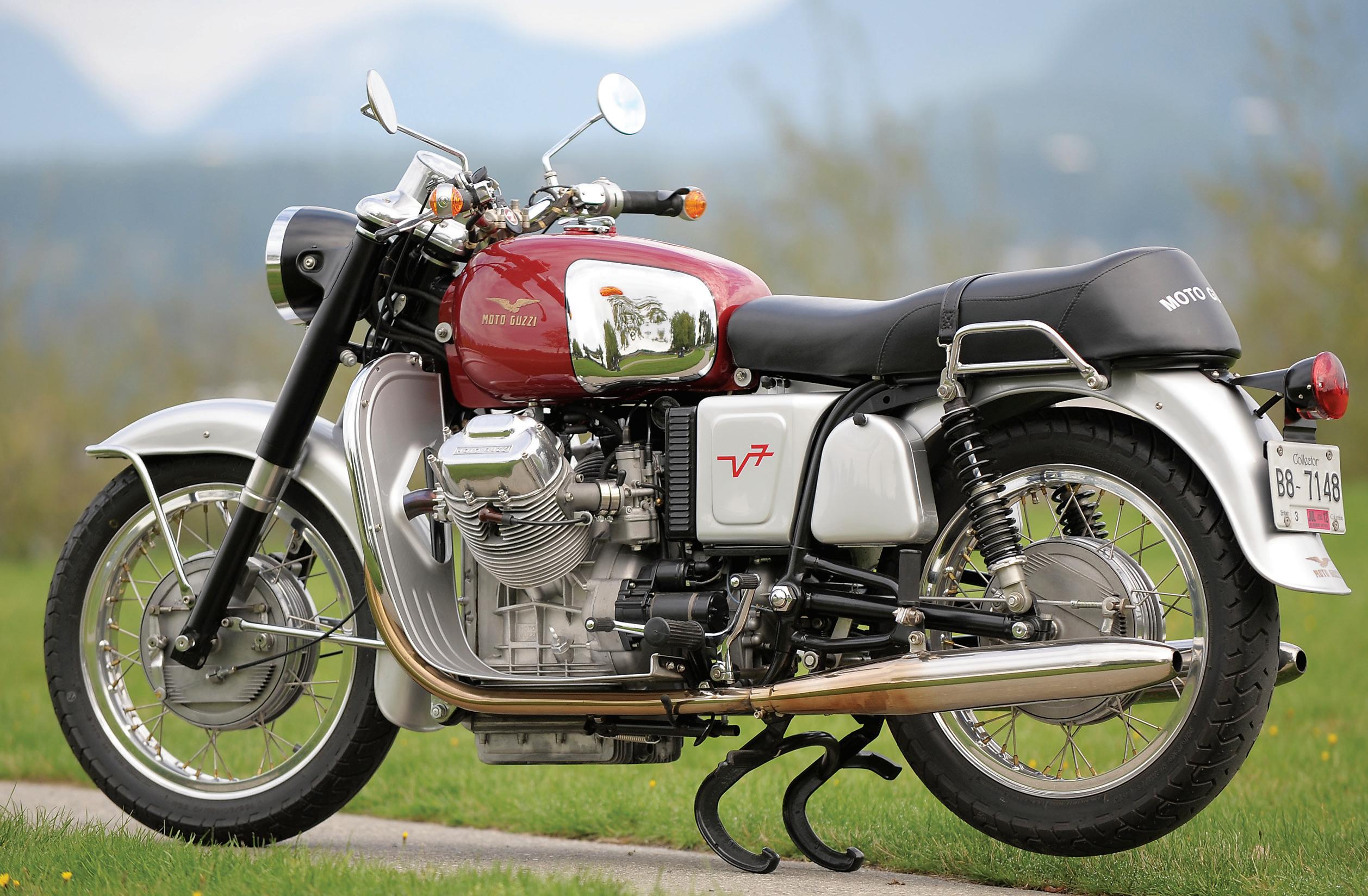
In our back-to-the-future world, everything old looks new again. Moto Guzzi fan George Dockray builds a better V700.
84 TWO-STROKE SCRAMBLE: YAMAHA BIG BEAR
When Al Roller came across the 1968 Yamaha YDS-3C Big Bear in 2000, he tore it down to the frame and restored it to perfection. A few years later, it won Best Restored Japanese bike at the 2013 Motorcycle Classics Vintage Bike show at Road America.
90 1968 TRIUMPH TRIDENT T150
When Triumph launched its new-for-1968 Triumph Trident T150 triple, the magazine motorheads took notice. “For you performance buffs, let us state that the Trident is the fastest street machine we have tested, bar none,” Cycle Guide enthused.
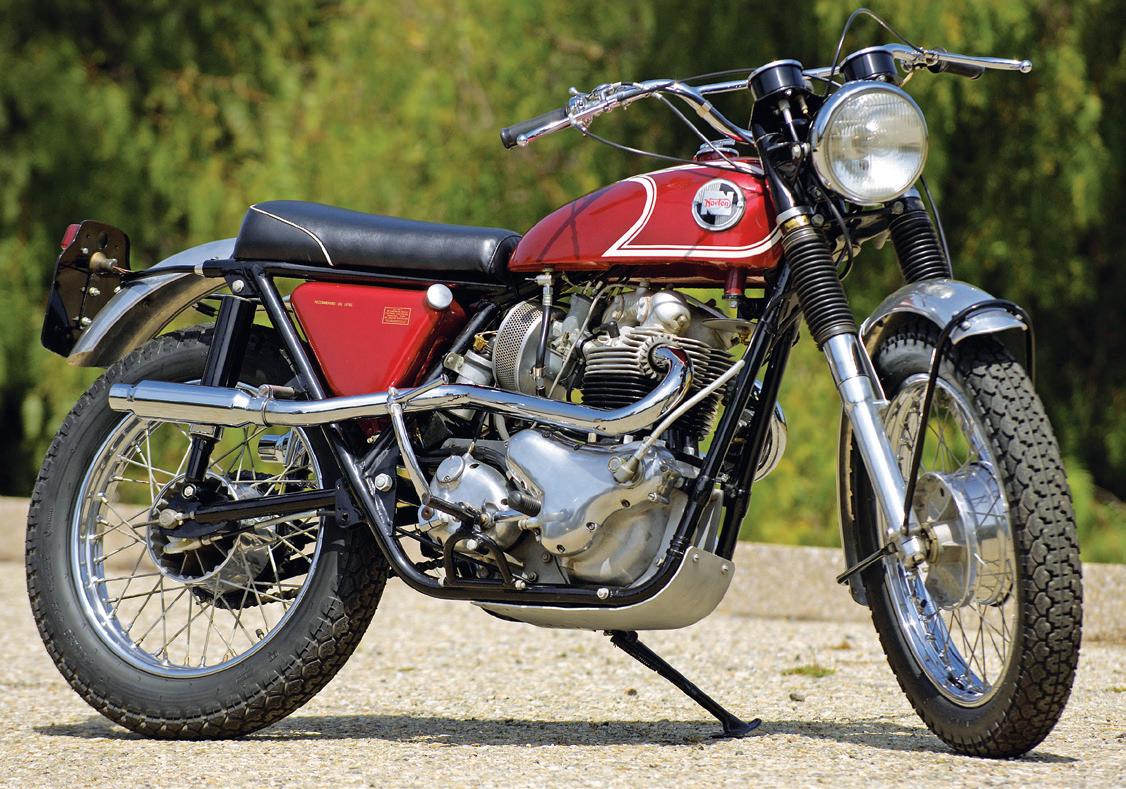
96 PARTING SHOTS: A GRAND DAY OUT ON A NORTON COMMANDO
Cam Norris awakes to a beautiful summer morning, keen to take a joyful ride aboard his classic 1969 Norton Commando S.
www.MotorcycleClassics.com 3 64 36
78
ROBERT SMITH
GARY PHELPS
JEFF BARGER
Celebrating the Sixties
World War II might be a distant memory now, but at the dawn of the 1960s the repercussions of that global conflagration were in sharp focus, present in almost every facet of modern life, whether technological or cultural, and its outcome shaped the world of motorcycles to come.
The U.S. came out of World War II the biggest winner, its war-fueled industries primed and ready for the switch to consumer-driven production. Yet it’s a curious fact that while the U.S. auto industry blossomed with fresh technology, becoming the leading global manufacturer of automobiles, the U.S. motorcycle industry did not. By 1953 Indian was dead, while Harley-Davidson was soldiering on with mostly pre-war technology, its best-selling motorcycles powered by aging flathead designs.
British manufacturers looked to the U.S., where riders seemed more interested in speed than anything else, and their light and fast machines found a ready market. In countries like Japan and Italy where the means of production had been obliterated by the war, manufacturers started with a clean sheet, targeting a new audience of post-war riders looking for cheap transportation. That decade saw a boom in manufacturing, and as the ’50s gave way to the ’60s, motorcycling became more and more about recreation and sport than efficient transportation. Foreign manufacturers — particularly in Japan — poured fresh resources of money and technology into developing new machines for a new market. Honda came to the U.S. in 1959, and in 1960, its first full year here, it sold some 2,000 motorcycles. By comparison, that same year Harley-Davidson produced fewer than 15,800 machines. Ten years later the situation was more than reversed, with Harley production essentially stagnant at around 15,500 motorcycles of all types and Honda, continuing its stratospheric rise, selling an estimated 36,000 CB750 Fours in 1969 in the U.S. alone.
RICHARD BACKUS, EDITOR-IN-CHIEF rbackus@motorcycleclassics.com

LANDON HALL, MANAGING EDITOR lhall@motorcycleclassics.com
ARTHUR HUR, ASSOCIATE EDITOR/ONLINE
CONTRIBUTORS








JEFF BARGER • NEALE BAYLY • NICK CEDAR COREY LEVENSON • SEDRICK MITCHELL
CAM NORRIS • GARY PHELPS • KEN RICHARDSON
MARGIE SIEGAL • ROBERT SMITH PHILLIP TOOTH • GREG WILLIAMS
ART DIRECTION AND PRE-PRESS
MATTHEW T. STALLBAUMER, ASST. GROUP ART DIRECTOR TERRY PRICE, PREPRESS
WEBSITE

















CAITLIN WILSON, DIGITAL CONTENT MANAGER
DISPLAY ADVERTISING (800) 678-5779; adinfo@ogdenpubs.com
CLASSIFIED ADVERTISING 866-848-5346; classifieds@motorcycleclassics.com


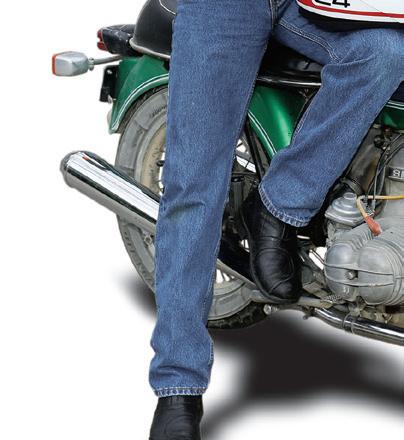
NEWSSTAND BOB CUCCINIELLO, (785) 274-4401
CUSTOMER CARE
(800) 880-7567
BILL UHLER, PUBLISHER
OSCAR H. WILL III, EDITORIAL DIRECTOR
CHERILYN OLMSTED, CIRCULATION & MARKETING DIRECTOR
BOB CUCCINIELLO, NEWSSTAND & PRODUCTION DIRECTOR
duction quickly overshadowed by Honda’s new-for-1969 CB750, the motorcycle that, more than any other, marked the beginning of the end of British
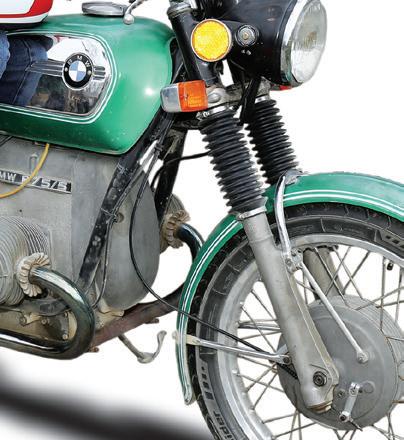
Yet even as the Japanese continued their upward march, the British held fast. The British makers weren’t pouring the same level of resources into development, but that didn’t seem to hinder their dominance in the performance category of 500cc-plus motorcycles. The big British twins were still the benchmark of performance and Triumph above all reigned supreme, selling some 28,000 machines in the U.S. in 1967, its best year ever. Recognizing the Japanese threat perhaps too late, in 1968 Triumph introduced the now legendary T140 Trident triple, an introduction quickly overshadowed by Honda’s new-for-1969 CB750, the motorcycle that, more than any other, marked the beginning of the end of British dominance of the U.S. market.
But the market was about so much more than just Honda, Harley and Triumph. Moto Guzzi and BMW, storied brands with roots to the 1920s, were developing new and more refined motorcycles, and finding growing markets in the U.S. and elsewhere. Smaller manufacturers like Bultaco flourished at the same time as some of the old guard like Velocette trembled, too small to be truly competitive and unable to change to meet the times. An era of victors and vanquished that heralded the coming changing of the guard, the ’60s brought us some of the most memorable machines of all time. We hope you enjoy this special issue of Motorcycle Classics celebrating a unique era in motorcycling’s rich history.
BMW, us some Classics motorcycling’s rich history.
Richard Backus Editor-in-chief
BOB LEGAULT, SALES DIRECTOR
CAROLYN LANG, GROUP ART DIRECTOR
ANDREW PERKINS, MERCHANDISE & EVENT DIRECTOR
KRISTIN DEAN, DIGITAL STRATEGY DIRECTOR
TIM SWIETEK, INFORMATION TECHNOLOGY DIRECTOR
ROSS HAMMOND, FINANCE & ACCOUNTING DIRECTOR
MOTORCYCLE CLASSICS (ISSN 1556-0880)

Ogden Publications, Inc., 1503 SW 42nd St., Topeka, KS 66609-1265


For subscription inquiries call: (800) 880-7567
Outside the U.S. and Canada: Phone (785) 274-4360 • Fax (785) 274-4305
©2017 Ogden Publications Inc.
Printed in the U.S.A.
4 MOTORCYCLE CLASSICS Street Bikes of the ’60s BLACK SIDE DOWN ®

aerostich.com/motoclassics 100% Cotton Made in America FREE with your next order* *Of $27 or more. T-shirt regularly $27.
HOT ROD BSA



1967 Spitfire Mark III
Story by Margie Siegal
Photos by Nick Cedar
IIn the 1960s, BSA was known for flashy bikes with bright colors and lots of chrome. But there was more to the English import than just shine. Under all that makeup was a reliable motorcycle that handled well, ran fast and stopped when asked.
Birmingham Small Arms Company’s first motorcycles in 1903 were single-cylinder machines, with a line of V-twins following in the 1920s. The first BSA parallel twin, the A7 designed by Val Page, Herbert Perkins and David Munro in 1939, was put on hiatus when World War II started and finally appeared in 1946.
BSA weathered the war well, and by the 1950s it had the largest range of any motorcycle manufacturer in the world. Most
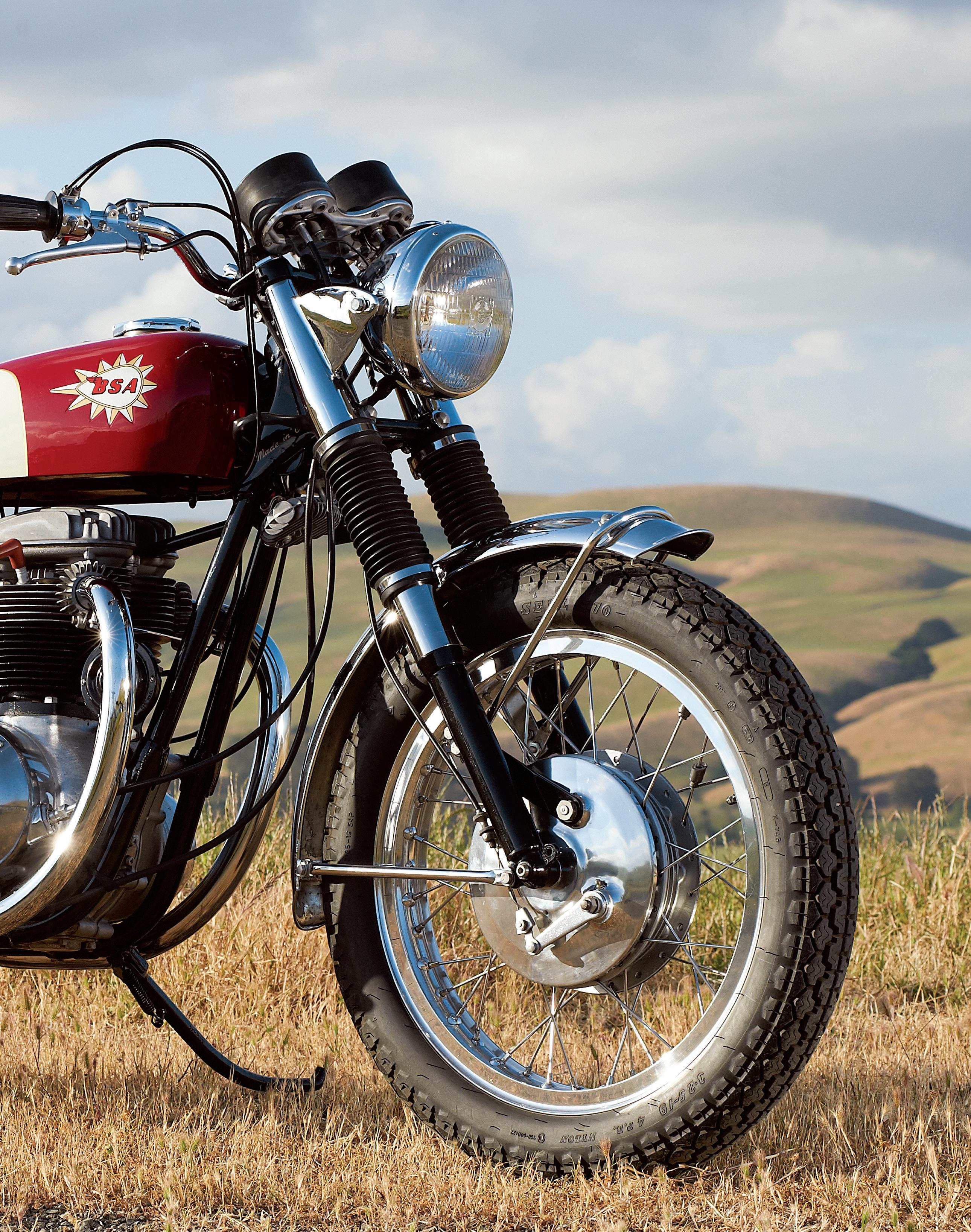
www.MotorcycleClassics.com 7
1967 BSA SPITFIRE MARK III
of the bikes BSA sold were the smaller, single-cylinder commuter cycles heavily in demand by British workers. And while the company had a firm policy against factory road race involvement, BSA built single-cylinder Gold Stars for clubman racers in England and flat track competition in the United States.


BSA’s better twin




























By this time, BSA’s parallel twin had morphed into two versions, the 497cc A7 and the 646cc A10. In order to raise money to pay its war debt, the British government pushed English companies to export. As a result, a lot of BSA twins were sent to the United States, where the market for sport motorcycles was booming. Indian motorcycle distributor Hap Alzina was importing BSAs to the West Coast while Rich Child, the former head of Harley-Davidson’s Japanese subsidiary, was in charge of distribution east of the Mississippi. The reliability and economy
that drew British consumers did not draw U.S. riders, who were more interested in speed. American motorcyclists generally had little use for BSA’s lightweights, but were enthusiastic about BSA twins.

An obvious way to prove performance is on the race track. BSA didn’t like to sanction racing, but the company had little choice if it wanted to sell bikes in the United States. American racers found that BSA twins responded well to tuning, and with the right setup were competitive in flat track and offroad events. In 1954, BSA lent assistance to a team led by AMA National Champion Bobby Hill for that year’s Daytona beach race, and the BSA Wrecking Crew, as it became known, swept the first five places. Other National winners on BSA singles and twins included Jody Nicholas, George Everett and Dick Mann.
One of the most consistent BSA flat track stars was Al Gunter. He moved to BSA in the early Fifties and racked up seven career wins in national racing events. His home track was Ascot Park in Southern California, where he won regularly. Other BSA riding masters at Ascot were Sammy Tanner, Blackie Bruce, Jack O’Brien and Neil Keen. Together, they were known as the Ascot Wrecking Crew.
BSA continued to develop its parallel twin, and in January 1962 introduced a major revamp of both the A7 and A10 twins. The new engines were based on a common platform, with the major difference between them being the 75mm bore of the A65, which with the 74mm stroke common to both engines gave 654cc cubic capacity. The smaller A50’s bore of 65.5mm gave 499cc.
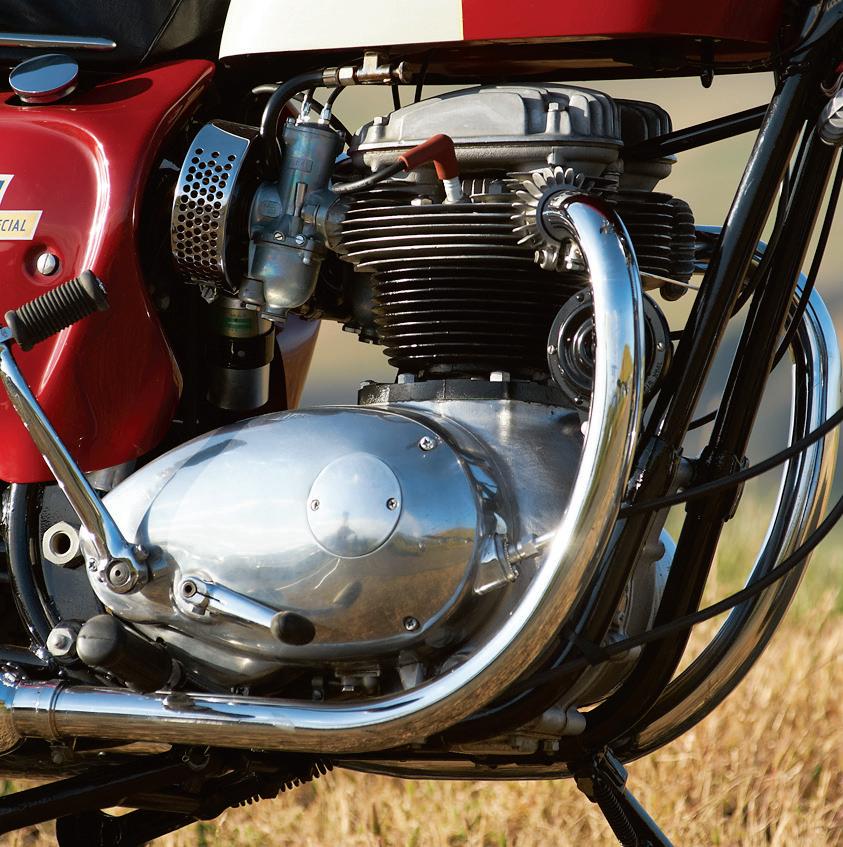
The A65 engine used vertically split aluminum alloy crankcases with a onepiece crankshaft resting on ball bearings on the drive side and a plain bushing on the timing side. The cylinder was still cast iron, while the head was aluminum alloy. Valves were operated by pushrods, and lubrication was dry sump.
The 4-speed transmission was in unit instead of a separate box bolted to

8 MOTORCYCLE CLASSICS Street Bikes of the ’60s
the engine as on the A10, and an alternator handled the 6-volt electrics. Two sets of points were mounted on a single plate with an automatic advance mechanism.
The frame was similar in design to the one used on the last A10s, a dual downtube cradle with a single backbone tube under the seat. Telescopic forks in the front and Girling shocks in the rear absorbed the bumps, and the single-leading-shoe brakes were 8 inches diameter in front and 7 inches in the rear.
Going faster
In 1964, BSA started hot-rodding the A65. The Rocket A65R had the compression upped to 9.0:1 from the standard 7.5:1, with a hotter cam and siamesed exhaust pipes. British riders still wanted easy maintenance and fuel economy, but American riders wanted higher bars, smaller tanks and more horsepower, so the American importers convinced BSA to build four special U.S.-only models.
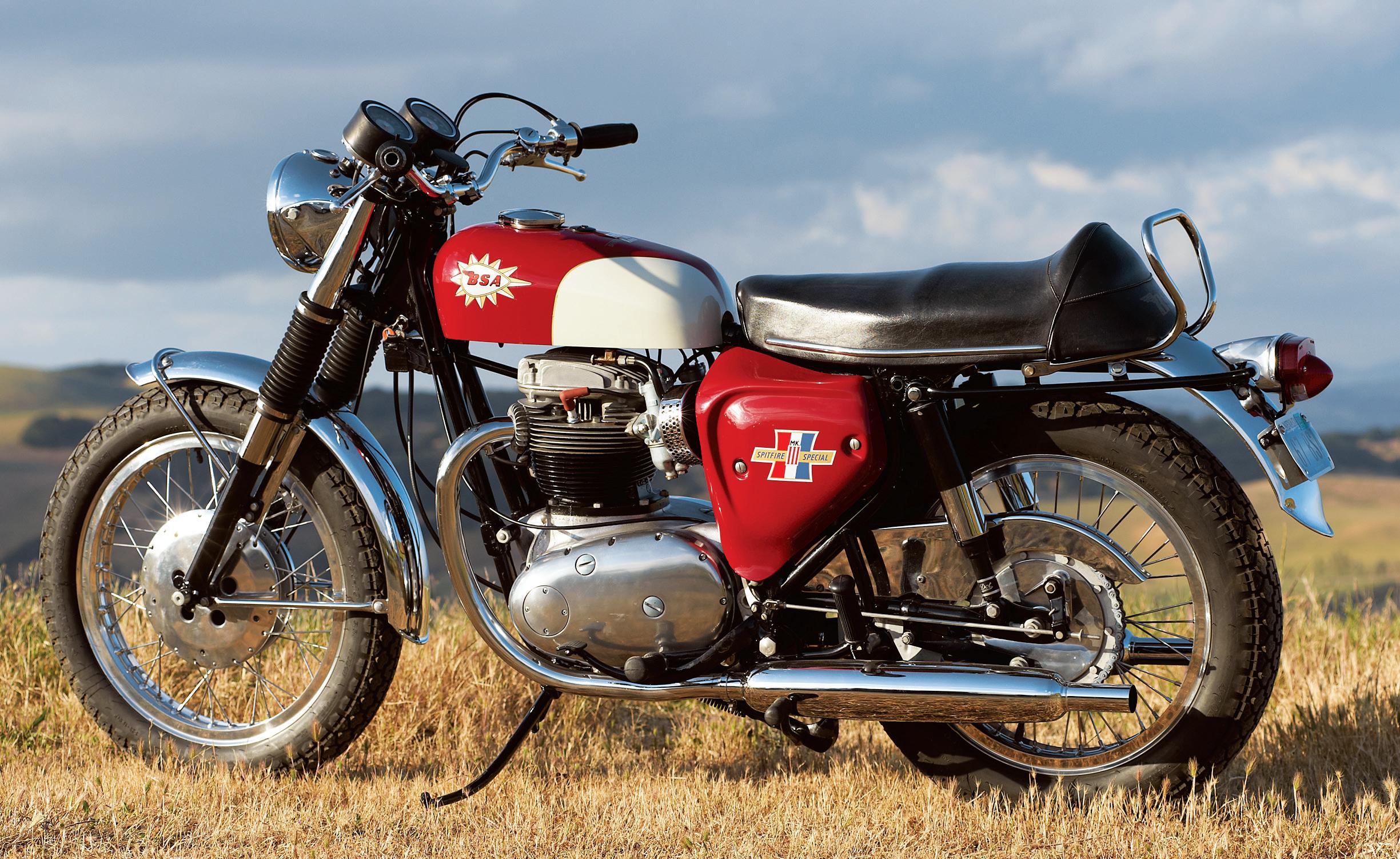
The result was the 499cc offroad competition Cyclone with no lights and open pipes, and the 654cc Thunderbolt with high bars, a small tank and the hot engine. A twin-carb version of the Thunderbolt was named the Lightning.
The last of the four U.S.-only models was the 654cc BSA Spitfire Hornet. Like the Cyclone, it was produced in response to American demand for a hot offroad/desert racer. Equipped with the twin-carb head fed by a pair of 1-1/8-inch Amal Monobloc carburetors and available with either 9:1 or 10.5:1 compression, it had a 2-gallon fiberglass gas tank, a high performance cam and straight-through pipes.
In line with BSA’s East/West Coast distributorships were separate East Coast and West Coast models. The East Coast version had high pipes and the West Coast model had low
pipes. If riders wanted to hit the street, BSA’s ET (energy transfer) ignition system could be easily adapted to add lights.
By this time, BSA was experiencing cracks in the corporate wall. Better wages for English workers meant many of BSA’s get-to-work customers were buying inexpensive automobiles coming on the market, and Japanese motorcycles were being imported to England and America in record numbers.
Making matters worse, the British manufacturers weren’t reinvesting their profits into developing their products. In the 1960s, BSA was building motorcycles on machine tooling from before World War II. The Japanese manufacturers, however, were making major investments in tooling and design, enabling them to offer oil-tight cases, overhead cams and electric starting at prices competitive to the much more primitive English machinery. Certainly the Brit bikes handled better, but that was a priority for a minority.
BSA management, who had continued to believe that its customers were forever loyal, was discovering that the get-to-work rider who didn’t buy a car was likely to buy a Honda over a BSA.
New bikes
The company tried to cope by fielding state of the art advertising campaigns and building stylish motorcycles targeted to the sport rider. For 1965, BSA dropped the single carburetor A65R for the American market. There were now 11 versions of the twin, but the 499cc versions had to compete against the new Honda CB450, which had double overhead camshafts, constant velocity carburetors, electric start and a twin-leadingshoe front brake.
For 1966, there were only six versions of the twin, two 499cc models and four 654cc. To counter problems with the drive-
www.MotorcycleClassics.com 9
“The British manufacturers weren’t reinvesting their profits into developing their products.”
side ball main bearing, it was changed to a lipped roller race. This turned out to be a bad move, as at high speeds the crankshaft could pull to one side and occasionally cut off the oil supply, resulting in a rod through the cases. Although BSA never acknowledged the problem, ingenious privateer mechanics developed a more reliable bearing.
The intake valves were enlarged, the transmission was improved, a timing notch was added to the flywheel and a balance pipe was added to twin carb models. The frame was revised, and twoway damping was added to the forks. A 12-volt system replaced the now outmoded 6-volt lights.

The BSA Spitfire was introduced, replacing the limited production Lightning Clubman. Amal GP 1-5/32-inch carburetors replaced Monoblocs and the 190mm front brake from the defunct Gold Star was standard. The Hornet (with the Spitfire half of the name dropped) continued in production as a desert racer. Actor Steve
McQueen, a dedicated offroad competitor, tested the Hornet in 1966 and wrote up the test himself for Popular Science. He praised the BSA’s powerful engine and the excellent air cleaner, but downgraded the machine for excess weight.
“The Hornet also had a tendency to want to go its own way. I always had to stay on top of it. But it sure had a good-functioning powertrain,” McQueen said. “I also think the front forks should be raked on a more forward angle. With this adjustment, the BSA would have a more stable ride in the rough and would be generally a smoother performer.”
Cycle World tested a Mark II Spitfire on the drag strip and notched quarter mile results of 14.9 seconds, with a terminal velocity of 89mph. Unfortunately, the once-excellent BSA quality control was becoming spotty, and a run of defective ignition points cams resulted in overheating and bad performance.
The problem was corrected the next year with the Spitfire Mark III. New for 1967 was a new rocker box cover with fins and an inspection hole (with cover) for checking ignition timing with a strobe. Compression was reduced a little to 10:1 from 10.5:1, and the GP Amals were swapped for easier to tune (and cheaper) 932 Amal Concentrics. The dual seat grew a hump in the rear, and the tires were mounted on aluminum Borrani rims.
The Spitfire was continued for another year (as the Mark IV) before it was dropped to make room for the Rocket 3 triple. BSA managed to keep going until 1972, when mismanagement, an aging product line and competition from Japanese motorcycle manufacturers drove the company into bankruptcy.
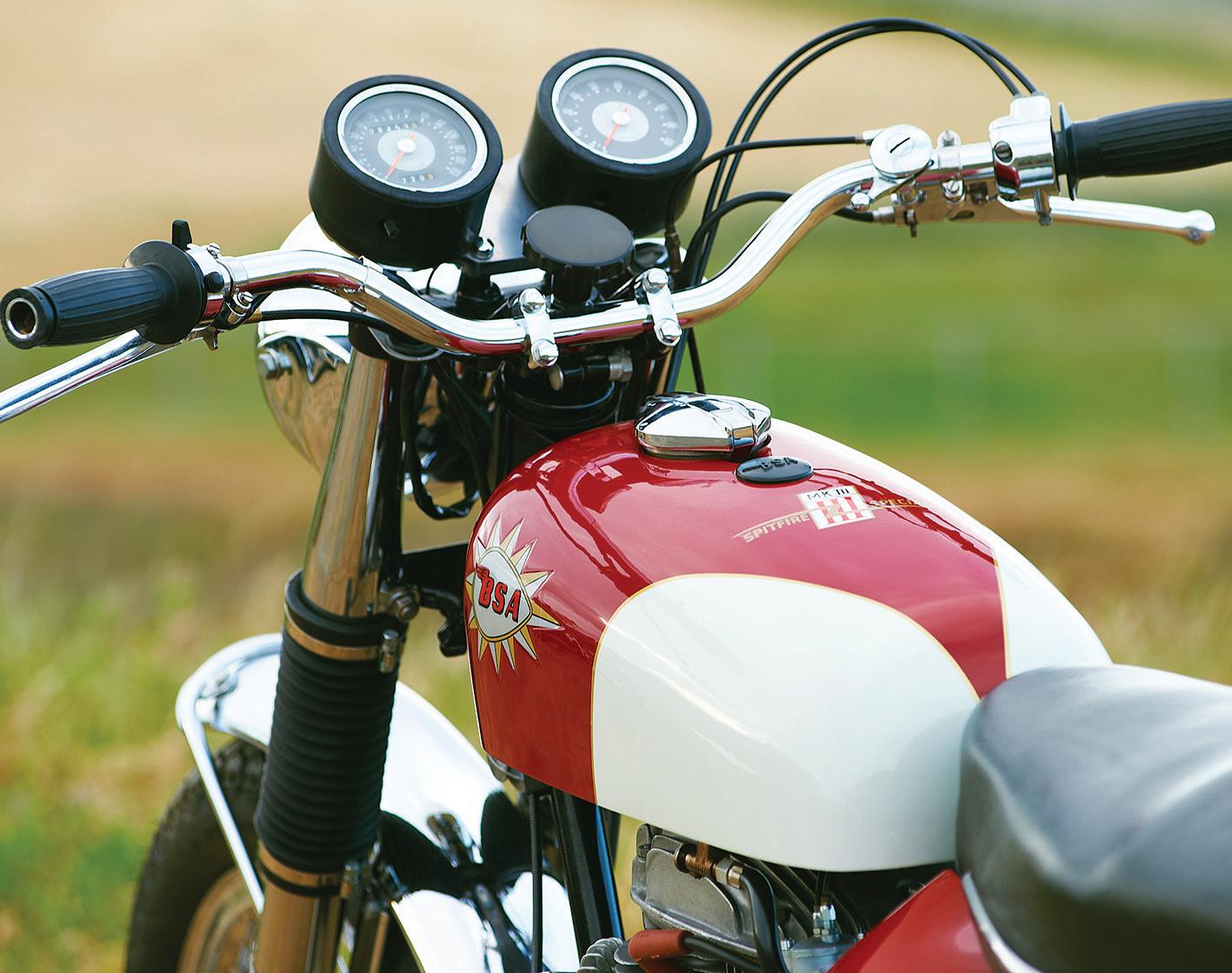

Don’s Spitfire
Don Johnson is a little too young to remember the glory days of BSA flat track racing, but he likes BSA sporting motorcycles. “There’s a visceral quality to Brit bikes as opposed to the industrial quality of Japanese motorcycles,” he says.
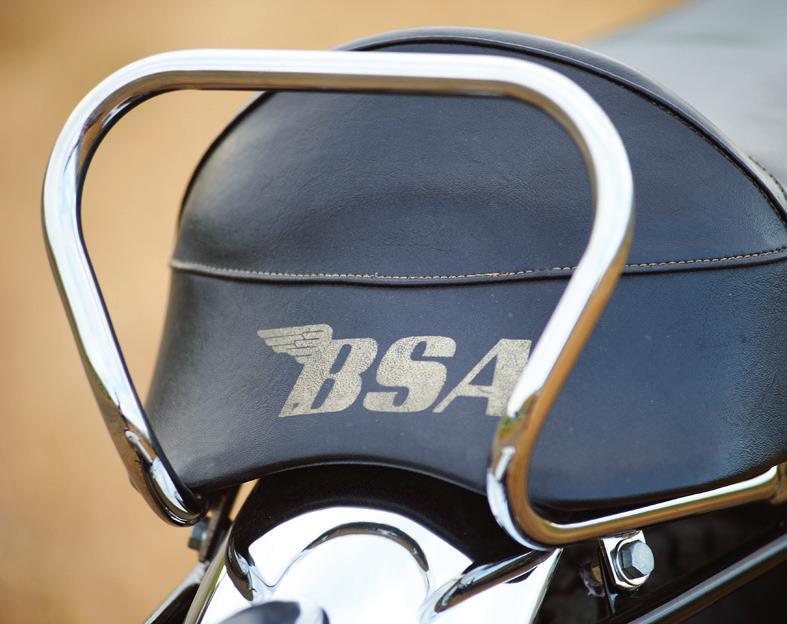
Don is a collector who rides his bikes. When he happened across this Spitfire, he found it interesting and bought it. It was all there and only “slightly restored,” Don says. “I ripped it apart, examined everything and put it back together. It was all original and within spec.”
All sorts of things can go wrong during the restoration of a 40-year-old motorcycle, but Don lucked out. Pretty majorly, actually, as the issues
10 Motorcycle classics Street Bikes of the ’60s
“The GP Amals were swapped for easier to tune (and cheaper) 932 Amal Concentrics.”
The
dual seat grew a hump in the rear for 1967. The single-leadingshoe 7.5-inch front drum brake was good for its day.
The gas tank is a new-old-stock fiberglass tank that’s been lined with epoxy.
that arose were limited to three items: sticking carburetor slides, a crumbling wiring harness and a leaky fiberglass gas tank. The popularity of old British motorcycles has given a boost to cottage industries that manufacture most parts, often with better quality control than the originals, and you can still buy new Amal carburetors and parts for most Amal models produced since World War II.
A new wiring harness was easy to find, and Don says that most of the criticism aimed at Lucas “Prince of Darkness” electrical parts should actually be directed at the wiring harness. “Some stuff was not up to the task, but most Lucas components are reliable if you keep them clean and adjusted,” Don says. “Most parts got no attention until they quit. But Lucas does have one advantage — you can fix most things at the side of the road.”
The part that was hardest to repair was the gas tank. Old fiberglass tanks tend to weep and seep. As purchased, the Spitfire had a metal BSA Lightning gas tank bolted on, with the correct fiberglass tank in a box. Don discovered a new-old-
stock tank in the shop of an acquaintance, and decided to buy it and use it instead of the compromised original.







Modern gas is hard on old fiberglass tanks, and a partial remedy is to carefully coat the inside with clear epoxy sealer from outfits like Caswell. But as experienced users will tell you, coating the inside of a tank is an art. Don pours in the compound and waits until it looks like it is starting to harden, then turns the tank so that the excess epoxy settles where he thinks the leak is. Since the filler neck is proud of the tank, getting excess epoxy out is very difficult, so Don just turns the tank so the last few spoonfuls settle at the bottom.
Don says that properly tuned and prepped, the Spitfire isn’t too hard to kickstart. “It was the hot rod of BSA’s line of twins after they discontinued the Rocket Gold Star,” Don says. “It’s as fast as a Triumph if it’s tuned right, and it stops a lot better than Triumphs of the era. Nowadays, I just like to putt along and enjoy the scenery. It handles very nicely for what I like to do. The lights are adequate, and the suspension is not bad. If you do it up right the Spitfire is reliable. It sure is eye-catching. It’s so red.” MC

“It’s as fast as a Triumph if it’s tuned right, and it stops a lot better than Triumphs of the era ... It sure is eye-catching. It’s so red.”
DREAM MACHINE
1966 Honda CA77 Dream
AAll dressed up in angular sheet metal, the Honda Dream is instantly recognizable as a machine of the 1960s. Those sartorial straight lines and sharp creases of the Dream are also instantly polarizing — eliciting a love-it-or-loathe-it kind of reaction.
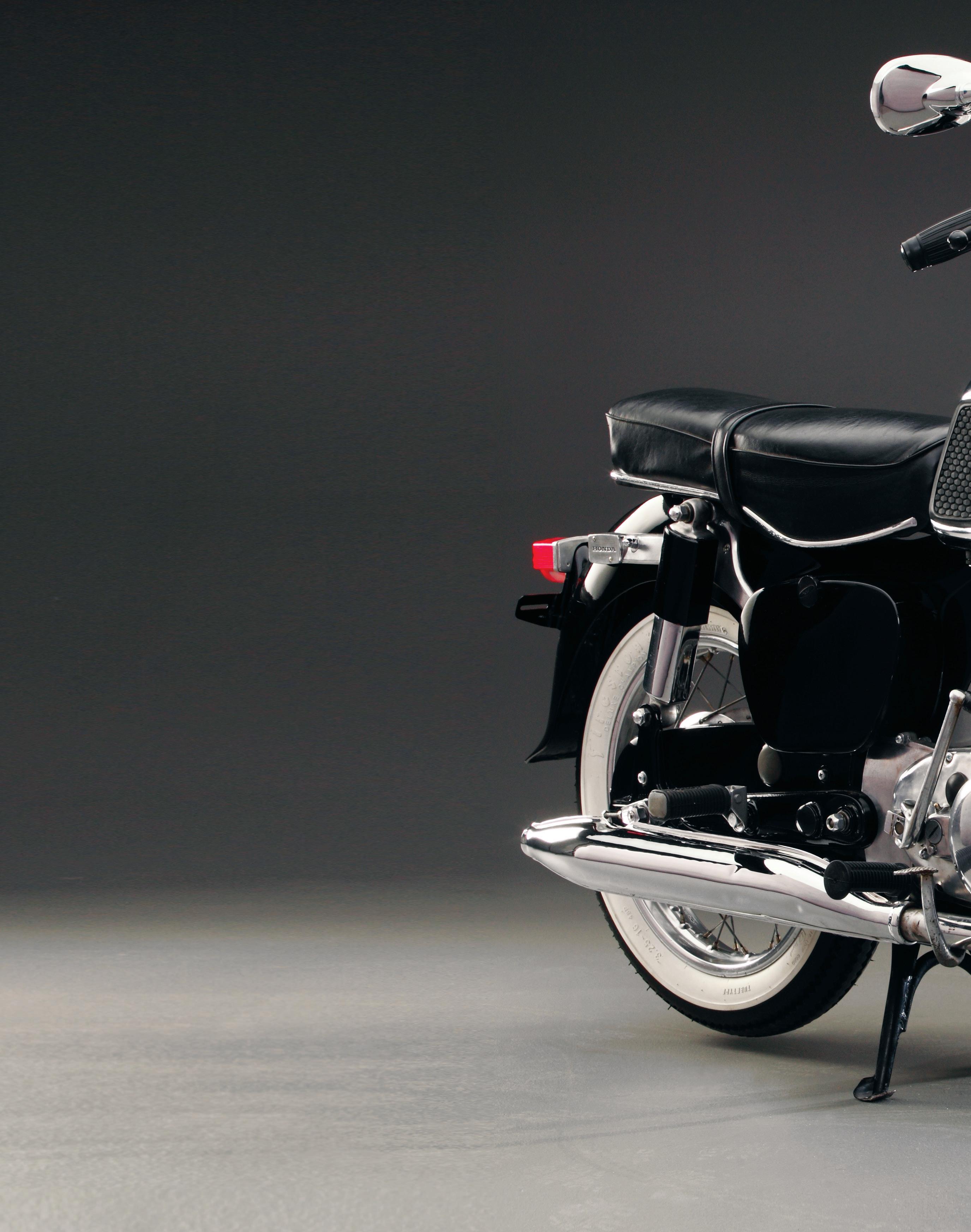
Regardless of how you feel about the blocky and chunky machine, for many who came of age in the era of the Dream the model brings back happy memories. Take Jim Jebavy of New Berlin, Wis. In 1966, he was a high school senior in the town of Two Rivers on Lake Michigan, and several of his friends had motorcycles. Many owned Dreams, and Jim remembers cadging rides aboard the 305cc Hondas. At the time he had never owned a motorcycle, having instead invested in a car. Come winter, he was the popular man with his friends.
Several decades later, Jim found himself reflecting on his high school days. Funny thing was, it wasn’t the car he remembered, but the Honda Dreams he’d borrowed and taken for rides. “Back then the Dream looked kind of strange — it had a unique and unusual shape,” Jim says. “But the bikes were very well put together, and they were also very simple to operate.”
Simple by design





Jim’s impression of the Dream is exactly the kind Soichrio Honda hoped to make with his products. From the first motorcycle Honda built, the designer believed that small displacement multi-cylinder engines were superior to large, thumping singles. And in 1957, Honda wasn’t beyond riffing on a concept that worked when the fledgling motorcycle maker introduced its C70 Dream.
The engine found in NSU’s Rennmax, with its twin forward-canted cylinders and gear-drive double overhead cam, inspired the 247cc 4-stroke twin powering Honda’s C70. Unlike the Rennmax, Honda’s C70 featured a chain-drive single overhead cam, but otherwise featured horizontally split crankcases with a pressed-together ball bearing crankshaft and dry sump lubrication system. After the C70, Honda developed the 247cc C71, which featured an electric starter. Bumped up to 305cc, the same engine was introduced to North America in the CA76 Dream in 1959. There were, in fact, several different versions of the 247cc and 305cc Dreams imported that year, but none in very great numbers.
The dry sump CA76 lasted a single year, replaced in 1960 with the CA77 Dream Tourer. Honda updated the CA77 with a wet sump engine and also offered a 247cc CA72. Both the 247cc and 305cc Dreams used a 360-degree crankshaft, meaning the twin pistons rise and fall
Story by Greg Williams
Photos by Jeff Barger
12 MOTORCYCLE CLASSICS Street Bikes of the ’60s
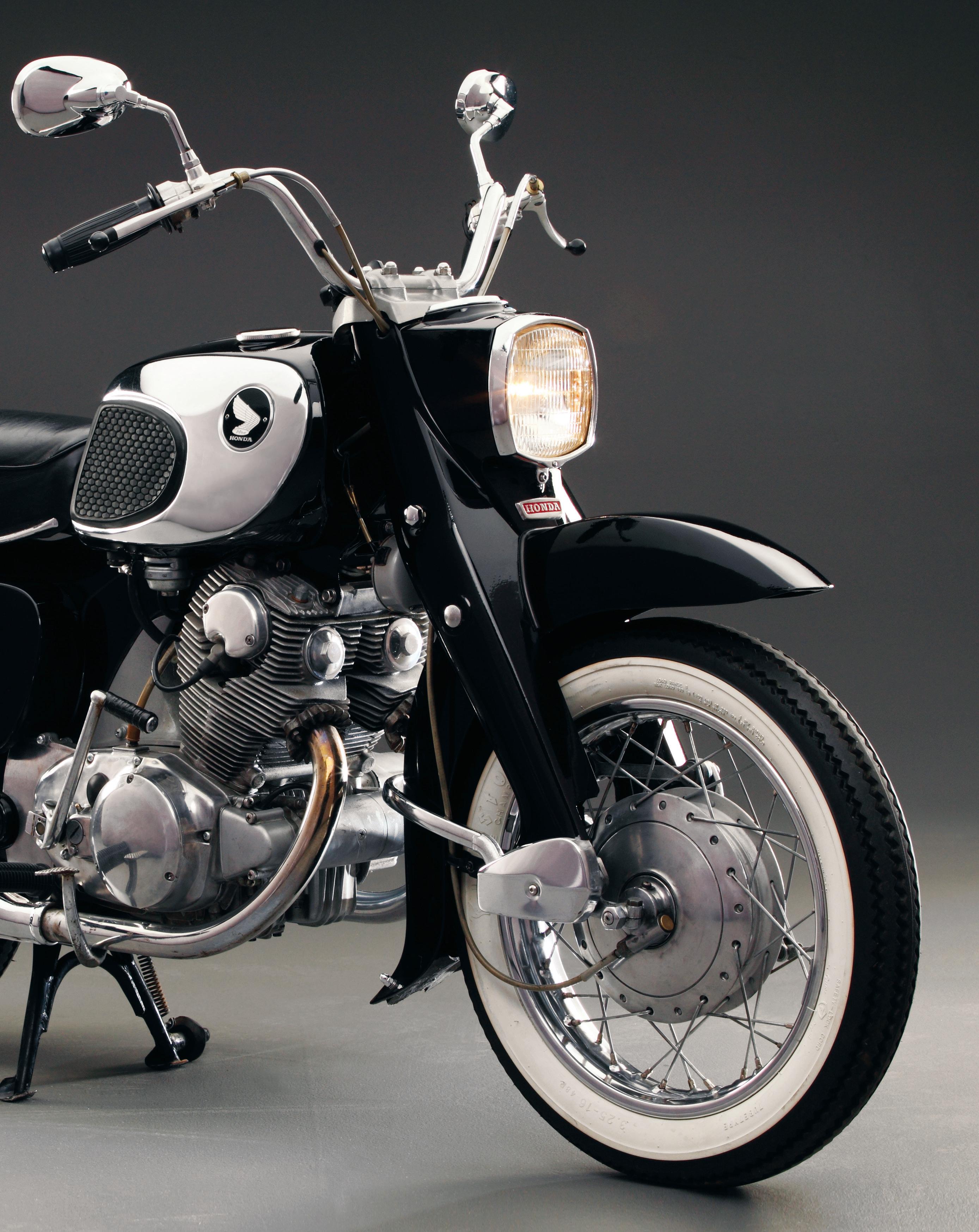
simultaneously, but fire alternately. Fuel and air mixed in a single 22mm Keihin carburetor, and exhaust left the robust cylinder head via dual-wall header pipes before exiting through mufflers equipped with removable baffles. The 305cc twin was rated at 24 horsepower at 8,000rpm.
Early vs. late








Dreams produced from 1960 to 1963 are called “early” models, while machines built from 1963 to 1969 are dubbed “late” models. Differences between early and late are few. Visually, the shape of the gas tank changed, but the rectangular rear shock absorber upper covers and the square headlight nacelle, complete with speedometer, remained. Over its production run, Dream specifications continued virtually unchanged.






















Honda built a surprising number of offshoot models based on the Dream, including the CSA77 Dream Sport; a 305cc Dream equipped with a high-level exhaust system to distinguish it from the Tourer.
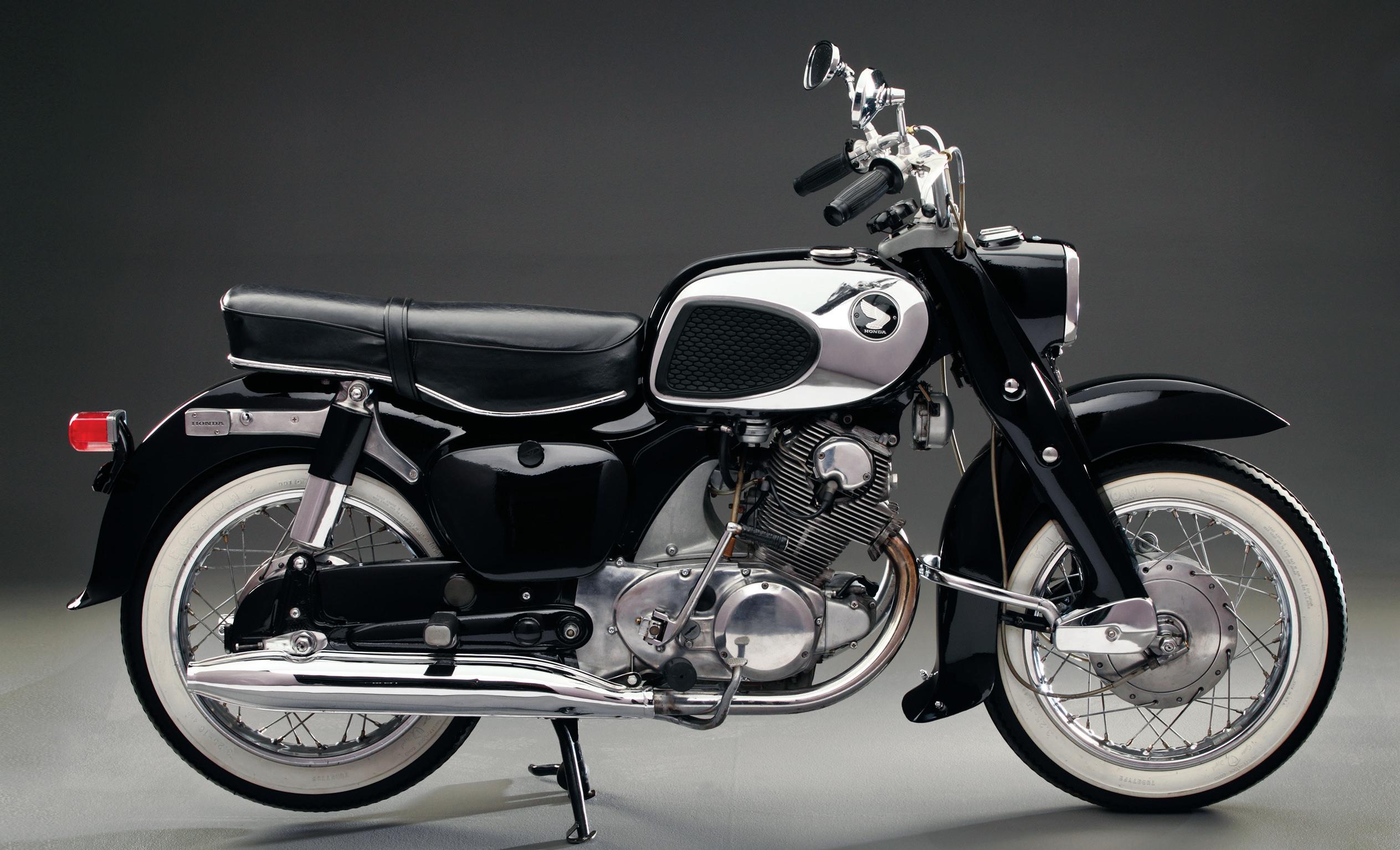
Honda used metal stampings welded together to make the frame, which included the headstock and the rear fender. There was no front downtube; the engine bolts in at the cylinder head top cover and at two points directly behind the rear case, thus acting as a stressed member. A leading-link front fork (also made of pressed steel), while not known to provide razor-sharp handling, provided effective suspension.
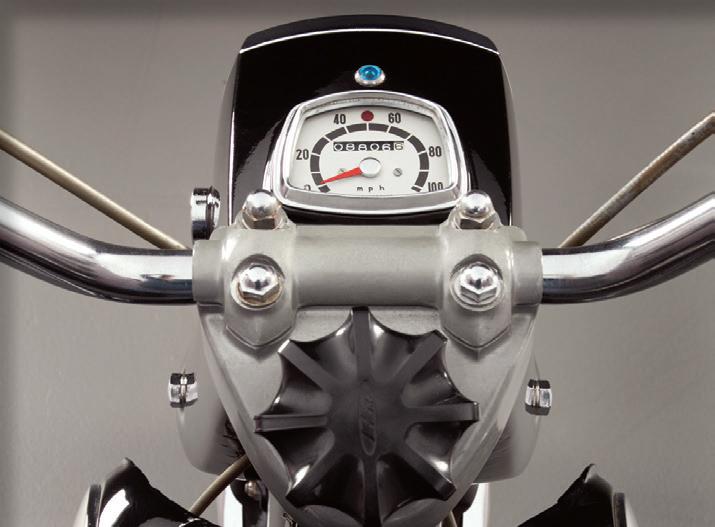
Front and rear wheels were a stubby 16 inches each, and most Dreams came equipped with whitewall tires. Unlike the small C100 Cubs, which featured some plastic bodywork, the Dream is all steel, even the deeply valanced front fender and side covers. Dreams were available in white, black, blue and scarlet red.
We’d be remiss not to mention Honda’s sporting CB72 Hawk and CB77 Super Hawk, which used engines based on the Dream powerplant. However, the CB-series engines were modified with a 180-degree crank, and in the case of the 305, made 28 horsepower. Hawks and Super Hawks gave up the pressed steel frame, using a more traditional tubular steel chassis and hydraulic front forks.
Finding a Dream
Jim’s nostalgia for a classic Dream led him to the computer and the Internet, but his research quickly turned to an active search when he decided it was time to buy. He monitored Craigslist and eBay and placed bids on a few local Dreams, but wasn’t successful until late 2010 when he finally landed one in Sheboygan, Wis. It was more than one Dream — for $900 Jim got a package deal including a 1966 CA77 Dream, plus a parts bike of the same year.
Both were in rough shape, but the engines turned freely in both bikes. The better of the two Dreams was covered in mud and had been ridden offroad as a trail bike before being improperly stored. Prior to disassembling the main Dream,
14 MOTORCYCLE CLASSICS Street Bikes of the ’60s
1966 HONDA CA77 DREAM
Jim took time to ensure the engine would run.
“I just wanted to make sure I had a viable engine. So I rebuilt the carburetor, put in new plugs, changed the oil, cleaned the points, put a battery in it and messed around with the wiring,” Jim says. “With some fresh gas the engine fired right up, but it ran rough. I shut it down right after that.”
Working in his cramped garage, Jim completely disassembled the Dream and then carried the various subassemblies to the basement. He says his wife, Ida, thought he was nuts but patiently encouraged the work. Cleaning as he went, Jim made a list of items he thought he’d need. Admitting his frugality, he was

















determined to use as many original pieces as possible from both the main Dream and the donor bike.
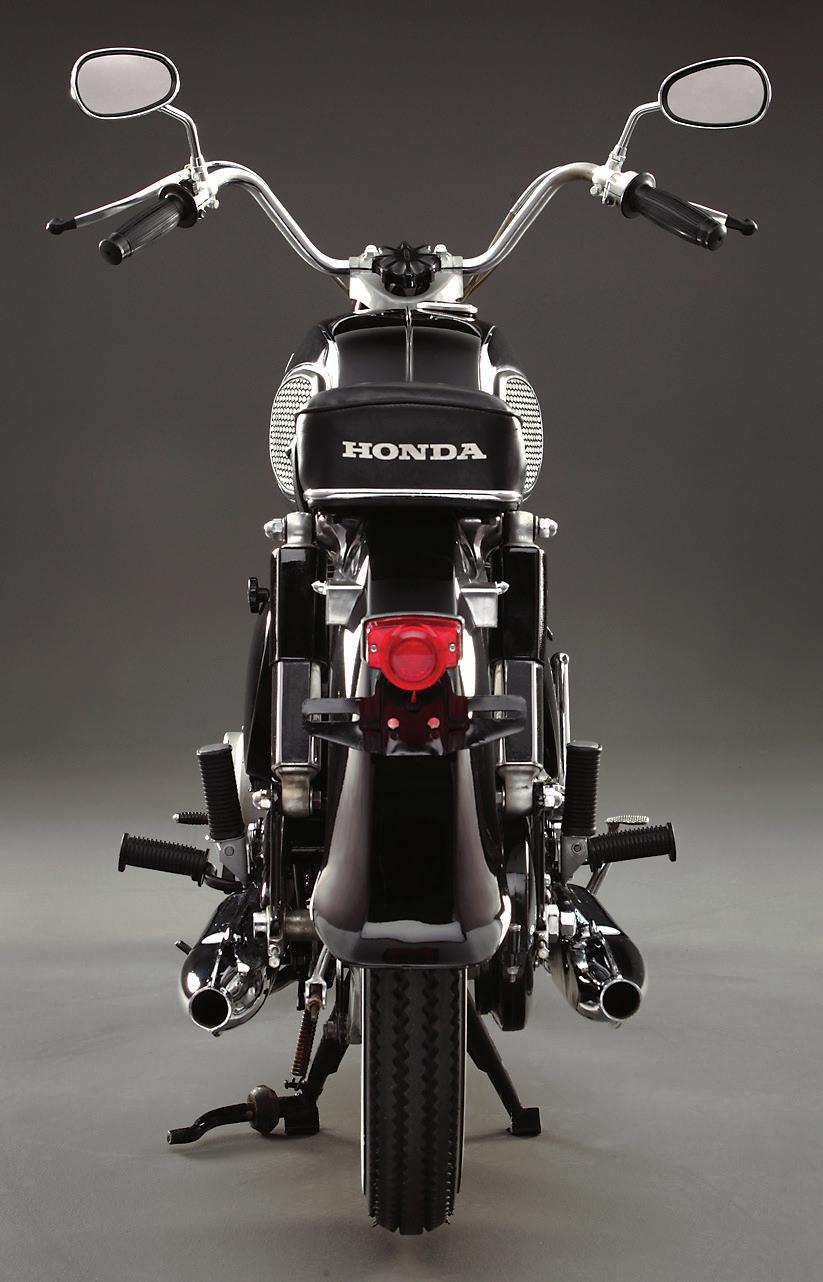


First was the engine. “The guy I bought the Dreams from had given me the name and number of a one-man shop,” Jim says. “He only works on one bike at a time, and because I’m not an engine guy, I called and asked if he could rebuild my engine.”
Murre’s Salvage Yard is just north of Milwaukee, and owner Dave Murre told Jim he could look at the 305 just after Christmas. So Jim continued cleaning parts and sandblasted the sheet metal before taking it to Leroy Gerber, a panel beater and painter in Oak Creek, Wis. Using a hammer and dolly, Leroy removed

Aside from the levers, perches and mirrors, Jim Jebavy’s Dream is remarkably correct. Jim tried to use as many original pieces as possible.
every dent and even reshaped the unique flare at the bottom of the front fender. “I always thought the flare looked a bit goofy,” Jim says of his early impression of the Dream. “But I like it now. Those fender flares are always damaged. They get smashed up the minute someone rides over a curb.” The Dream has a two-piece enclosed sheet metal chain guard, and Jim’s donor bike yielded a bottom half in good condition to go with the main bike’s upper piece. Leroy primed and painted all of the metal gloss black.
While Jim waited for Dave to accept the engine, he went through the wiring harness. His original Dream’s harness was “a bastardized mess,” but the donor bike had one in reasonable condition. He cleaned the wires and their ends, adding heat shrink tubing in some spots as deemed necessary, and replaced a couple of damaged connectors with those removed from the other harness.
Working with S.O.S cleaning pads, Jim cleaned every piece of chrome. “I was looking for a rider and not a show piece,” Jim says of his restoration philosophy. His cleaning went right down to the wheels: Removing two spokes at a time, Jim took the time to clean them up, buff the rim and hub, and reinstall them, working his way around each wheel. “The bike does show its age in places,
but I got everything as good as I could,” he adds. Jim didn’t have to source replacement wheel bearings or brake shoes, as the originals were usable.
The donor bike’s handlebar was in better shape than the main bike’s, so it was cleaned and detailed for use. Without a decent set of levers and perches Jim ordered aftermarket parts from JC Whitney. But those perches, with larger threaded holes for mirrors, meant he couldn’t install the correct rectangular-shaped Honda mirrors. Instead, he ordered a set from JC Whitney.
Jim bought a replica seat cover and slipped it over the original springs and foam, and found a replacement chrome trim strip on eBay. “This project was made so much easier thanks to the computer and the Internet,” Jim says. “You can find parts and pieces, you can log on to a forum like honda305.com and ask a question and almost always get an answer — I don’t think I could have done it without the computer.”
Together again
Jim delivered his main Dream engine, together with the donor unit, to Dave early in 2011. Dave took both engines completely to pieces and found that the main Dream engine, apart from a worn transmission shaft, was in reasonably good condition — the donor engine yielded up a clean shaft. Bearings and seals were replaced in the bottom end, and the cylinders were treated to a fresh bore and new 0.010-inch oversized pistons and rings before being buttoned back together. Jim brought the finished pieces out from the basement to the garage and assembled them into a rolling chassis. When the engine came back, it slipped easily into the frame.
Jim finally poured gas in the tank and fired up the Dream in the fall of 2011, but it was running rough. Snow came before he could fine-tune the Dream, but early in 2012 he took the bike to The Shop in Milwaukee, where the timing was found to be out 180 degrees. Once corrected, the Dream fired and purred like a sewing machine. Jim originally had a set of ill-fitting mufflers he bought on eBay, but he bought another CA77 project with a set of original mufflers. He had these cleaned and chromed, and installed the proper baffles.
“I’ve put on probably 600 or 700 miles, and it’s great to ride to the hardware store or over to a friend’s house. It’ll do 50-55mph, and it’s great on the slower roads, but I wouldn’t want to take it out on the freeway,” Jim says. Of photographer Jeff Barger stopping him at the Rockerbox Motofest in Milwaukee and asking about the Dream, Jim says, “This is my Oscar moment — I’m thrilled that I did the work and that someone else appreciates the irregular styling of the Dream.” MC


16 Motorcycle classics Street Bikes of the
’60s
The overhead cam 305cc twin produces 23 horsepower at 7,500rpm.
THE AUTUMN STAFFORD SALE
Sunday 15 October 2017
THE LAS VEGAS MOTORCYCLE AUCTION
Thursday 25 January 2018

THE PARIS SALE


Thursday 8 February 2018
COMPLIMENTARY AUCTION
APPRAISAL REQUEST
Visit bonhams.com/motorcycles to submit a Complimentary Auction Appraisal Request.



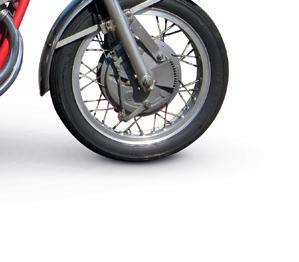
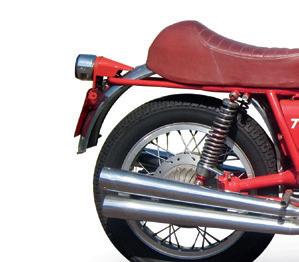

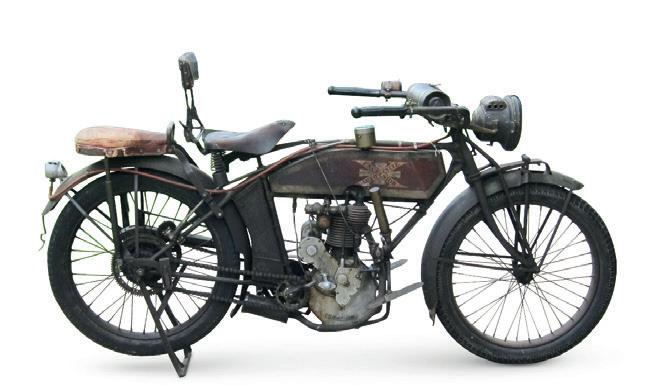


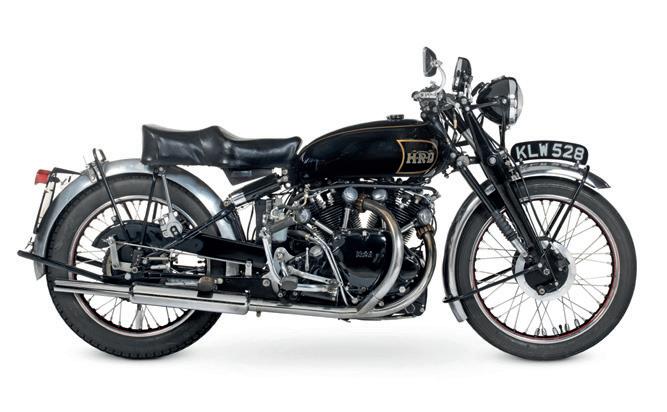
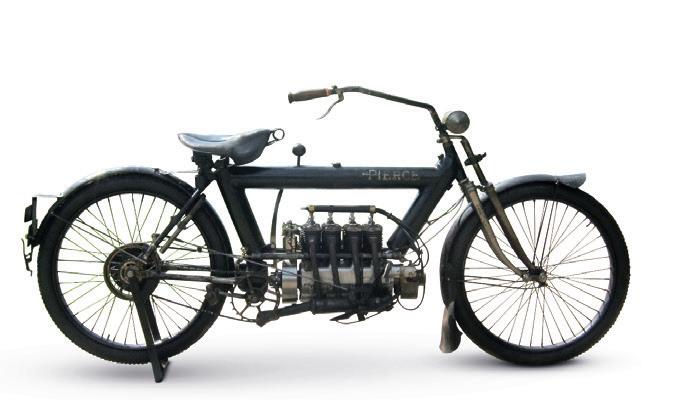

• WORLD RECORD PRICES
• EXTENSIVE CLIENT AUDIENCE







• INTERNATIONAL MARKETING

• INTERNATIONAL NETWORK OF SPECIALISTS AND OFFICES
ENTRIES INVITED FOR FORTHCOMING SALES

ENQUIRIES
United Kingdom
+44 (0) 20 8963 2817
ukmotorcycles@bonhams.com

USA
+1 (323) 436 5470 motorcycles.us@bonhams.com
bonhams.com/motorcycles
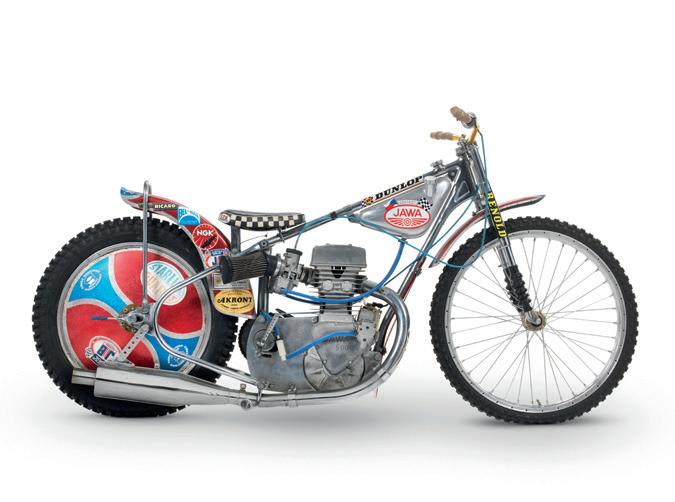



© 2017 Bonhams & Butterfields Auctioneers Corp. All rights reserved. Bond No.57BSBGL0808 @bonhamsmotoring
 1932 BROUGH SUPERIOR SS80 DE LUXE $70,000 - 85,000
1911 PIERCE FOUR $100,000 - 150,000
1913 HENDERSON 1,068CC FOUR $90,000 - 115,000
1914 EXCELSIOR SINGLE 2-SPEED $40,000 - 50,000
1949 VINCENT 998CC BLACK SHADOW SERIES-C $65,000 - 75,000
The ex Ivan Mauger, 1968 World Championship Speedway Final winning, 1968 JAWA SPEEDWAY RACING MOTORCYCLE $15,000 - 22,000
1969 MV AGUSTA 750S $65,000 - 85,000
1912 PIERCE 592CC SINGLE $50,000 - 65,000
The ex-Ivan Mauger, 1977 World Championship Speedway Final winning, 1977 JAWA SPEEDWAY RACING MOTORCYCLE $15,000 - 22,000
1932 BROUGH SUPERIOR SS80 DE LUXE $70,000 - 85,000
1911 PIERCE FOUR $100,000 - 150,000
1913 HENDERSON 1,068CC FOUR $90,000 - 115,000
1914 EXCELSIOR SINGLE 2-SPEED $40,000 - 50,000
1949 VINCENT 998CC BLACK SHADOW SERIES-C $65,000 - 75,000
The ex Ivan Mauger, 1968 World Championship Speedway Final winning, 1968 JAWA SPEEDWAY RACING MOTORCYCLE $15,000 - 22,000
1969 MV AGUSTA 750S $65,000 - 85,000
1912 PIERCE 592CC SINGLE $50,000 - 65,000
The ex-Ivan Mauger, 1977 World Championship Speedway Final winning, 1977 JAWA SPEEDWAY RACING MOTORCYCLE $15,000 - 22,000
VELOCETTE THRUXTON
A tale of two fishtails

 Photos by Nick Cedar
Photos by Nick Cedar

AA family operation, for 65 years the Velocette factory built high-quality but quirky motorcycles in Hall Green, Birmingham, England. The two sons of founder John Goodman (formerly Gütgemann) had opposing personalities. Percy, a speed enthusiast, developed some of the best race bikes of the last century while Eugene, a proponent of economical transport, designed 2-strokes and overhead valve singles. Interestingly, the ancestor of the ton-up Thruxton, the 250cc MOV, was designed by Eugene.
Despite its small size, Veloce Ltd., makers of Velocette motorcycles, was known for its advanced technology. The first positive-stop, foot-actuated gearchange on a production motorcycle appeared on the 1929 KTT. But the KTT and other overhead cam Velos were expensive to build. After the Depression hit in the 1930s, a cost-effective alternative was needed.
Eugene Goodman responded with the high-camshaft 248cc MOV in 1933. It sold well, and a 349cc version, the MAC, and a 495cc version, the MSS, soon joined it. Continuing Velocette’s tradition of innovation, the 1935 MSS sported automatic ignition advance.

The defining feature of the MOV, and subsequent versions of its single-cylinder engine, was the valve train. The camshaft, sitting high in the cases, spun off a series of gears mated with the crankshaft, and short pushrods operated the rockers atop the cylinder. Keeping the cam high and the pushrods short lessened reciprocating weight and improved valve control.

18 MOTORCYCLE CLASSICS Street Bikes of the ’60s
Story by Margie Siegal
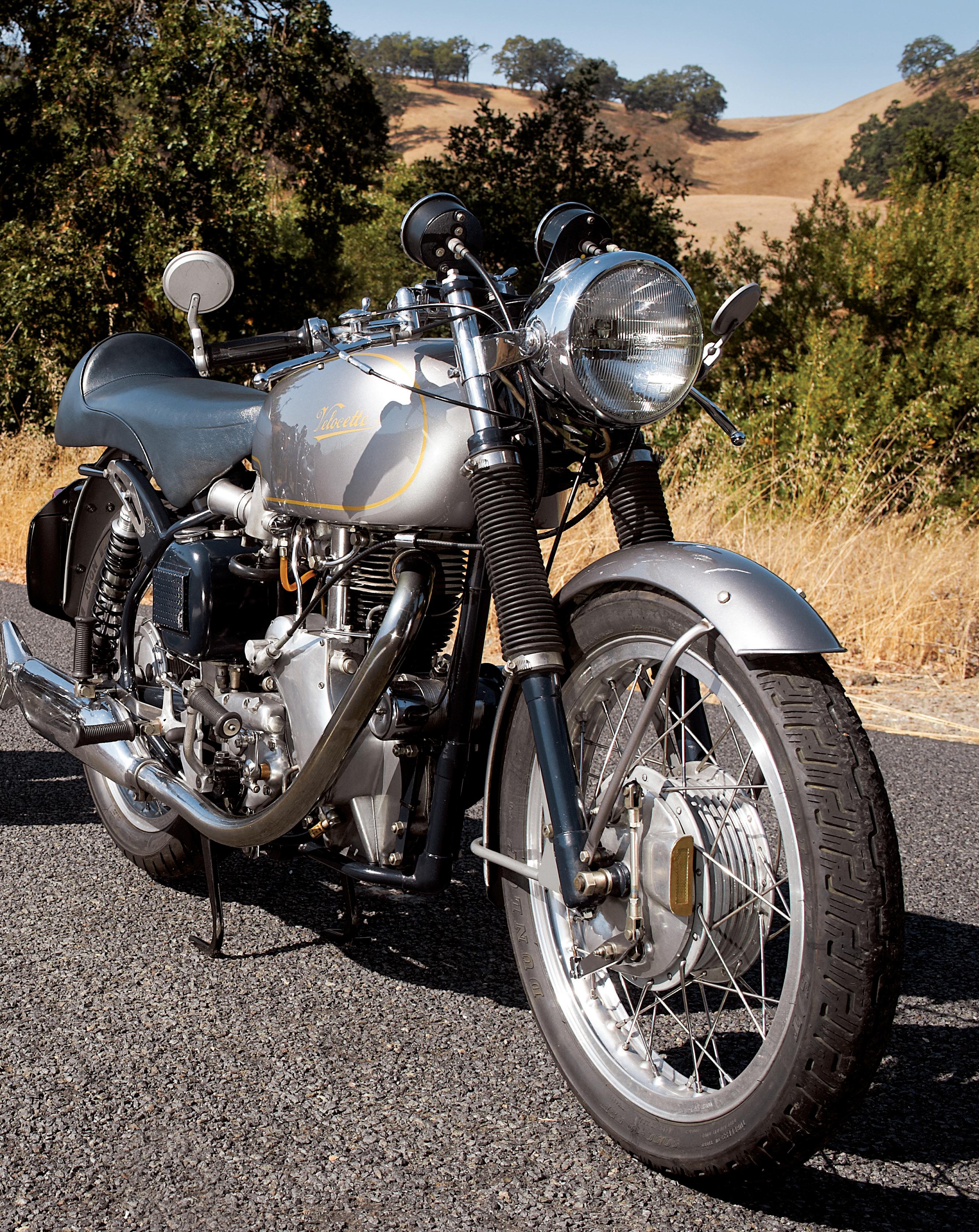



















In 1939, England plunged into World War II and civilian motorcycle production stopped. Velocette built some military motorcycles based on a 350cc version of the MOV, but did not receive large military contracts like BSA and Norton did. As the war ended, Velocette was weakened financially.
The seed is sown















1966 VELOCETTE THRUXTON

Postwar, small commuter bikes were supposed to be the coming thing, but Velocette’s innovative sidevalve horizontal opposed twin, the LE, although very popular with police departments, was not a success with enthusiasts. Fortunately, someone at Velocette realized that while the market for its docile little twin was soft, the market for sport machines was not. Although Velocette’s postwar plan had been to focus on the LE, production of the 349cc MAC was continued.
Mostly unknown in the U.S. prior to World War II, Velocettes were discovered by American soldiers stationed overseas during the war years. Jack Frodsham started importing Velos to the United States after the war, before selling his operation to Lou Branch in 1949. Velocette had phased out production of the 495cc MSS (and all other models besides the MAC and LE) after the war, but by the early 1950s both Frodsham and Branch were pushing Velocette to build another 500.
In 1953, Velocette introduced an updated swingarm frame for the MAC. Front suspension was by hydraulically damped telescopic shocks, and the rear suspension was easily adjustable for load by moving the top end of the shocks along an ingeniously designed slot. Velocette did not have the capital to redesign the new MAC frame to accept

the taller MSS engine, so factory engineer and designer Charles Udall reconfigured the MSS to fit. The result was a square 86mm x 86mm bore and stroke 499cc engine, unusual at the time. Not only did it fit in the existing frame, but it turned out to have better breathing and the capacity to rev higher than previous longstroke engines.
Introduced in 1954, the new MSS was quickly discovered by California desert racers. Jim Johnson won that year’s
Catalina Island GP on an MSS, and Velocette started producing a scrambler and an enduro version of its big single for the American market. Tex Luce successfully flat tracked a reworked enduro MSS built by Ernie Pico.


In 1956 Velocette brought out two sporty versions of the MSS: the 349cc Viper and the 499cc Venom. Evaluating the Viper in 1958, The Motor Cycle, one of the two English motorcycling weeklies, proclaimed it “a remarkably fine motorcycle,
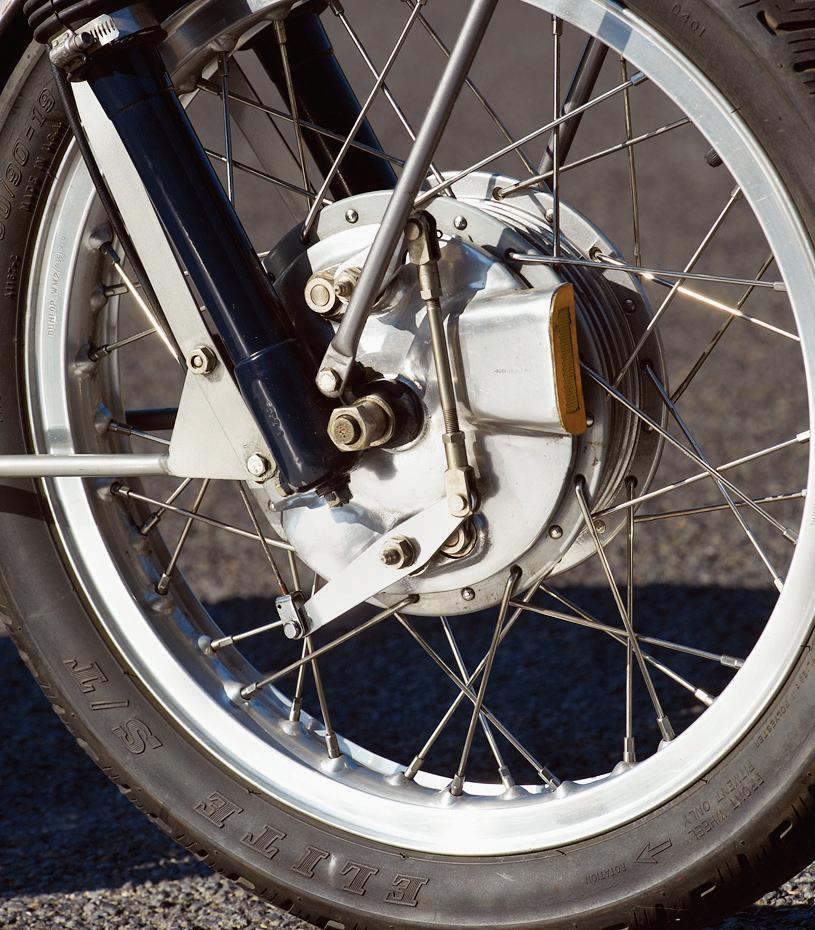

www.MotorcycleClassics.com 21
At 499cc, the overhead-valve single produces 41 horsepower. The twin-leading-shoe drum front brake was king in its day.
all round performance well above the average,” and capable of 90mph-plus.




Both the Viper and the Venom had bi-metal cylinders, with a cast iron liner welded to an aluminum alloy jacket by the Al-Fin process. The heads were also aluminum, enclosing hairpin valve springs. The bottom end ran on tapered roller bearings, and lubrication was dry sump.
Venom, then Thruxton


















The Venom, like all Velocettes, had its share of quirks. Chief among them was “The Starting Procedure,” the subject of a full paragraph in the owner’s manual and a process that had to be followed exactly or the bike would not start. Plate distortion could stop the clutch (which used multiple small springs) from lifting cleanly, and the magneto and generator ignition was hopelessly outdated. But enthusiasts didn’t mind, as the Venom was one of the best of the big British singles — fast, good handling and great looking.
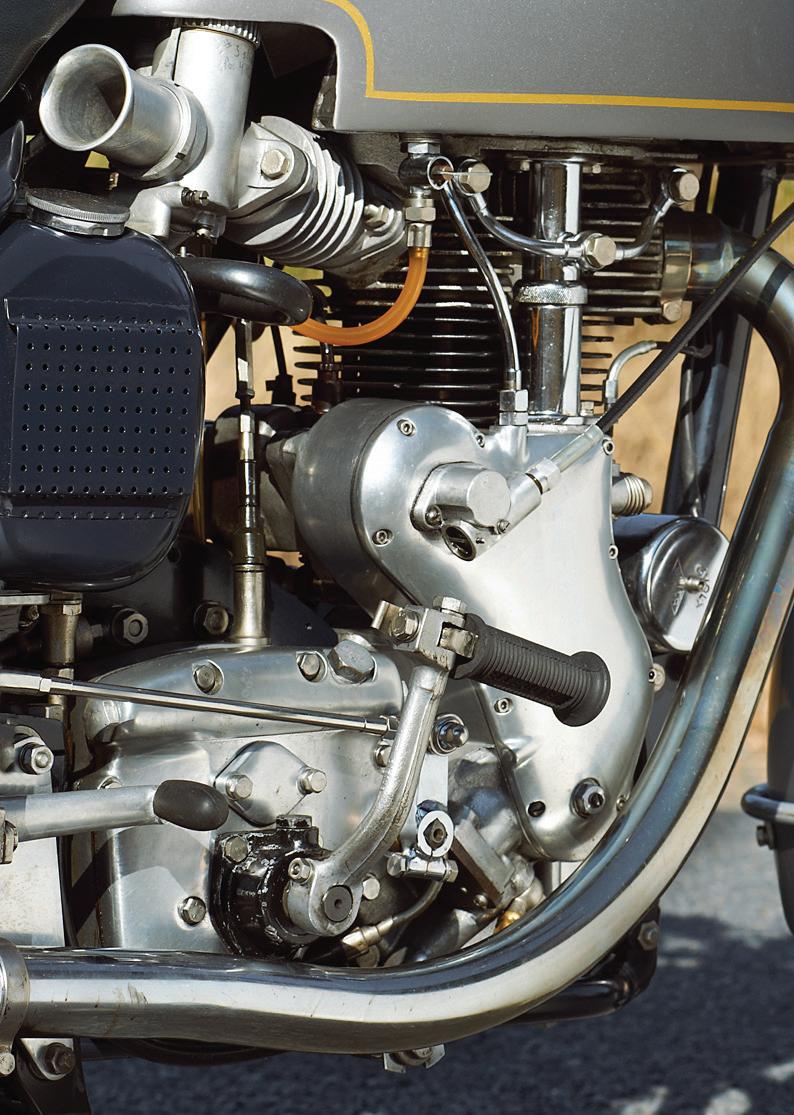
In 1960, Velocette introduced the Venom Clubman, basically

a production racer with lights. It sported an Amal TT carburetor, a racing magneto and rearsets. By this time the third generation of Goodmans was running the show, including Bertie, son of Percy and a pretty good racer himself. A factory team took a Clubman to the banked circuit at Montlhéry outside Paris in 1961, and set 12- and 24-hour records of 104.66mph and 100.05, respectively.
In 1964, a racing cylinder head became available for the Venom. Possibly designed by Lou Branch, some sources state it was actually the work of Dick Brown at Modern Cycle Works in Los Angeles. It had a larger intake valve, a revised inlet tract and a narrower valve angle. Velocette built special gas and oil tanks, notched to clear the large 1-3/8-inch Amal GP carb the head used.
A Venom with the optional head won its class in the Thruxton 500-mile endurance race that year, and the next year, a new version of the Venom, the Thruxton, was introduced. Velocette claimed 41 horsepower at the crankshaft — 44 with a megaphone instead of a muffler. The American importer advertised it as “a man’s machine,” possibly because the starting procedure had gotten no easier over the years.
How to start a Thruxton
From the so-called “Red Book” Velocette service manual: “Turn on the fuel of both taps, and if the engine is cold, flood the carburetter. Some machines may need a little flooding even when hot to get a ‘first-kick’ start. Retard the ignition to approximately half the travel of the lever. Depress the kickstart crank until compression is felt. Release the crank and allow it to return to the top. Using the exhaust valve lifter control, press down the kickstart crank slowly to the bottom — no farther. After bringing the kickstart crank back to the top again, the engine is ready to start by using the kickstart without lifting the exhaust valve. One kick should suffice if the throttle has been set correctly. The throttle valve should not be opened more than approximately 1/16-inch when starting.”
The Thruxton had the standard Venom dual-loop frame with upgraded telescopic forks, clip-ons, rearsets and the Velo fishtail “Brooklands can” muffler. It was good for up to 110mph stock — and a lot more with knowledgeable tuning. With standard gearing, a Thruxton turned 4,000rpm at 70mph.
Later Thruxtons swapped the highstrung GP carb for an Amal Concentric, the compression ratio was raised a bit, and from July 1968 on a battery and coil ignition became available, which might have made starting a tad easier. Color was generally silver/blue, but customers could order their Thruxton traditionally finished in black with gold pinstriping.
Our bike
Our feature bike has a somewhat unusual background. Pat Peddicord was in the business of selling Velocettes in Southern California when he bought our silver/blue 1966 Thruxton feature bike from a customer in 1968. At the same time his son, Terry, was riding a black 1966 Thruxton.
22 MOTORCYCLE CLASSICS Street Bikes of the ’60s
Want a Thruxton? Be ready to get real familiar with this kickstart lever.
Fast-forward to about 10 years ago when British motorcycle enthusiast Frank Recoder started looking for a Thruxton. About 1,058 Thruxtons were built in the five years of production (an estimated 60 more were assembled from original bits after Velocette went out of business in 1971), and these are now scattered around the world. Surviving Thruxtons are, not surprisingly, rare, and often get passed from one “Velocettista” to another, so Frank started working his way into local Velocette circles. Eventually, he got a lead on a silver/blue Thruxton, Pat Peddicord’s bike.
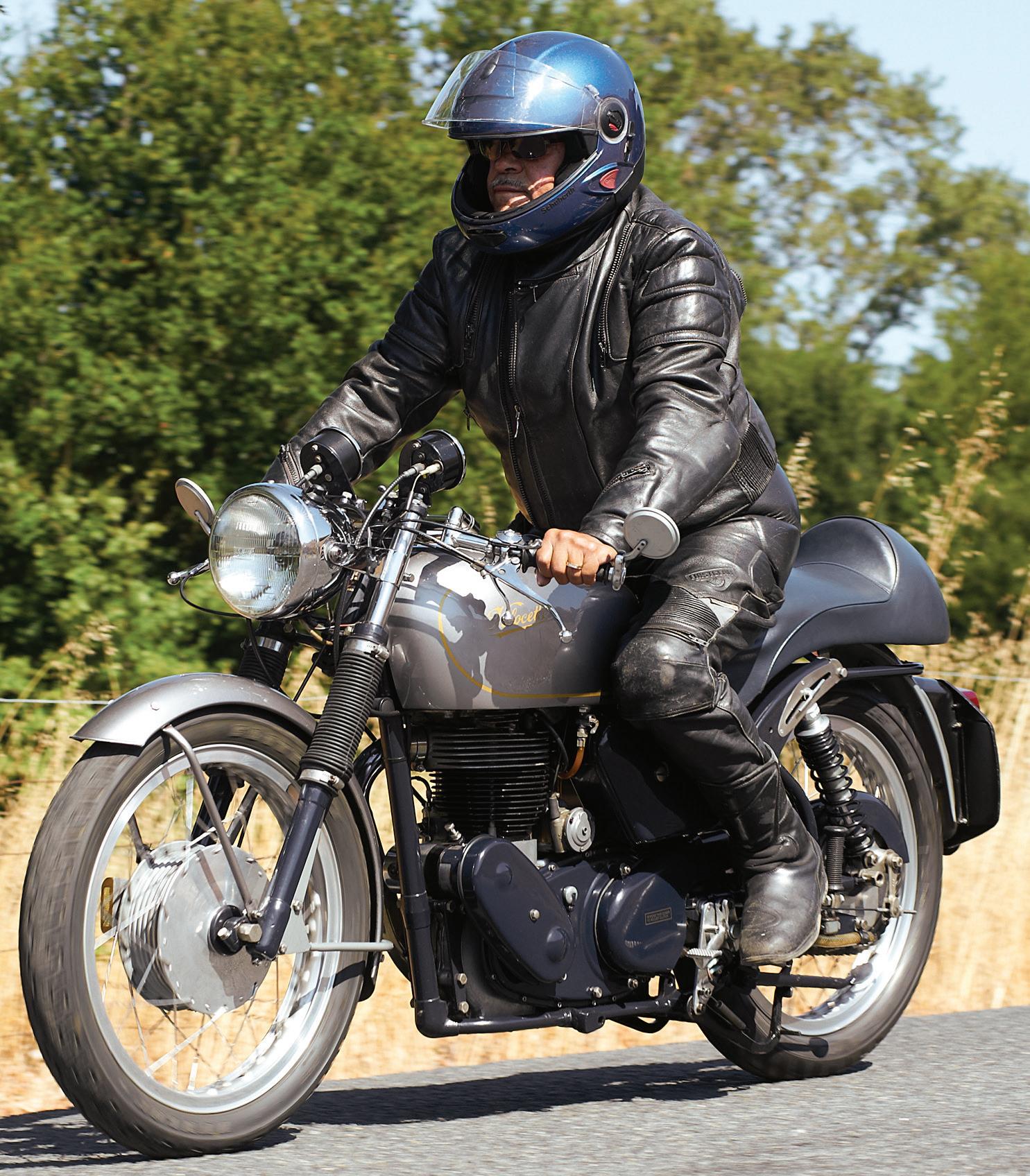

Pat had passed on, and his Thruxton belonged to his widow. “Pat had gone for a ride, parked the bike and collapsed. They found him too late,” Frank says. Although the bike had sat for seven years, the Peddicord family wasn’t sure they wanted to sell it, and it took two years for Frank to convince them he would care for the bike as Pat had. At that point, Terry mentioned he had a second Thruxton, apart and in boxes.
Frank took possession of the silver/blue bike (called Deep Blue/Metallic Silver by Veloce), which, while mostly complete, wasn’t running, and set to sorting it out. At first, Terry didn’t want to part with his black Thruxton, but then his wife had a baby, and some four months later Frank took possession of what he says was 70 percent of a Thruxton, including all the sheet metal. He called Velocette specialist Ed Gilkison, who’d helped get the silver/blue bike going, for help.
Ed did the machine work, located missing engine parts, and provided support, advice and encouragement for the project. Eight months after Frank bought the black Velo, it was back together. “Then it took me six months to sort it out and locate all the leaks,” he says.
Since getting both bikes going, Frank has more or less decided the black Thruxton is the rider and the silver/ blue bike is the show bike, although he did show the black bike at the 2012 Quail Motorcycle Gathering. This past summer, Frank and his wife, Elizabeth (an enthusiastic pillion rider), rode the black Thruxton to the annual Velocette rally in Arizona. “Five days of riding — 1,000 miles!” Frank says, smiling at the memory.
Frank says owning and maintaining a Thruxton isn’t too bad, but setting up the clutch is tricky. “It’s unusual — very thin. It has two plates that slide and three driven plates. You have to adjust it by turning the spring-loaded center. The engine has to go through a cycle before the clutch opens. You have to watch first gear and time gear changes or the transmission will make noise. But once it’s set up it works fine. I set the clutch on the silver Thruxton 3,000 miles back and it still works fine.”
Like all vintage bikes, oil changes are frequent on a Thruxton. “I change the oil every time I come back from a rally. I used to put hypoid gear oil in the transmission, but I had problems with a leaky tranny. I read an article in the Velo club newsletter that recommended lighter oil. Oil is kept in the transmission by deflection washers; the return holes are small, and thick oil will clog the holes. I use 50 weight Motul now,” Frank says.
As much as Frank likes his Thruxtons, they aren’t without challenges. Difficult to start when cold, the GP carb has no idle circuit, so once you get a Thruxton started, you have to rev it until it is warm. Frank says it takes five minutes, but after it’s warm, it’s a sweet engine with a wide powerband and loads of torque. “I normally rev the engine to 5,000rpm,” Frank says. “Max is 6,200rpm. It holds its line on twisties — I can maintain speed, switching from second to third gear and back. It has plenty of power. I can really feel it pulling out of corners. It’s unique — a pleasure to ride and a nice rush. The bike responds to you and repays all the work you have to put into it. Thruxtons are racers. Once you find that sweet spot, about 70-75mph, you can go forever.”
These two 500cc Velocettes are part of two families’ histories and another family’s present. Designed and built by the Goodman family in England, and owned, ridden, repaired and loved for years by Pat Peddicord and his son, Terry, stalwarts of the postwar Southern California motorcycle scene. The Goodmans no longer build bikes, and Pat Peddicord is gone, but these rare classics are still here, now owned by Frank and Elizabeth Recoder, who treasure them both. MC
www.MotorcycleClassics.com 23
Owner Frank Recoder enjoys riding both his Velocette Thruxtons, though he’s decided the silver one is the show bike and the black one is the rider.
“Then it took me six months to sort it out and locate all the leaks.”
“D” FOR DESMO


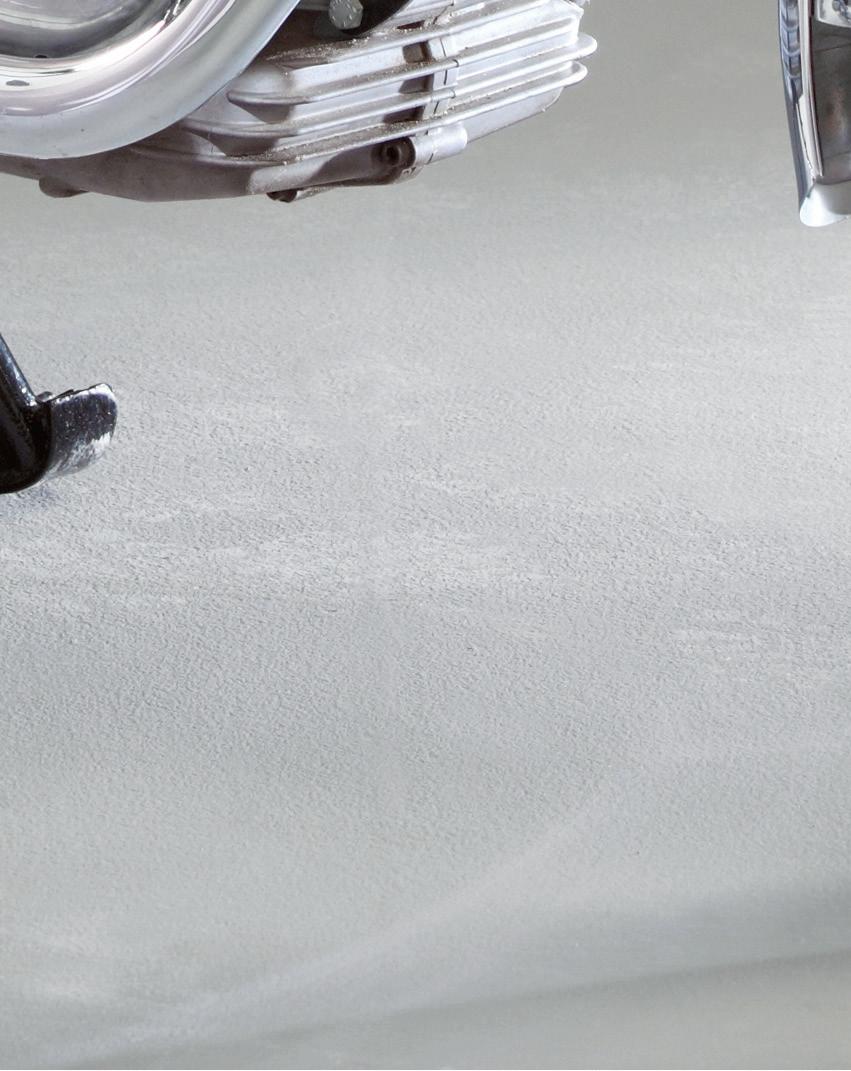
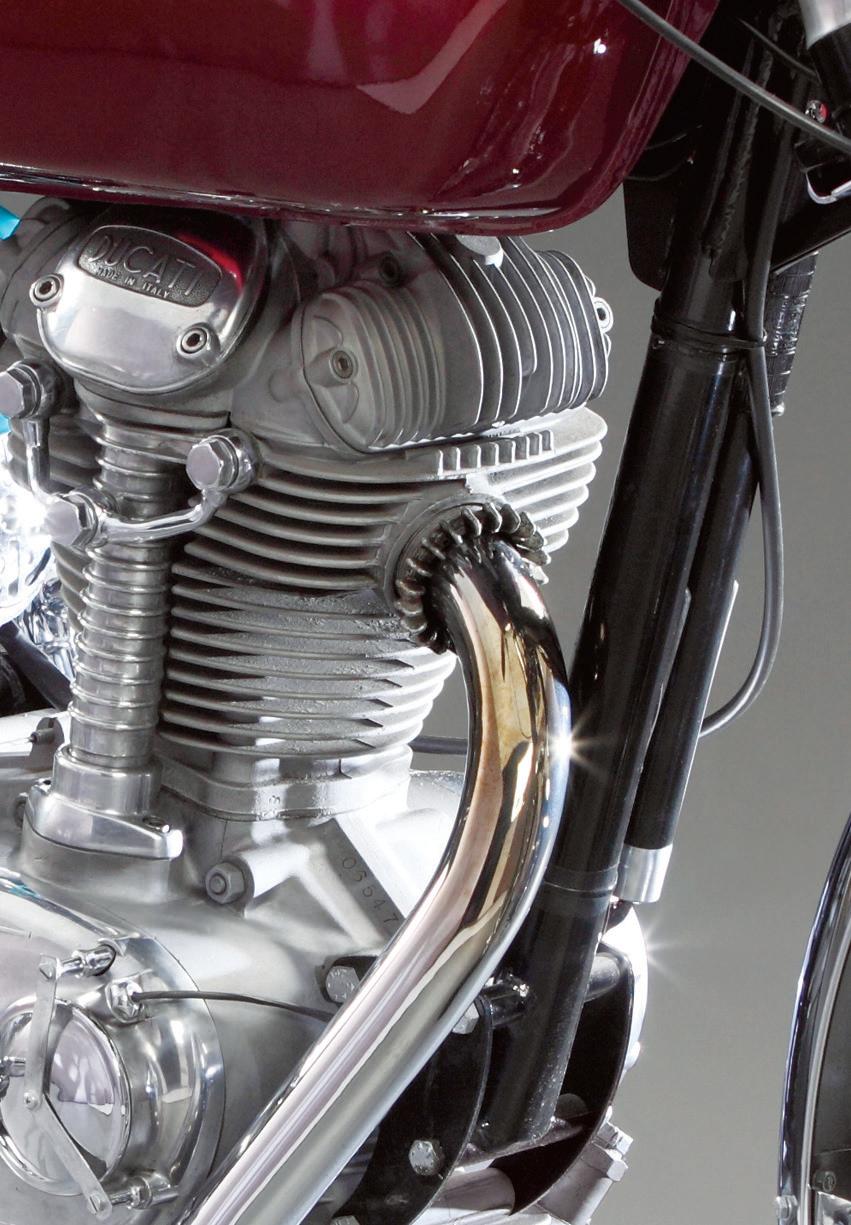



























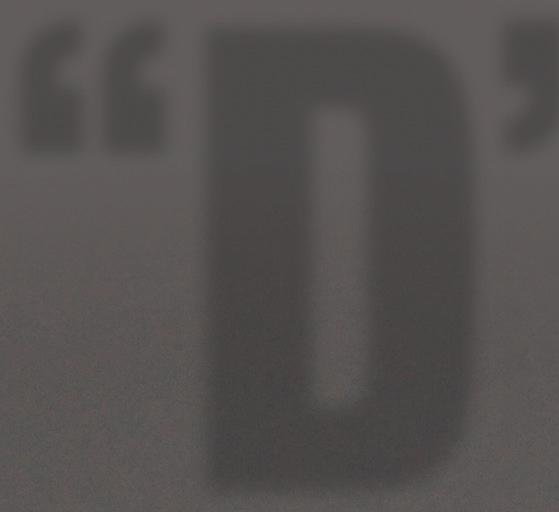
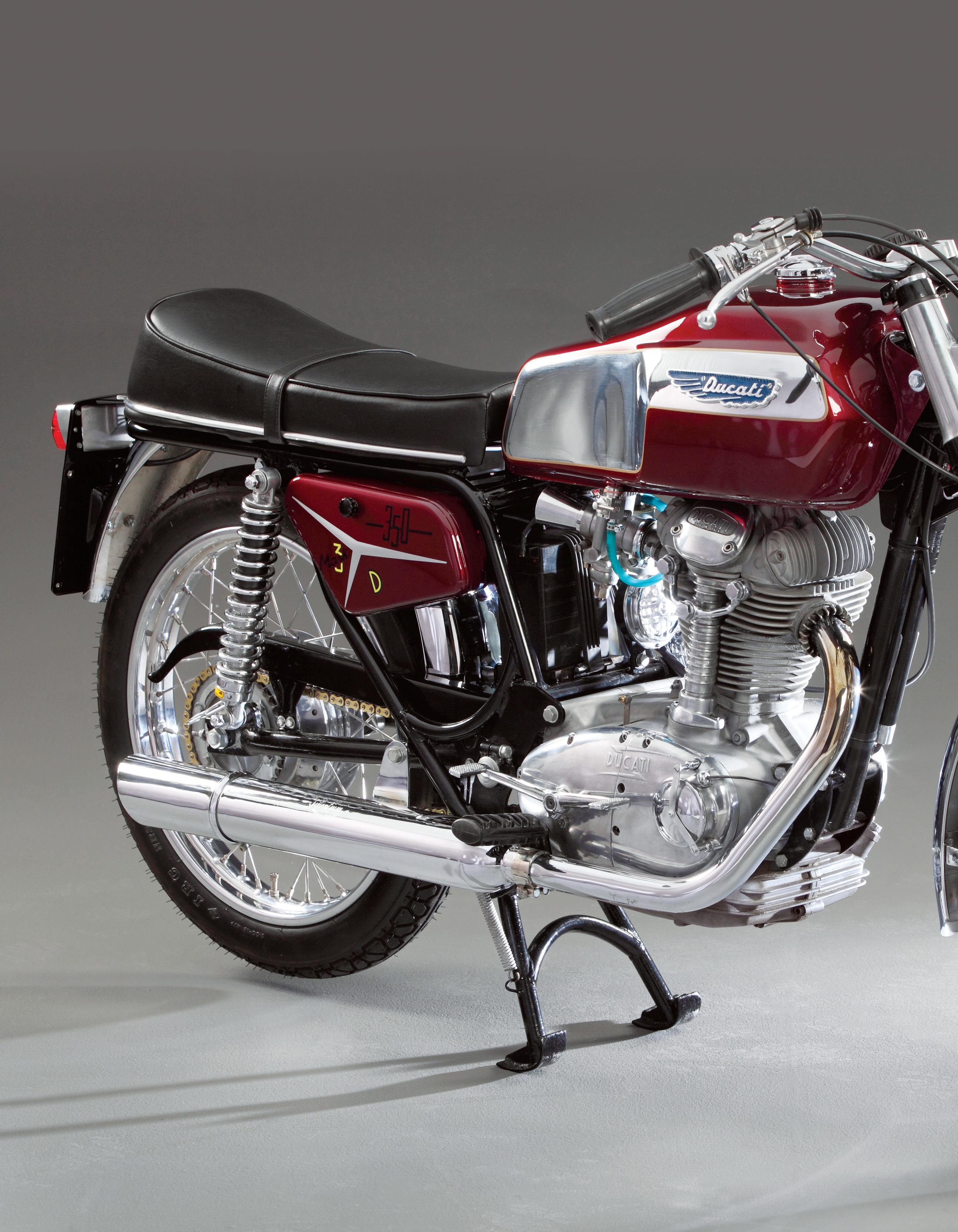 1969 Ducati 350 Mark 3 D
Story by Greg Williams
Photos by Jeff Barger
1969 Ducati 350 Mark 3 D
Story by Greg Williams
Photos by Jeff Barger
It’s a long transition from a Doodlebug scooter to a 1969 Ducati 350 Mark 3 Desmo. In fact, it would be difficult to find a better example of two-wheeled evolution — from antiquated to advanced.
Doodlebug, a little scooter with a Briggs & Stratton 1-1/2 horsepower engine and diminutive tires. His Doodlebug was direct drive, missing the fluid clutch it would have had when delivered new from the Beam Manufacturing Co. of Webster City, Iowa. At stop signs and red lights he would lift the rear wheel, then, with the intersection clear, he’d drop the back of the scooter and open the throttle. Don wasn’t going anywhere fast.
He was just 13, and the Doodlebug, his first ride, was freedom. Don’s never been without a motorcycle since. Over the years he’s owned different makes including Harley-Davidson, Honda, Moto Guzzi and Triumph, but he has a soft spot for Italian products.

A retired ironworker, Don worked building bridges and towers in his home state of Wisconsin. Some 13 years ago, he turned his attention to motorcycle restoration. “My son, Scott,
found a 1966 Ducati Monza Jr. 160 and said he’d like to restore it,” Don says. “But he didn’t have time and I’d just retired, so I took over the job — that was my introduction to complete restorations.”
Don’s motorcycling history is quite interesting. His first “big” bike was a HarleyDavidson K model. But his friends were all riding British, so he bought a brand new 1960 Triumph TR6, which he then traded in 1965 for a Bonneville. When he heard about the Honda CB750 Four in 1969, his name was second on the list at the local dealer. He bought another CB750 in 1971, followed by two Suzuki GT750s — a 1972 and then a 1973 — before buying a Kawasaki 900 in 1974.
“The Kawasaki went fast in a straight line, but it wiggled around the corners,” Don recalls. “I preferred handling over straight-line speed, so in 1975 I got a Moto Guzzi 850T, and then traded that in 1977 for a Moto Guzzi LeMans. I didn’t think anybody could build anything better than that, and I still have that bike.”

Every two or three years, he’d buy or trade up, and if he had any emotional attachment to a motorcycle, he’d keep it — witness the LeMans and his 1992 900SS Ducati, which now shows 55,000 miles on the clock. There are currently 18 machines in his collection, and one of them is this 1969 Ducati 350 Mark 3 D.
Taglioni’s designs








The Mark 3 D is about as far from a Doodlebug as one can get, and the difference in technology is thanks to Italian designer Fabio Taglioni. In 1949, Taglioni sketched a 75cc double overhead cam engine as a design exercise while studying for his doctorate at the University of Bologna. He sold the resulting engine plans to Ceccato, and then studied for two years under Alfonso Drusiani at Italian motorcycle manufacturer Mondial. Taglioni joined Ducati in 1954, and his first design was the 98cc bevel gear overhead cam Gran Sport, which was nicknamed “Marianna” in Italy.
Taglioni’s Gran Sport proved competitive in Italian race events during the mid1950s, sweeping its class at the MilanoTaranto and the Giro d’Italia races. Grand Prix racing was next, and Taglioni’s design brief netted a 125cc double overhead cam
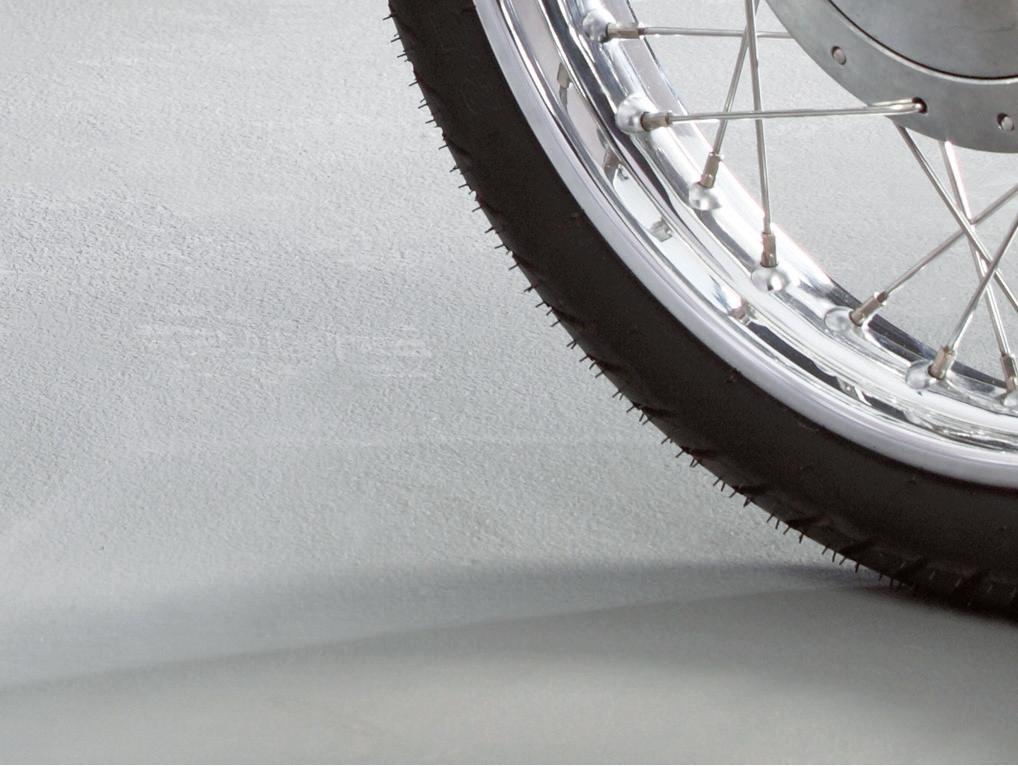




www.MotorcycleClassics.com 25
Like the rest of the little Ducati, even the heel/toe shifter is slender and graceful, a promise of pleasure.
single. Although reliable, the engine wouldn’t rev high enough to make decent power. Allowed to rev out at 11,500rpm, the valves would float and hit the piston crown. Looking for a solution, Taglioni settled on desmodromic valve actuation.
Overhead valve engines use a cam or pushrod and rocker to open the valve but rely on spring pressure to force the valve closed. Desmodromic engines instead use separate rockers — one to push the valves open and another to pull them shut. This helps avoid problems such as valve float and valve spring failure. Taglioni did not invent the desmodromic valve concept, and the technology has been around since the early years of the 20th century. Other motorcycle engine designers tinkered with the approach, including Norton and J.A. Prestwich. In the mid-1950s, automobile manufacturer Mercedes-Benz famously and successfully campaigned desmodromic valve engines in the W196 racer.
1969 DUCATI MARK 3 DESMO
Desmo debut












With desmo actuation, Taglioni’s single could cleanly rev to 12,500rpm, and in 1956, the 125cc works racer took the win in its debut at the Swedish GP. Although the desmo was successful at the track, Ducati’s road-going singles used bevel drive overhead camshafts and rockers, with enclosed hairpin valve springs. This engine style became widely known as the “narrow case” design, with front and rear engine mounts the same width. Ducati singles grew from 100cc to
125, 160, 200, 250 and 350cc models, and of them all, the most memorable would be the 250 Mach 1.
In 1967, Ducati launched a redesigned frame featuring twin tubes running from the back of the gas tank down to the swingarm pivot. This new frame required a wider rear engine case mount — approximately 3 inches wider than the front — and these subsequently became known as “wide case” engines. Between the two styles, narrow and wide case, the basic architecture remained the same.
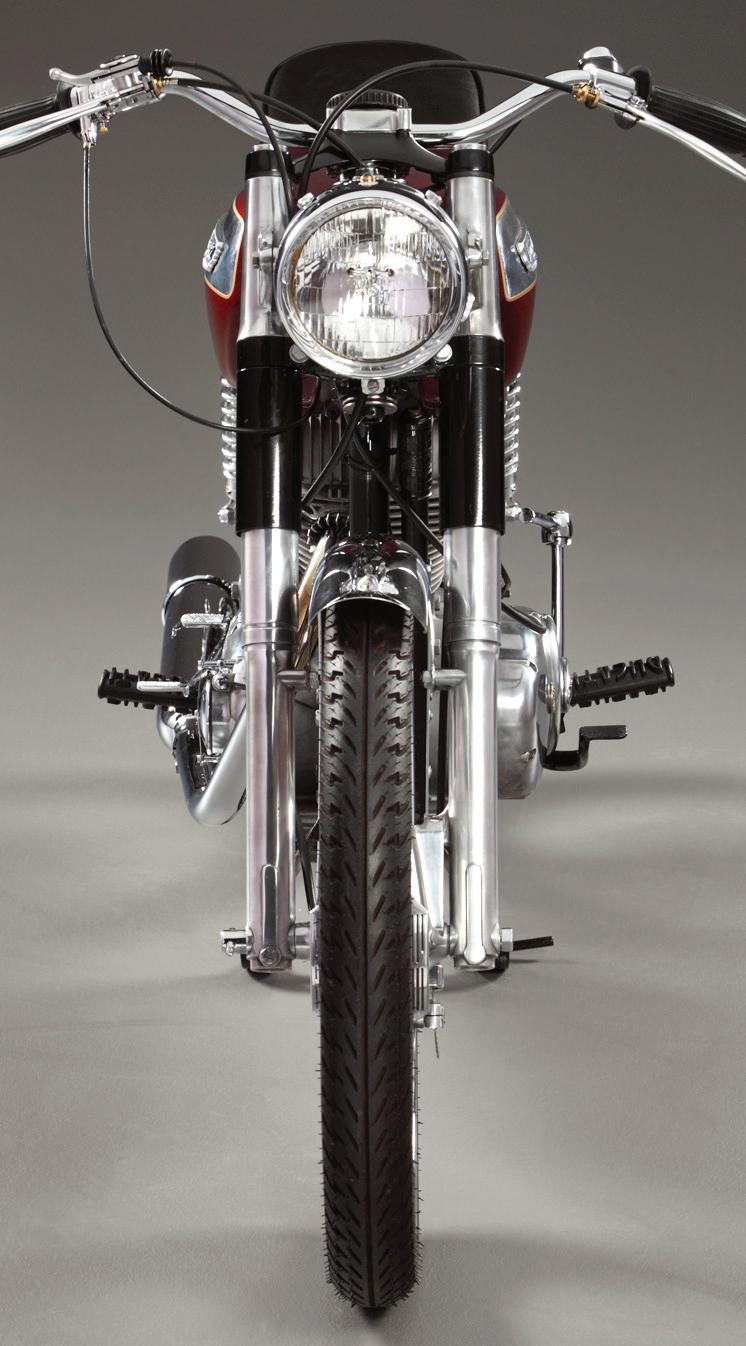
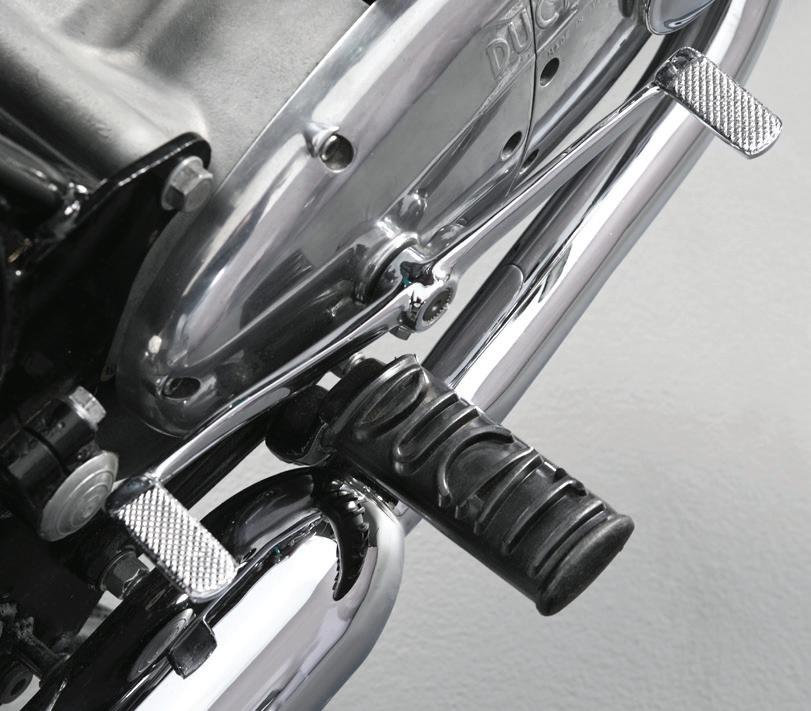


Ducati brought the new frame and wide case engine design to the street in 1968, first in the street-legal 350cc Scrambler, then also in 250cc and 450cc models. All of these used a bevel drive overhead cam with valve springs. During 1968, Ducati finally brought a desmo to the street with the launch of the 250 and 350 Mark 3 D — “D” for Desmo.
The 1968 Ducati Mark 3 D featured a red frame, a red and chrome gas tank with twin-filler caps, chrome fenders, steel rims, a high-lift cam and a tachometer. In 1969, the 250 and 350 were joined by a 450 Mark 3 D, and they were outfitted with a black frame and a single-cap fuel tank and chrome fenders. Non-desmo Ducatis feature a dull silver paint in place of the chrome.

Ducati’s 350cc single-cylinder desmo engine is all alloy with polished cases and massive finning on the barrel, which features a cast-iron liner. Bore and stroke are 76mm by 75mm for a capacity of 340cc, with a 10:1 compression ratio. The 5-speed unit construction gearbox has a heel/toe shifter on the right side of the engine, with the kickstarter on the left.
Cycle magazine tested the Mark 3 D Ducatis, including the 250, 350 and 450 models, which, apart from engine size, are of the same overall dimensions. “The Ducati’s single-cylinder engine has narrow cases; therefore, the frame, the tank and the footpegs can all be very narrow, too. You can fit yourself more easily to a well-
laid-out narrow motorcycle than you can to the fat bikes, and the result is a feeling of instant confidence … the Ducatis feel as though they had been built just for you, and that they weren’t something that came out of a crate,” Cycle said.
Of the 350cc desmo engine, they wrote: “The 350 was more highly tuned and had a narrower powerband; the power came
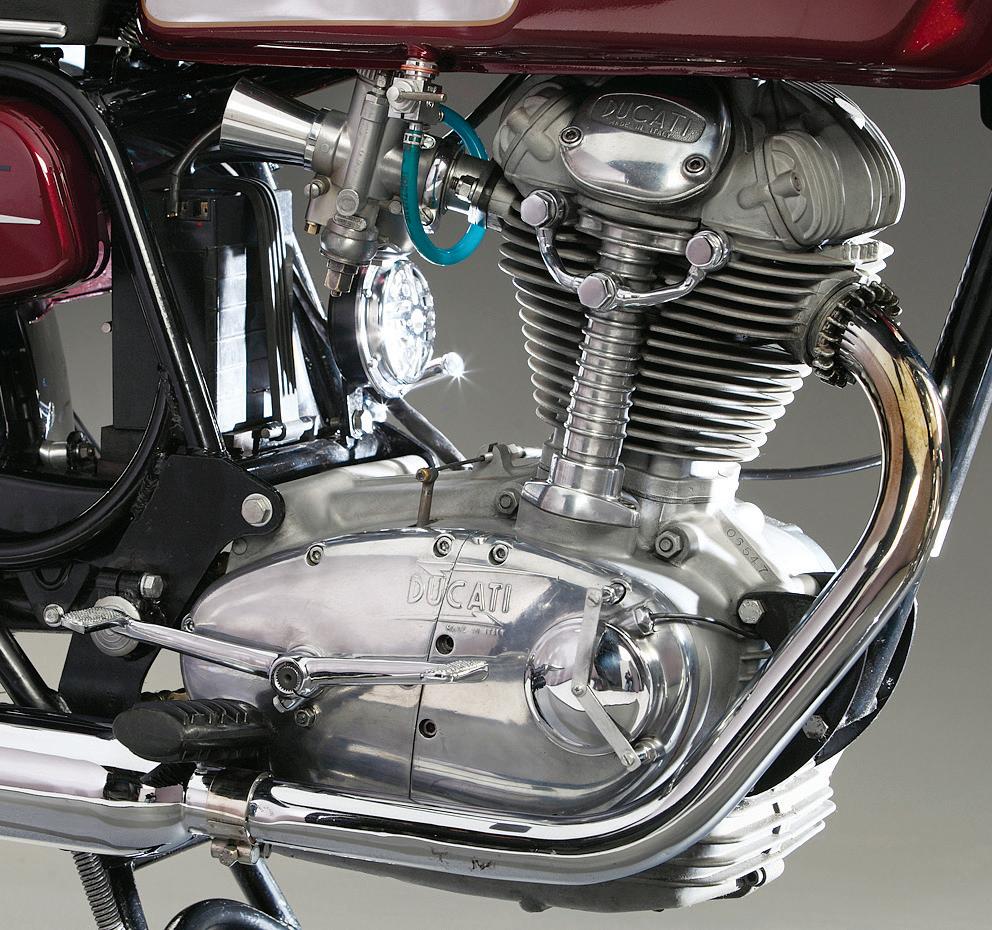
driven to the event, as he had no plans to purchase a motorcycle. Luckily, friend Erik Eskildsen was driving through to Florida with his truck. He told Don if he found something he couldn’t live without he would haul it south with him, and bring it home to Wisconsin in the spring.
Don was drawn to a Benelli being sold by father and son team Dwight and (the late) Brian Corley. The Benelli was already spoken for, but then he noticed a Ducati single-cylinder engine.
“The head had been removed,” Don says. “Dwight told me the desmo head was good, but the engine was seized.” Dwight picks up the story. “My son and I were mostly into British bikes, but we heard about this Ducati in Georgia, so we went to have a look at it — it had seen years of exposure, but we picked it up thinking we might be able to redo it. The more we looked at it the more we thought somebody else could probably do something better with it.”
in at about 6,500rpm. The 350 is tuned as a street dragster; the 250 and the 450 are over-the-road bikes.”
Don’s 350 D
Don found his 1969 350 D at the 2010 Barber Vintage Festival swap meet in Birmingham, Ala. He and a friend had
The rest of the bike was stored in the Corleys’ trailer behind their camper. “The bike was a wreck,” Don explains. “The wheels were frozen and badly rusted, the alloy hubs were crusty and the entire bike was rusty. There was a dented Ducati Scrambler tank and a high handlebar on it.” However, because it had a Desmo engine, Don paid the Corleys $1,500 and had Erik haul it home to Appleton, Wis., by way of Florida. Don didn’t get to work on the bike until
www.MotorcycleClassics.com 27
The desmo singles are all based on the “wide case” block.
the spring of 2011. Stripping the Ducati down proved the frame was straight, but the swingarm pivot bolt was rusted in place. Don drilled small holes in the back of the swingarm and filled the cavity with penetrating oil. “I had a punch the exact size of the shaft, and every so often I’d give it a crack. After two months, it finally moved,” Don says.
With help from Jonathan White of Prova LLC in Cincinnati, Don began accumulating the correct pieces for his 350 D, including a coffin-style tank and the correct steel front fender, both sourced on eBay. The fenders, springs, kickstarter and shift lever were chrome-plated. The frame was powdercoated black, and Bryan Gagnon of B&J Custom Cycles & Graphics in Shawano, Wis., finished the gas tank and side panels cherry red, a hue Don says is slightly darker than what Ducati would have used. The bike was missing its seat, so he found a used seat pan and had a new cover stitched by Korth Upholstery in Appleton. Don polished the alloy wheel hubs and laced them to 18-inch stainless steel rims with stainless spokes. As for the engine, Don says he couldn’t have completed the build without help from friend Erik King. The lower end proved to be in fine fettle, but while it was apart everything was
polished, and the crankshaft was treated to new bearings. A used muffler and header pipe came from eBay, and both were chrome-plated after Don removed the muffler baffle. On the 1969 350 D the correct carburetor is a Dell’Orto SS1 29D,
and Don’s machine is so equipped. Chris Dietz of Motion Products in Neenah, Wis., rebuilt the Ducati wiring harness, Don detailed the hand controls and levers, and new rubbers and cables completed the build.
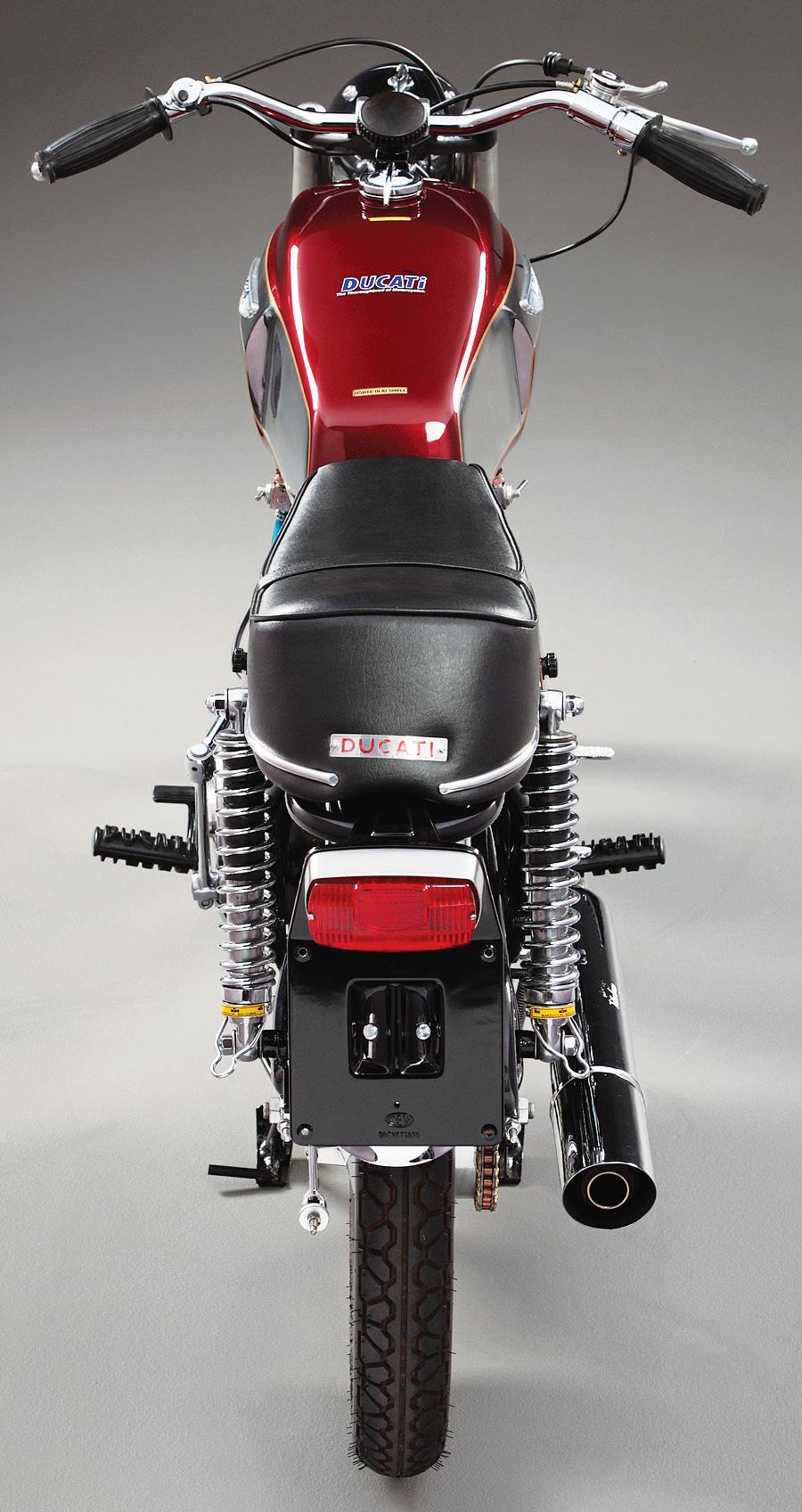
The finished product
“It was scary to fire it up for the first time,” Don says. “You’ve got to kick it deliberately, because it’s got great compression and will kick back. They’re all a bit different to start, and I haven’t got this one down quite yet, but it did start on the fourth kick and it’s been running good since. You can just about feel the piston going up and down when the bike takes you forward, and it handles great. You can carry a lot of speed into a corner because it’s so light, and that really makes it fun to ride. The brakes are a bit weak, but because the bike is light they’re really not a big issue.”
Don restored his Ducati using original components, and with the materials that were available when the machine left the factory, as much as possible. “I want to transport myself back to that time, and I restore them so I can appreciate what I used to ride,” Don explains, adding, “I restore them to preserve an old bike, not to make an old bike modern.” MC


28 Motorcycle classics Street Bikes of the ’60s
Owner and restorer Don Smith with the Ducati, one of a growing collection.

© PIAGGIO GROUP AMERICAS 2017 MOTOGUZZI.COM
ELEGANCE IN MOTION
1962 BMW R60/2
Story by Greg Williams

 Photos by Ken Richardson
Photos by Ken Richardson
TThe Apple computer I’m using as I write this story and its subject matter, a BMW R60/2, have something in common. In the early 1980s, long before Apple and its iProducts were household names, Steve Jobs, the enigmatic mind behind the company, rode around San Francisco on a 1966 BMW R60/2.
When Jobs wasn’t riding it, the BMW was parked in Apple’s atrium lobby. Walter Isaacson, author of the 2011 biography/autobiography Steve Jobs, wrote, “Over time, the atrium attracted even more toys, most notably a Bösendorfer piano and a BMW motorcycle that Jobs felt would inspire an obsession with lapidary craftsmanship.” The word “lapidary” has a couple of definitions, one of them being “careful, elegant and dignified in style.”
It’s clear that Jobs felt classic BMW motorcycles offered refined elegance and dignified grace, especially in the case of machines built in the 1960s. In this era, BMW offered multiple models, including the R50/2, R60/2 and the R69S. All of these machines shared the same chassis, but were powered by either 494cc or 594cc engines in different states of tune.

Between 1955 and 1969, BMW built the low compression 500cc R50, the high compression R50S, the low compression 600cc R60, and, as introduced for 1956, a high compression R69. Technically, only machines constructed from 1960 to 1969 carried the /2, or “Slash 2,” designation. 1967-1969 telescopic fork versions of the R50, R60 and R69 all carried the “US” designation instead of Slash 2 as they were for the U.S. market only. Now, however, many enthusiasts refer to the entire series as Slash 2s. Thanks to their stout and rigid double-loop steel frames with sidecar mounting points, these BMWs were commonly hitched to chairs.

30 MOTORCYCLE CLASSICS Street Bikes of the ’60s
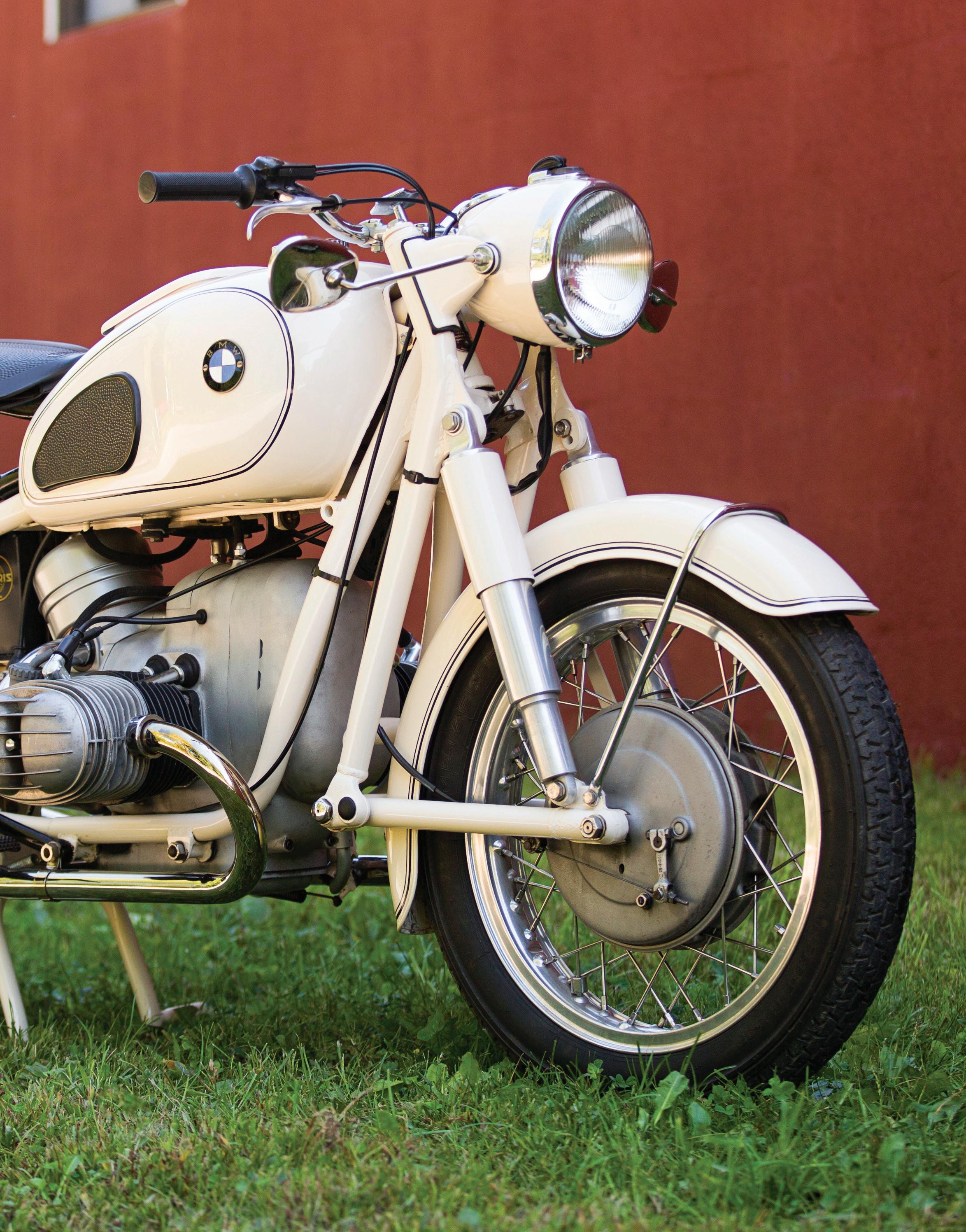
Best of the bunch











According to Philip Richter, a New York-based BMW aficionado and owner of the 1962 BMW R60/2 gracing these pages, the R60/2 is the best of the bunch. “My opinion is subjective, of course,” Philip says, acknowledging his owner bias, “but the R60/2 has a Zen-like balance. It’s true the R69S motor delivers more horsepower, but it’s heavier. The power-to-weight ratio of the R60 is superior to either the R69S or the R50. I own all three versions, and the R60 is the best of that ilk.”
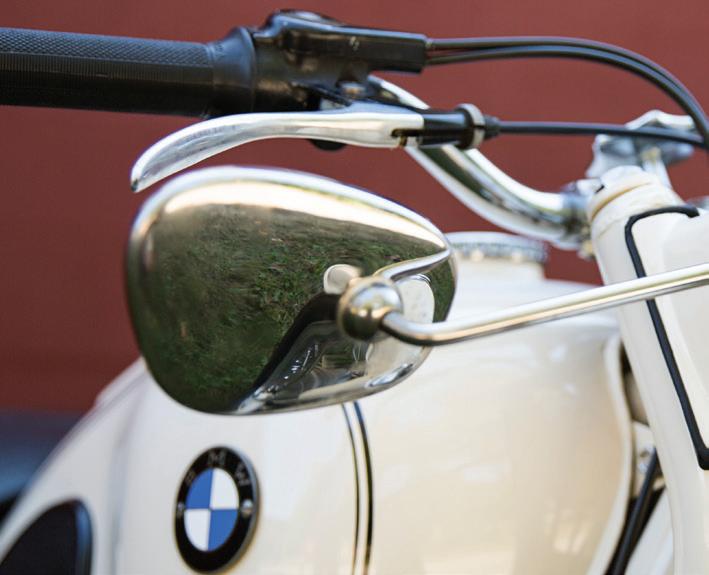








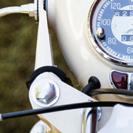


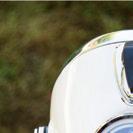

Philip comes by his fascination with German motorcycles quite honestly. His dad, Max Richter, grew up in postwar Germany and rode a small Zündapp motorcycle. It made quite an impression as he spoke of it often, and with great


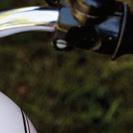

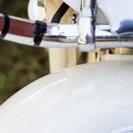
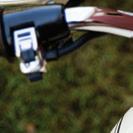

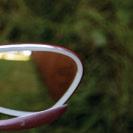



affection. When Philip was 7 he was given a 1977 Honda Z50, which he used to blast around the Bedford, New York, horse farm where he grew up. He and his brother Hans eventually built a motocross track, and moved up to larger machines. Philip never thought about a street-going motorcycle until 1992. That’s when he was enrolled at Boston College in Chestnut Hill, Massachusetts. “In your junior year they make you live offcampus, plus there’s just no parking anywhere to be had,” Philip recalls. “So, I decided to buy a motorcycle to make the 3-mile commute, because there was no reliable public transit where I lived. I used to ride straight up to the O’Neill
 1962 BMW R60/2
The Albert mirrors are a period accessory (far left). The tool kit hides in a recess in the fuel tank.
1962 BMW R60/2
The Albert mirrors are a period accessory (far left). The tool kit hides in a recess in the fuel tank.
Library and leave my bike there and head off to class.” His machine of choice was a brand-new 3-cylinder 1992 BMW K75S. “At the time, my brother had an R90/6. I loved the look of that air-cooled bike, but at 22 years old I wanted something sportier.”
The K75S served Philip well, and he treated it with respect. Phil Cheney at the now-defunct BMW Lindner Cycle Shop in New Canaan, Connecticut, took care of routine maintenance and repairs on Philip’s bike. “Whether it’s a model built in 1923 or 2015, he’s a genius and simply loves BMWs, but he particularly appreciates vintage BMWs,” Philip says of Phil’s expertise.
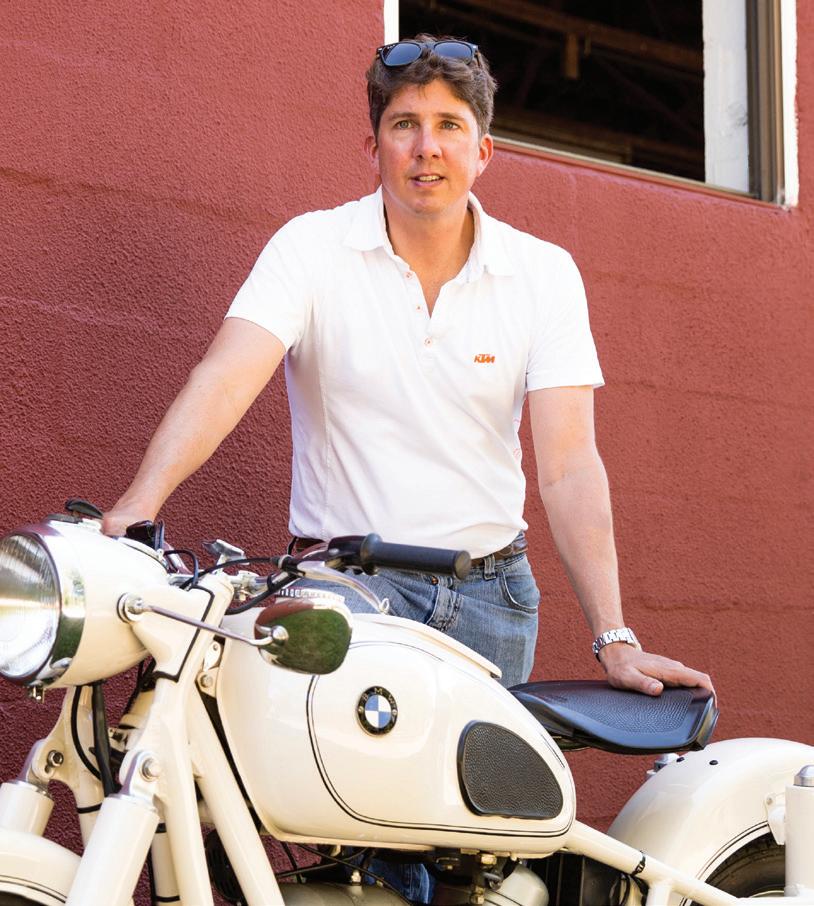
Vintage vibes
Through Phil’s influence, Philip’s interest in vintage BMWs began to blossom, and in 2000 he bought his first — this 1962 R60/2. It was completely restored by its previous owner, Bill Dauphinais, with Phil’s help. Bill took the BMW apart in his basement, and had Phil take care of the more intricate pieces such as the engine, transmission and rear drive.
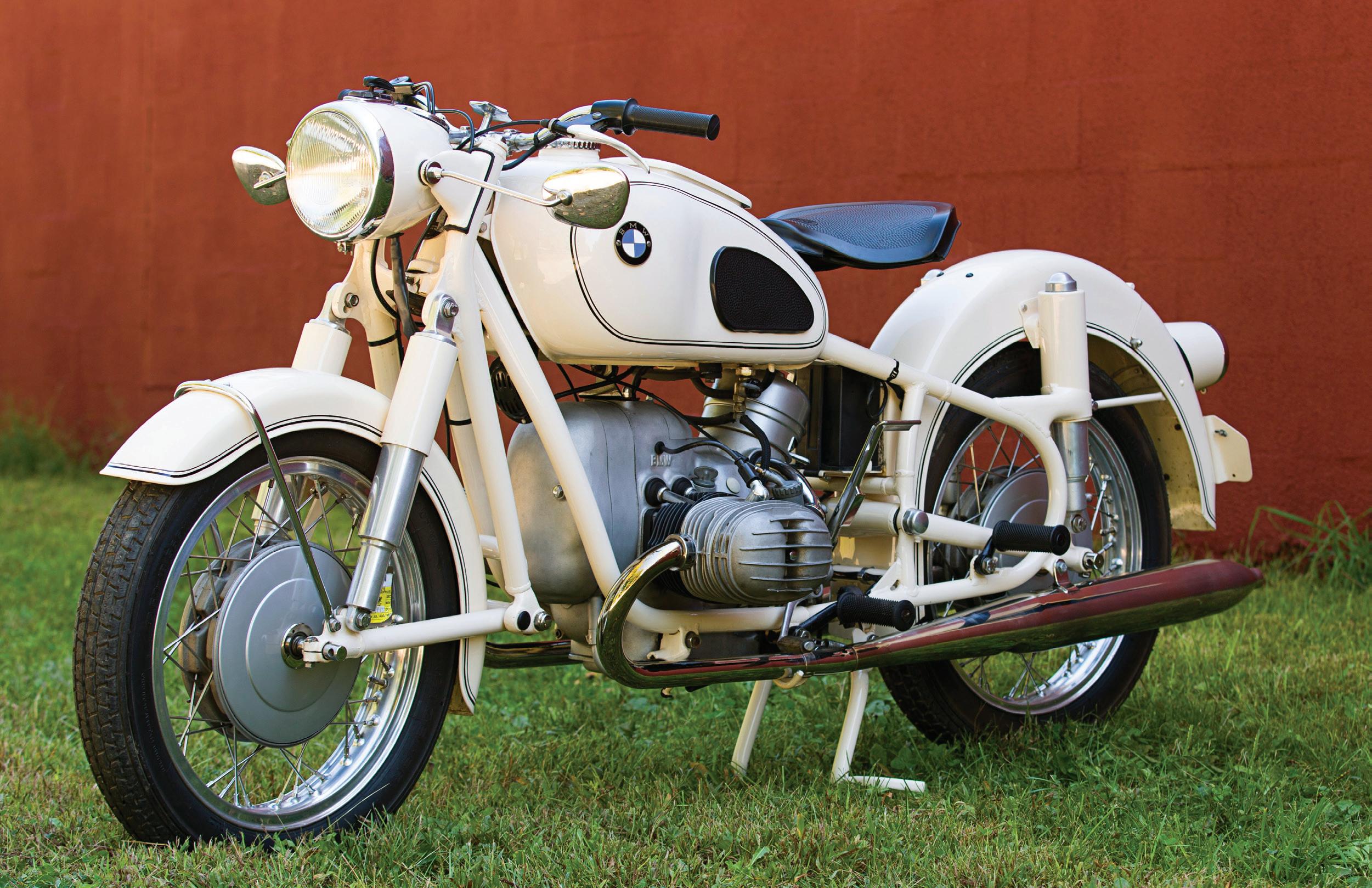
Bill looked after all other aspects of the rebuild, with the exception of spraying the Dover white paint. That paint, Philip says, is “buttery thick with a high gloss; it’s just exquisite.”
Although it seems like most Slash 2 BMWs were painted black with white pinstripes, that wasn’t always the case. According to BMW enthusiast Jeff Dean, who runs the bmwdean.com website, the Dover white color came about thanks to U.S. BMW importer Butler & Smith’s Michael Bondy. Apparently, he sent a can of the white paint that was used on his vintage Packard to BMW, who were able to reproduce the color. With that, Bondy ordered 50 BMWs in Dover white.
Another feature of the Slash 2s that made them a popular sidecar hauler is the Earles front fork. A leading-link design developed by Ernest Earles and patented in 1953, the Earles fork doesn’t dive under braking (actually, the bike tends to lift from the forward weight transfer induced under braking) and is stronger than a conventional telescopic design.
It has dual oil-filled shock absorbers with springs, and the swingarm features two pivot positions for either solo or sidecar riding. A noted feature of the Earles fork is its extreme rigidity.
All Slash 2s featured BMW’s aircooled boxer engine — so called because its horizontally opposed pistons move apart and together at the same time. Legend has it that Adolph Hitler coined the phrase while visiting a BMW engine factory because the
www.MotorcycleClassics.com 33
Owner Philip Richter and his lovely Dover white 1962 BMW R60/2.
moving pistons looked to him like a boxer slapping his gloves together. The boxer engine design has long been appreciated for smooth running thanks to its almost perfect primary engine balance.
According to Jeff Dean’s information, BMW produced just 700 R60/2s in 1962, its first year of manufacture, with a total of 16,870 built over its 1962-1969 lifespan. The R60/2’s engine has a bore of 72mm and stroke of 73mm, giving almost square dimensions and a total of 594cc.
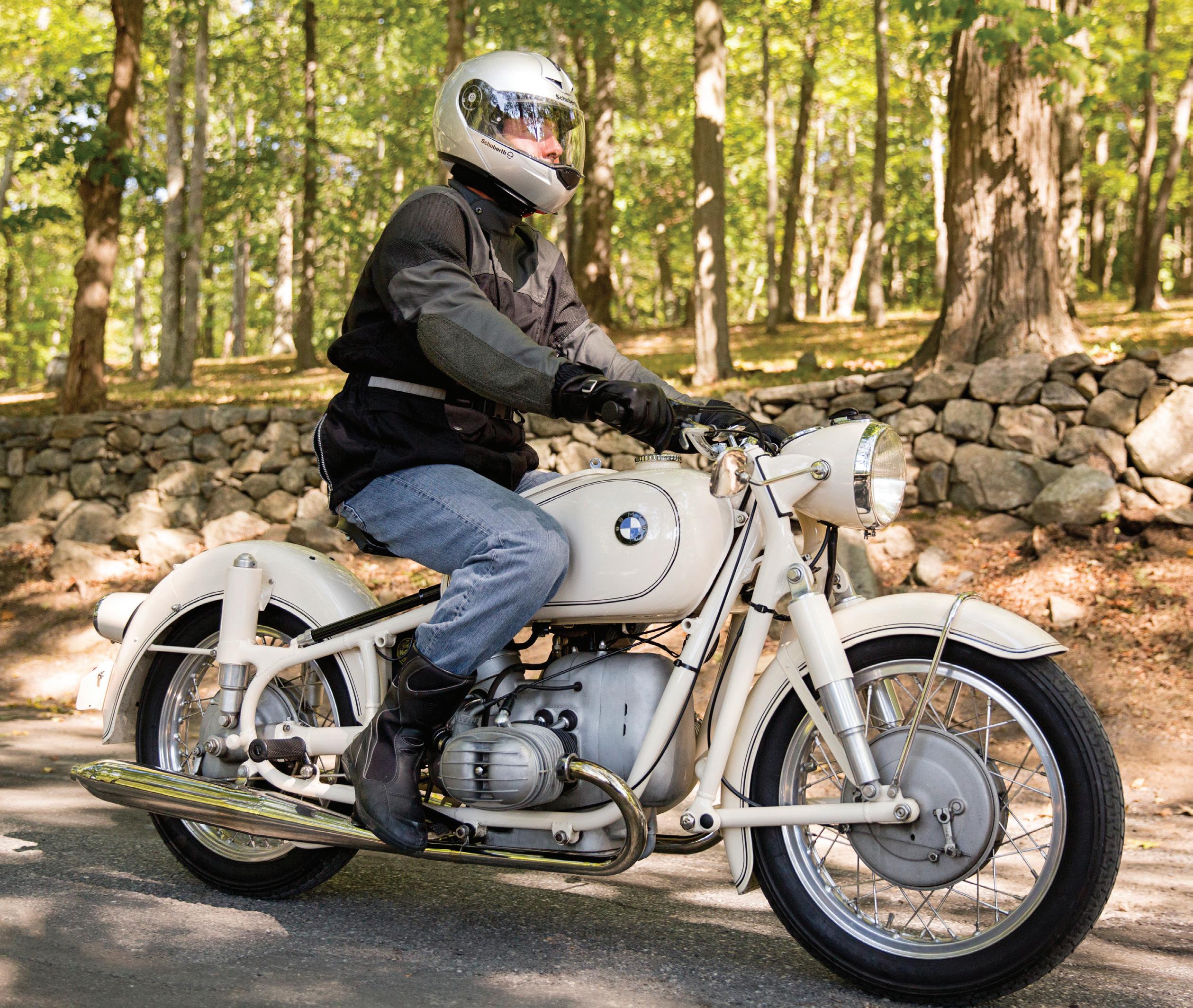
Compression is 7.5:1 and the engine makes 30 horsepower at 5,800rpm. A Bosch magneto provides sparks and is independent of the rest of the electrical system, although it resides under the front engine cover along with the 6-volt Bosch generator. The timing gears and oil pump are also at the front of the one-piece engine case, which features a carlike oil pan at the bottom.
The cylinders are cast iron, topped with aluminum cylinder heads featuring a single intake and exhaust valve each. (As a note of interest, the valve covers on both the R50/2 and R60/2 have six horizontal fins — the higherhorsepower S models have two cooling fins per cover.)
Exposed pushrod tubes run above the cylinders, with rubber seals at the crankcase side and press fit at the top of each cylinder; an oil return passage on the underside of each cylinder lets oil drain back into the crankcase. Carburetors on the R60/2 are a pair of 24mm Bing “Spezials” with integrally cast float chambers. The carbs are flange mounted and set at a 15-degree angle toward the engine.
A single dry-disc clutch connects the engine and 4-speed transmission, while a driveshaft, a BMW hallmark since the R32 of 1923, delivers power to the rear wheel. The enclosed driveshaft runs in oil in the right side of the swingarm. Properly maintained, the engine and drive system are very oil-tight.
The rear shocks are oil-filled and spring loaded and are virtually the same as the front shocks suspending the Earles fork, with the exception of spiral adjusters built into the lower shock housings to alter preload for solo or two-up riding. Up front, brakes are full-width twin-leading-shoe and the rear is a full-width single-leading-shoe. The 2.15 x 18-inch 40-spoke wheels spin on tapered roller bearings, and are interchangeable front to rear.
34 Motorcycle classics Street Bikes of the ’60s
Ready to ride
“Bill finished the restoration of the R60/2 in 1995, and kept it for five years,” Philip says. “He had retired and was moving to Arizona, and I managed to swing a deal for close to $6,500 for the bike.” When Bill restored the BMW he opted to fit deeply flanged alloy rims and the lower Euro-spec handlebar. Slash 2s destined for the U.S. came with a taller, braced handlebar.


For several years after buying the R60/2, Philip rode the bike as much as possible, and would go just about anywhere on it. The odometer currently reads 62,500 miles, but it wasn’t reset during the restoration and Philip’s unsure how many of those miles he’s actually accumulated.
Philip has made a few changes since acquiring the BMW. He added the period accessory Albert mirrors that attach to either side of the headlight, and when the original exhaust system rotted out he upgraded the pipes and mufflers to stainless steel. Philip laments the fact the exhaust is not authentic, but he’s happy he doesn’t have to worry about the system rusting out. Also, Phil Cheney thought the Pagusa rubber solo saddle should be changed to a Denfeld, so Philip made the switch.
In the interest of safety, Philip updates his tires every three years. “I’m in the wealth management business,” he says, “so for me, motorcycling is all about managing risk. When it comes to tires, I don’t cut corners.” He keeps the valves adjusted and the oil changed. “Other than that, the bike just runs. I think I could get on it and ride to San Francisco without it missing a beat.”
So, having said that, what’s it like to ride? After opening the single petcock on the left
side of the gas tank (BMW offered the R60/2 stock with a 4.5-gallon tank, or an optional 6.5-gallon vessel — Philip’s has the larger of the two) and tickling each carb for about three seconds to allow gasoline to raise the floats, Philip says it takes just one very light kick on the left side starter for it to fire up.

“On the road, this bike generates a lot of acceleration and power, and it doesn’t mind being pushed into the higher rev-range,” he says. “I can keep up with all of the modern bikes, but the biggest issue with the older machine is stopping — it just doesn’t stop that quickly. The transmission is silky smooth shifting, and when you’re cruising the whole affair is an effortless flutter amid a symphony of beautiful sounds.” Looking back, perhaps that’s why Steve Jobs included the grand piano beside his Slash 2 in Apple’s lobby. MC
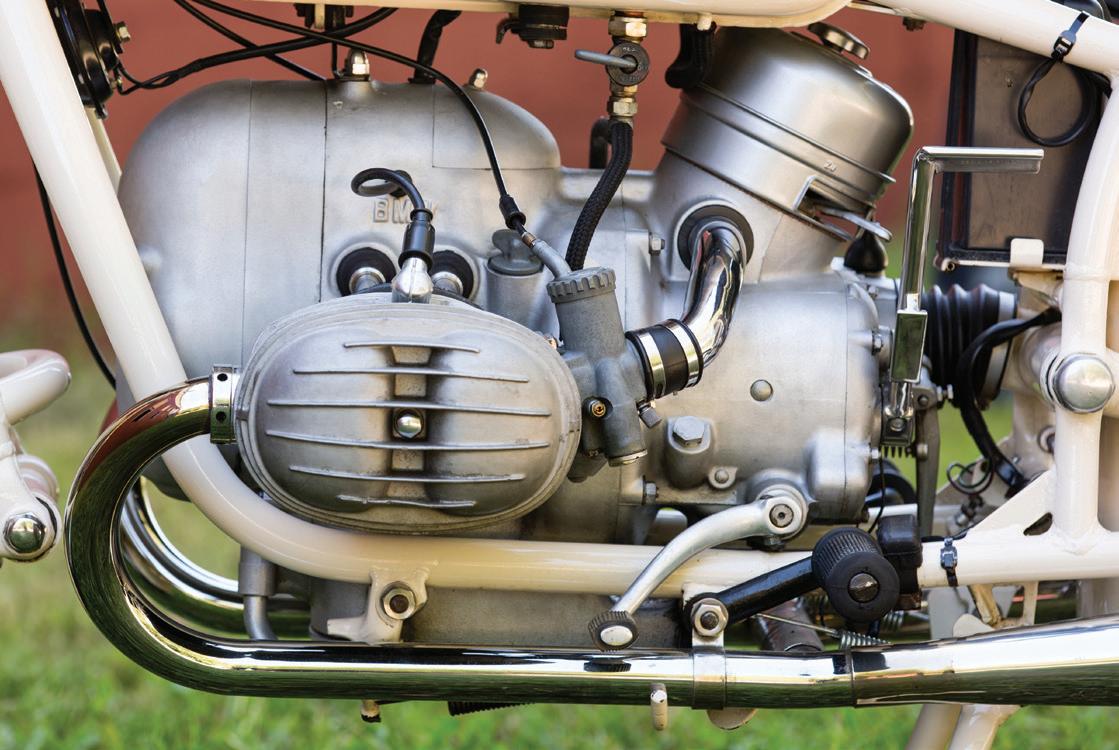
www.MotorcycleClassics.com 35
The 594cc horizontally opposed twin produces 30 horsepower at 5,800rpm. The left-side kickstarter is visible behind the airbox.
Philip’s R60/2 wears the optional 6.5-gallon fuel tank. Turn on the fuel, tickle both carbs, give it a kick and you’re ready to go.
“I think I could get on it and ride to San Francisco without it missing a beat.”
MADE LIKE A GUN

1963 Royal Enfield Interceptor
 Story
Story
WWhen I was in high school 45 years ago, there was an older kid who was unremarkable except that he owned two Royal Enfield Interceptors. That made him cooler than cool, because the merely cool rest of us rode more common British bikes or maybe something Japanese.
Greg Lawless bought this 1963 Interceptor for $500 in May 1973 as a college graduation present for himself. I suspect he experienced an immediate spike in his coolness. Over the last 42 years — including six moves involving three states — Greg’s put lots of miles on it and made many memories with it. Though his current collection includes 26 motorcycles, Greg says the Interceptor is the last bike he’d sell.
A little background
Royal Enfield was founded in the 1890s in Redditch, England, (just south of Birmingham) by two bicycle manufacturers who also made interchangeable gun parts for the Royal Small Arms factory in Enfield. For its logo, the new company chose an artillery field gun.
Royal Enfield’s first motorized bicycle, built in 1901, was followed by models incorporating such innovative features as crankcases with integral oil tanks (1903) and rubber “Cush Hub” drives to reduce chain snatch (1912). Royal Enfields were the first English production motorcycles with dry-sump lubrication systems and gear-type oil pumps (1913). The “Super 5” model, launched in 1961, was the first British production motorcycle with a 5-speed gearbox.
In 1948, the company launched the model that was to become synonymous with Royal Enfield: the redesigned overhead valve single-cylinder Bullet. This robust and versatile machine was utilitarian but also excelled as a competition motorcycle, especially in trials events.
Although Enfield ceased U.K. production of motorcycles in June 1970 to focus on military contracts (Royal Enfield had been making aircraft and guided missile components as well as motorcycles), Enfield Bullets are still being made in India, mak-
ing Royal Enfields the longest continually produced motorcycles in the world.
Though never as large as BSA, Triumph or Norton, Royal Enfield had an advantage: Its small senior management team included enthusiastic motorcyclists and former competitors who knew what riders wanted. They fostered new ideas and encouraged the introduction of models known for innovative design and robust construction.
The Big Twins
Royal Enfield launched its first parallel vertical twin in 1948, with a 64mm by 77mm bore and stroke and 25 horsepower. The basic design of the 500 Twin was to be carried through the subsequent, larger displacement models and included a long stroke for low-end power, a one-piece cast iron crankshaft, and separate cast iron barrels with aluminum heads and short alloy pushrods riding on a pair of camshafts.
Advanced features for the time included a full-flow oil filter
36 MOTORCYCLE CLASSICS Street Bikes of the ’60s
by Corey Levenson
Photos by Jeff Barger
and semi-unit construction, with the gearbox bolted to the rear of the engine. The frame was welded steel with a single downtube attached to the front of the engine-gearbox unit, which acted as a stressed member. The swingarm rear suspension was a first for a parallel twin.
In 1953, the Meteor 700 was introduced as Britain’s biggest parallel twin — BSA and Triumph offered only 650s at the time. The 36 horsepower, 693cc Meteor was primarily intended to meet the needs of the sidecar market. It was essentially a “DoubleBullet,” each cylinder having the same bore (70mm) and stroke (90mm) — and pistons — as the 350cc single.
The Super Meteor followed in 1955 as a more sporting Meteor. Made in response to U.S. market demands for more power, it made 40 horsepower and was the first Royal Enfield capable of 100mph. The 51 horsepower Constellation followed in 1958 with hotter cams, a single 10TT9 Amal carb and siamesed exhaust.
In 1961, the factory made a limited run of Constellationbased specials for the U.S. market, the 700 Interceptor. Set up
for offroad enduro-style events, they weren’t popular and most of the approximately 160 bikes were retrofitted by dealers with aftermarket horns, mirrors and lights and sold for road use.
In late 1962, Royal Enfield bored and stroked the Constellation’s engine to 736cc to launch the 750 Interceptor Mk1. It went head-to-head in the showrooms with the new Norton Atlas 750 and, like the Norton, it was aimed squarely at the U.S. market. Both bikes were offered stateside before they became available in the U.K.
Enfield dynamically balanced its big twin engines, reducing vibration compared to large displacement bikes made by competitors, who used static balancing. The long-stroke design produced abundant torque from low revs, making the bikes very tractable and capable of impressive acceleration. On the downside, the separate barrels and heads meant that the engines — being stressed members — tended to flex, which, combined with poor crankcase venting, led to the bikes having a reputation for leaking oil, hence the nickname “Royal Oilfield.”

www.MotorcycleClassics.com 37
1963 ROYAL ENFIELD MK1 INTERCEPTOR

The Interceptor was upgraded in 1964 with a second petcock, float bowls on both Amal Monoblocs, magnetic instruments, Girling shocks, an auto-advance magneto, hotter “R” (Supersport) cams, and one less tooth on the countershaft sprocket for better acceleration. In the U.S., the 1964 model was known as the TT Interceptor. The single-carb Custom with standard cams was added in 1965, and the 1966 GT with twin carbs and sport cams gave three Mk1 models available that year.







The Interceptor Mk1a was introduced in late 1966. Produced at new facilities at Bradford-on-Avon, it featured twin Amal


concentric carbs, coil ignition and better engine breathing. Two models differing only in cosmetics were offered in the U.S.: the Road Scrambler TT7 (upswept pipes, chrome tank and exposed chrome shock springs) and the Road Racer GP7 (flat pipes, painted tank and shrouded shocks, more like the old Mk1).





Royal Enfield produced its last twin, the Interceptor Mk2 (aka Series 2), from 1968 to 1970. The engine was redesigned to be wet-sump, the contact points were relocated in the timing cover, and Norton front forks and front brake were used. The Mk2 bikes



leaked less oil than the Mk1 versions, but were heavier and slower. The factory had plans for an 800cc Interceptor Mk3 successor, but never put it into production, although prototypes were made and road tested.
The Royal Enfield Interceptor was considered one of the Superbikes of the Sixties. When a Mk1 ran a 13.8-second quartermile, Cycle World editors proclaimed it the quickest stock production bike they had ever tested. In addition, a bike powered by two Royal Enfield Interceptor engines was the first non-streamlined motorcycle to exceed 200mph, hitting 203.16 mph at Bonneville in 1970.
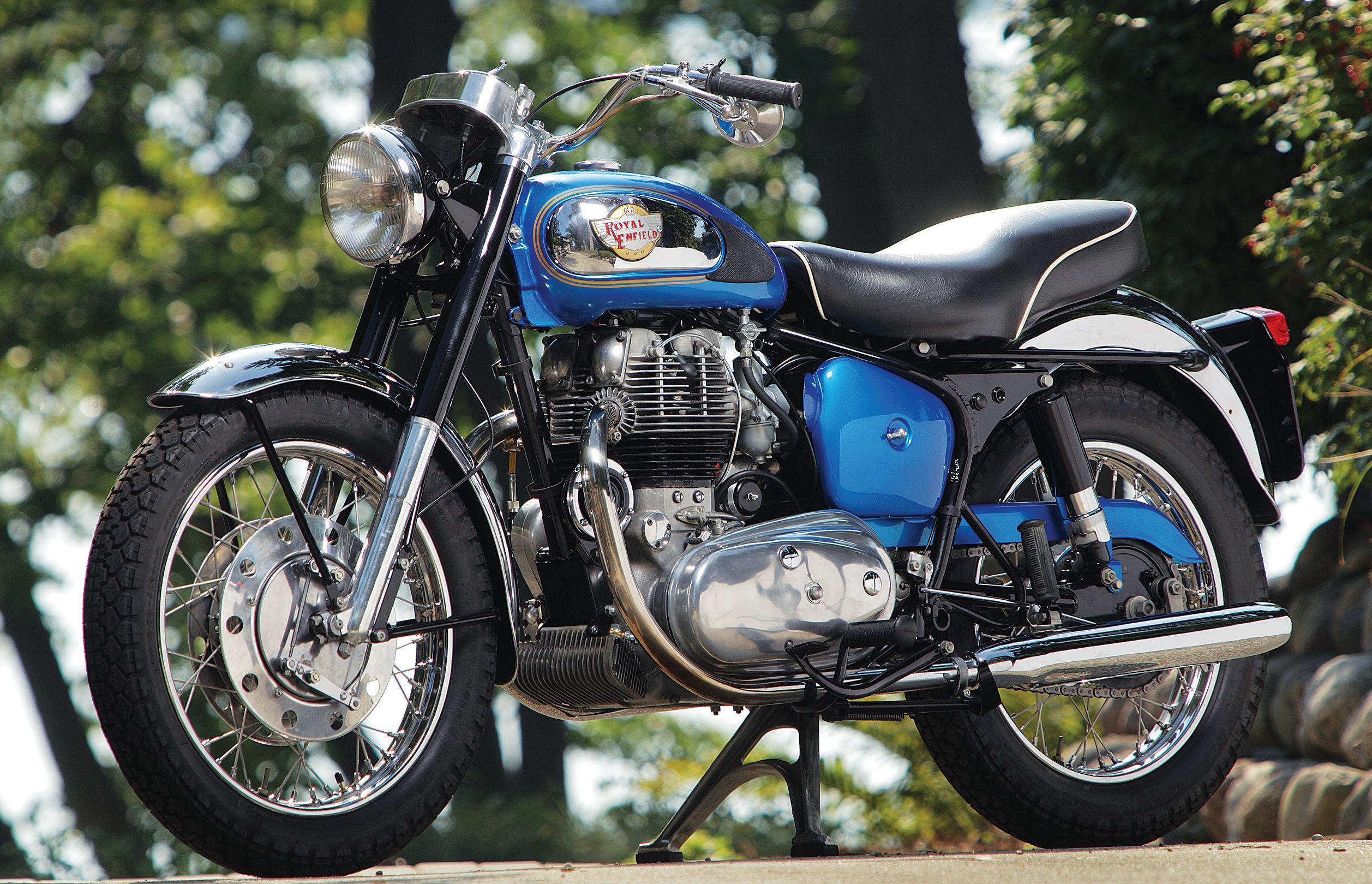
Greg’s Interceptor
Greg Lawless’ 1963 Mk1 Interceptor was one of approximately 250 built that year and one of 979 Mk1s produced between 1962 and 1966. There were two variants of the Mk1 for the U.S. market — Greg’s is the second type with a polished alloy instrument nacelle (not black) and a polished alloy wing knob for the steering damper (rather than a big black round knob). Unlike the U.S. models, the Mk1s sold in the U.K. and the rest of the world had bigger gas tanks, twin-sided 6-inch front brakes and shorter swingarms and wheelbase.
The 1962-1963 Mk1 had twin 1-1/8-inch Amal Monoblocs sharing one float bowl, a Lucas K2F
manual-advance magneto, a 6-volt alternator and a 4-speed Albion gearbox with a neutral finder. The gas tank had a single petcock (there was no reserve), and a Smiths chronometric speedometer and tachometer were standard.
In the 1980s, Greg rebuilt the top end with the help of J.B. “Bernie” Nicholson of Modern Motorcycle Mechanics fame in Saskatchewan, Canada. Oversize Hepolite pistons for 736cc engines were impossible to find, so Bernie provided 0.060-inchoversize 700cc Constellation pistons, which are 0.020-inch oversize for a 736cc engine. Those pistons are still in the bike.

Greg undertook a major restoration of the bike in 2010, the end goal being a practical and rideable classic machine. He replaced the notoriously bad stock 7-inch single-leading-shoe front brake with a twin-leadingshoe unit from a modern Indian Bullet. He says it’s a big improvement, but planning one’s stops is still recommended.
Greg rebuilt the engine, giving it new valves and seats, new piston rings and new bottom-end main bearings and connecting rod bearings. It also got R-type cams, and a 19-tooth countershaft sprocket replaced the stock 20-tooth item. A Bob Newby Racing clutch and belt drive kit took care of clutch problems and primary case oil leaks. The stock Amal Monoblocs were replaced with modern 30mm Amal Premier
www.MotorcycleClassics.com 39
Coolest kid on the block: Greg Lawless and his Interceptor.
Concentrics, and a modern BTH magneto replaced the Lucas K2F unit. This fixed an old problem of having up to 10 degrees of ignition timing variation between cylinders while also providing an improved spark advance curve. Electrics went from 6-volt positive ground to 12-volt negative ground, and with a Sparx single-phase alternator and solid-state rectifier/regulator/capacitor it can run without a battery.
Greg installed a Mk2 Interceptor-type oil cooler and carried out a few other modifications to improve engine lubrication. To address the lack of engine rigidity due to the engine’s separate cylinder barrels and heads, Greg fabricated a stainless-steel head-steady plate that significantly reduces engine flex and in the process improves oil-tightness.
Originally Chinese Red, Greg repainted the bike in HiFi Blue (a stock color for 1964) — a three-stage application with silver base, blue midcoat, hand-painted gold pinstripes on the tank, and a clear topcoat over stripes and decal. Finally, the frame, swingarm, headlight housing, fork covers, taillight housing, and miscellaneous black items were powder coated.
Balance factor




It’s easy for Greg to compare his Interceptor to other vertical twins — his current stable includes a 1961 Norton Manxman, a 1962/70 Greeves Triumph 500, a 1968 BSA Firebird Scrambler, a 1975/72 Rickman Triumph CR650 and a 1974 Norton 850 Commando Interstate.
Greg says the Interceptor’s engine is wonderfully balanced, and even with the heavier oversize pistons, he says it is the smoothest 360-degree vertical twin without a balance shaft that he has ridden. It has gobs of torque and pulls stronger at low rpm than any vertical twin he has ridden except his Norton Commando.
One advantage of the engine’s separate barrels and heads is cooler running and easier access for maintenance and, because the gearbox bolts directly to the back of the engine, variation in
primary chain tension is minimized. The integral oil tank means fewer external oil lines (and fewer leaks), and the engine design allows for swapping cams without disassembling the crankcase.

The neutral finder lever on the gearbox is also a nice feature. The transmission can be a little agricultural in its shifting, and the stock clutch tends to drag, so it’s nice to be able to heel-tap the neutral finder when coming to a stop in any gear (except first) to find neutral.
On the road
Greg says the bike is nimble, yet also stable at high speed thanks to the longer U.S.-spec swingarm. “It’s the first bike I went over 100mph on,” Greg says, “in fact 110mph two-up in 1973. Only scared my rider — well, me a little.”
Maintenance is relatively easy. One bolt retains the outer primary cover and there’s good access to the spark plugs, rocker arms and magneto points. The oil drain plug is on the side of the engine case and the somewhat effective felt oil filter is easy to clean.
Support groups include a Royal Enfield Owners Club (royal enfield.org.uk) and a website specifically about Interceptors (oze mate.com/interceptor). Two excellent long-standing sources of parts and advice are Hitchcocks Motorcycles (hitchcocksmotor cycles.com) and Burton Bike Bits (burtonbikebits.net). Allan Hitchcock, in particular, has a reputation for being a tireless champion of the marque — not only keeping new-old-stock and pattern parts but also fabricating special bits and engineering new, improved solutions to old Enfield shortcomings.
Greg and his Interceptor are now in their fifth decade together, longer than many marriages last. Indeed, elevating the bike to its current lovely condition has been a labor of love. It has paid off though — the Enfield looks stunning and runs strong. Exactly what you’d expect from a marque whose motto was: “Made Like a Gun.” Pretty cool, huh? MC
The final chapter: The Rickman Interceptor
The final chapter of the Interceptor story includes two specials not built by Royal Enfield, but based on the Mk2. In 1968, Floyd Clymer, Royal Enfield’s Western U.S. distributor, made plans to market a line of motorcycles in the U.S. under the Indian name. He intended to put Mk2 Interceptor engines into a chassis built by Leo Tartarini of Italjet in Bologna, Italy. The first few Indian

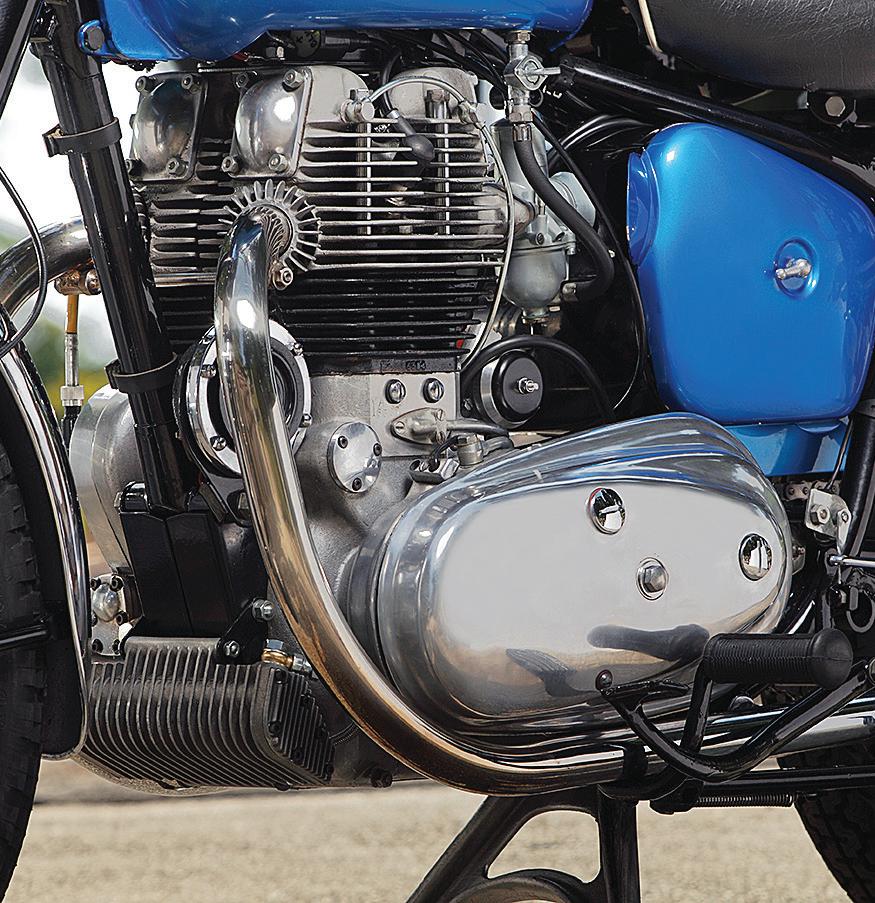
Enfields were launched in 1969, but Clymer passed away in January 1970 and the project floundered. The unused Interceptor engines ended up in a warehouse, needing a new home. Enter the Rickman brothers, renowned for their exceptionally well-made frames.
Don and Derek Rickman’s Interceptor-powered special weighed 60 pounds less than a standard Mk2
and featured their fabled nickel-plated chrome-moly duplex “Metisse” frame with swingarm pivot chain adjustment, Ceriani forks, Lockheed disk brakes front and rear, and a fiberglass tank, seat and fenders. Between April 1970 and January 1972, approximately 130137 Rickman Enfields were produced, making them rare and highly soughtafter today. — Corey Levenson
40 MOTORCYCLE CLASSICS Street Bikes of the ’60s
The short lever on the gearbox is the neutral finder, a handy feature at stop lights (center).























































































































www.Spectro-Oils.com | 800-243-8645 @SpectroOils #SpectroOils #TheBestOilOnPlanetEarth ENTER TO WIN Visit www.Spectro-Oils.com/MC66 YOUR ONE STOP SHOP – EVERY FLUID FOR EVERY BIKE ENGINE OIL FORK OIL FUEL ADDITIVES CHAIN CARE FILTER CARE APPEARANCE PRODUCTS GEAR OIL BRAKE FLUID
MELLOW YELLOW
1961 Harley-Davidson FLH Panhead
Story by Margie Siegal
 Photos by Sedrick Mitchell
Photos by Sedrick Mitchell
11961 was the heyday of the drive-in, the diner and big cars with fins. Popular culture was definitely American-centric. Across the country, jukeboxes everywhere were Tossin’ and Turnin’ with Bobby Lewis, Falling to Pieces with Patsy Cline, and looking for that Runaway with Del Shannon. The Beatles, the British Invasion, unrest on college campuses and the anti-war movement were still in the future. In 1961, optimism was the order of the day, and America was the place to be.
U.S. motorcycle enthusiasts of the day were a small, hardy lot, buying about 60,000 motorcycles a year. Honda had appeared on American shores in 1959, and by 1961 had gained a small but significant share of the market. “The Nicest People” ad campaign was still two years in the future, and despite efforts by the AMA and the British importers to improve the image of motorcyclists, much of the U.S. public saw motorcyclists as suspect people with grease under their fingernails. There was some truth to this observation — if you owned a motorcycle in 1961, you probably worked on it.
Choices, choices



























Besides the small Honda motorcycles that were beginning to appear in high school parking lots, American riders of 1961 could choose between BMW flat twins from Germany; Matchless, BSA, Norton, Royal Enfield, Velocette and Triumph motorcycles from England; and Ducati singles from Italy, to name just a few. The sole American motorcycle company (ignoring pint-size builders Mustang and Cushman), Harley-Davidson, sold 10,467 motorcycles that year. Harley had pretty much sewn up the police bike market, which was not an unmitigated blessing as the big, heavy patrol vehicles favored by police departments weren’t necessarily what the rest of the buying public wanted. A lot of the 60,000 motorcycles sold in 1961 were light and sporty imports.

buying public wanted. A lot of the 60,000 motorcycles sold in

That isn’t to say Harley-Davidson wasn’t trying to make bikes the general public would want, and H-D’s lineup for 1961 was extensive. Harley had purchased an interest in Italian

bikes the general public would want, and H-D’s lineup for 1961

42 MOTORCYCLE CLASSICS Street Bikes of the ’60s

www.MotorcycleClassics.com 43
1961 HARLEY-DAVIDSON FLH

The hard saddlebags are reproductions of the originals, but the blue windshield is a period option from 1961.
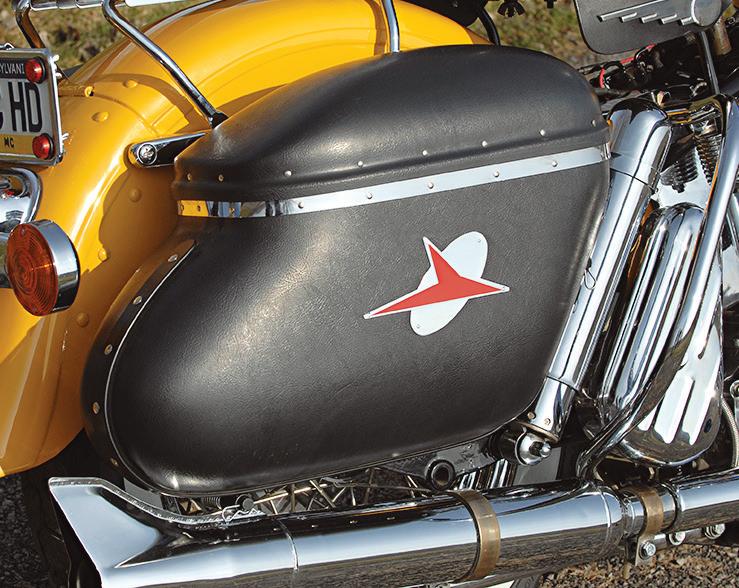
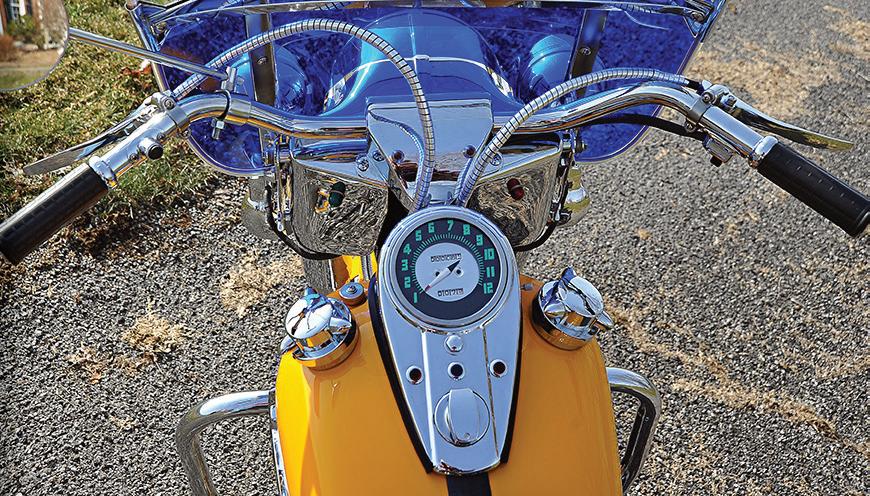
manufacturer Aermacchi the year before, and the first Sprints, stylish and sporty 250cc singles, were now appearing in dealers’ showrooms. Other offerings included Super 10 165cc 2-stroke single lightweights, Topper scooters, and Sportsters.
The 1961 FLH, however, was like nothing else on the market. It weighed 648 pounds dry, with a 60-inch wheelbase. The 60 horsepower engine would pull that massive chassis to almost 100mph. For comparison, the contemporary and faster Triumph Bonneville T120 weighed 404 pounds dry, had a 56.5-inch wheelbase and made 46 horsepower at 6,500rpm. Yet the FLH was apparently what police departments wanted, so that was what Harley built.
Power was from a 45-degree, 1,208cc overhead valve V-twin with a single-throw crank assembly. Ignition was battery and coil through a distributor, with electrics powered by a generator.
The large Buddy seat was a popular option for Harley’s big road bikes. This one is an original period accessory.

The rockers were covered with baking pan-shaped covers, leading to the nickname Panhead.





Riding and wrenching
In addition to police departments, the target market for the first Panheads included demobilized GIs happy to be home from World War II. Harley sold almost 13,000 Panheads in 1948, the first year of production. The 1948 version was considerably lighter than later Pans — 565 pounds dry for the 74-cubic-inch version. Early Pans could also be bought with a 61-cubic-inch engine, and all of the early Panheads had rigid rear ends.
Many veterans had learned mechanical and welding skills in the military, and they put their knowledge to work improving their rides. The most foolproof way to improve lap times was to reduce weight. Extra chrome was removed, fenders were sawed off, and









“There were never a lot of Panheads built, and the number that have survived in stock condition is small.”
stock mufflers were replaced by straight pipes to create what were called “cut-downs,” “California bobbers” and “choppers.”




















Meanwhile, the company engineers were improving the product. Telescopic forks replaced the springers in 1949, foot shift became available in 1952, and the smaller engine was dropped. In 1953, the hydraulic valve lifters that were a Panhead feature from the beginning were moved from the top end to the timing case, and a more powerful version of the Panhead engine became available in 1955. This engine, coded FLH, had a stronger bottom end running on Timken tapered roller bearings to support higher compression. In 1956, Harley introduced the hotter “Victory” camshaft and even higher compression pistons.
This deliberate rate of innovation was in part due to shrinking sales. As GIs settled down and started raising families, their motorcycles got traded in for Buicks and washing machines.
Harley finally came out with a swingarm frame in 1958. Although Milwaukee had been building middleweights with rear suspension since 1952, the Panhead had been soldiering on with a hardtail frame. This frame was not as uncomfortable as it sounds, since the seat was supported by a sprung, damped seat post, which took a lot of the bumps out of the road. By the early Fifties, however, engineering developments had proven the superiority of sprung frames, and by 1957, the Harley Big Twin was the only street motorcycle on the market with a rigid rear.
The 1958 Duo-Glide swingarm frame had the silhouette most people identify as Harley, with beefy dual shocks, big fenders and fat tires. 1958 was also the first year for hydraulic rear brakes and the white wall tire option. Few upgrades appeared for some time after that: Harley simply didn’t have the money to develop the product. The 1959 Big Twin had a neutral light, while 1960 saw an updated rear brake drum and aluminum pushrod covers.
The 1961 Harley FLH had a new generator, new coils and a dual point circuit breaker. It cost $1,400 and came in two standard and four optional colors — not including yellow. Die-hards and sidecar enthusiasts could get a Duo-Glide with a hand shift.
Fewer than 5,000 Big Twins were built that year, out of the 10,497 total Harleys sold, and dealers had to figure out ways to wring what money they could out of each sale in order to keep the doors open. One way to tack on a little extra profit was to sell accessories.
Chrome was in. Milwaukee, taking its cues from Detroit styling, started by ornamenting the stock bike with a chrome headlight nacelle, beefy chrome forks, and a big round chrome air cleaner cover. All 1961 Panheads came with one of nine extra-charge “equipment groups.” A touring owner might order the King of the Highway group, which included a Super Deluxe Buddy seat (choice of black and white or red and white upholstery), black or white plastic saddlebags, directional signals, chrome front and rear bumpers, a chrome front hubcap and dual mufflers with a crossover.
Harley also offered a full page of supplemental equipment, from practical additions such as an oil filter and a center stand to ornamental offerings like chrome handlebar clamp covers. Some of Harley’s 1961 offerings even seem slightly bizarre today. Few of us ride through Midwestern winters, but the 1961 motorcycle rider was a hardy breed, so Harley offered a winter windshield kit: leg shields and a lap cover for bikers who intended to venture out in February. Just about everyone smoked in 1961, so Harley listed a cigarette lighter, too.
There was also a full line of police accessories. One item that was much in demand was a hand control “tell tale” speedometer. In the days before radar, the highway patrol officer would match speed with the vehicle he wanted to pull over, hit the button on the speedometer, and activate the siren. The red hand on the speedo would stay where it was when the button was pressed, providing court evidence that Big Al was doing 85 in his chopped and channeled Ford.
The Panhead got an electric start in 1965, and a whole new top end in 1966, and sales took off almost immediately. The nickname for the new iteration was Shovelhead. The first Shovels

www.MotorcycleClassics.com 45
were mostly a development of the Pan, with rocker boxes instead of rocker covers, but as time went on, they began to look more like today’s Harley, with an alternator instead of a generator.
Coming back
Some of the riders who had been stripping down bikes into bobbers began to experiment with fat rear tires, peanut tanks and extended forks. In the mid-Sixties, Panheads were just old used bikes, so no one cared about someone re-welding frame necks, cutting off extra frame tangs and mounts, or cutting up fenders.
Problem is, there were never a lot of Panheads built, and the number that have survived the Sixties and Seventies in stock — or even restorable — condition is much smaller. About 20 years ago, a small group of enthusiasts decided they really liked old stock Harleys, and started restoring and collecting them. Up to that point, vintage enthusiasts had mostly concentrated on Indians, Excelsiors and Hendersons. The idea that Harleys could be collectible gained traction, and increasing numbers of Harley people joined the vintage movement. Mark McClymonds, the owner of our feature bike, is a new convert to the old bike cause.
Mark was a dirt bike racer as a kid. Like a lot of folks, he got out of bikes for a while, then started getting interested again. He bought a Fat Boy, then another Harley. Eventually, Mark decided he wanted to own a classic. “I was watching bikes on eBay, and saw one I liked,” Mark remembers. “I put a bid on it, and went on a trip with my wife. I came back, and the computer said, ‘Congratulations! You won!’ Boy, was I surprised.”
Mark took delivery of his Panhead and went over it. “It was rough, with pieces missing on the engine, but all the bodywork was there. A neighbor and I did the restoration. We took the cases apart and went through the engine. The local machine shop does a lot of Pans, and they helped us.” Mark and his friend replaced all the bearings, honed the cylinders, and rebuilt the carburetor. Mark bought new pistons from Harley and replaced the valves.
He also went through the 4-speed transmission, but it didn’t need much.
The real fun started when most of the bike was together and Mark was able to pick and choose accessories. “What we could, we got from Harley. J&P Cycles (jpcycles.com) supplied the rest of the stuff. The hubcap was on the bike, and I had it re-chromed. The Buddy seat was also on the bike, and I had it recovered. The bags on the bike weren’t the originals, but I found these reproductions of the correct bags,” Mark says.
Other period accessories on this bike are the windshield (available in three different colors in 1961 — this is the blue version), the spotlights, the turn signals (an option since 1958) and the chrome luggage carrier. So why did Mark paint his otherwise period-correct bike a non-period yellow? “I’m partial to that color of yellow. I have a Road King that color,” Mark says matter-of-factly.
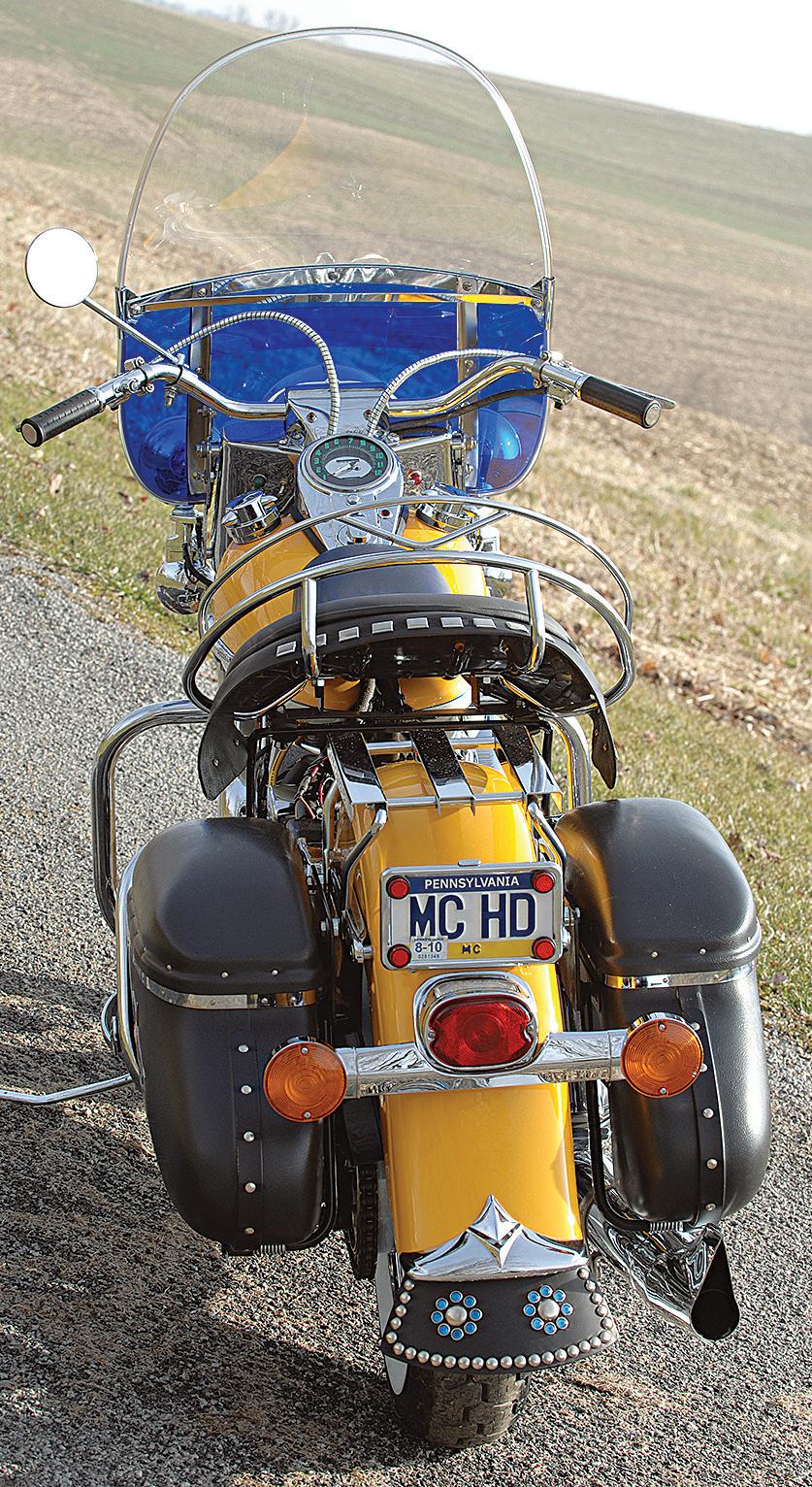
Except for the ’65 model, you have to kick start most Panheads, and successfully kick starting this Duo-Glide takes careful adherence to procedure. “With the key off and the choke and throttle open, kick three times,” Mark explains. “Turn the key on, give it half choke and work the kick lever so that you are on compression. You want it to spark right away. Then kick.” The engine is loosening up with use, and Mark is getting the process down. And he says it’s gradually getting easier to start.
Once started, however, Mark says his Pan idles well, doesn’t take too long to warm up, and runs smoothly. “It’s comfortable, and seems like it’s well balanced. It has a good riding position. It feels lighter than a modern Harley. I shift when the rpms go up — there’s no tach. A good cruising speed is 55-60mph.”
Despite his surprise learning he was the proud owner of a Panhead, Mark is happy he won that eBay auction. “It rides good and motors good. I like joyriding it around locally with friends. I primarily ride secondary roads, anyway. It has enough power and just goes down the road really nicely.” Which is exactly what most of us are looking for in the first place. MC
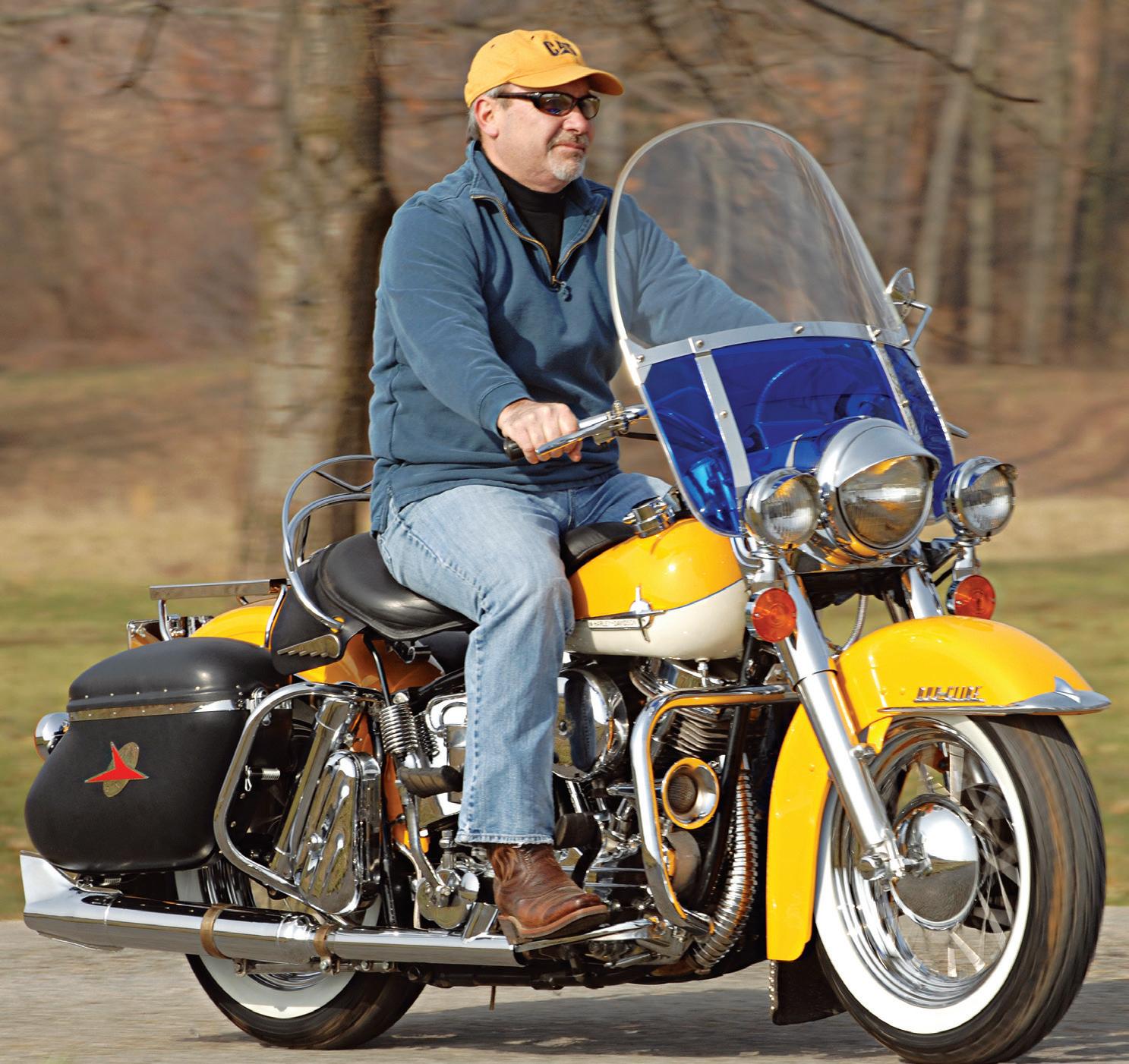
46 Motorcycle classics Street Bikes of the ’60s
Owner Mark McClymonds enjoys cruising secondary roads on his FLH, which has a Buddy seat and other period accessories.






























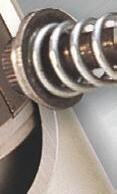

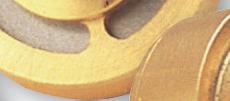


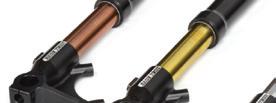

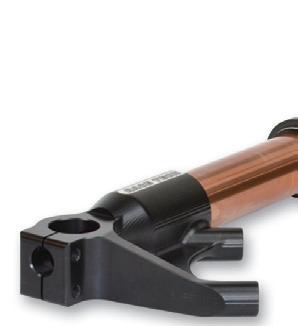











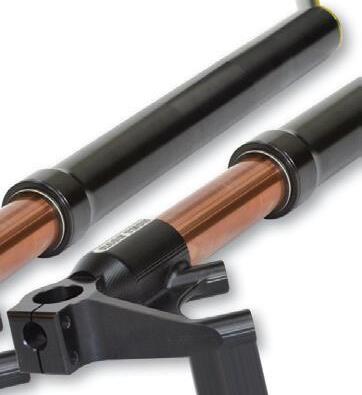









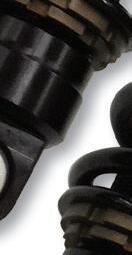
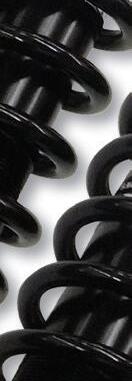






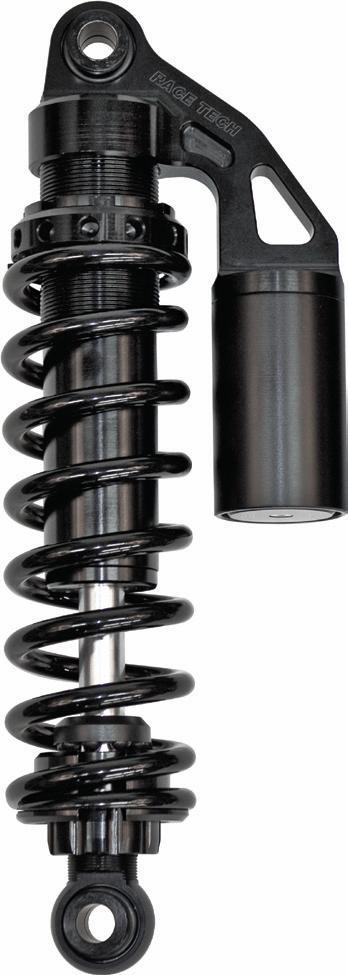


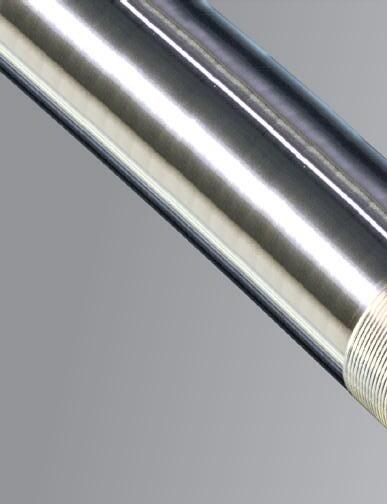
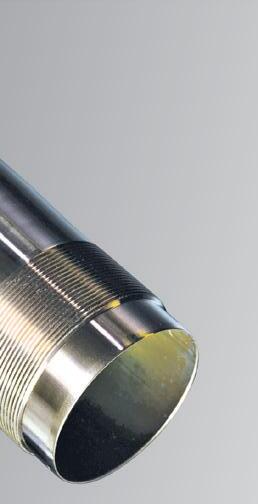













racetech.com VINTAGE SUSPENSION Fork Gold Valve Emulators® RT Hi-Performance Fork & Shock Springs G6 Custom Forks G3-S Custom Series Shocks MODERN SUSPENSION FOR YOUR CLASSIC MOTORCYCLE • Custom Built to Order • Made to Any Length • Choice of Features • Spring Color Options Visit Race Tech in the Paddock at Barber Vintage Festival 2016 | Race Tech Seminar at Motorcycle Classics Magazine Tent Saturday at Barber Vintage Springs available in a variety of Spring Rates. Gold Valve Cartridge Emulators offer Adjustable Damping! All G6 Custom Forks are built to order. Specifically to the individual rider’s size, type of riding and ability. Made in Italy. Call or go to the website for your application. Greatly Improves Drum Brake Stopping Power! For Most Forks and Shocks TNK Fork Tubes Brake Arcing Shop Services Made in U.S.A. VINTAGE, CAFE, STREET TRACKER, MODERN 951.279.6655
THE BLACK BOMBER




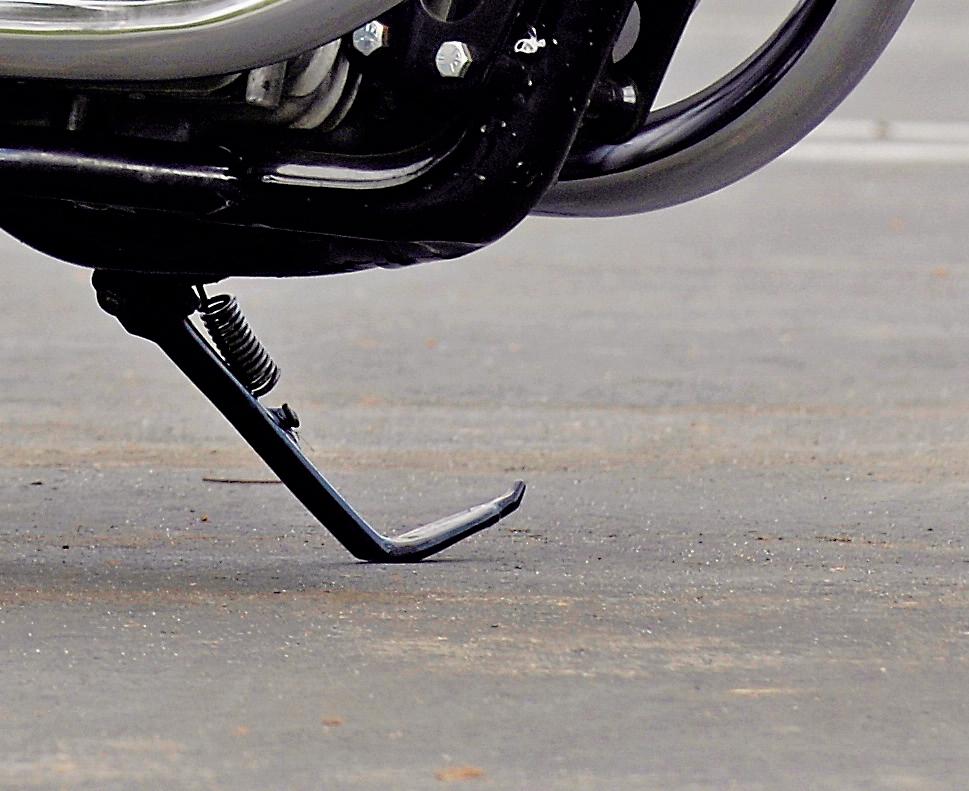




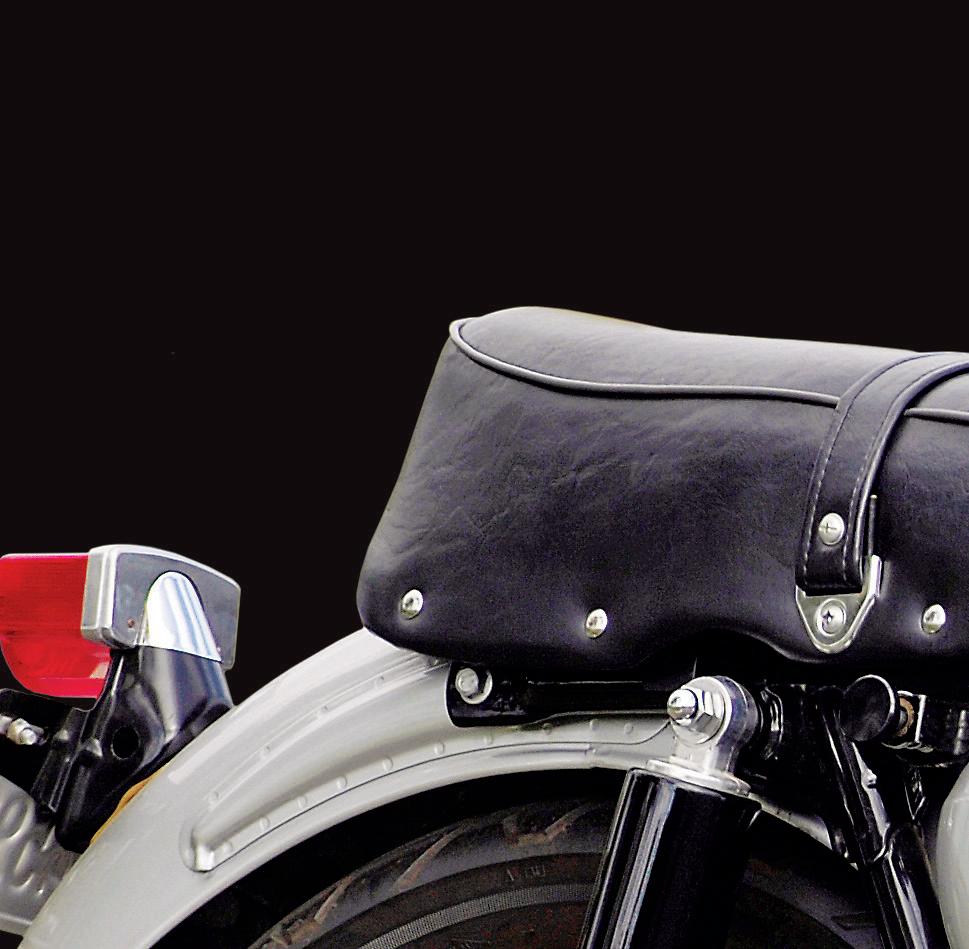
 Story by Greg Williams
Photos by Jeff Barger
Story by Greg Williams
Photos by Jeff Barger
A“All warfare is based on deception. Therefore, when capable, feign incapacity; when active, inactivity. Pretend inferiority and encourage his arrogance.”

— Sun Tzu, “The Art of War”
Widely recognized as one of the most important motorcycles ever launched by Honda, the CB450 is celebrated as Honda’s first “big twin” and as the first volume production double overhead cam. Lauded and hyped by motorcycle and car magazines as one of the most remarkable machines ever, it was in fact a slow seller, never quite lighting the market on fire as Honda might have hoped. To understand the impact the CB450 had, it’s important to understand the U.S. market of the early 1960s and what led Honda to introduce the 450.
In the beginning …
Honda started exporting motorcycles to the United States in 1959. At the time, Honda was the largest motorcycle manufacturer in the world, selling 500,000 small motorcycles a year, mostly to Asian countries. Honda wanted to sell even more motorcycles, and astutely recognized that the U.S. market, where motorcycle registrations totaled a modest 500,000 or so, had great untapped potential.
Americans were buying some 60,000 motorcycles a year, about 12,000 of which were Harley-Davidsons. A large percentage of the rest came from England. Harley-Davidson was running on a tight budget and had little money for advertising, and the British companies were basically content with the market as it was; efforts to increase the numbers of riders were hamstrung by the refusal of English management to spend money on improving the product or on aggressive sales efforts.
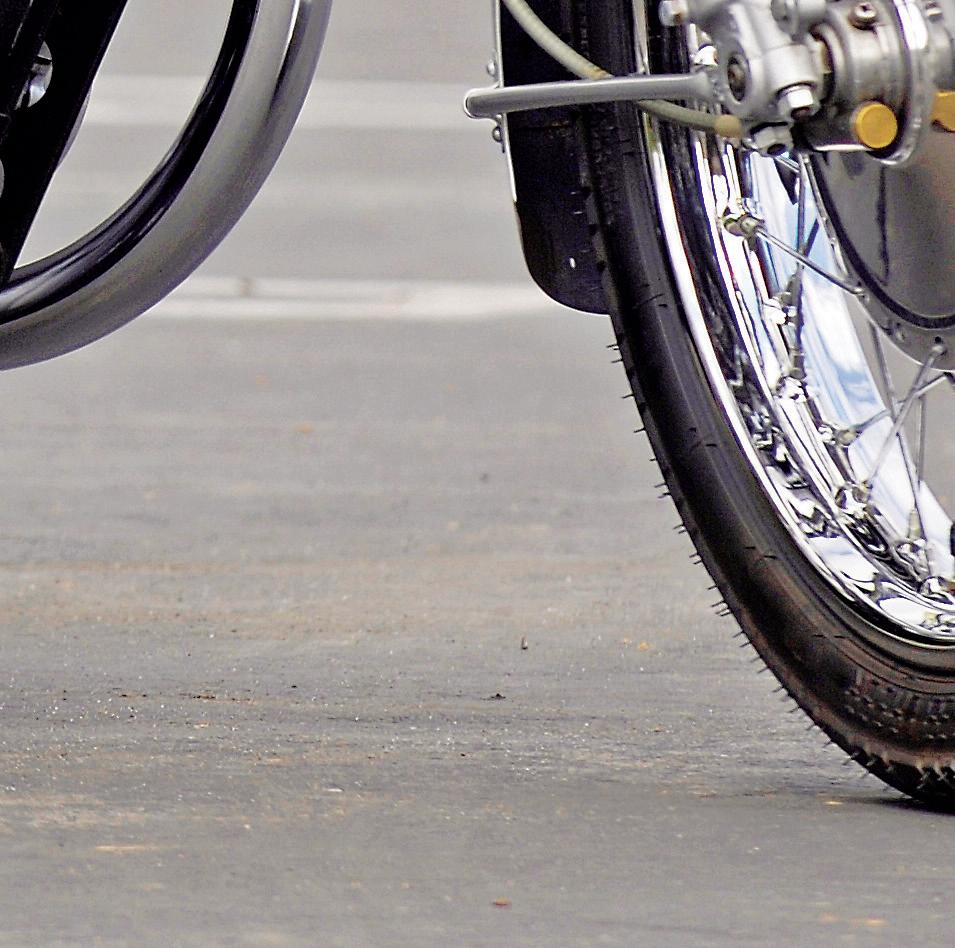
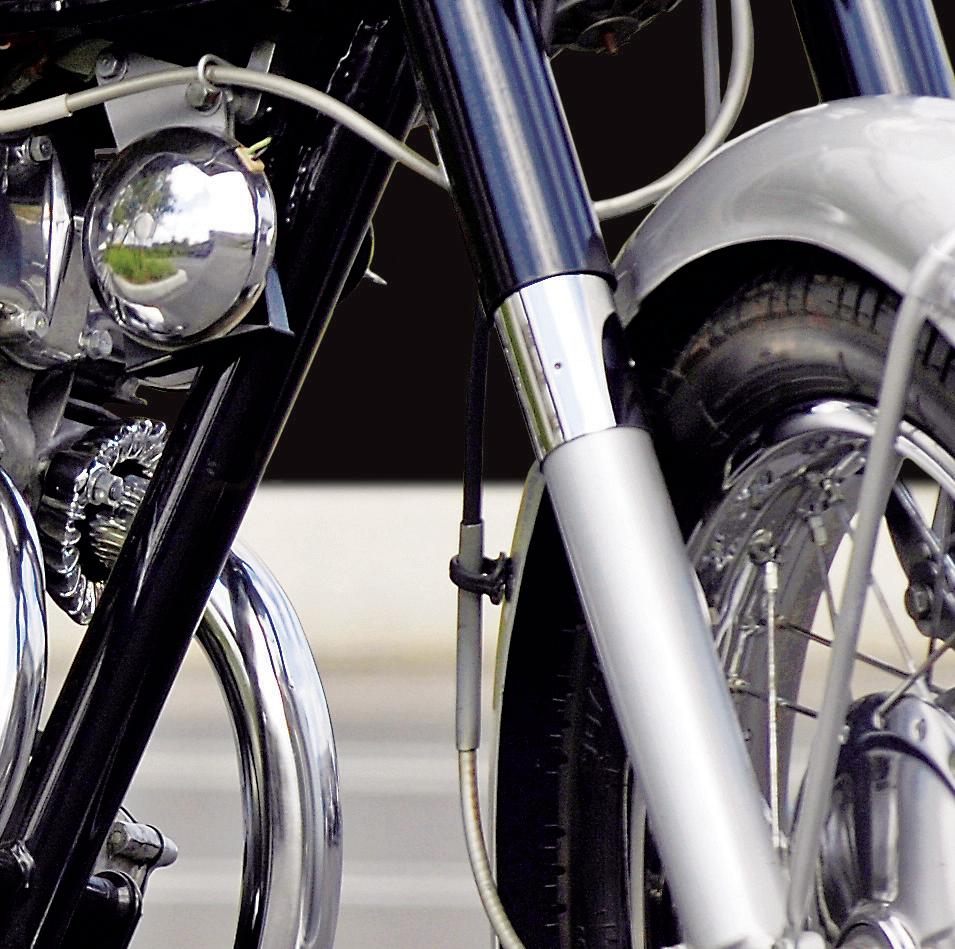

By contrast, Honda was designing bikes to meet the specific needs of the American market. Teenage baby boomers were interested in speed and offroad competition, and so the 1961 product lineup featured the 305cc Super Hawk, a peppy little overhead cam twin, and the CL72 Scrambler, a 250cc overhead cam twin with a smaller tank and high pipes.
American Honda embarked on a marketing effort that, like a successful military campaign, was well funded and carefully thought out. Targeting non-riders, Honda placed ads in general interest publications marketing its bikes as a means of fun, carefree recreation. Honda was introducing motorcycles to a new leisure market, and great effort was made to promote a squeaky clean image through its “You Meet the Nicest People on a Honda” campaign. It worked. In 1962, only three years after renting a storefront on West Pico Boulevard in Los Angeles, U.S. Honda motorcycle sales were up to 65,000 units. A year later, sales reached 150,000. By itself, Honda had more than doubled total U.S. motorcycle sales.
The market grows



Paradoxically, Honda’s effective advertising expanded the market for all motorcycle manufacturers. Harley’s sales went from just over 10,000 in 1963 to over 25,000 in 1965. In New Jersey, Berliner imported increasing numbers of BMWs and Ducati singles, and the British importers found themselves selling as many bikes as the home factory could pump out.
At first, British motorcycle companies did not see Honda as a direct threat. Triumph’s Edward Turner had convinced

Two cylinders, twin cams and loaded with technology, the CB450 put the world on notice: Honda was at war, and planned to win
www.MotorcycleClassics.com 49
himself the Japanese were a long way from building the large sporting twins that were the backbone of British sales in the U.S., and he convinced his American distributors he was right. Heeding the words of Sun Tzu, Honda was careful to do nothing to alarm its competitors, while building up its retail base in the United States.
In 1964, a visiting journalist discovered Honda testing a 450cc twin at its factory track at Suzuka, Japan. The discovery shocked the British manufacturers, the standard-bearers of the traditional vertical twin. On sale a year later in both Europe and the United States, the new twin demonstrated Honda’s technical capacity. Honda had invested heavily in a state of the art foundry and the best tooling obtainable, and as a result could economically build designs that were out of reach for manufacturers with more antiquated equipment.
Full attack
Nicknamed the Black Bomber (like the Model T, the CB450 was available in any color you liked — as long as it was black) the new CB450K0 twin had double-overhead

camshafts at a time when the only motorcycles so equipped were purpose-built racers. In fact, the Bomber was disqualified from some production races in England on the grounds that it was too much like a factory racer.
The 444cc twin was a running portfolio of Honda’s emerging capacity. Four caged roller bearings supported the crankshaft, and primary drive was by spur gears. The valves were seated by torsion bar valve springs — short lengths of steel splined into tubular guides. Tight valve clearances and effective mufflers aided quiet running. The 450 also boasted a pair of 36mm constant velocity carburetors, a first on a production motorcycle.
Honda claimed the short stroke engine would develop 43 horsepower at the crankshaft and could reach 112mph. Cycle World recorded a top speed of 102mph in its August 1965 review. In contrast with most other bikes of the time, which pulled
The red taillight was about the only spot of color on early CB450s, which came only in black with silver.
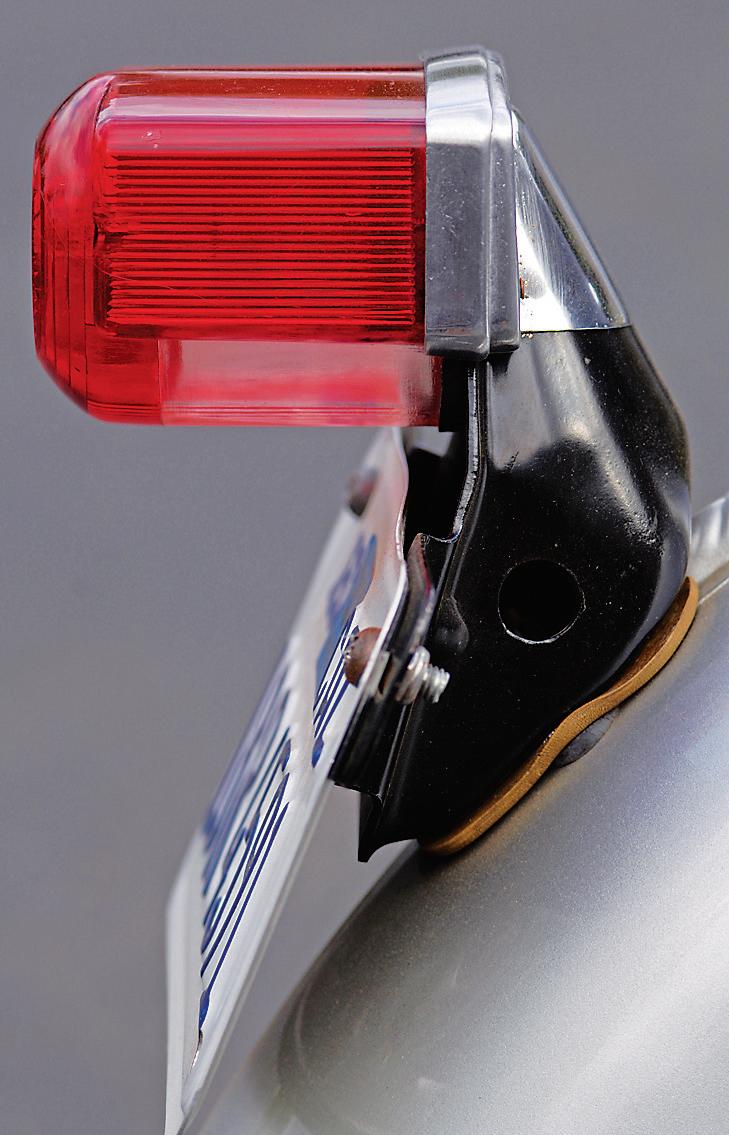
50 Motorcycle classics Street Bikes of the
’60s
“It has guts — I like the twin cam. The sound is spirited, and I like just listening to the Bomber idle.”
strongest at lower rpms, Honda’s 450 produced its best power over 6,000rpm. Reliability was excellent, provided you remembered to warm up the engine and changed the oil regularly — the service manual suggested 1,500-mile intervals. The horizontally split cases didn’t leak, and the electric starter always worked, hot or cold.
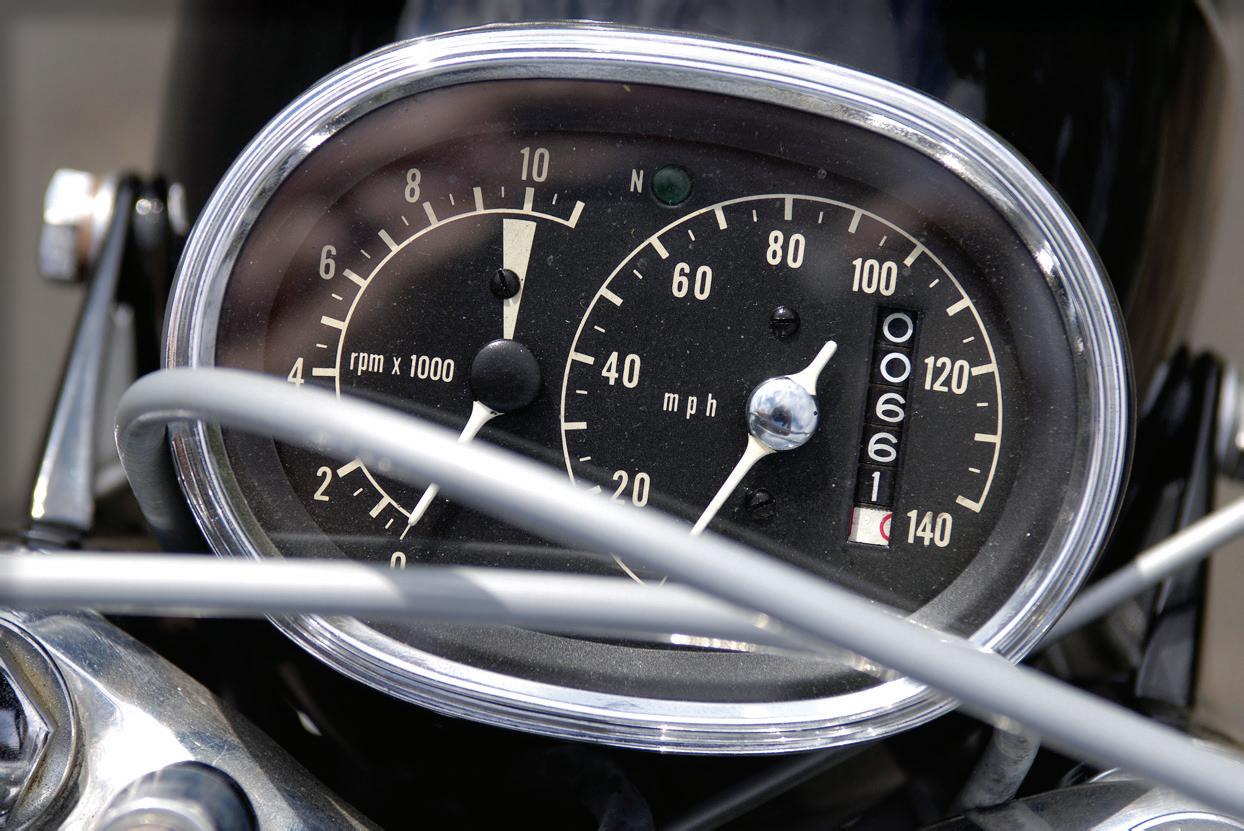
Contemporary testers noted several faults, including poor rear shocks, vibration and the aforementioned need for a longish warm up to ensure a sufficient supply of oil to the top end. Over-revving the bike when cold could cause premature engine failure. Some also noted the bike’s oddly spaced gear ratios and the lack of a 5-speed transmission, a feature that would finally come a few years later. And at a dry weight of 412 pounds, the K0 was heavier than a contemporary Triumph 650, which weighed in around 365 pounds dry.
The Bomber was moderately successful, but Honda belatedly realized it would be even more successful if the styling, with its somewhat odd, humpbacked gas tank, was more mainstream. In February 1968, the K0 was superseded by the K1, with a 5-speed gearbox, a more conventionally shaped tank, a larger oil pump to aid warm up and a longer wheelbase to improve handling. After the introduction of the CB750 Four in late 1968, the 450 twin was no longer Honda’s flagship, but continued through 1974 in an important role as a middleweight street machine. Honda reintroduced the concept with the 395cc Hawk in 1978, one of the most reliable commuters ever built.

Early Japanese motorcycles become classics
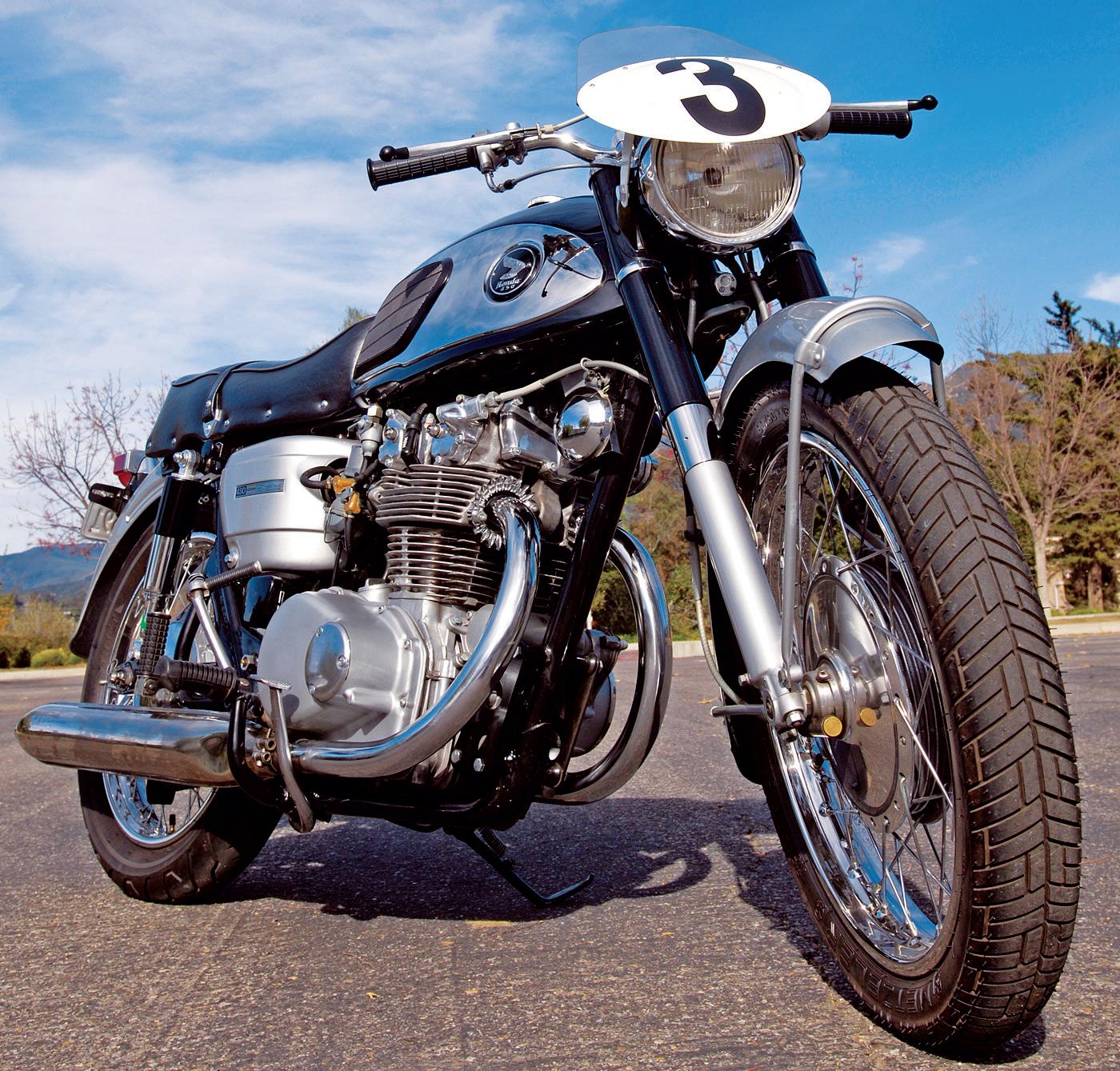
Early classic motorcycle enthusiasts were interested in the pioneer bikes built before World War I. As the vintage movement matured, a wide variety of older motorcycles — including 1960s Japanese bikes like the Bomber — became accepted as classics. “As the Baby Boomers return to the enjoyment of their youth, there has arisen an emerging market for older Japanese motorcycles,” notes Roger Craig, who is the prior owner and restorer of our test bike.
Increased interest in bikes made in Japan in the Fifties and Sixties led to the formation of the Classic Japanese Motorcycle Club (primarily West Coast) and the Vintage Japanese Motorcycle Club (organized in 1977 and stronger on the East Coast) both of which organize rides, shows and swap meets. Roger is a member of both.
Roger grew up in Melbourne, Australia, a hotbed of motorcycle enthusiasm, and as a teenager was an enthusiastic rider of small Japanese bikes. He eventually moved to the U.S., got married, raised a family and got involved in other things. “Many years later,” he explains, “I had an opportunity to return










www.MotorcycleClassics.com 51
1966 HONDA CB450K0 “BLACK BOMBER”
Doubtless most Honda owners never had to use the provided tool kit (above). Number plate (right) was added for fun; this is no race bike.
to motorcycling. I had more free time, and I wanted to go back to something I enjoyed.”
Roger found himself drawn to restoring and collecting the Japanese classics. “I first got a Kawasaki W650 — one of the new classic-appearing bikes,” he says. “Later, I found a 1976 Honda 750, a real classic. I did a few restorations, and I settled on the idea of a Bomber. When my wife, Ann, and I were at a motorcycle show, she was really taken with one that was there — the appearance, the proportions.”

Roger then went out on a search mission. Bike broker Allan Siekman had a frame for him, but even with eBay, locating parts was challenging. Although many of the engine parts are easily available, sheet metal, especially one-year-only parts like the front suspension, tank and seat, are hard to find. “I tapped into the old Japanese bike network,” Roger remembers. “I found David Silver Spares in the U.K., one of the best sources for pre-1970 parts. This is where belonging to a club and being part of the network comes in. People are willing to help one another.
“People who need a part will often make more than one. For example, a gentleman in South Carolina had extra seat hinges manufactured during his own Bomber restoration. Greg Clauss, of Clauss Studios, is a friend who makes parts in rubber and plastic. People call me for help locating parts. Someone called me just the other night, and I did what I could.”
He continues: “The key to completing a restoration is understanding the sequence of events. Things come together in a certain order. You also have to know your strengths and limitations. I try to avoid engine rebuilding, so I look for an engine in good condition. With the Bomber, that was not possible, so I had Charlie at Charlie’s Place in San Francisco [now in Los Angeles, California] do the rebuild on this bike engine.”
Roger explains that one of the key decisions to be made early on in the restoration is whether the bike is to be a rider or a show bike. “What you aim at is what you will end up with,” he says. “For me, the bike was restored and built to ride. I bought new tires and updated the electronics. The charging system
52 Motorcycle classics Street Bikes of the ’60s
was not reliable on bikes of the era.” Roger approaches a restoration in a methodical way: “I work on one project at a time. Some people may think I am anal retentive. I think of the process as ‘Classic Project Management.’ I make a commitment to do something every day. For me, that works.”
The Bomber moves on Roger was not planning on selling the Bomber. He was enjoying having it around. “Even today,” he says, “the rideability and durability of the Bomber, its acceleration and cruising speed, and its ability to stop make it continue to be used.” He believes that the handling complaints of contemporary testers were overstated — or perhaps simply due to bad tires and toolight fork oil. “It’s a good bike for someone who wants to enjoy a ride — even a spirited ride,” he explains.
Word got out that Roger had this really nice Bomber, however, and a broker approached him with an offer. He wavered a bit, but decided to part with the Bomber after learning it was to go to a museum. “We are simply custodians of these
The CB450’s calling card was its double overhead camshafts, a feature then found only on exotic race bikes, and certainly not on “cheap” Japanese street machines.


machines,” Roger says. “It’s good that it’s going somewhere where others will see it.”
That somewhere else was to collector Guy Webster, who always liked Black Bombers. Best known for his Italian motorcycle collection, Guy was picking up early Japanese machinery for his museum. “I had a Bomber in 1968 and loved it,” he says. “There’s a place in my heart for Fifties and Sixties Hondas — but only those years. The 4-cylinder 750s were works of mechanical art.”
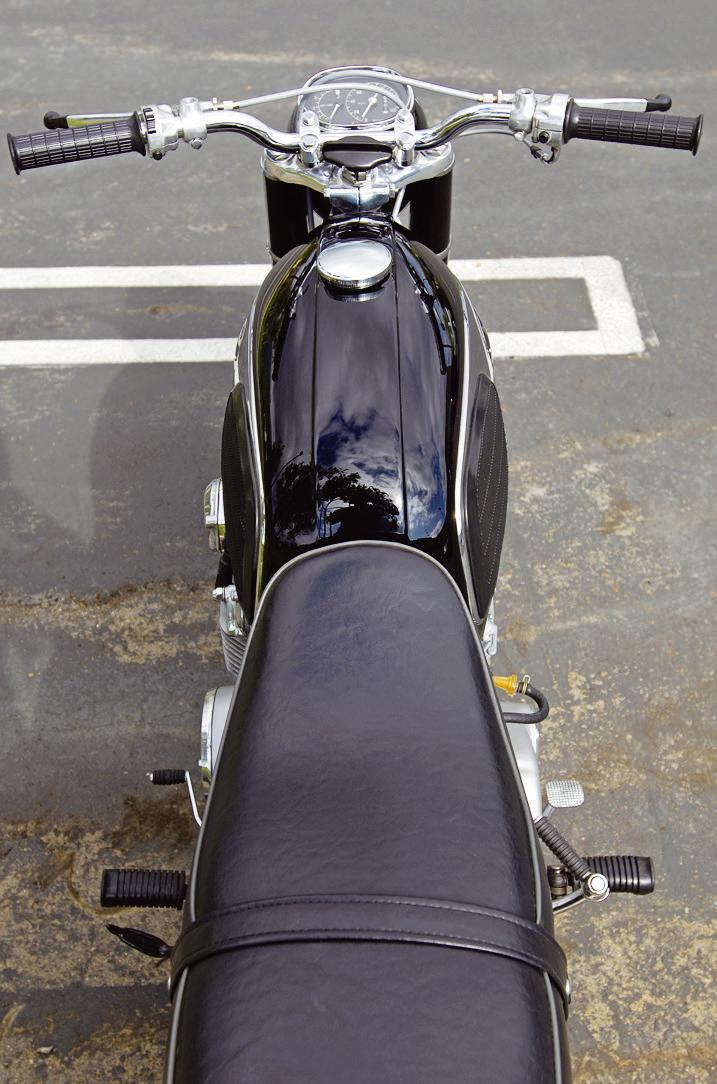
Although the bike’s not 100 percent correct, that didn’t bother Guy. “This is a rider for me,” he said. “The bars are not correct, but they are better for me than the stock ones.
“It has guts — I like the twin cam. The sound is spirited, and I like just listening to the Bomber idle. The shocks don’t bother me if I’m not racing. It handles just fine. I used the wide apex method of getting through a turn, and it held its line perfectly. I tried hanging a knee out, but there was no difference. The brakes are superb — I am thrilled with the brakes. They aren’t grabby, and there is a good feel. Drum brakes work if you set them up properly, and Roger did an excellent job.” The one thing Guy doesn’t like is the neutral light: “It’s the size of a pin, and hard to see.”
The date the Bomber went on sale is a dividing line in motorcycle history. Before that date, Japanese motorcycle manufacturers weren’t taken seriously in the world market. After that date, they were. The Bomber showed its competitors that Honda could not only match what other manufacturers were doing, it could go far beyond them in technological development.
“Attack where he is unprepared; sally out when he does not expect you.” — Sun Tzu, “The Art of War” MC
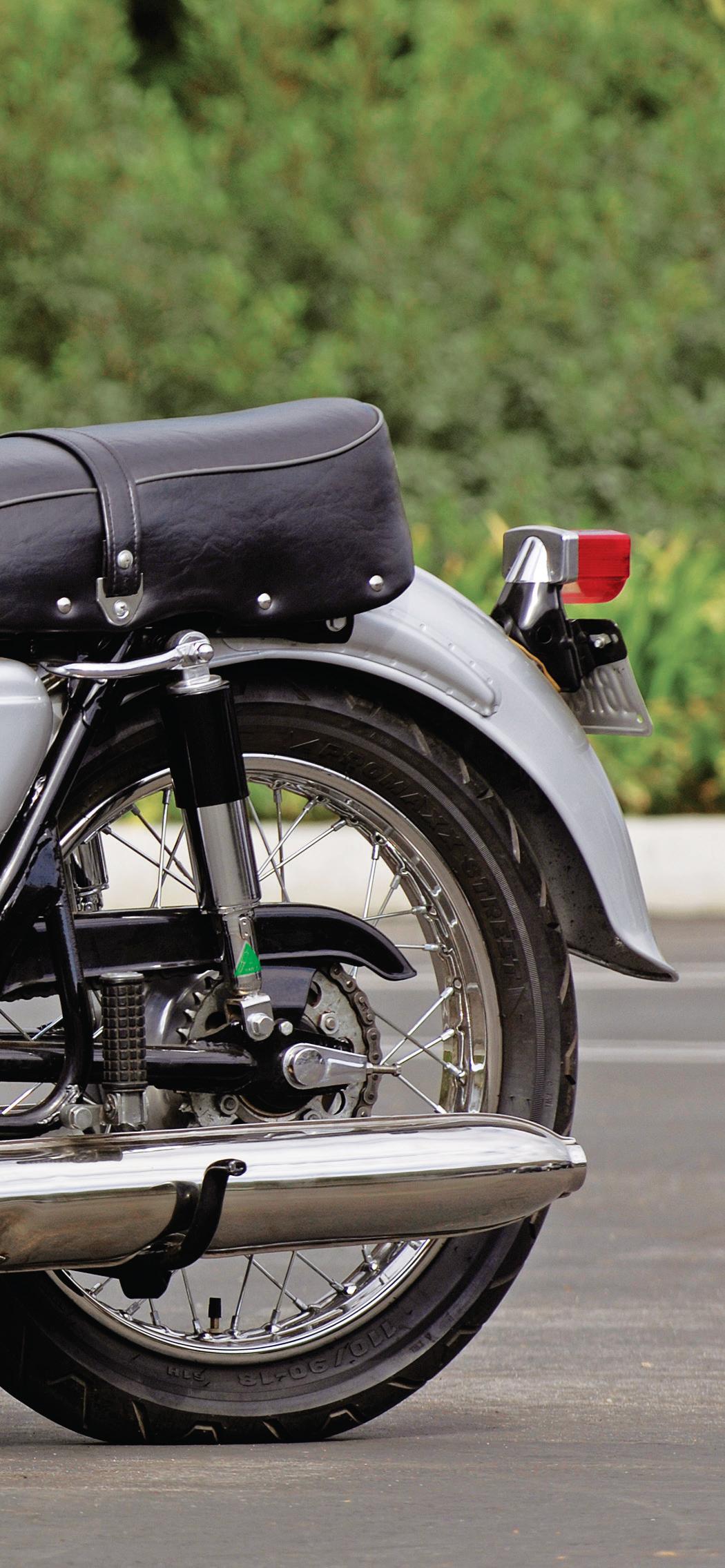
www.MotorcycleClassics.com 53
AMERICA’S BRIT BIKE

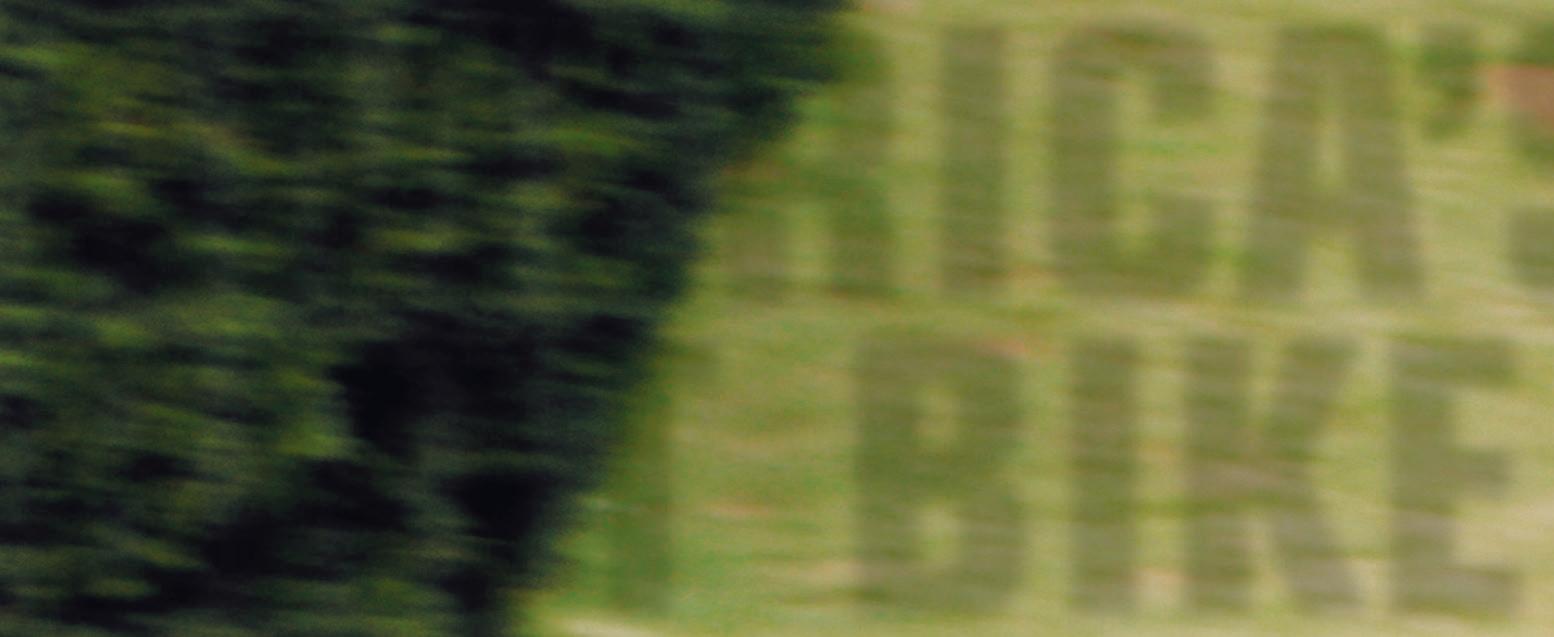
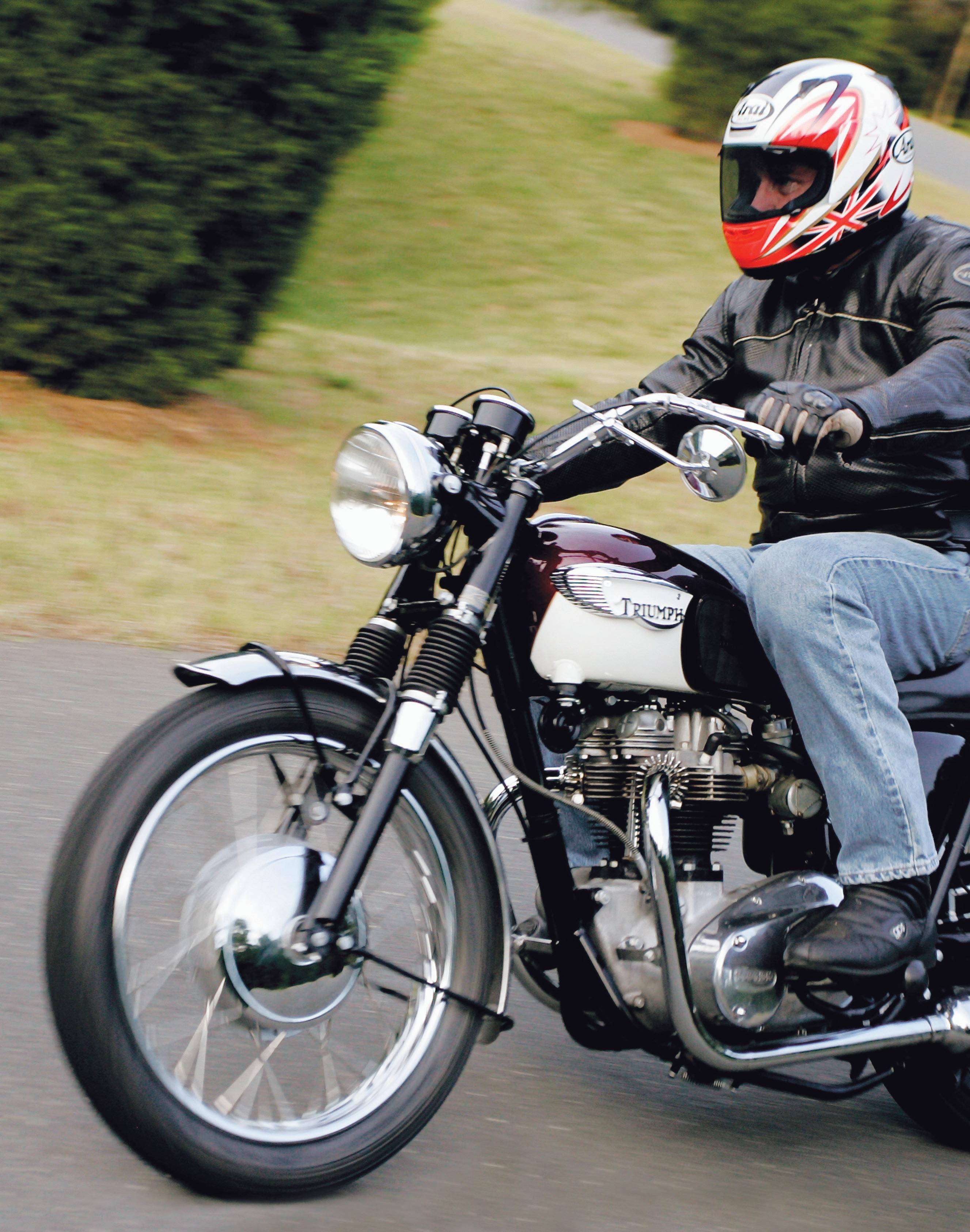 Story and photos by Neale Bayly
Story and photos by Neale Bayly
S“Shouldn’t you be wearing polyester, playing shuffleboard and heading off to Mrs. Appleton’s buffet?” I inquired of the 63-year-old grandfather of three as we stood peeling our sweaty helmets and leathers off in the pit garage.
I’d just worked my tail off at some outrageous speeds staying with Tom Blocker on his Ducati 1098 while riding my Kawasaki 600cc track bike, and as I was soon to discover, his passion for motorcycles extends far beyond going extremely fast on my local race track.
A confirmed dirt bike guy, Tom started riding on a Honda CB160 with high pipes and offroad tires. In fact, most of Tom’s early years were spent on two wheels.
A stint as a service manager at a Honda/ Triumph dealer as a young man started his love affair with the brand, but not by choice. It seems no one in the shop wanted to work on the unreliable British twins that were constantly in for repair, as all of Tom’s work mates preferred the more reliable and cleaner Hondas. Tom somehow got the job of tending to the old Brits, and subsequently became quite intimate with the mechanical workings of the breed. And though he never owned one, it left him with a desire to have one in the garage for the occasional ride.
Entering a career in the automotive business, starting a family and engaging all the responsibility those tasks bring with them curtailed Tom’s street riding for close to 25 years, although he did continue dirt riding.
Then fate intervened in 2003, while he was in Las Vegas on a business trip. Attending the Art of the Motorcycle exhibit, he fell in love with a Ducati 916 and an MV Agusta that were on display as part of the exhibit. With the “stupid drug” (as Tom likes to refer to the love of motorcycles) injected straight into the main vein, he flew home, telling himself, “There’s no reason for me not to have one.”
On the track
Tom has always enjoyed high perfor-
mance, and when he wasn’t riding he was driving, racing open-wheeled cars for a number of years in SCCA (Sports Car Club of America) Sports 2000, so the sporting nature of the Ducati marque spoke to him. Soon, a 916 found its way to Tom’s garage. This was quickly replaced with a more comfortable ST4S once he discovered the 916’s plank-like seat and stiff, race-derived suspension.
This didn’t last long, either, and Tom soon bought a 999 for regular track weekends. The 999 was traded for his current 1098 as he looked for more speed, and he also added a Multistrada for road duty, and a KTM 300XC to stay sharp in the dirt.
But with all these two-wheeled activities back in his life, he still hankered to have an old Triumph in the stable.

If you’re starting to hate Tom about now for having so much fun on two wheels, it’s about to get worse. You see, Tom is blessed with a wonderful wife, Claire. And Claire, knowing he was lusting after a 1967 Triumph Bonneville, tracked one down at Baxter’s Cycle in Marne, Iowa. The bike she found wasn’t pristine, but it was in good running order, so after some discussion and an exchange of money Claire had it delivered to the house — without Tom knowing. This was a little tricky, as she had to time it to arrive before the MasterCard bill. With his good friend Wayne running decoy on the day of arrival by taking Tom out for a ride, the bike was smuggled in and was waiting in Tom’s garage upon his return.
Although the Triumph was a little rough, it was ready, and for a time Tom enjoyed blasting around the neighborhood and tinkering with the old girl in the garage. She was blowing oil from the breather, though, and Tom knew it needed an engine rebuild.
www.MotorcycleClassics.com 55
1967 was Triumph’s best year ever in the U.S., with an estimated 28,000 bikes sold here. Whatever the number, Tom Blocker’s glad he finally got his.
Tom knew he wouldn’t have the time to undertake a rebuild himself, so he employed the services of Buddy Brown and Ted Hubbard at Port City Cyles in Mooresville, N.C. These guys have Castrol R running through their veins. Buddy used to be a BSA dealer and Ted was a notable Class C Expert flat track racer who campaigned BSAs, and between the two of them they have forgotten more than most people will ever know about British twins.
Pulling the engine out of the frame, they stripped and cleaned everything before splitting the cases. Once inside, they found the engine was full of sludge,
so it was certainly time for some attention. All the bearings were replaced and a new oil pump was installed, and then the crankcase was bolted back together. The top end was fine as were the pistons, so they were reused, and the engine was re-installed without any attention to cos-











The best of Britain? That’s what many people think of the 1960s Bonneville, and it’s easy to see why thanks to its flowing lines, luscious paint and classic engine.

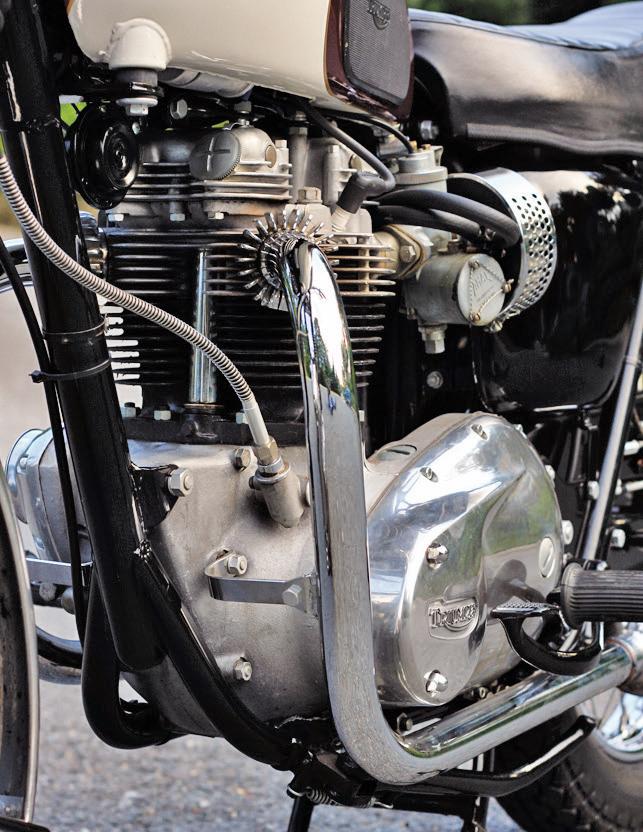

metic appearance, as Buddy and Ted’s attitude was they could care less how it looked as long as it ran well. This refresh set Tom back about $800, and he rode the Triumph as a functional but not pretty bike for a while longer. It ran reasonably well, but the carburetors never seemed quite right to Tom, no matter how much he worked on them. Truth be known, he was itching to perform a ground up restoration on the bike.
 1967 TRIUMPH T120 BONNEVILLE
1967 TRIUMPH T120 BONNEVILLE
Help comes along
A chance meeting at a local track day with Joe Rankin, who was riding an immaculately prepared Aprilia RS250 and an equally well-sorted Suzuki SV650, found Tom his restoration man. The problem was, it took two years of pestering Joe to talk him into taking on the project. With the Triumph finally at Joe’s workshop in Raleigh, N.C., it was completely taken apart to the last nut and bolt for the restoration Tom had been wanting.
The frame and swingarm went out to be powder coated black, and while they were away Joe began hand-polishing the engine cases and valve covers. He cleaned and prepped the carbs and also installed new fuel lines. The wheels were disassembled, the rear hub receiving black powder coat and the front silver. New stainless steel spokes were laced into the original rims and the wheels were finished with new bearings and tires.
The bike had a lot of new parts already, so there was no need to replace the cables, handlebars or levers, although Joe did redo the wiring harness. He also replaced the steering head bearings and installed new header pipes. The original mufflers were deemed to be in good enough shape, as was the seat. “The devil’s in the details,” Tom says as he shows me
the $3,849.66 parts bill. Every nut, bolt, washer, grommet, breather pipe and seal was replaced, along with all the screws, springs and connectors. He also went with a Boyer electronic ignition to help make the bike easier to start, as there’s no electric starter on a T120 Bonneville.
And it doesn’t really need one, as Tom enthusiastically shows me how quickly and easily the bike starts with one or two firm kicks. Tom also spent $500 on
chrome plating, with stuff like the foot peg bracket and gear shifter receiving the upgrade. As the project was coming to fruition, one of the final touches was to send the bodywork to Greg Pettigrew at European Motorcycle Restoration and Paint in Charlotte, N.C. As a wizard who specializes in European motorcycles, it’s hard to top Greg’s work. He made sure the paint matched the original scheme, and it’s clear Greg is an overachiever. The quality of the work shines through as I shoot the bike in the last light of day, the reflections of the trees nearly perfect in the wet-looking gas tank.
With the bodywork back, the original fenders were hand polished and all new grips and rubbers were installed. The instrument cluster was cleaned up, the tachometer drive replaced and a new speedometer drive was installed. A new set of fork seals, final drive chain, and various bulbs were the last few items on the list, and Joe had the Triumph buttoned up and ready for delivery.
Tom is delighted with his immaculately restored Triumph, and it now sits proudly in the garage next to his modern bikes as the favorite. Thankfully, he does more than just look at it, as the 1967 Bonneville gets ridden regularly. And take it from me: Like all of Tom’s bikes, it doesn’t get ridden slowly. MC
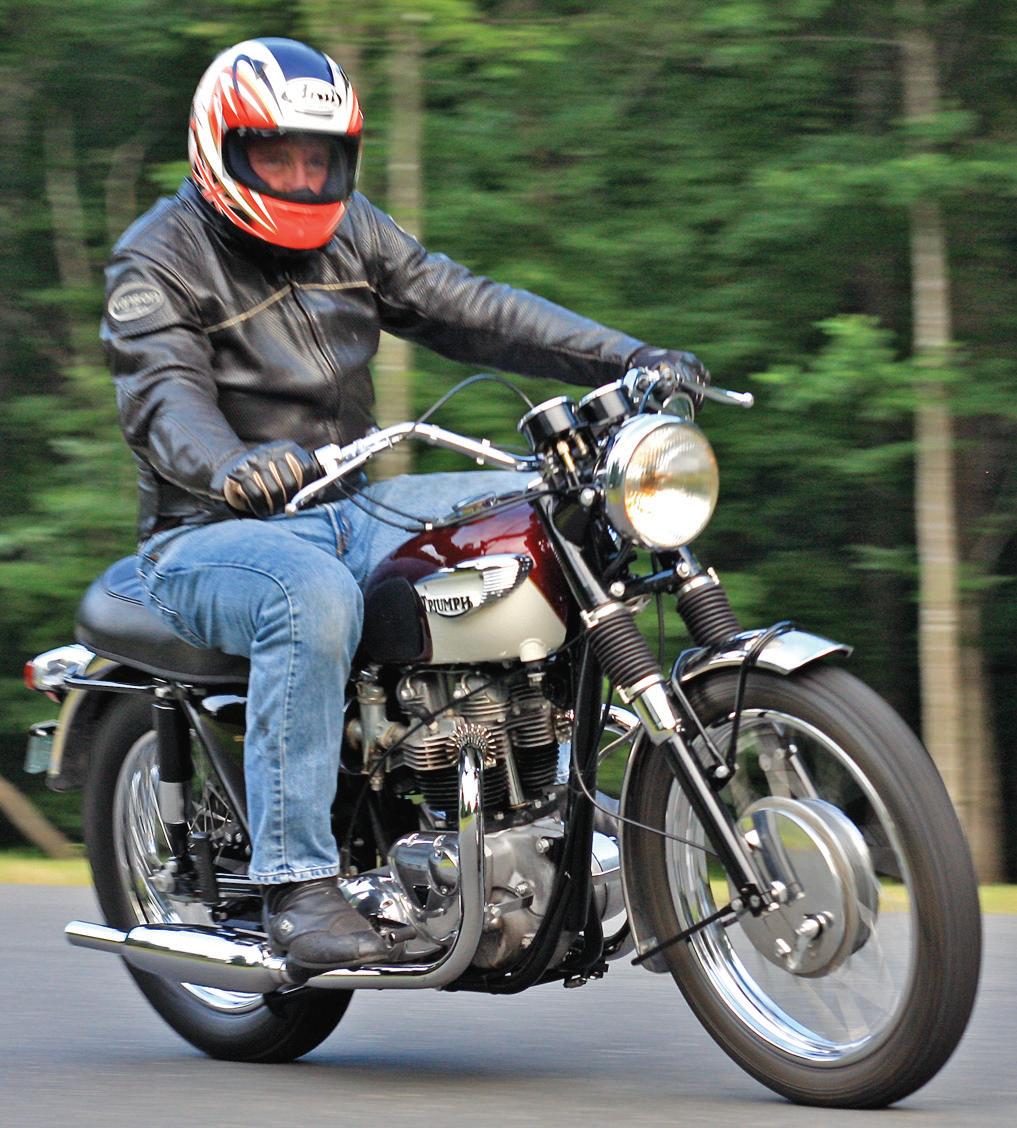

www.MotorcycleClassics.com 57
Owner Tom Blocker restored his Triumph to ride, so he’s not scared to head out and get it dirty, which he does regularly.
SPANISH DELIGHT


1965 Bultaco Metralla

TThe tasty Texas Bultaco featured here isn’t served with salsa and chips — it comes with one cylinder, two wheels and a boatload of grins.
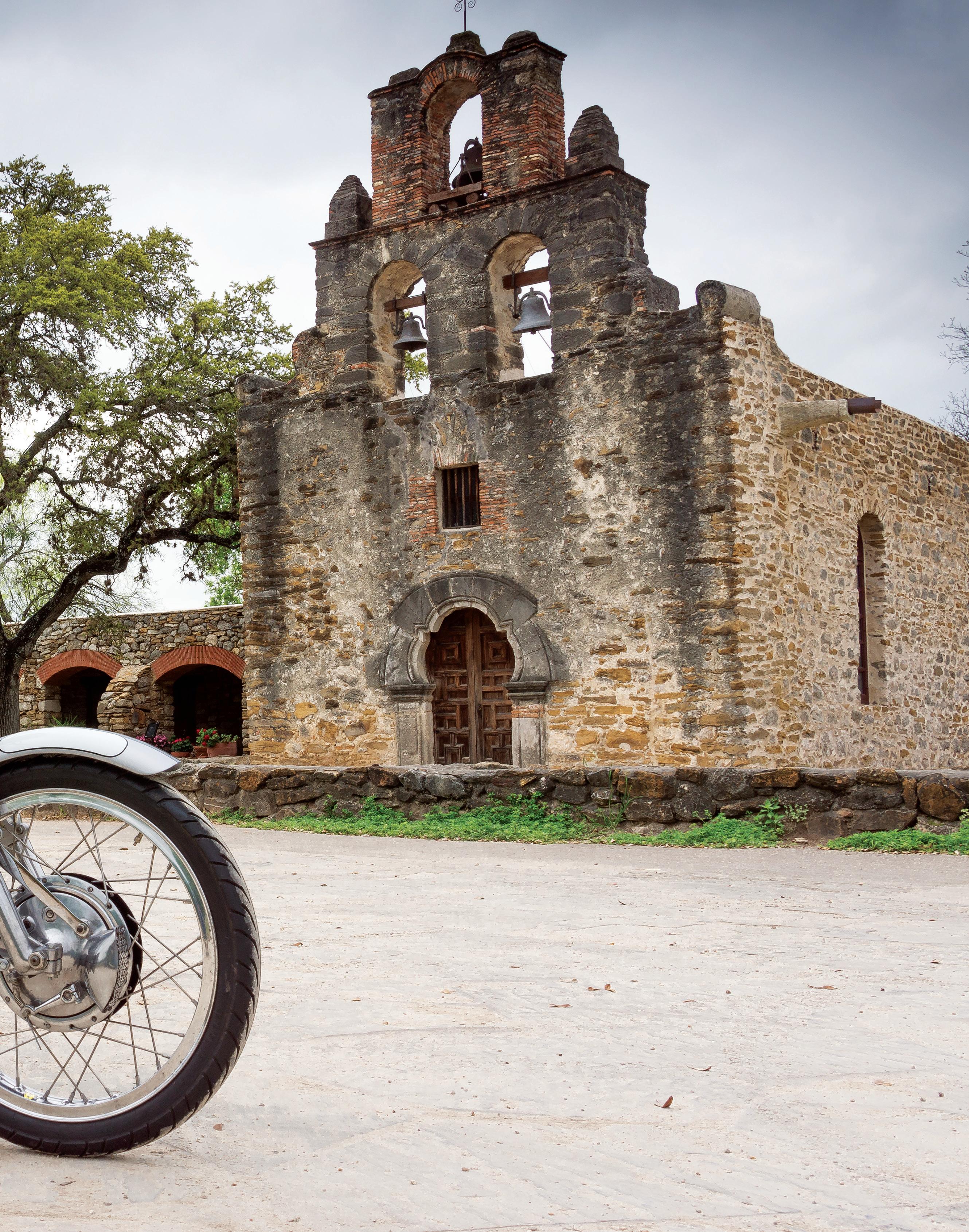
The United States was Bultaco’s largest market in the 1960s, but beyond the offroad world of trials and motocross, the Spanish company was not well-known and never attained more than cult status here. That’s a pity, because as the lovely Metralla on these pages proves, Bultaco also made exceptional street bikes.
Bultaco’s beginnings
Francisco Xavier Bultó, popularly known as Paco Bultó, cofounded the Montesa motorcycle company in 1944 and helped develop the company’s 125cc race bikes that were so successful in the 1950s. The Spanish economy hit a slump in 1958, adding to the financial strain Montesa was already experiencing following its recent move to new, larger premises.
The company chose to cut costs by withdrawing from racing, also eliminating its competitions department, as Moto Guzzi, Gilera and Mondial had already done. As a board member, Bultó strongly disagreed with this decision — he believed racing “improved the
www.MotorcycleClassics.com 59
Story and photos by Corey Levenson
breed” and boosted sales. The company would not be swayed, so Bultó resigned and made plans to pursue his other business interests, which included textiles and a company making pistons and piston rings.




Shortly thereafter, a group of Bultó’s former colleagues invited him to dinner. At the meal, the 16 Montesa employees gathered together echoed Bultó’s strong feelings about the racing program. They were poised to leave Montesa, and encouraged Bultó to establish a new company to build sporting motorcycles. Bultó agreed, and, in June 1958, he formed Compañía Española de Motores SA (CEMOTO) at his family’s country home on the outskirts of Barcelona.
To form the brand name Bultaco, the first four letters of Bultó’s last name were merged with the last three letters of his nickname, Paco. Their trademark “thumbs up” logo arose from Bultó’s memories of seeing British race mechanics giving their riders the thumbs up sign as they flew past the pits, indicating “all’s well.”
Bultaco’s initial goal was to design a 125cc competition motorcycle that could also serve as the basis for a line of production machines. By October 1958, they had completed the first running prototype.

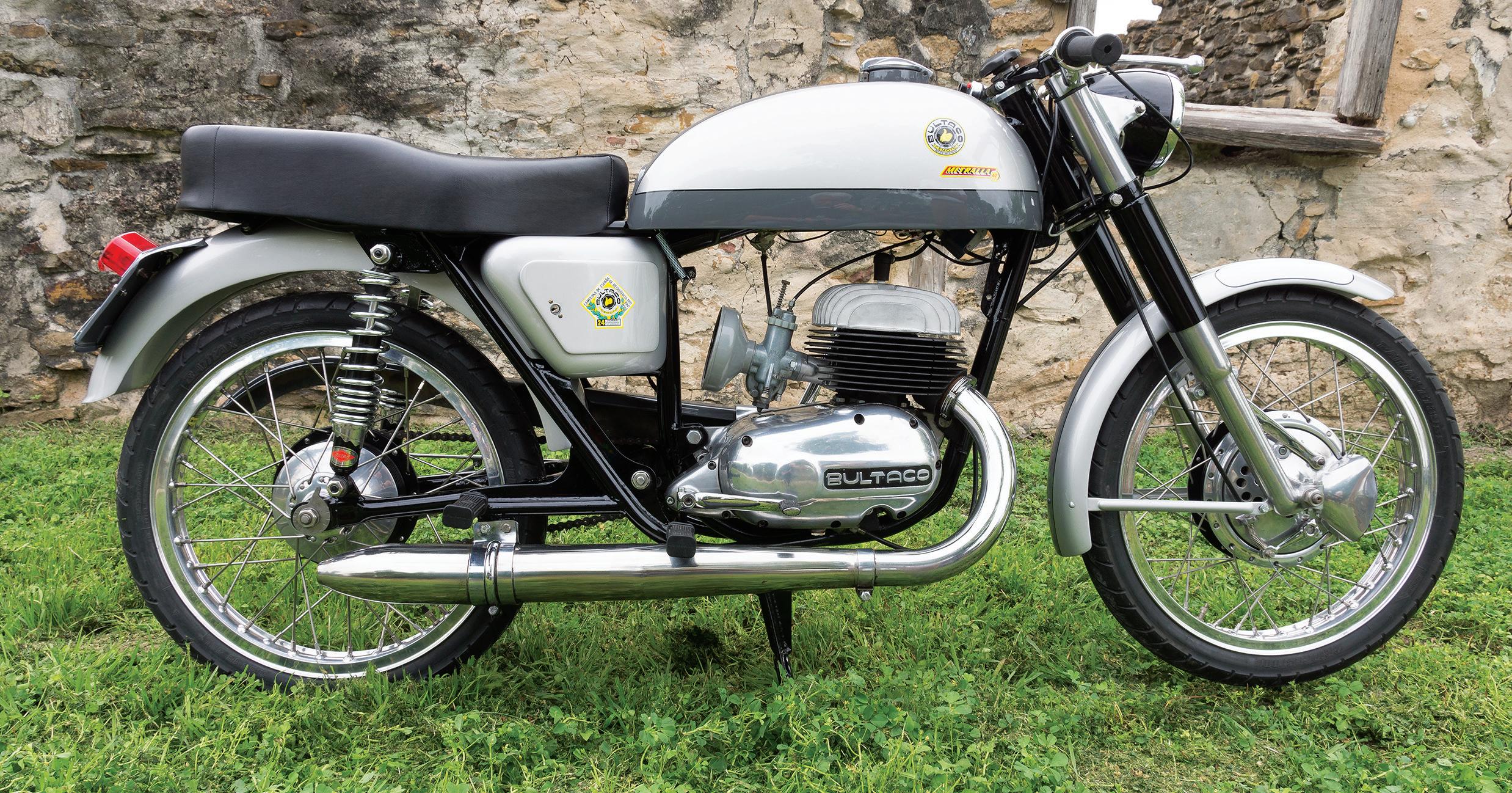
A winning platform





The following spring, in April 1959, the new race bikes proved themselves at their first outing at the Spanish GP
The Metralla weighs in at just 218 pounds, making the most of its 20 horsepower engine.
at Montjuich Park in Barcelona, where the Bultacos took seven out of the top 10 finishing spots. In the years that followed, the basic engine architecture of that first road racer — an air-cooled, single-cylinder, piston-port 2-stroke — was carried over into winning road and offroad models in various displacements including road racers (the TSS), street bikes (the Metralla), offroad machines for trials (the Sherpa) and motocross (the Pursang).
A passion for motorcycles
Bultó was not merely an industrialist. From his teenage days he was a motorcycle enthusiast who also competed successfully as a rider. Bultó was amateur champion of Catalonia in 1935 on a Velocette, and, in 1948, he was Spanish national champion on a 250cc Montesa.
Many of Bultó’s descendants inherited his love of motorcycles. He had 10 children, and one son, Juan Soler, became Spanish Trials champion and went on to work for Bultaco. Bultó’s nephew, Oriol Puig Bultó, was a leading motocross star who represented
1965 BULTACO METRALLA
Spain in the Trophée des Nations, competed in the annual Six Days Trial, and later served as competition manager for Bultaco. Bultó was proud to see one of his grandsons, Sete Gibernau, compete successfully at the top international level in 250cc and 500cc Grand Prix races.
In a tribute written for Cycle News in 1998 following the death of Francisco Bultó at age 86, journalist and former Spanish road racing champion Dennis Noyes recounted that when the old man was on his deathbed and realized the end was near, he said, “Bring me my moustache wax and my best Bultaco shirt. For a trip like this, you must be at your best.” How can you not respect and admire such a man?
Like Soichiro Honda, who in 1954 declared he would devote his heart, soul, creativity and skills to building a motorcycle capable of winning at the TT races, Francisco Bultó was a visionary leader who recognized the value of success in top-level competition. The two men shared a mutual respect and an uncompromising attitude towards ensuring that every machine they produced would make them proud.
The Bultaco Metralla
From 1962 through 1966, Bultaco made approximately 5,000 200cc Metrallas (also known as the Model 8 or MK62). The choice of the model’s name is puzzling given that “metralla” is Spanish for shrapnel. Clearly, some -

one in the marketing department had a sense of humor. The engine was all aluminum alloy with cast iron liners and hand-finished transfer ports. Free revving, the engine made about 20 horsepower, which was not too shabby for its size.
The primary case was on the right, engine power transferring through the transmission to the chain final drive on the left, making it easy to change overall gearing by swapping the front sprocket. Shouldered alloy rims, a Monza-style flip-up fuel cap, clip-on
The Mk2
In 1967, the factory introduced the Metralla Mk2. The engine grew to 250cc, and output increased to 32 horsepower — good enough for 100mph, making the little Metralla, at least for a brief period, the fastest 2-stroke street bike in the world.
The rear chain was enclosed in a case, the front brake was upgraded to twin-leading shoes and a battery was fitted to keep the lights on when the bike wasn’t running. An oil tank and injection pump were added so that the rider didn’t have to prepare their own premix, and the gearbox grew from four to five speeds. Bultaco made approximately 5,000 second-generation Metrallas before production ceased in 1974.
The Metralla mystique
handlebars and a big air scoop on the front brake all contributed to the bike’s racy looks.
There was no battery — the flywheel on the left side of the engine incorporated a FEMSA magneto to provide sparks and generator coils to create current for lighting. At low rpm, the lights were weak, and over-revving could cause the lights to burn out — not a great design. Instrumentation was limited to a speedometer, and a kickstarter (on the left side) brought the little beauty to life. It was all thrills and no frills.
The Metralla enjoys a welldeserved reputation for excellent road holding and being immensely fun to ride. The frame welds aren’t pretty and there are no exotic tubing materials, yet Bultaco nailed the steering geometry, rigidity and weight distribution — the lightweight Metralla’s ability to grip the road inspires confidence. If Goldilocks rode bikes, she would approve: The balance of handling, power and braking is just right.
A 1965 Bultaco ad stated: “The Metralla is a production racer fitted with street equipment. The 200cc engine has been detuned to 20 horsepower. You still get a reasonable top
www.MotorcycleClassics.com 61
“Locating replacement parts was challenging. Most came from Spain and were triple the cost of corresponding parts for a British bike.”
speed — 85-90mph, stock. But you get fierce acceleration right off idle — 16.7 seconds through the quarter mile — coupled with outstanding reliability. The Metralla will stay with its productionracing brothers in the corners … You can go in so fast that your elbow feels like it’s about to scrub the asphalt.” And this was long before Marc Márquez was even born.
It wasn’t just advertising fluff: In the 1967 250cc Production class race at the Isle of Man TT races, Bill Smith and Tommy Robb finished first and second on Metrallas and set a lap record for 250cc Production machines that stood until 1976. With aftermarket bits like an expansion chamber exhaust, a racing Dell’Orto carb and revised gearing, the little Metralla could run an honest 100mph.
Vincenzo’s Metralla




































































Vincenzo Murphy bought our featured 1965 Metralla from a friend in Austin, Texas, in 2008. The bike had sat for many years in the back of a poorly lit shed,
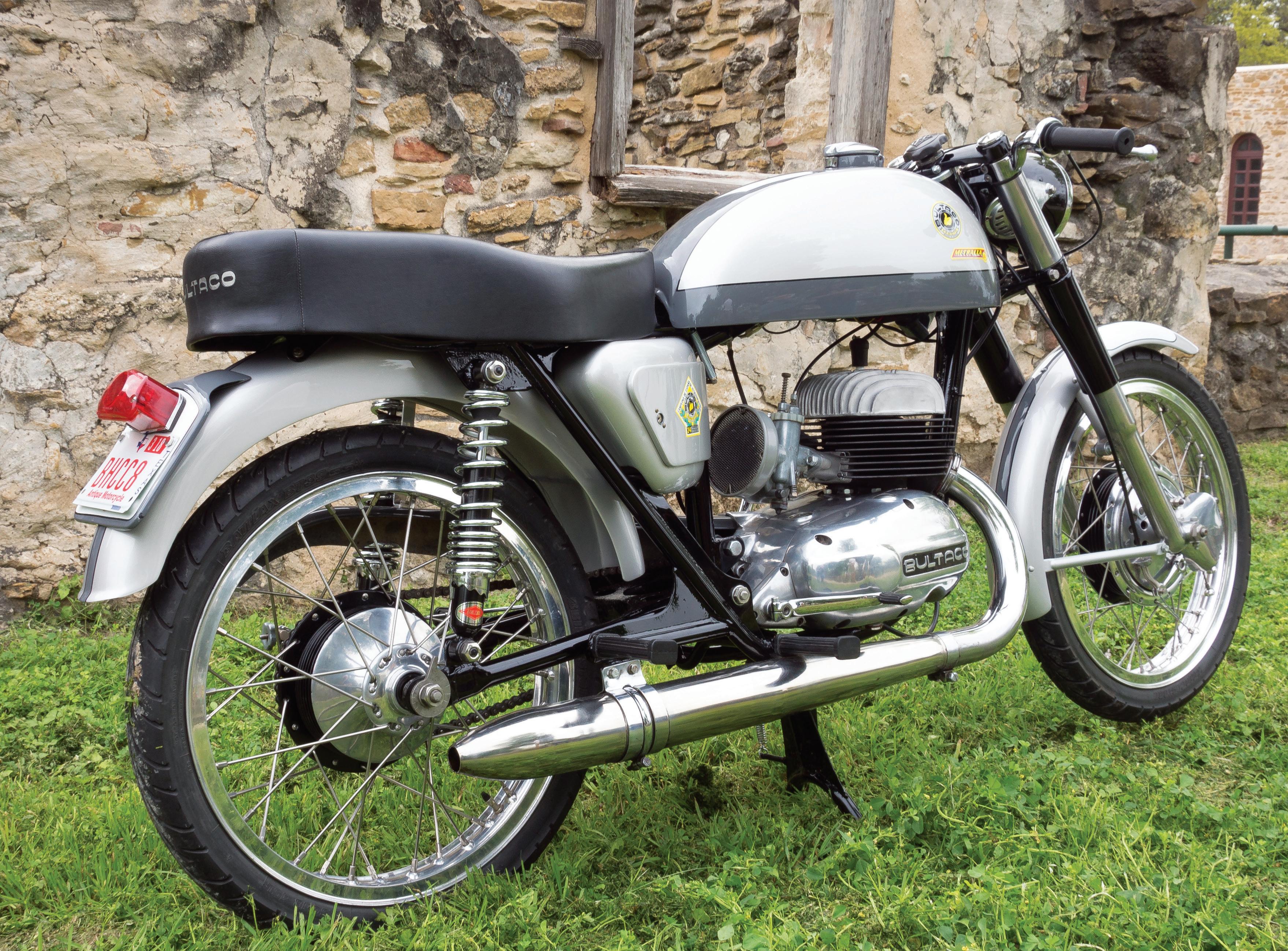
and it wasn’t until the deal was done and he dragged the bike out into the light that Vincenzo saw how much work it needed.
The old girl was in rough shape. The alloy parts (engine/gearbox cases, hubs/ rims, etc.) were heavily oxidized. The chromed parts were peeling and the
parts for a British bike. The toolboxes were found on eBay (their keys came from Spain) and an Australian company custom-built the muffler from Metralla patterns. Not cheap.
A fellow Bultaco enthusiast in Houston who used to work at a Spanish bike dealership lent Vincenzo copies of the factory parts and shop manuals. He also provided such newold-stock parts as the front fender, headlight rim and Spanish-made Amal carb and air filter.
exhaust system was rusted and dented. The chain guard, taillight and toolboxes were missing. The gas tank had been painted silver with a rattle-can and the front fender was cut in half.
Locating replacement parts was challenging. Most came from Spain and were triple the cost of corresponding
Vincenzo spent many hours wet sanding and polishing the alloy cases, hubs, rims, fork sliders and headlight brackets. Jon Holbrook at Jack’s Paint Place in Converse, Texas, (jackspaintplace.com) has worked with Vincenzo on various projects for almost 20 years, and his beautiful paint job provided added inspiration to bring the overall level of restoration up a notch. “When the parts came back from Jon, I had no choice but to build a really beautiful bike,” Vincenzo says. “I really value my relationship with him because his work

62 MOTORCYCLE CLASSICS Street Bikes of the ’60s
“In order to pull off something like this you really have to be in love with the process. You need to have a clear picture in your head of the end state.”
always makes me try hard to get everything right.”
The restoration took six years. What provides the motivation for such a lengthy undertaking? “In order to pull off something like this you really have to be in love with the process,” Vincenzo says. “You need to have a clear picture in your head of the end state. Savor such milestones as getting your paintwork back, your seat refinished, your newly chromed parts and freshly relaced wheels. It’s these inspirations that will carry you through the rough periods of the restoration.”
When the bike was done, Vincenzo found it lived up to its reputation: “The bike loves to rev and handles like a dream. The power output is impressive for what it is and the time period it represents. It’s probably one of the most fun bikes I’ve ever ridden. It’s the perfect bike for twisty roads. Its looks are perfectly balanced,” Vincenzo says. “The colors aren’t flashy so much as elegant, giving the bike a purposeful, all-business feel. It has an incredible exhaust note. The smell of Castrol when it is running and the way it handles are completely addictive. It really is an amazing motorcycle.”
Vincenzo may be familiar to regular readers of Motorcycle Classics as the owner of the 1924 Beardmore-Precision and the 1949 HRD Vincent Comet we featured previously. The man knows motorcycles
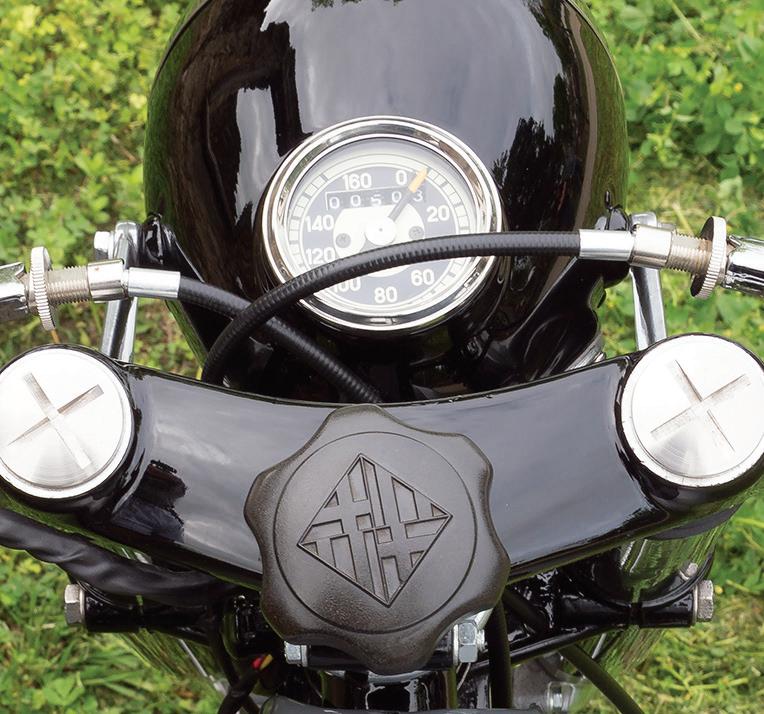
and his praise for the Metralla carries weight.
Bultaco redux?
In 1977, Bultaco was Spain’s leading motorcycle manufacturer, selling bikes in 68 countries. But by the early 1980s, the Bultaco factory had closed as a result of multiple factors including restrictive U.S. EPA motorcycle emission standards, labor unrest in Spain and an increasingly competitive marketplace.
Today, a consortium owns the Bultaco brand and sells accessories such as helmets, watches and apparel bearing the famed “thumbs up” logo (bultaco.com). The company also sells onroad and offroad versions of the Brinco, which it calls “an electric Moto-Bike,” but which most people would call an electric bicycle or e-bike.
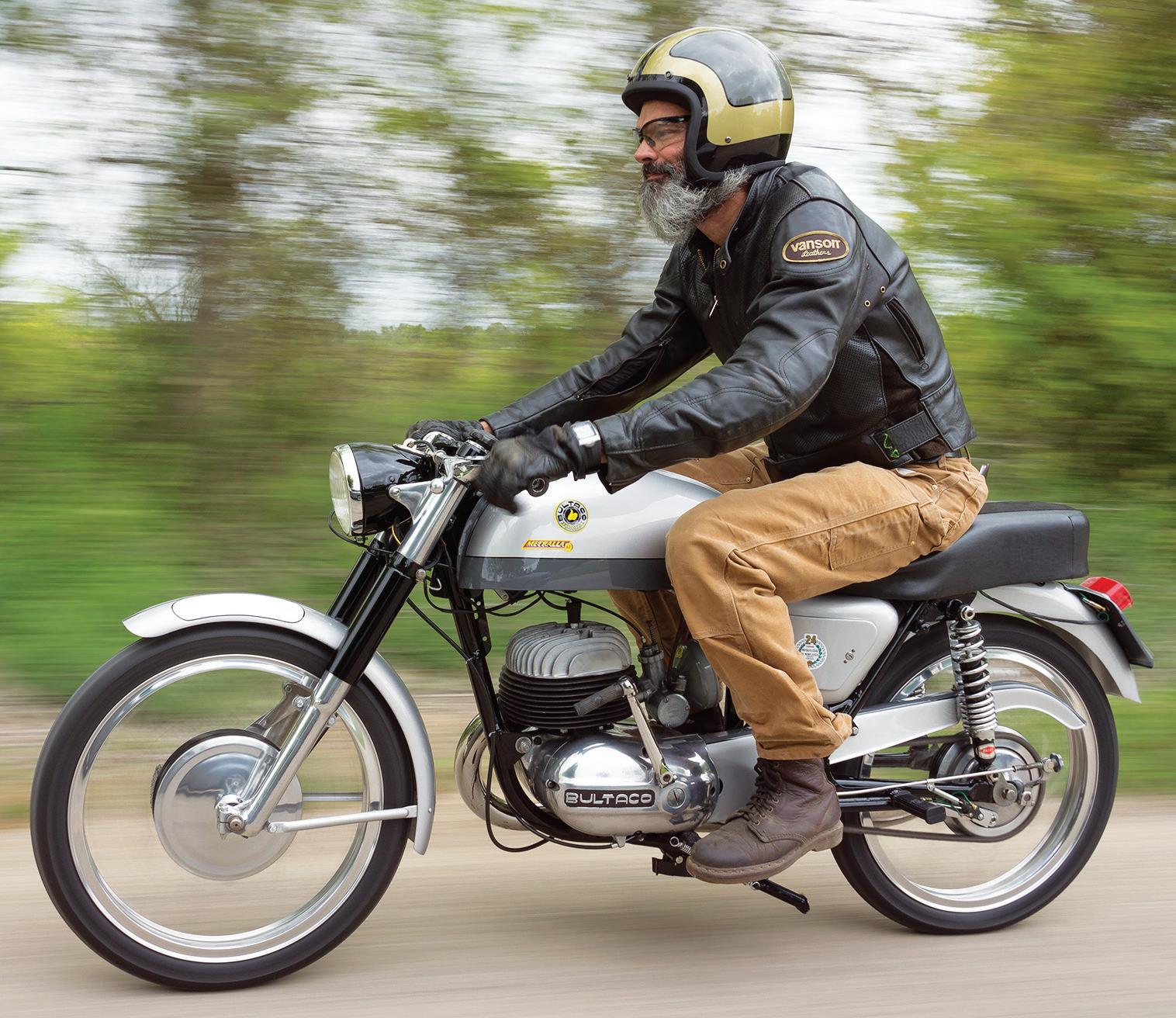
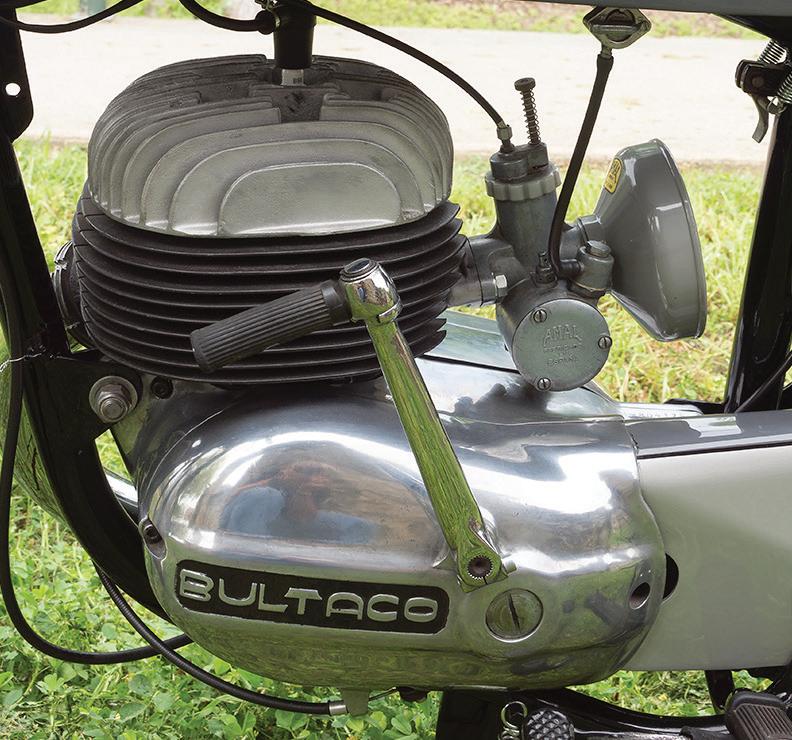

The Bultó family estate where Bultaco was “born” is known in the Catalan language as Mas de Sant Antoni, or San Antonio House. Fifty years after it was first built, this superb Metralla visited another San Antonio half a world away. Like the Bultaco, the 300-year-old Spanish Mission San Francisco de la Espada, in San Antonio, Texas, was built by passionate people. With caring custodians, the Metralla and the building — each understated, elegant and purposeful in its own way — will continue to age with style and grace. MC

www.MotorcycleClassics.com 63
Vincenzo Murphy aboard his lovely Metralla (above). The bike was in rough shape when purchased, and finding the needed parts and restoring it took six years. Many hours were spent wet sanding and polishing the alloy cases.
RECREATING AN ORIGINAL
The Norton P11 Prototype
Story by Greg Williams
HHistory is a subjective experience. Stories of the past are told and passed along, but details get lost with the passage of time. It’s not often that the record can be set straight by talking to the people directly involved — the history makers themselves. But this is exactly one of those cases.

It was 1966 when Bob Blair and his mechanic/parts manager Steve Zabaro worked together to blend components from two motorcycles to create the prototype of what would become the now-legendary 1967 Norton P11.
New Jersey-based Mike Berliner, sales manager for Berliner Motor Corp., acted as an intermediary between the creators of the American prototype and the engineers at Norton. While Blair died in 1996, both Zabaro and Berliner are alive and well, and they remember the story of the Norton P11.

In the beginning


Bob Blair was the proprietor of ZDS Motors in Glendale, Calif., and was the West Coast distributor for the now legendary Berliner Motor Corp., which imported all manner of exotic foreign motorcycles to the U.S. ZDS stood for Zundapp, Ducati
 Photos by Gary Phelps
Photos by Gary Phelps
and Sachs — all brands imported by New Jersey-based Berliner. When Berliner took over Norton for the North American market in the mid-1960s, Blair agreed to distribute the English-made brand for them on the West Coast.

Offroad desert racing was hugely popular in the western states at the time. The machines used in competition needed to be powerful, light and fast. American enthusiasts built their own “desert sleds,” and there were also factory-built offroad bikes competing in desert races, such as BSA’s Spitfire Hornet and Triumph’s TR6.
Associated Motor Cycles (AMC) had an entire slate of dirtfriendly competition machines including the AJS 18CS and 31CS, the Matchless G12CS and G80CS, and, in 1964, the Matchless G15CS and the Norton N15CS (CS for Competition Spring frame).
Lost in translation
It’s a long way from the arid California desert to the foggy climes of Britain, but that’s where AMC produced AJS, Matchless and Norton motorcycles. AMC grew from the AJS and Matchless motorcycle companies, and in 1952 gained the Norton brand.
By 1966, AMC was in financial straits, and according to Zabaro the Berliners were propping up the company, even paying for their orders in advance — and in cash — so AMC could meet their payroll. That same year, Matchless brought out the single-cylinder 500cc G85CS, a purpose-built, high-performance scrambles/offroad racer that worked well in the desert. However, both Bob Blair and Steve Zabaro felt the G85CS could be an even better motorcycle if only it had the bigger and more powerful Norton Atlas 750cc twin-cylinder engine.

“We talked to Mike Berliner and asked him to talk to the factory


Norton P11 prototype replica (with a stock 1967 P11, far left) is a dead ringer for the original. It should be; it was built by Steve Zabaro, who helped conceive and build the 1966 prototype.

“There was no way it could have happened without him — he’s the only person alive who knows exactly how it went together in the first place.”
about putting the Norton 750 motor in the Matchless chassis,” Zabaro recalls. “Mike came back and said the factory said ‘No’ — I don’t know if it was because technically they couldn’t do it or financially or whatever. But Mike told us, ‘If you think it’s feasible, go ahead and do it.’” When told that AMC didn’t think the G85CS/ N15CS marriage could be done, Bob Blair didn’t mince words. “That’s bulls***,” was his exact response.
P11 starting point: a wrecked G85CS
“The Matchless single-cylinder engine (in the G85CS) was long

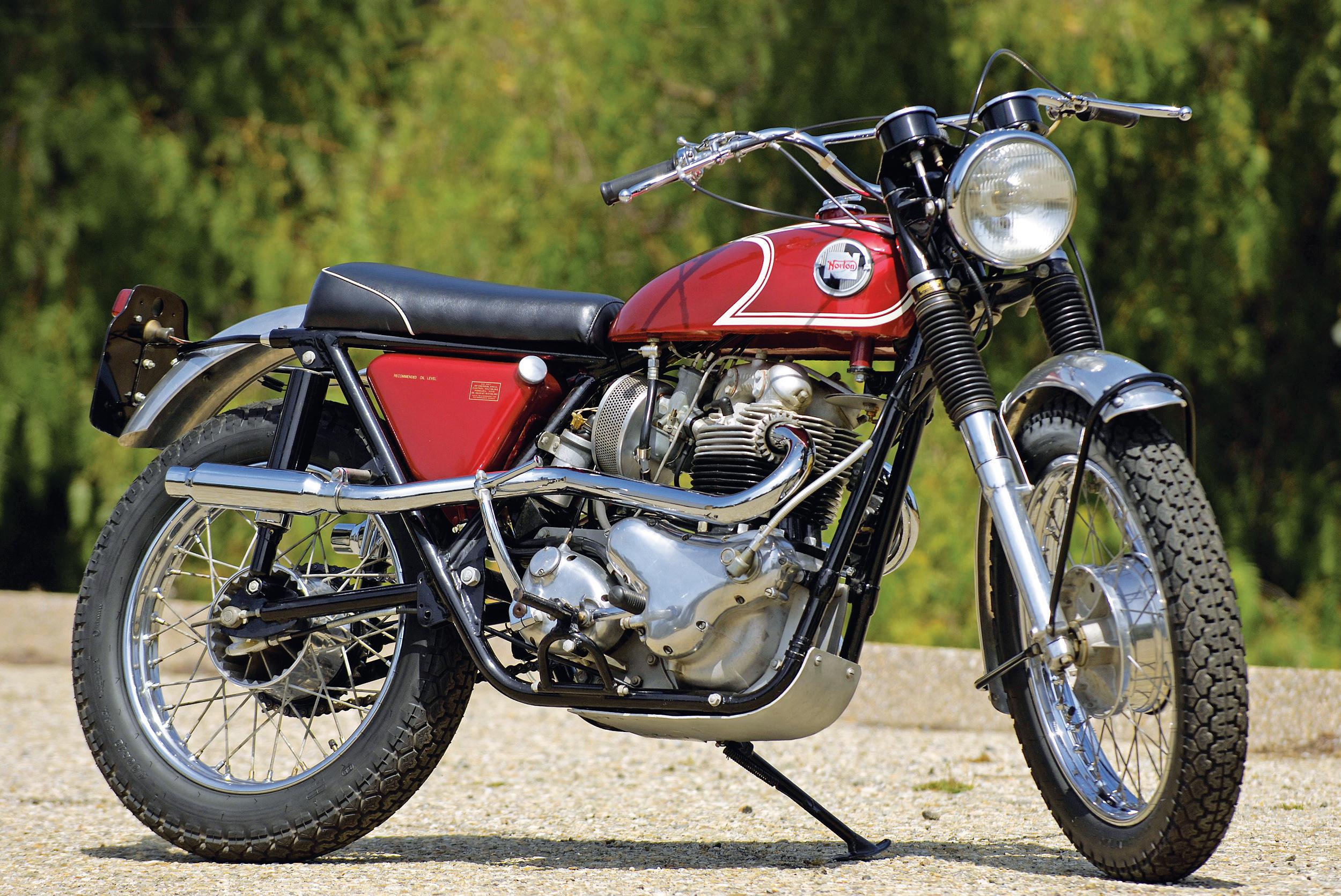
in the tooth,” Zabaro recalls. “Matchless intended to only make a few of the G85s for a televised motocross event in the U.K., but when pictures and stories of the exotic G85CS came out everybody wanted one. There were only 96 of the G85CS made for public distribution, and I would guess we got 70 of them on the West Coast. They were pretty light, but there wasn’t a lot of horsepower.”
Zabaro should know. He bought a new Matchless G85CS and rode it extensively. It was while riding up a washout in Jawbone Canyon in the Mojave Desert that Zabaro hit a large rock, turning the front wheel into a pretzel and severely twisting the forks. After the crash he brought the damaged G85CS back to the shop at ZDS Motors and simply set it aside.
After being told the AMC factory didn’t believe a bike could be created by installing the 750cc Atlas twin engine in the lightweight G85CS chassis, Bob Blair and Zabaro got to work.
“We brought out my bent G85CS, and we brought in a new, crated Norton N15CS from inventory,” Zabaro says. New Matchless Teledraulic forks were installed as was an Akront 19-inch alloy rim laced to a Matchless hub. With the G85CS now rolling, the single-cylinder engine and gearbox were removed, together with the fuel tank and oil tank. From the uncrated N15CS came the 750cc twin engine equipped with dual Monobloc Amal carburetors and Lucas
66
Motorcycle classics Street Bikes of the ’60s
Production P11 isn’t as lean and purposeful as the prototype, but it’s still one toughlooking machine.
Mechanic Steve Zabaro put together the original P11 prototype back in 1966. Forty-four years later, he helped build the replica, crafting as faithful a reproduction as possible.
K2F magneto. They also took the twin’s gearbox and fuel tank. The rest of the Norton’s pieces went on the shelves in the ZDS parts department.
Fabrication begins
Zabaro recalls fabricating aluminum engine mounting plates, and shaving a very small amount of metal from the lugs on the front frame downtubes in order to get the engine to slip into place. He then used a number of small spacers to line everything up — something he didn’t suspect the factory would keep if the motorcycle went into production.
Blair and Zabaro liked the look of the steel Norton N15CS gas tank as opposed to the fiberglass Matchless unit, so the Norton tank was installed on the Matchless frame. At this point they needed an oil tank, so they turned to Paul Crowell, a local California racer and fabricator.
“Paul made a beautiful alloy oil tank that cleared the frame from side to side,” Zabaro recalls. Mercury Tube Bending in Los Angeles supplied the U-bends and straight exhaust tubing that Zabaro cut and welded into the purposeful high-rise pipes.
Zabaro thinks it took them about three weeks to pull the pack-
age together, and they soon had the prototype in the hands of Mike Patrick, a successful offroad racer ZDS Motors was sponsoring in desert events. “We said, ‘Go wring it out,’” Zabaro says. “And he did.”
The prototype performed flawlessly during testing in the desert — with the exception of the mounting tabs on the alloy oil tank. These cracked, and Zabaro welded them back up.
“Mike said it was great — light and fast,” Zabaro recalls. While Mike told them not to change a thing, he did want to see it with the longer Norton Roadholder forks fitted, but there wasn’t time to make the change. “After Mike rode it and we welded up the oil tank, we crated it up and sent it to New Jersey,” Zabaro says.
“We built the prototype in the summer of 1966, and there was a


big rush to get it done and back to the AMC factory so they could produce it.”
On to England
The prototype arrived at Berliner Motor Corp. in New Jersey to be forwarded to the AMC factory. Bob Blair and Bob Budschat, a Seattle, Wash., dealer and racer, followed the bike to New Jersey, where they joined brothers Joe and Mike Berliner. Together, they all flew to England to meet with AMC brass. Budschat test rode the prototype and showed off the machine’s capabilities.
How did AMC feel about being shown a prototype product assembled in the United States?
1966 NORTON P11 PROTOTYPE REPLICA

Engine: 745cc air-cooled OHV vertical twin, 73mm x 89mm bore and stroke, 7.5:1 compression ratio, 52hp @ 6,200rpm
Top speed: 113mph (period test)
Carburetion: Two 1-1/8-inch Amal Monoblocs
Transmission: AMC 4-speed, chain final drive
Electrics: Lucas K2F magneto
Frame/wheelbase: Dual-downtube steel cradle fabricated of Reynolds 531 tubing/57in (1,448mm)
Suspension: Teledraulic forks front, dual Girling shocks with adjustable preload rear

Brakes: 7in (178mm) SLS drum (fins removed from hub) Akront WM2-19 rim front, 8in (203mm) SLS G50 magnesium hub with WM3-18in chrome steel rim rear

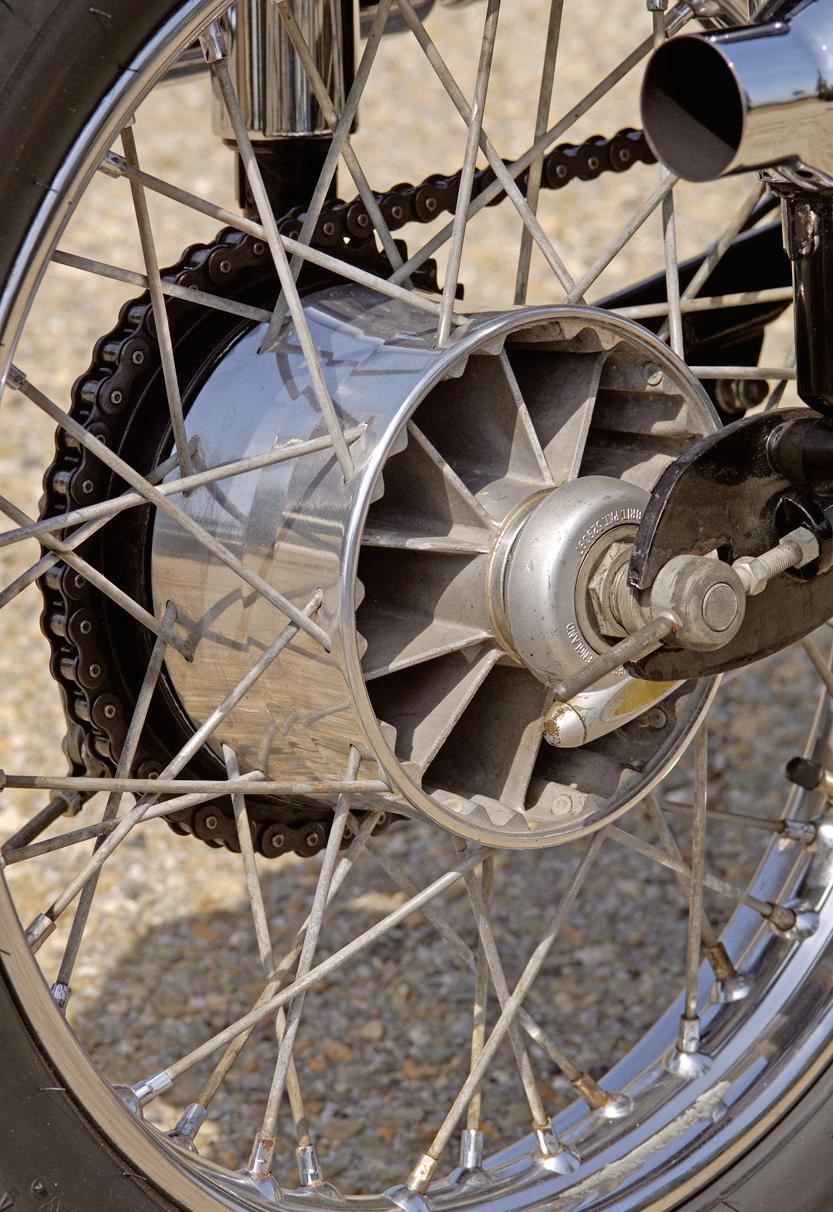
Tires: 3.5 x 9in front, 4 x 18in rear
Weight (dry): 345lb (157kg)
“They were proud people,” Mike Berliner says today. “I don’t have to tell you, just like any manufacturer is proud of their product, they were, too. But if they are smart — which they were — they will adopt any change which will improve the product.”
















Seat height: 32.75in (825.5mm)
Fuel capacity: 2.7gal (10.2ltr)

He continues: “[AMC chief engineer Charles] Udall and [group managing director A.A.] Sugar, they both decided to do whatever
(AMC) could sell best, and this prototype was a machine we thought was going to do good.”
Although Berliner couldn’t recall all of the specific details surrounding the Norton P11 project, he remembers well the Berliner corporate culture, and how the company would support their dealers and their mechanics.

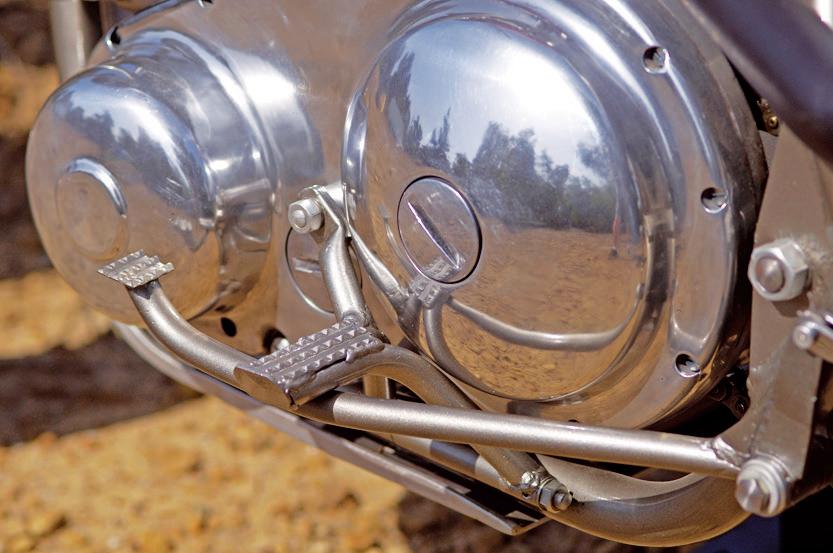
“Any manufacturer who is interested in selling their product is interested in continually improving it, and if there is a suggestion from top mechanics or an engineer that will improve the product — and after they test it out — naturally they will go ahead and put it in production.
“That’s the way we worked with Norton and Ducati and Moto Guzzi; all the same way. You test the machine in the U.S. — there is no better place to test a machine than the U.S. — because the mileage from one area to another is so great. Some American riders are pretty rough on the machine, too.
“And if there is anything wrong you report it to the engineering department, which I did. I was in Italy and in England about every six or eight weeks. If I had a problem, I took the product immediately to the engineering department.”
68 MOTORCYCLE CLASSICS Street Bikes of the ’60s
Prototype used solid foot pegs (upper left) while production P11 had folding units (lower left). Replica has proper conical magnesium rear hub (above left).
As with the original prototype, the replica (above) has no gauges. Both machines use the Norton N15CS gas tank.
Berliner adds: “You listen [to the dealer or the mechanics] and if they have anything to suggest or any concrete information to improve the product, rather than relay the information to the factory you pick up the guy and say, ‘You want to come to Europe with me? Let’s go. You have the suggestion, and you explain it the best way possible.’” That’s pretty much how the Norton P11 prototype came about.
On to production
AMC clearly liked what they were shown, because they pushed the prototype into production quickly. Designated Norton P11, the new bike was launched in 1967, only months after it had been created. There were, of course, changes to the production P11. The Amal Monobloc carburetors were replaced with newer Concentric units, and the Lucas magneto ignition became capacitor and coil. And where the prototype used the solid footpegs from a Matchless G85CS, AMC fit folding footpegs to the production P11. The prototype also used the special magnesium rear hub from the G85CS, while the production P11 used a standard Matchless rear wheel.
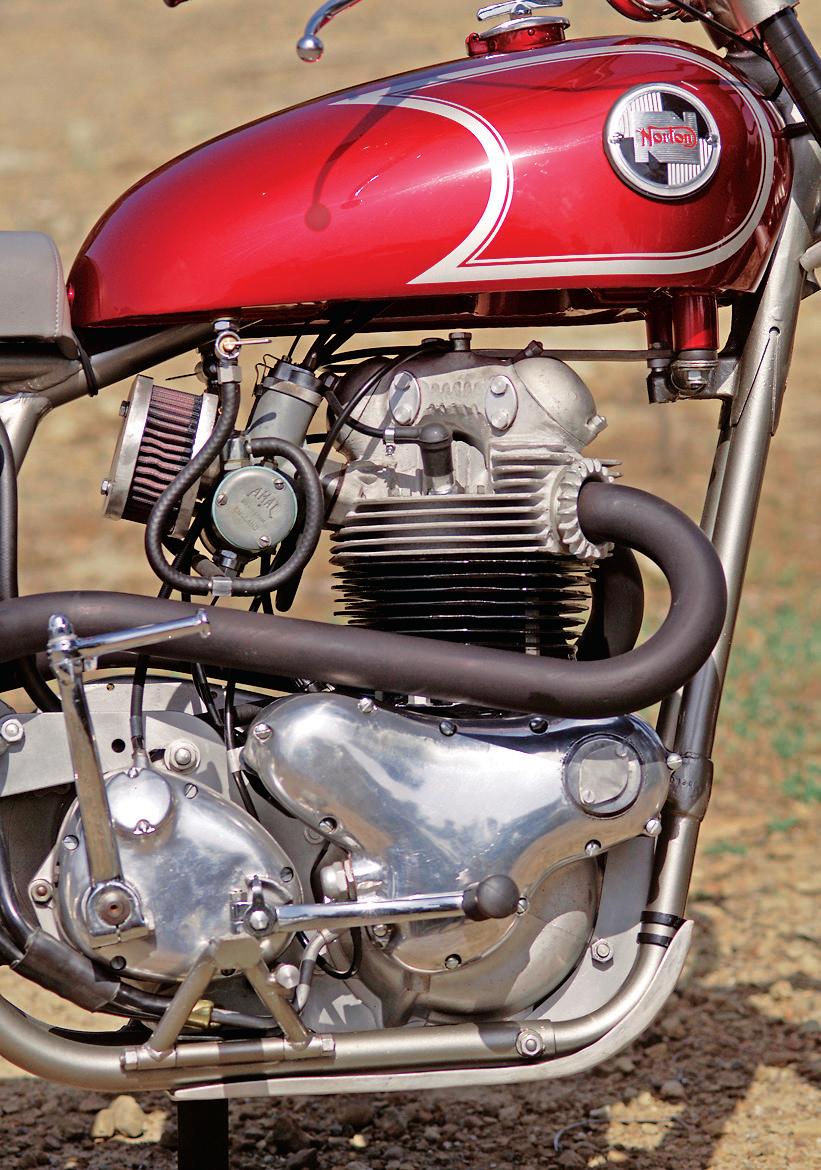
The biggest outward change from the prototype to the production P11 was the addition of lights and instruments. To accommodate electrics the aluminum oil tank was chopped off and a tray for a battery and a cover fitted to the left side of the machine. “Because of the trouble we’d had with the oil tank mounts, Bob (Blair) told AMC not to build it like ours, but they did, only with a part of it missing so they could run the battery,” Zabaro recalls.
In the U.S., the production P11 quickly became the desert racer to have. In fact, a new Norton P11 was presented to racer Mike Patrick, who then proceeded to take the No. 1 plate in desert racing two years in a row with this machine. In all, it is thought some 2,500 P11s and its descendents, the P11A and Ranger 750, were produced before being dropped from the Norton range in 1969.
Recreating the prototype
Bob Blair’s son, Steve Blair, was only four years old when the prototype desert racer was coming together in his dad’s shop. But the legend obviously left an indelible impression, because for years Steve Blair had wanted to faithfully recreate that prototype. And what better way to do that, he reasoned, than to work with the very man who helped build the first prototype?
“When my dad was told [the AMC factory] couldn’t build the bike, he went into the back of the shop with Steve and started to fabricate a bike, and lo and behold, they did it,” Steve Blair says. “The prototype they built became the P11,
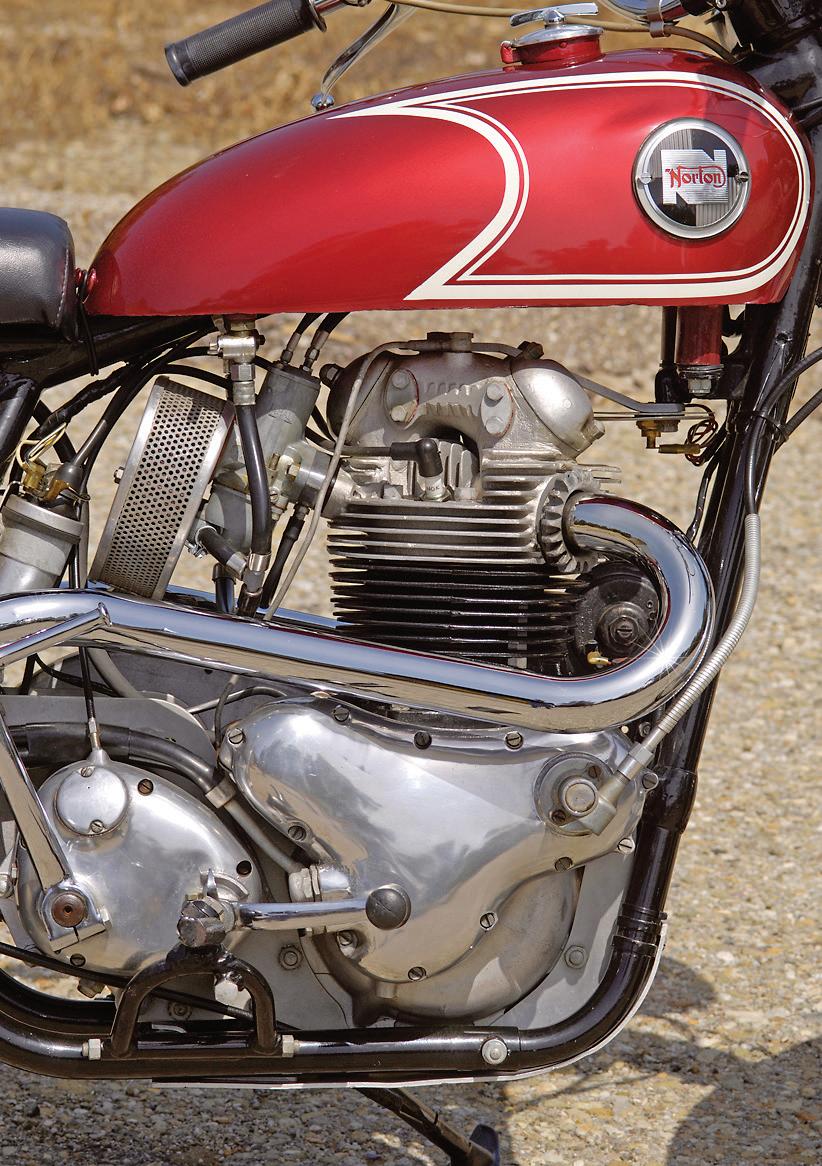
but they didn’t document each and every step of the fabrication process. It was done very quickly.”
Steve Blair and Steve Zabaro are lifelong friends. In 2008, when he told Zabaro he wanted to recreate the prototype Norton, there was no question that Zabaro would help. “He said, ‘Bring it up and I’ll help you do it,’” Steve Blair recalls. “There was no way it could have happened without him — he’s the only person alive who knows exactly how it went together in the first place.”
In February 2009, Steve Blair bought a production model 1967 Norton P11 to use as the platform for his replica. The bike was a San Francisco Craigslist find, a second-owner motorcycle in fine condition. Steve Blair then collected some of the rare bits and pieces that would turn the P11 back into the prototype, including a conical magnesium rear hub, which he sourced from Molnar Precision Limited in the U.K.
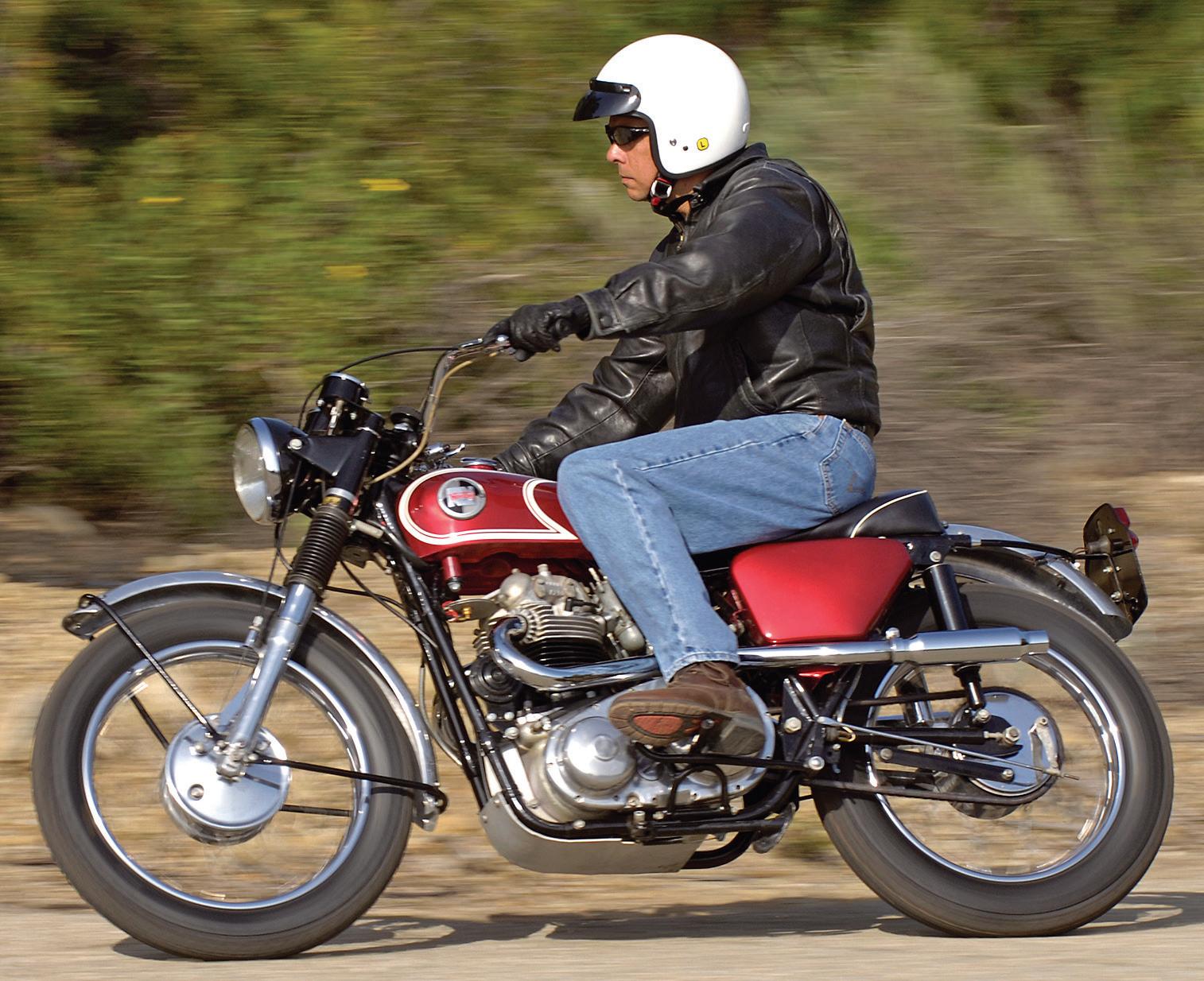
www.MotorcycleClassics.com 69
Owner Steve Blair’s happy to ride his production P11; the replica is off limits.
“Because of the trouble we’d had with the oil tank mounts, Blair told AMC not to build it like ours, but they did.”
Engines are almost identical, but prototype replica (left) has Amal Monobloc carbs as originally used versus the production P11’s Amal Concentrics (right).
Prototype replica or production standard, the P11 is a handsome, aggressive-looking machine — with power to match its brute looks. The stock P11 was one of the great “desert sleds” of the 1960s.
Whatever happened to Bob Blair?
To make the Norton engine like the one fitted in the prototype, he located the correct Amal Monobloc carburetors, not an easy find these days. Ignition had to be by Lucas magneto, and not the capacitor and coils fitted on the production motorcycle. He found the original G85CS non-folding footpegs at Baxter Cycle in Marne, Iowa. “I couldn’t believe Randy [Baxter] had a set of those!” Steve Blair says.
With the P11 donor bike and parts in hand, Steve Blair went to Zabaro’s shop, where the pair completely disassembled the P11 and rebuilt every single component, from the gearbox and engine to the forks and wheels, the front with the correct Akront flanged alloy rim.
Bob


of the Norton P11 prototype, became disenchanted with Norton when Dennis Poore and Manganese Bronze wanted to take over the West Coast distribution of Norton, while leaving the Berliner Corp. on the East Coast.

“That essentially left my dad high and dry,” says Bob’s son, Steve. But Bob Blair wasn’t going to go down so easily.

“Dad had two warehouses, one in L.A. and one in Portland, full of machines consigned to him, along with his parts inventory in Glendale,” Steve says. “He said to Poore, ‘If you don’t buy me out, I’ll advertise in all of the major papers and I’ll sell everything at my cost.’”
Manganese Bronze bought out Bob Blair, but, Steve says, “He was bitter about that, and he was upset with the way the whole Norton thing ended. He never really talked about Norton again, and he just moved on.”
Bob Blair retired from the motorcycle industry in 1976, and died in 1996.
The oil tank was made from scratch to replicate the prototype’s alloy unit that spanned the frame from side to side. Steve Blair started on the tank at home, but finished it at Zabaro’s shop under Zabaro’s instructions. Removing the mufflers from the Norton P11 exhaust pipes brought the tubes close to what the prototype ran — straight pipes without a baffle. The frame was painted the silver of the Matchless G85CS, and various items were chrome plated. All told, building the prototype took about four weeks.
“I wanted to recreate what my dad and Steve created, and then tell the accurate story about the P11,” Steve Blair says, adding, “And I wanted the recreation to be as accurate as possible. For example, I could have used another rear hub, but that wouldn’t have been right. That comes from my dad — he was a real black and white guy.” For Zabaro, the project brought back memories of working beside Steve Blair’s dad at ZDS Motors. Like most people who shape history, back in 1966, he had no sense that he was doing anything noteworthy.
“I was running the parts department, and when I could catch a moment I’d do something on the project — it really wasn’t that difficult to do — it was just making up your mind to do it. But I didn’t have any sense of it being historic.
“Even at the time, I realized what we were doing was building a dinosaur. The P11 has to be the last heavyweight scrambler designed and built. Lightweight and competitive Huskys and CZs were already here in Southern California,” Zabaro says.

And that, we think, should set straight the record on the Norton P11. MC

 Blair, co-creator
Bob Blair samples the prototype Ducati Apollo at ZDS Motors, December 1964.
Blair, co-creator
Bob Blair samples the prototype Ducati Apollo at ZDS Motors, December 1964.
70 MOTORCYCLE CLASSICS Street Bikes of the ’60s

















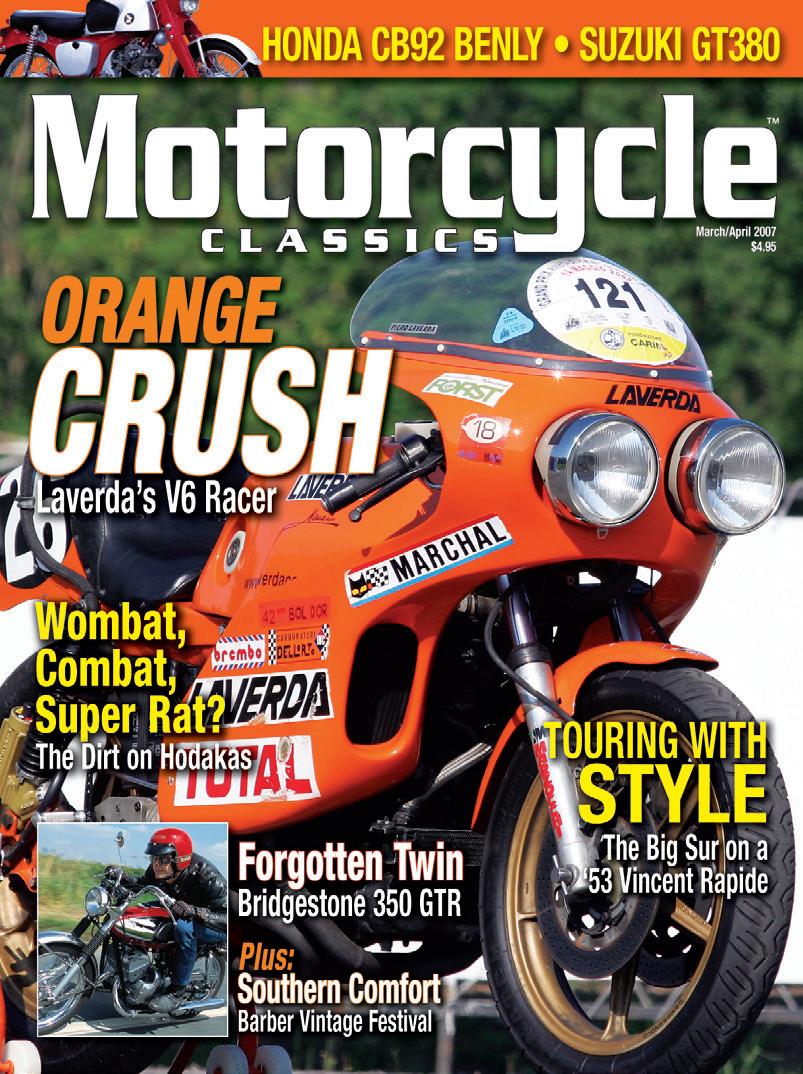



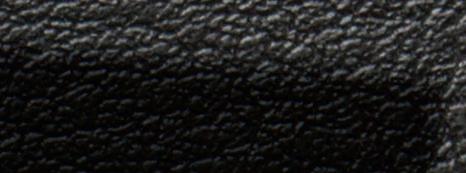








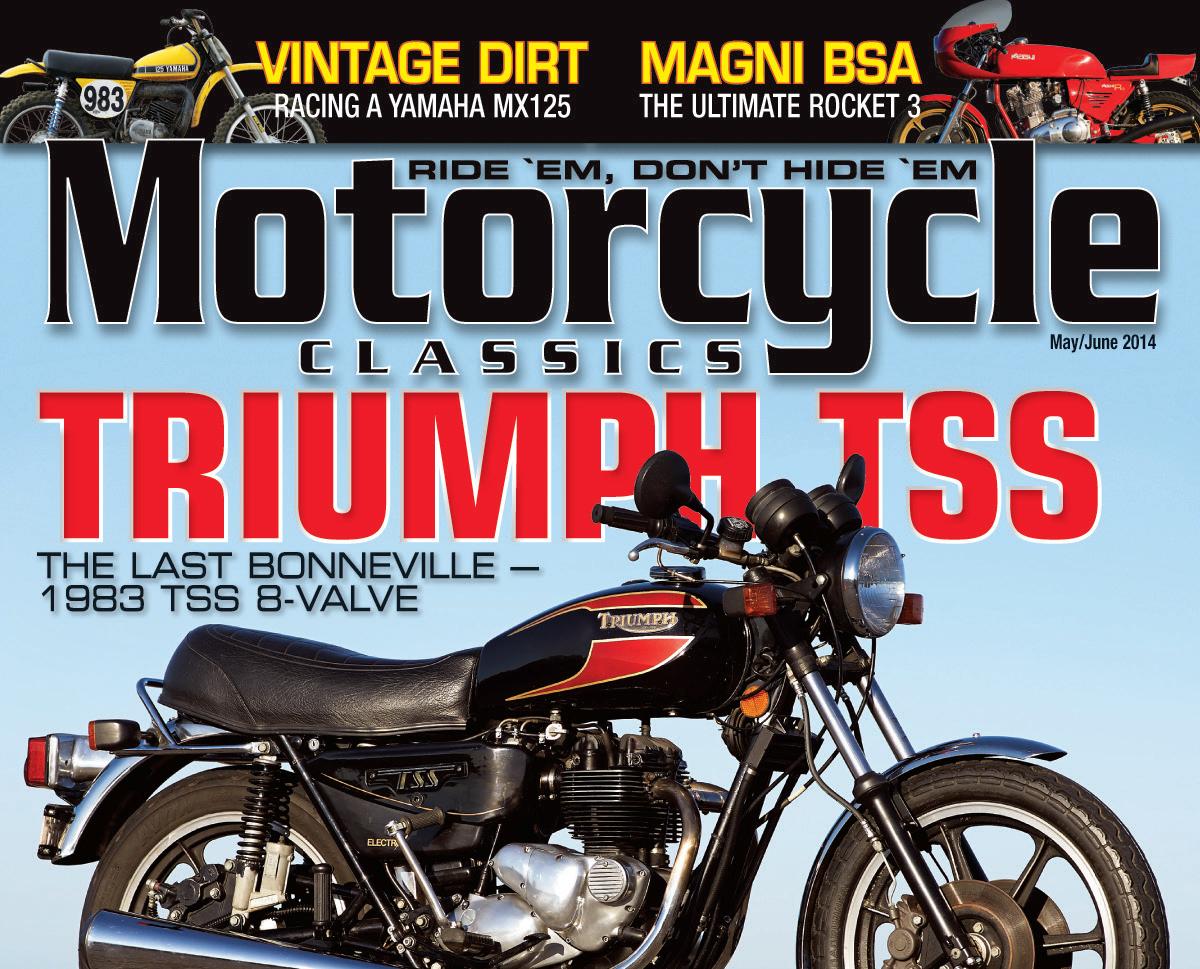

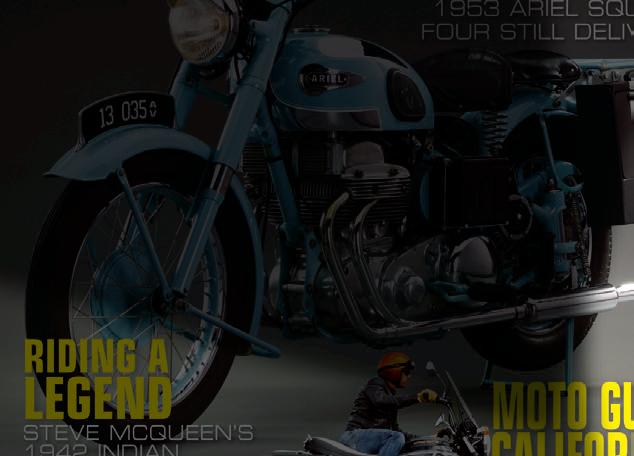











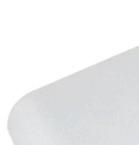
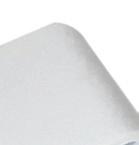





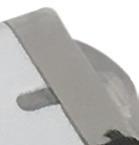
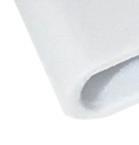
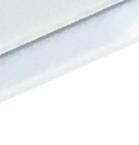
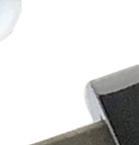
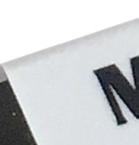
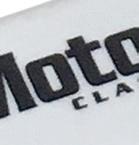

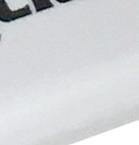


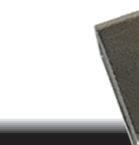
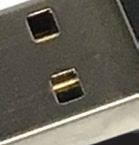








MOTORCYCLE CLASSICS ARCHIVE 2005-2016 USB DRIVE Bringing you the most brilliant, unusual and popular motorcycles ever made … delivered on a flash drive that plugs into the USB port on your favorite device. Whether you’re interested in a particular manufacturer or repairing a specific part, use our search function to bring up all of MotorcycleClassics ’ relevant content! For collectors and enthusiasts, dreamers and restorers, newcomers and lifelong gearheads, we have you well covered. ORDER TODAY! Call (800) 880-7567 or order online at www.MotorcycleClassics.com/Store Mention promo code MMCPAHZ1 $25 ITEM #8152 Price does not include shipping and handling. Includes 2016 Content!
ON THE HUNT

1969 Kawasaki
Story by Margie Siegal

BBRRACK! The pleasant background murmur of an old bike swap meet is suddenly drowned in a haze of 2-stroke noise and exhaust. Someone’s just fired up their Kawasaki triple, and while some folks cover their ears and curse the machine and its owner, others step over to see the bike.
Kawasaki 2-stroke triples seem to be polarizing machines, the object of intense hatred or intense love. Hans Agren loves them, noise, blue smoke and all. He was just 17 when he saw his first H1. When he was growing up in Sweden, a motorcycle was transportation, something you got to school or work on, weather permitting. The H1 was different. It was fast and antisocial, and just what a young man wanted.
Hans had some savings, and he found someone selling their H1 just six months after buying it. “I don’t know why they were selling it,” Hans says. “Maybe it was too fast, or maybe they needed the money.” Swedish law at the time forbade teenagers under 18 from owning 500cc motorcycles, but Hans finagled his way around that little detail.
Hans and his buddies were into drag racing, which was highly illegal, of course. One night the police showed up while they were racing. “The police stopped their car and came running. I took off and hid the bike in my father’s garage. Then I walked back to where my friends were. When I showed up two hours later, my friends were glad
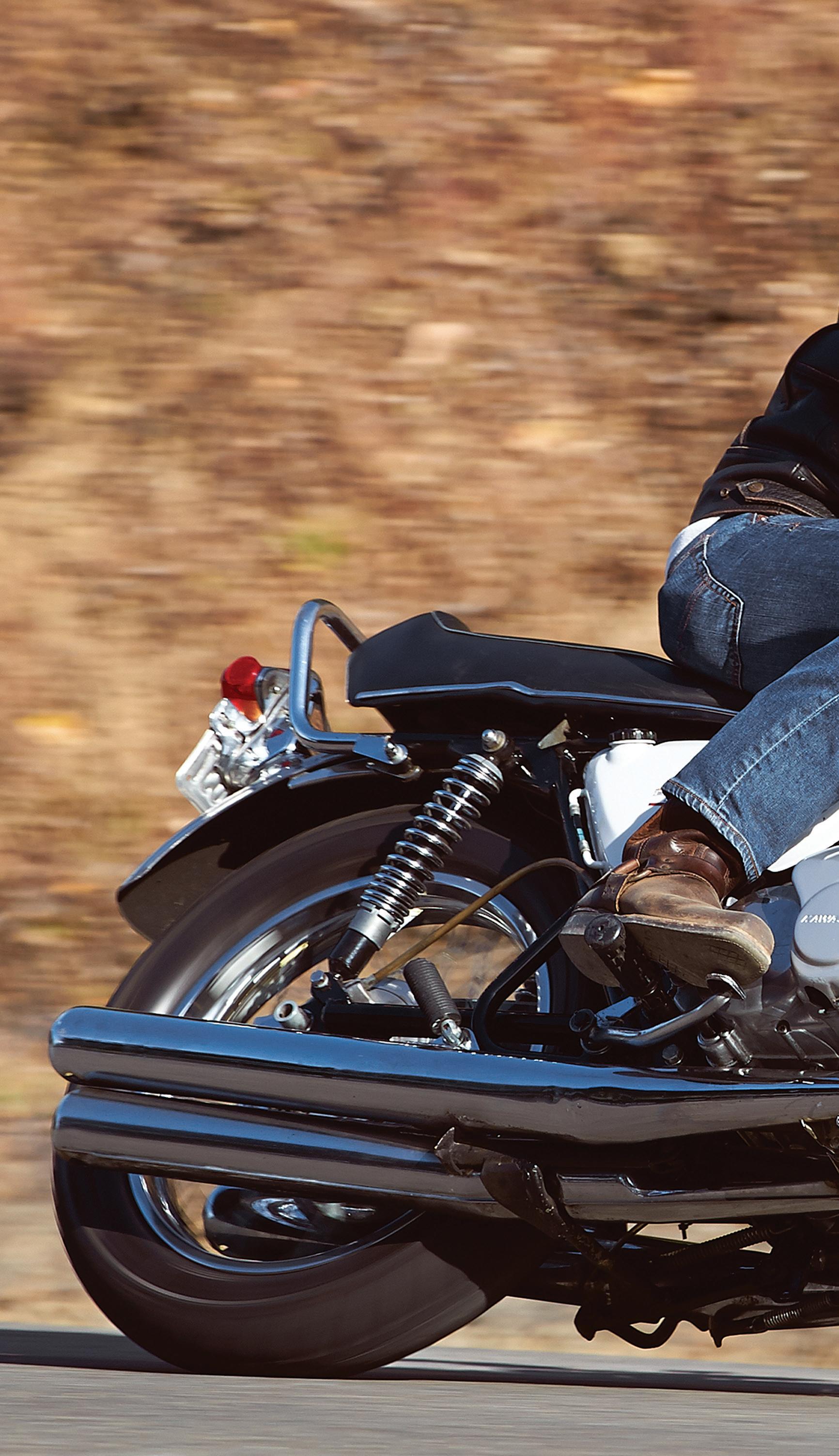 Photographs by Nick Cedar
Photographs by Nick Cedar
72 MOTORCYCLE CLASSICS Street Bikes of the ’60s

to see me. They had been worried. The police had run back to their car, but all you could see was the smoke from my exhaust. There was no way they could have caught me.”
H1 beginnings
















Kawasaki, the manufacturer of this ode to speed and bad behavior, was an old Japanese ship and bridge building company that had the misfortune of ending up on the losing side of World War II. With the abrupt ending of its war contracts, its factories had a lot of extra space. Management, looking around for something to do, decided to start motorcycle production. The country’s transportation system had been destroyed, and people needed inexpensive transport, so small motorcycles, scooters and mopeds were very
popular. Kawasaki started making two wheelers through its Meihatsu subsidiary, and, in 1960, they bought Japan’s first successful motorcycle company, Meguro, and merged it with Meihatsu. Following this, the first motorcycles bearing the Kawasaki name appeared.

Other Japanese factories were capitalizing on the export success of Honda,
This bike’s twin-leading-shoe drum front brake looks stock, but has been upgraded internally (far left). The 3-into-3 exhaust uses two mufflers on the right side and just one on the left.
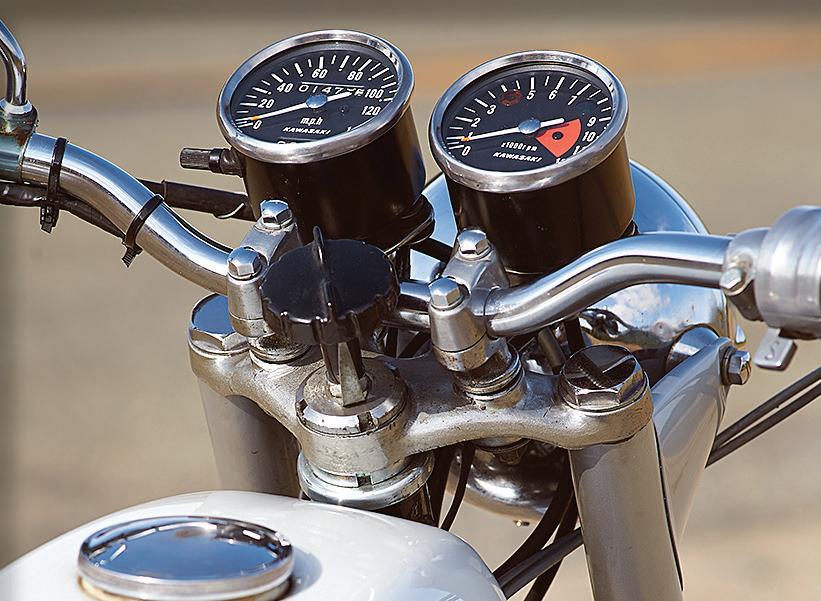
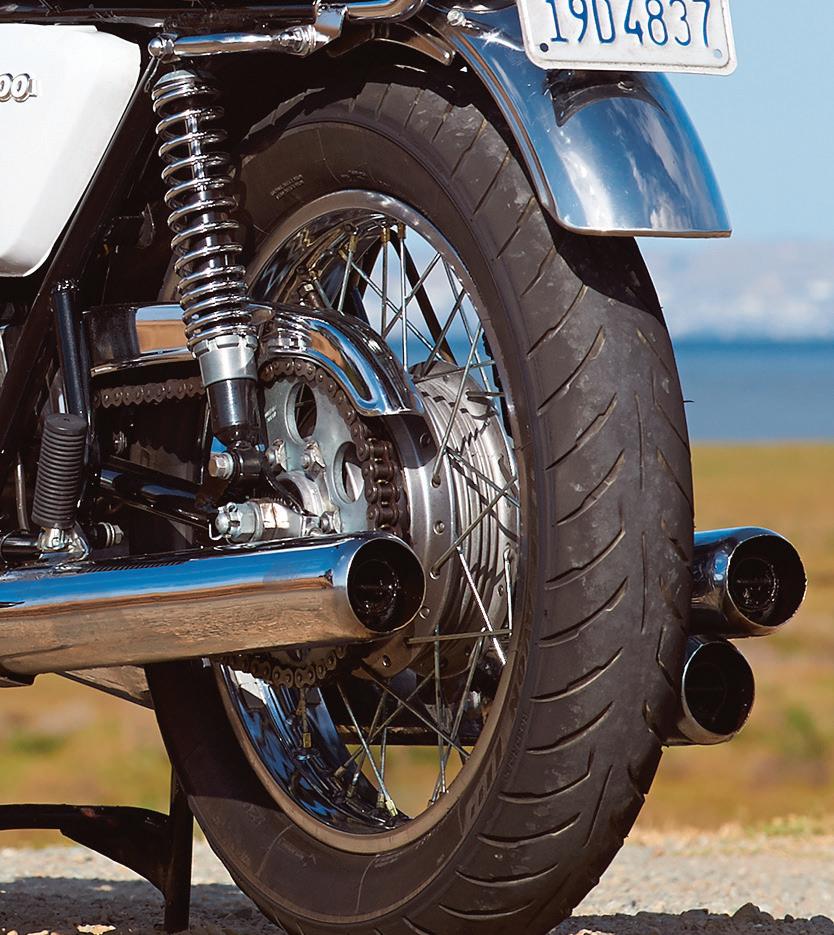

and Kawasaki decided to follow suit. Their 2-stroke singles sold well in America, and Kawasaki felt it was in a position to challenge Honda. The heavy industry sector of the company was again doing well, and management decided to use the deep pockets it provided to finance the motorcycle subsidiary, which was Kawasaki’s only consumer division.
Kawasaki’s engineers started developing three very different engines: a 750cc 4-cylinder 4-stroke intended to debut in 1970, a 500cc 2-stroke twin that was basically a larger version of its 250cc and 350cc 2-strokes, and a new piston-port
1969 KAWASAKI H1
500cc triple. Prototypes were built, and the triple was found to be lighter and faster than the twin. At the same time, Honda brought out its CB750 Four, a sensation and, in fact, very similar to Kawasaki’s 4-cylinder prototype.
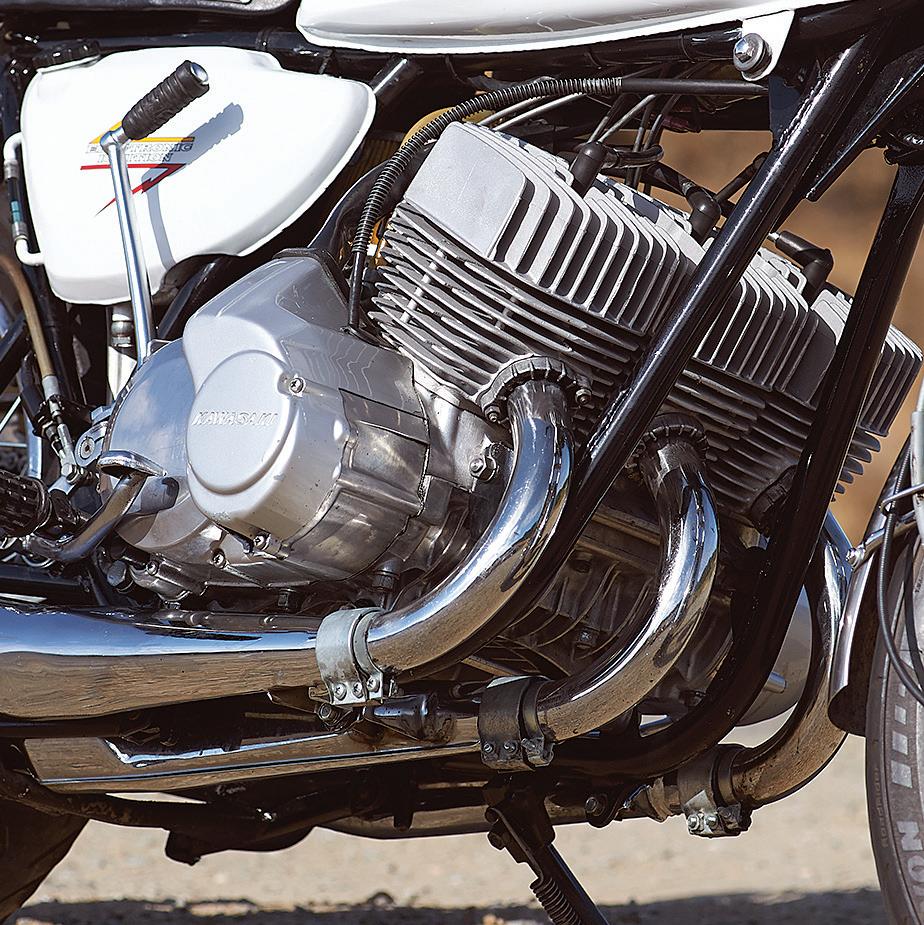
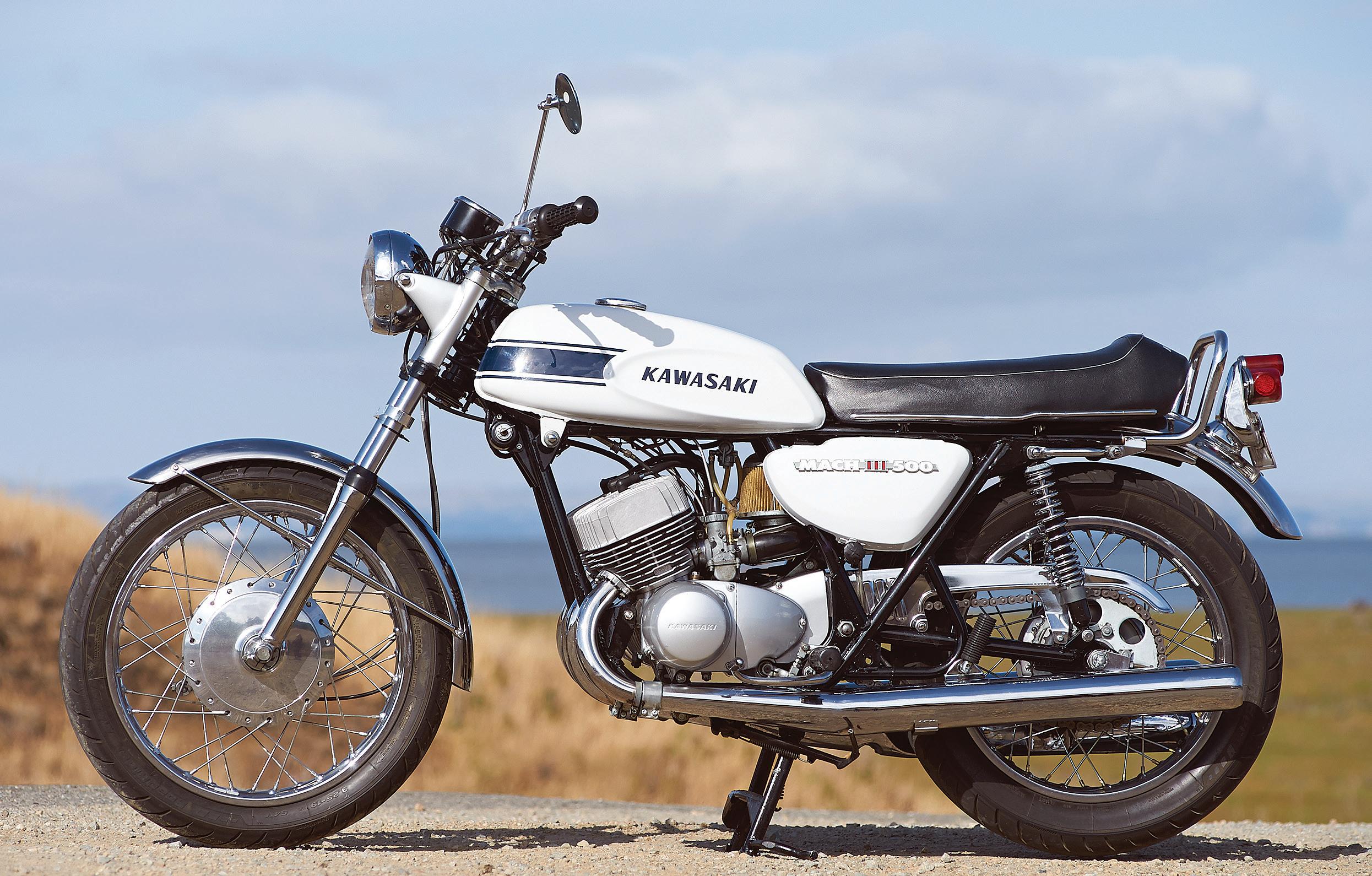
Kawasaki’s engineers were ordered to keep working on the 4-cylinder until they had something that was clearly different and superior to the CB750. On the other hand, a 3-cylinder 2-stroke was an exotic and unusual engine configuration in 1969, and therefore excellent for the brand recognition Kawasaki wanted. Kawasaki shelved the twin, put off the debut of the 4-cylinder and went with the 3-cylinder 2-stroke. To ensure the company tapped into the youth market, the triple, badged the H1 Mach III, was list priced for $1,000 — a bargain even in 1969. Overnight, the old, staid company became the source of young men’s dreams.
“Kawasaki’s new 500 has got to be the kinkiest street bike ever,” crowed the April 1969 edition of Cycle World
For its time, the H1’s engine was pretty incredible, with silicon-aluminum alloy cylinders with cast-in iron liners, extensive and complex finning, oil injec-
tion, electronic ignition, aggressive porting and expansion chamber mufflers. All that added up to 60 horsepower at 8,000rpm, delivering a 12.8-second quarter-mile with a 99.5mph terminal speed and an advertised 125mph top speed. Unfortunately, the tender loving care with which the engine had been developed did not extend to the frame, forks and brakes.
Cycle ran a seven-bike Superbike
Shootout in its March 1970 issue, with the H1 naturally included. The drum brakes, which have received a lot of criticism over the years, were for the first few passes in Cycle’s tests secondbest behind the Honda CB750 with its front disc brake. Unfortunately, they started fading after repeated hard stops. Testers also found the H1 frightening to ride fast on bumpy curves. “It pitches and mini-wobbles,” they said. The rear shocks were considered inferior and ground clearance was less than other fast bikes. As it had in the Cycle World test, the H1 shone in the quarter-mile, with an elapsed time of 12.81 seconds and a terminal speed of 104.4mph. It was the third fastest, and the smallest of the bunch.
Making it better
Kawasaki quickly came up with a production racer, the H1R, with an improved racing frame, better forks, better ground clearance, 75 horsepower and a claimed top speed of 150mph. At a cost of less than $1,500, and with contingency money dangling, the fast boys at tracks all over America lined up at dealerships.
The H1 also quickly attracted controversy. It was noisy, blew
www.MotorcycleClassics.com 75
The 498cc air-cooled 2-stroke triple made a claimed 60 horsepower at 8,000rpm.
blue smoke, and the kind of people who wanted to ride it were also the kind of people, like Hans, who got into trouble on motorcycles. The handling problems and the fade-prone brakes did not help matters. Kawasaki, concerned about bad publicity and liability lawsuits, started to back down. Increasingly, the beast was tamed.
For 1970, the frame and suspension were improved, and the ignition cover was redesigned to make the ignition more watertight. More extensive changes appeared in 1971. The front forks were more heavily damped, the rear shocks were improved and the electronic ignition, which often failed on the 1969 version, was updated. Unfortunately, the brakes still faded
badly. A side effect of a more efficient, quieter and less smoky engine was that quarter-mile times were no longer in the 12s. A smaller 350cc version of the H1, reputed to have better handling, appeared in 1972, the same year the 500 finally got the front disc brake it had been crying for since its debut. The H1’s quarter-mile times, however, moved further up into the 13-second column. Kawasaki also gave up on the electronic ignition and replaced it with a conventional breaker points system.
At the same time that some young people were worshipping at the altar of speed, others were becoming more and more concerned with the environment, and the environmental contingent was getting the government’s ear.
Emissions controls and decibel limits loomed on the horizon and Kawasaki, finally satisfied that its 4-stroke 4-cylinder was a worthy opponent for the Honda CB, introduced the very fast yet also very civilized 903cc Z1 in 1972.

2-stroke fans
Despite the success of the Z1, a lot of people liked the 500 triple and were upset when it went out of production in 1975, just ahead of legislation that mandated emissions standards that the triple could not meet. Kawasaki Triple clubs were started by enthusiasts worldwide in 1979 when parts sources started to dry up, and they are still going strong. There are Triple clubs in Canada, Australia, the U.K., Italy,
76 Motorcycle classics Street Bikes of the ’60s
Netherlands, the U.S. — and Hans’ home country of Sweden. “Enthusiasts from around the world dedicated to the preservation and ritual flogging of the infamous Kawasaki 2-stroke triples,” as one forum (kawi2strokes.com) proclaims.

Meanwhile, Hans Agren rode his H1 to school. He rode it on trips to Norway. He repainted it. And he eventually traded it for a more comfortable, more reliable and more boring Honda.
“It wasn’t as powerful as the Kawasaki,” Hans remembers. The Honda was sold and bikes were shelved for a while. Hans moved to the U.S. in 1982 and bought a Honda XL in 1984, which, unfortunately, was stolen. He started to export bikes, mostly Gold Wings, from the U.S. to Sweden, and bought a Honda Hawk and a Ducati with the profits. And in the back of his mind was the thought of his first love, the H1. About 10 years ago, he decided to start looking for one.
On the hunt
1969 H1s are not easy to find. Their raucous character meant they suffered a lot of abuse, and most of the thousands manufactured by Kawasaki didn’t survive the Seventies. Hans put an ad in a magazine, and someone called him — two days before a scheduled trip to Sweden. The owner tried to organize a bidding war between Hans and another wouldbe buyer. “I gave up and got on the plane,” Hans says. After that, things went dry for a few years.
Finally, two years ago, a 1969 H1 in bad shape came up on eBay. At this point, Hans had been looking for years, with no results, so he swallowed hard and bought it. “I’ve been restoring it since then.” He got the bike running, but it was not reliable. “I wanted to trust it, and not be worried I would be stuck somewhere,” he says, “but I had to be picked up a couple of times. Then I blew up the engine.” The engine was a mess, but David Singleton, a Tesla engineer, helped Hans rebuild the crankshaft with better bearings
and modern seals and upgraded the electronics. He also helped with the transmission and rebalanced the crank to cope with the lighter weight of new high-tech connecting rods. The engine is now reliable — and very fast.
Hans has not just been restoring the H1, but has also been doing development work on the suspension, ignition and brakes, work that Kawasaki didn’t bother with when they introduced the bike. “I wanted to keep the bike stocklooking,” Hans says. But the chassis
Hans spent a lot of time working on the front forks to make them work better. He bought a fork brace on eBay, installed stiffer springs and used heavier fork oil. He also went to tapered bearings in the triple tree so the fork assembly would have a more positive association with the frame.
Now that the bike is set up, maintenance is minimal. Hans rides the bike two or three days a week for short jaunts, and has racked up 2,000 miles on it so far. The carburetors have stayed in tune, and the bike idles nicely. Being a 2-stroke, there are no valves to adjust, but the heads will be removed every 5,000-10,000 miles to clean the combustion chambers. “You know when it is time,” he says. “The bike stops running properly.”
only appears to be stock: Hans has built a stealth Kawasaki triple, one that takes corners as well as burns up drag strips.
Vintage racers told him about a firm called Vintage Brakes in Sonora, California. “The guy told me I should send him the hubs and it would take six months.” Six months later, the brakes were back. “It was like night and day,” Hans says, adding, “the brakes are now way better than stock.” The Hagon shocks look stock, but unlike the original units, they actually work as advertised.
“For an old bike it is very quick,” Hans says. “It is very light, and I have gotten used to the flex in the frame. I can keep up a pretty good pace with this bike. There is no engine braking and there is no power under 5,500rpm — you use both brakes and keep the revs up in turns.”
When I spoke with him, Hans had just returned from a ride, smoking a Ferrari on a back road north of San Francisco where he lives. “It’s never too late to have a happy childhood. It was enjoyable to restore the bike and it is total satisfaction to ride it. It’s fun. I can give a lot of people trouble with it.” Somewhere, someone’s probably cursing Hans — while three others are watching with jealousy. MC

www.MotorcycleClassics.com 77
A fork brace, stiffer springs and thicker oil in the front forks help the front end behave better. New rear Hagon shocks look original, but actually work, unlike the stock units.
“When I spoke with him, Hans had just returned from a ride, smoking a Ferrari on a back road ...”
PAST PERFECT

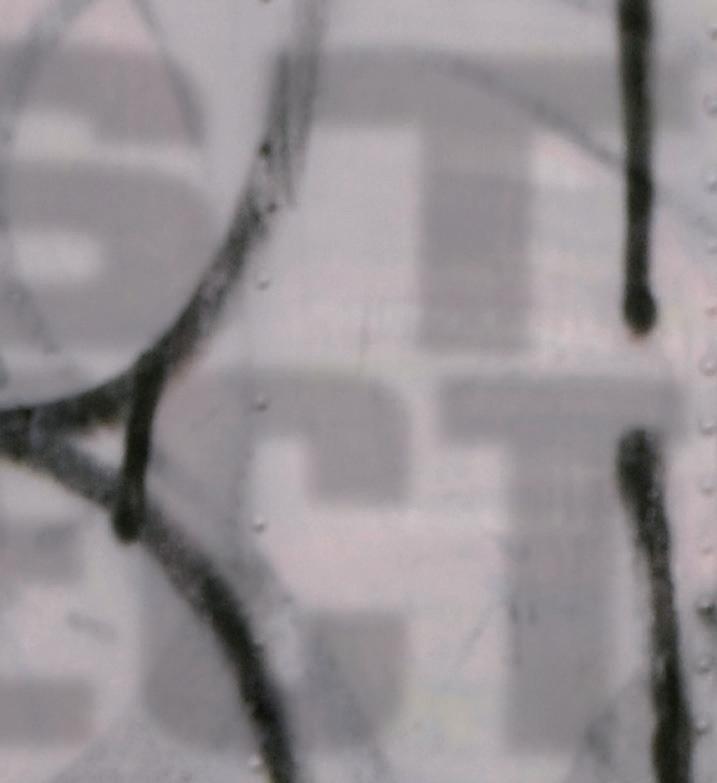


Moto Guzzi V700 Special

In our back to the future world, everything old looks new again. Cool bikes from the past are hot, and retro has become the new “new.”
Some credit must go to Honda for their recasting of the classic British racing single with the 1989 Honda GB500. Triumph and Kawasaki picked up the theme with their retakes on the traditional British twin (Bonneville T100 and W650, respectively), and Ducati upped the ante with their Sport Classics. Honda aped their iconic CB750 with the CB1100, and Guzzi’s flashback V7 Specials and Racers have been flying out of showrooms.
All of this is well and good: The classic bikes of our misspent youths are recreated so another generation can enjoy them. Inevitably, though, these reprised rides lack what we misty-eyed geezer bikers are wont to call “character.”
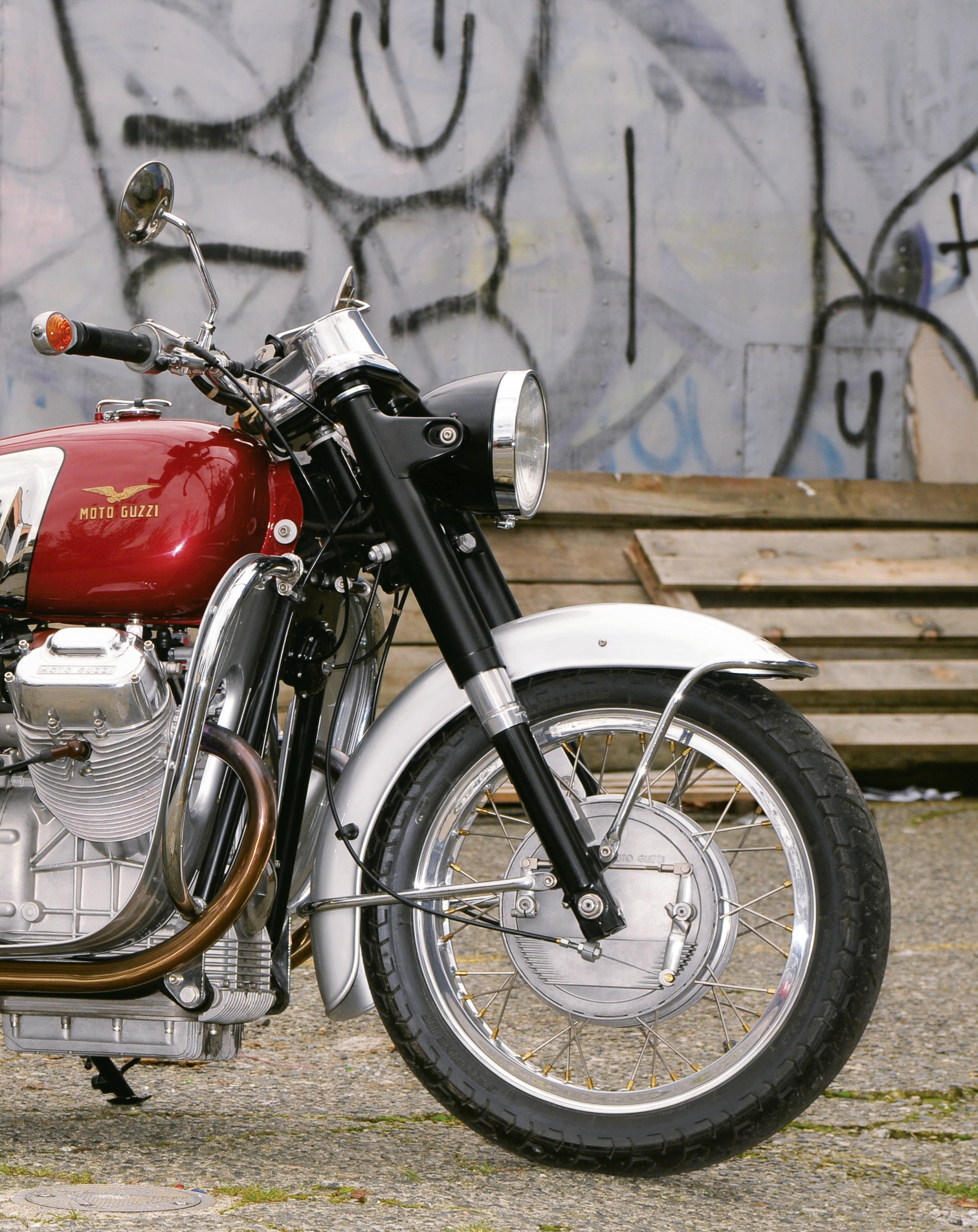
With fuel injection, liquid cooling, solid-state electrics, precision steering and suspension, the intimacy





















 geezer
Story and photos by Robert Smith
geezer
Story and photos by Robert Smith
between man and machine has waned, the relationship more distant. The starting rituals, unplanned roadside maintenance and mysterious malfunctions are mostly a thing of the past. Some would applaud that. Motorcycles were ornery back then: Now, most have as much character as a dishwasher. So what if

you could take a classic motorcycle, and without changing its soul, bring its reliability and functionality fully up to date — retaining its essential character while consigning any orneriness to the trash can?

















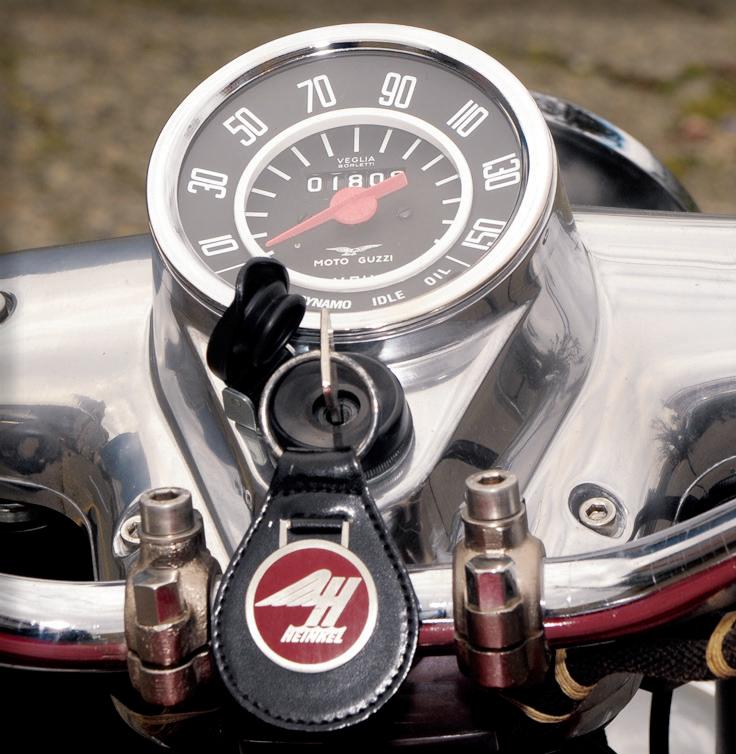
That’s essentially what dedicated Guzzista George Dockray has done for the Mandello maker’s first V-twin, the 1967 model V700.



Three becomes two Moto Guzzi’s 700cc V-twin (actually 704cc) traces its roots to the Mulo Meccanico, a three-wheeled, threewheel-drive military vehicle designed to go just about anywhere. The rear wheels could be fitted with short tank tracks for extra grip, and the powered front wheel could literally almost climb walls. Guzzi’s Giulio Cesare Carcano designed the Mulo and its engine — an air-cooled 90-degree V-twin with
In spite of its rather industrial appearance, the engine found a ready home in Carcano’s next project. A touring motorcycle, it would be the largest capacity motorcycle Guzzi had ever built, all its previous road machines having been singles. Yet a growing awareness of the huge market
overhead valves.
80 MOTORCYCLE CLASSICS Street Bikes of the ’60s
MOTO GUZZI V700 SPECIAL
Above: The wiring harness was remade from period cloth-wrapped wire, and it’s all laced together using waxed linen cord; the bike retains the original switchgear. Top right: The period legshields were standard on police and military bikes.
Another view of the V7’s leg shields, which help keep the rider warm and dry.
for big bikes in the U.S. was leading several Italian companies like Laverda, MV Agusta and Ducati to build bikes in the 700ccplus category.
One of the attractions in the U.S. was the huge market for police motorcycles, as anti-trust laws required police forces to garner bids from more than one supplier. It was in seeking to exploit this opportunity that Berliner Motor Corporation sponsored Ducati to build the then-outrageous 1,200cc V4 Apollo in 1961. (At that time, all proposals had to have an engine capacity of at least 1,200cc, roughly matching the 74-cubic-inch engine size of the Harley FL, then the enforcement branches’ mainstay.)
Whether brothers Joseph and Michael Berliner similarly influenced Guzzi’s management to build the V7 or whether they simply recognized the potential of the big bike (the more likely reality) is moot. Whichever way it happened, the police versions of the 750cc Ambassador of 1970 and the 1972 850 Eldorado sold to U.S. police forces at a rate of up to 5,000 a year.

To create the V7, Carcano mated the Mulo engine to a 4-speed transmission through a dry single-plate, enginespeed clutch with final drive by a shaft that made up one fork of the swingarm rear suspension. The powertrain slotted into what has since become known as the “loop frame,” a dual downtube structure that cradled the big twin, its lower tubes running alongside the oil pan. Electric power was provided by a car-style alternator sitting between the cylinders and driven from the crankshaft by a belt. Spoked wheels with drum brakes completed the specification. The V7’s styling was certainly
intended to satisfy American tastes, with deeply valanced fenders, crash bars and a handsome, cast-alloy speedometer housing. With 50 horsepower and a dry weight of 500 pounds, it was comfortably inside the performance envelope of its U.S. competition, and sold well. As Guzzi aficionados’ T-shirts proclaimed, it was a V-twin “done right.”
45 years on
“I was attracted to the loop frame bikes because they had this very stolid kind of look,” says George Dockray, the owner/ builder of our feature bike. “And I really liked the very first model, the V700 with the red paint scheme. It was a little different from the later models. I thought it would be fun, but being the first model, they had a lot of things that didn’t work so well.”
What made the project possible and facilitated the upgrading process that George undertook was the commonality and interchangeability of Guzzi V-twin parts. “They took the same basic rig — engines, frames, gearboxes — and made it into all kinds of multi-role machines, from a cop bike to a road racer, with basically the same platform,” George says. “The engines didn’t really change that much, so you could make a much nicer motorcycle out of what would look almost indistinguishable from the original 1967.” For example, it’s easy enough, George says, to take any later round-barrel engine with a 5-speed transmission and drop it into the earlier loop frame. Similarly, the front engine cover from the earlier external-alternator bikes will bolt straight on to an engine
www.MotorcycleClassics.com 81
“The V7’s styling was certainly intended to satisfy American tastes.”
from one of the later Lino Tonti-framed bikes, like an 850T, Le Mans or 1000SP.
In the loop
George’s project inevitably started with a loop frame. All the loop frame bikes used a similar chassis, and George assumes his, first registered in 1973, came from a police Eldorado. “I had to saw off the siren bracket that used to be on it,” he says.
After lengthy searches on eBay and help from author and Guzzi guru Greg Field, George was finally able to track down the necessary parts to assemble a complete bike.
Among the items George particularly wanted to update were the front fork and front brake. The original fork used a single-acting damper rod, which was pretty crude in operation, but some machining of the internals allowed fitment of a cartridge damper unit from a California-series Guzzi. He also modified the fork legs by welding on lugs to locate the locking plate from a Guzzi double-sided, twinleading-shoe brake. That welding led to distortion of the legs, which meant more work, but it was worth it: George describes the original V700 brake as “horrible,” while the four-leading-shoe unit works much better. Thanks to the improved suspension, the difference in the ride compared with other loop frame Guzzis is “like night and day,” George says.
The engine in George’s bike originally powered a 1000 Convert, Guzzi’s “automatic” transmission cruiser. The engine has been upgraded with a Megacycle cam and now breathes through 36mm Dell’Orto pumper carbs, but uses stock size Black Diamond valves fitted with lash caps for long-term durability. George used the earlier single-breaker distributor, which again was an easy “mix ‘n match.” An oil sump extension increases oil capacity to help carry away heat.
The engine drives through a stock 5-speed Guzzi clutch and geartrain (from a California II) to a V7-type shaft drive, but the U-joints and carrier bearings have been upgraded to the spec used on later disc-brake bikes. George wanted to use the “pumpkin” rear axle casing from an Ambassador, but the Ambassador’s gearing was too low. Once more, interchangeability of Guzzi parts meant George was able to use the pumpkin housing he wanted, but with a later helical gear set for a higher final drive ratio.

The electrical system was upgraded with a Nippon Denso alternator intended for a forklift, while George used his skills as an aircraft mechanic to craft a new wiring harness using period cloth-wrapped wire from Rhode Island Wiring Service. And instead of taping or shrink-wrapping, cables are laced together using waxed linen cord. Fuses are eschewed, with power
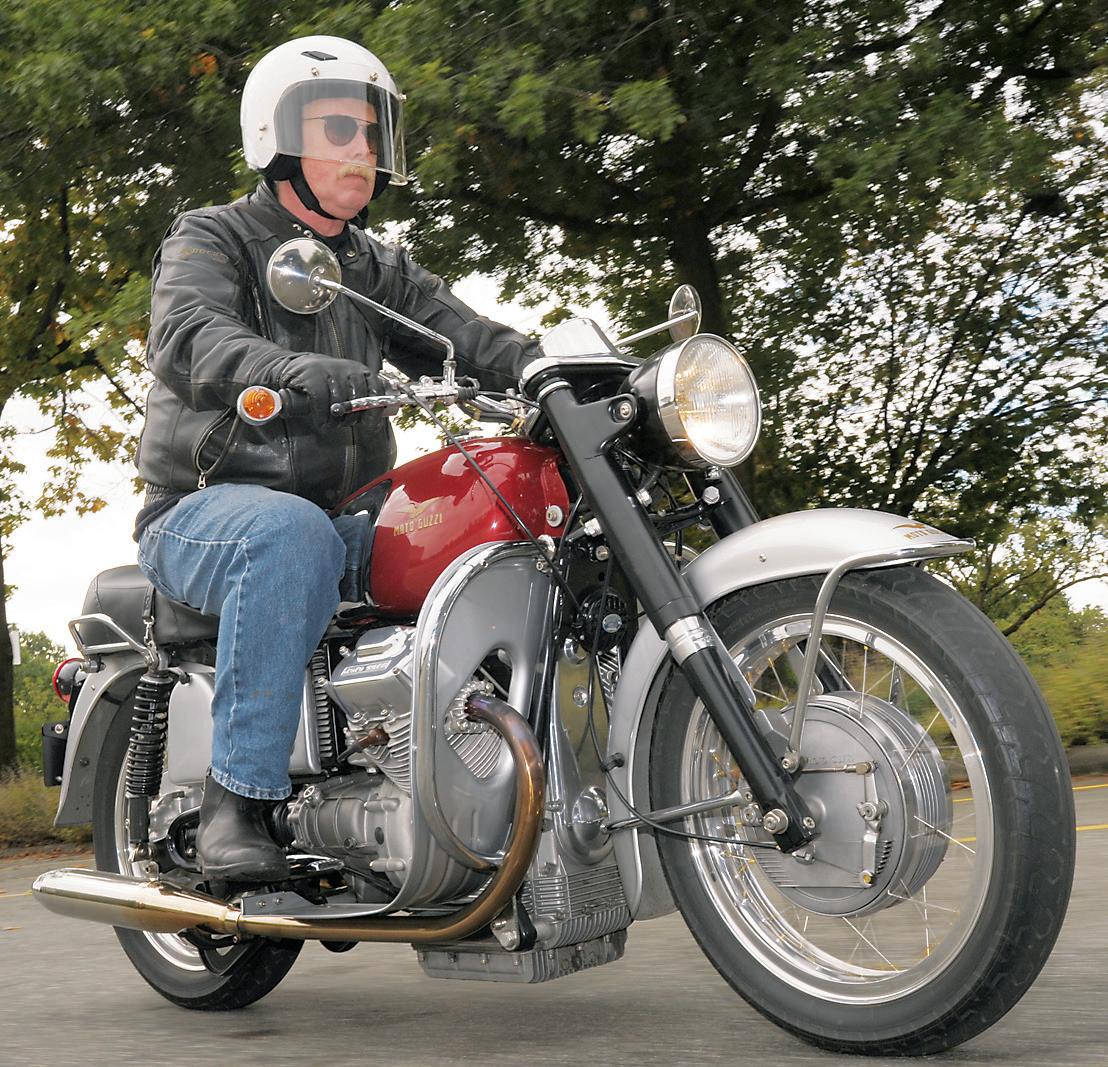
82 Motorcycle classics Street Bikes of the ’60s
Owner and builder George Dockray aboard his creation. “It has way more power than a stock Guzzi,” he says.
distribution and circuit protection handled by a MotoGadget M-Unit circuit monitor and electronic breaker. If a short occurs in any circuit, the M-Unit senses the problem, tries to reset the circuit, and if the problem persists, leaves the circuit open, triggering a warning light on the dash.
George’s biggest challenge here was retaining the original switchgear while meeting the circuit requirements of the M-Unit. “Under the tank there’s a whole rack of relays just to accommodate these switches,” George says. The M-Unit also incorporates an immobilizer and alarm, taillight modulator, adjustable fade-in/fade-out for the turn signals, and a host of other features.
George didn’t have to worry about any corrosion issues with a rusty old steel gas tank; he was lucky enough to find a new-old-stock V700 chrome tank on eBay. The leg shields were standard equipment on police and military bikes, and were also available as a factory accessory for civilian customers. In George’s case the crash bars, leg shields and footpegs with mounting brackets came from Greg Field. Pretty much everything else is stock Guzzi — and the Hella bar-end turn signals complete the period look.
Riding George’s V700
The Loop Frame Project bike is George’s third custom Guzzi, the two previous machines being café racers (the March/April 2011 issue of Motorcycle Classics featured one of them). So this
time, the emphasis was on streetability.
“It has way more power than a stock Guzzi, and it has wonderful low-speed handling,” George says, adding that even though the Megacycle cam is pretty lumpy, “the performance is pretty docile. You can be real lazy with it, you can just putt around, even with the 36mm carburetors. And if you’re on the highway and want to pass a couple of motor homes, just grab a handful … ”

George also points to the bike’s superior ride, due at least in part to the Ikon rear shocks he fitted, which he prefers to shocks he’s used on past project bikes. Handling and braking are also first class, George says. “It’s very stable. And you won’t outride the tires before you start dragging all manner of stuff. The first thing that hits ground is the centerstand.”
The four-leading-shoe front brake also works well. George wanted to retain a drum brake, even though the Eldorado gained a disc during its production run. The drum certainly complements the period look. “It’ll stop you pretty damn fast. But you really have to pull on it,” George says.
The finished project draws stares of admiration everywhere it goes, and it fools even dedicated Guzzisti — at least for a few seconds, until they spot the brakes, alloy rims and modern performance tires. Then the looks of astonishment turn to admiration, and George knows he’s accomplished exactly what he set out to do. MC
www.MotorcycleClassics.com 83
“The finished product draws stares of admiration everywhere it goes.”
TWO-STR0KE SCRAMBLE


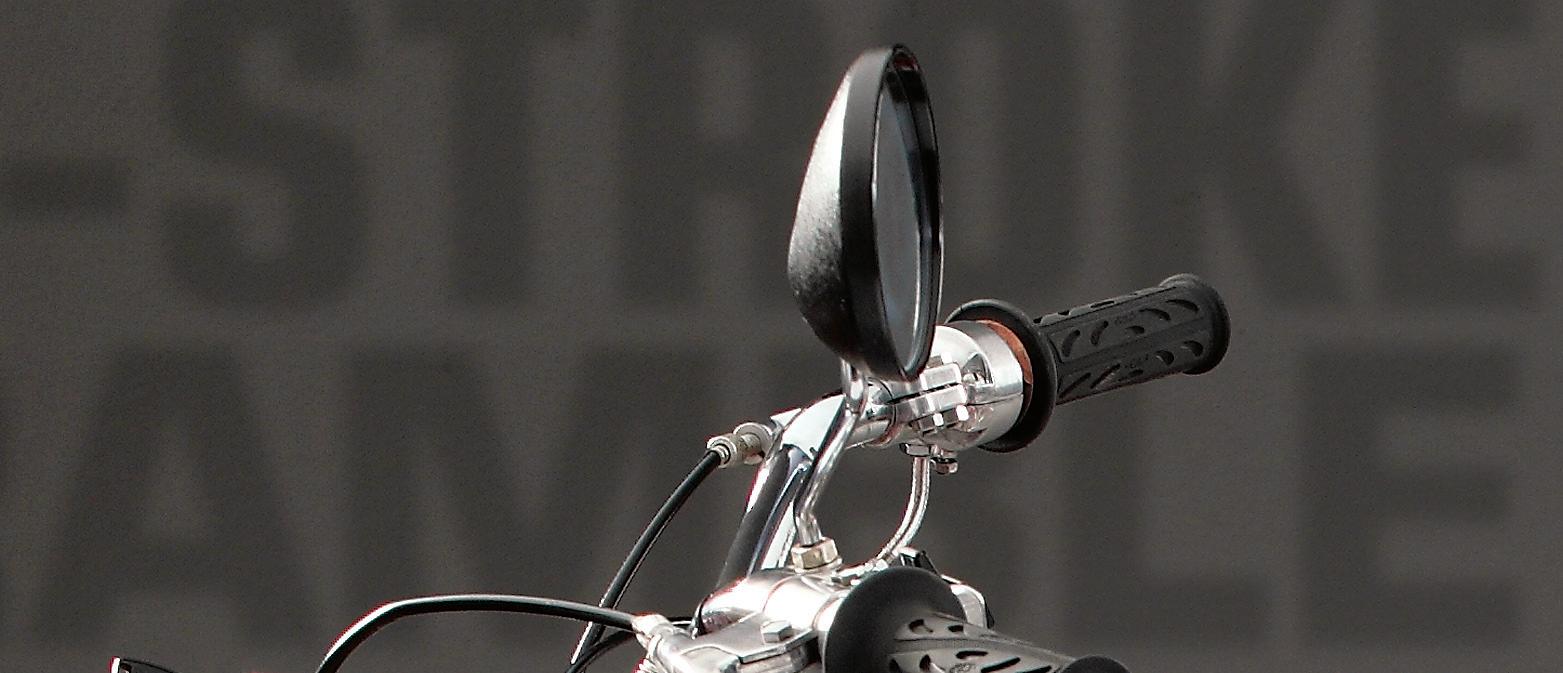







 1968 Yamaha Big Bear
Story by Greg Williams
Photos by Jeff Barger
1968 Yamaha Big Bear
Story by Greg Williams
Photos by Jeff Barger
YYamaha motorcycles have indelibly marked Al Roller. They had to. He grew up just 100 yards from the local Yamaha of Port Washington, Wis., dealership and his family — mom, dad, two sisters and brother — all rode trail bikes bearing the tuning fork badge. And — how cool is this? — Allen’s mom used to take him to school two-up on a 1973 Yamaha AT125.

“Motorcycling was a family affair,” Al explains. Born in 1969, Al was 8 when he got his first Yamaha, a 1976 GT80. Although many other Yamahas surrounded Al, the model he clearly


remembers the most is the 250cc Big Bear, a motorcycle that had very few changes to its architecture during a short production run from 1965 to 1968. “The older guys used to ride Big Bears around the dealership, and you knew they were special because they were loud and fast,” Al says.

Al went on to compete in motocross and stand-up jet ski racing, and his first street bike was a 1984 Yamaha FJ600. Motorcycles remain almost a singular passion for Al, now a toolmaker working at Strohwig Industries in Richfield, Wis. His family continues to ride, including his wife, Erica, and their three sons. One day, the boys will likely inherit Dad’s collection of vintage Yamahas, which continues to grow as Al can fund the purchases. Included among several other Yamahas in the garage are a 1975 RD250, a 1972 U7E (his mom’s first
in the garage are a 1975 RD250, a 1972 U7E (his mom’s first bike, and already something of a family heirloom), and a 1975 DT175 he just picked up.
www.MotorcycleClassics.com 85
A favorite discovered
Al’s favorite Yamaha might just be this 1968 Yamaha YDS-3C Big Bear Scrambler. Back in 2000, Al was at a local motorcycle accessory shop buying a helmet. That was when he noticed a “For Sale” ad posted to the bulletin board: “Big Bear Scrambler 250 Twin, $450 OBO,” it read. There were a couple of pull-tabs with the seller’s number, and Al followed up.
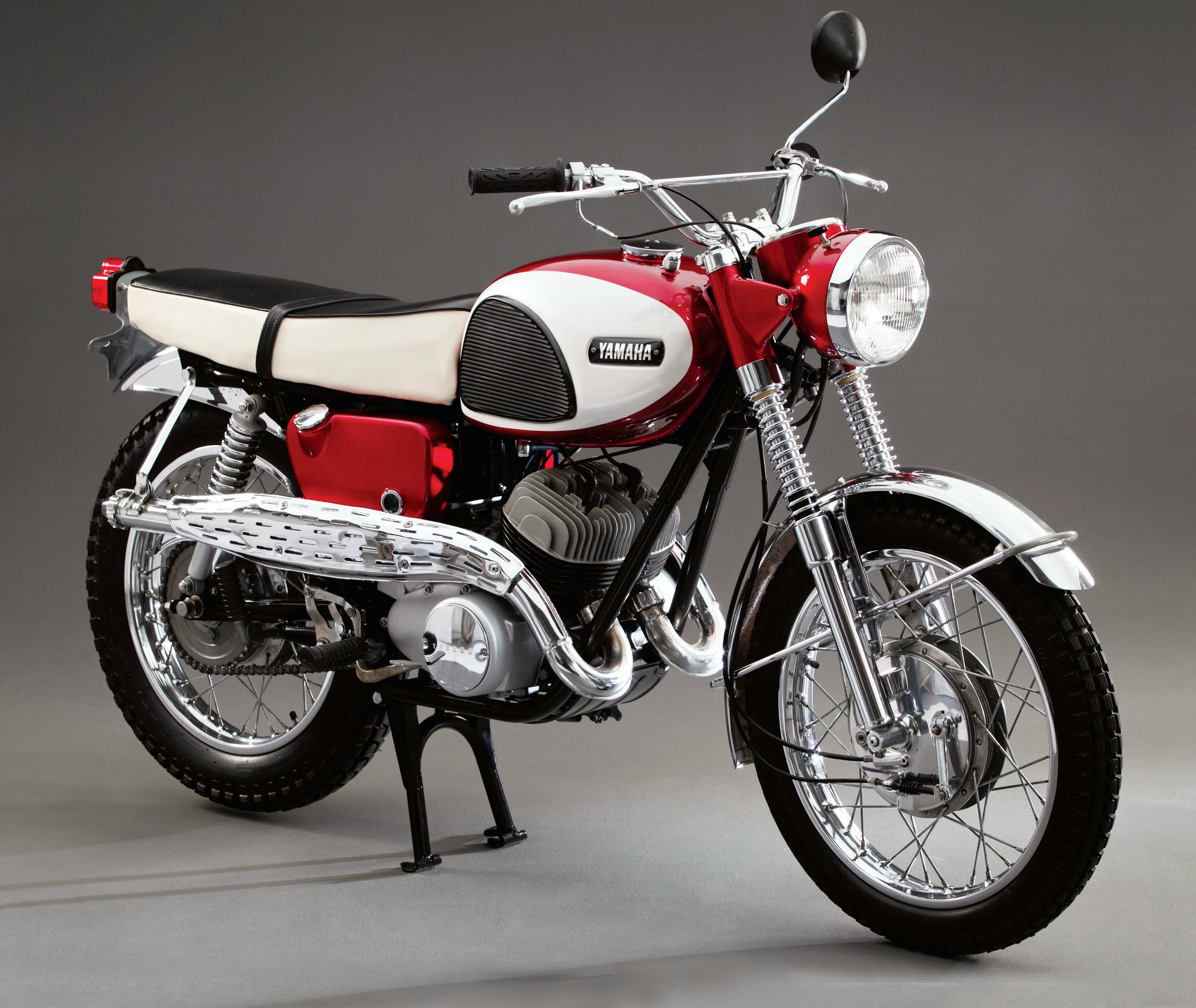
Al’s older brother Dan is an accomplished rider and worked for a time at the local Yamaha dealership. Al appreciates Dan’s knowledge of the brand. “My brother and I went to look the next day, and when I asked him if he thought
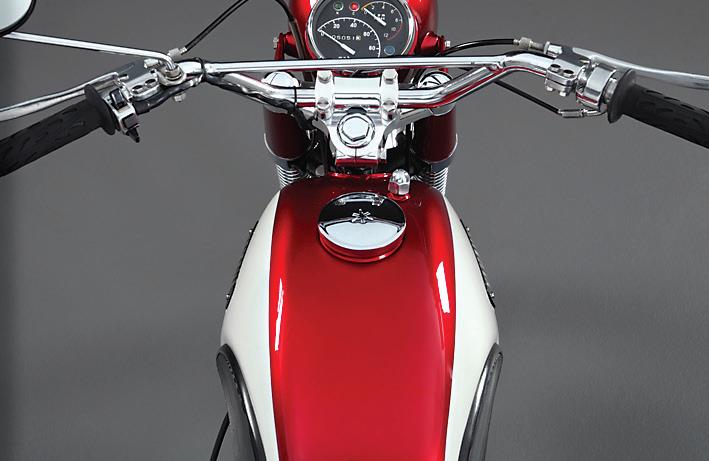

it was worth it, my brother said, ‘If you don’t buy it, I will,’” Al recalls. “I offered him $425 and he accepted, so it came home with me.”


















Although totally complete, the Big Bear looked like it had been sitting outside leaning up against a fence or outbuilding. The left side was sun faded, while the right side was in relatively good condition. Al considered the motorcycle to be a project he would eventually get to, but it was titled, registered and insured, and it ran. “It didn’t have baffles in it, and I’d ride it occasionally,” Al says. “It sounded very crisp and assertive.”
And it should. The YDS-3C Big Bear
1968 YAMAHA YDS-3C BIG BEAR
Scrambler evolved from the legacy of Yamaha’s twin-cylinder 2-stroke supremacy. In 1953, Genichi Kawakami was the president of Nippon Gakki in Japan. The company produced musical instruments, and there was extra capacity for another line of products. Kawakami settled on motorcycles, and the first bike, a 125cc 2-stroke single dubbed the YA-1, bore the name of one of Nippon Gakki’s founders, Torakusu Yamaha. The YA-1 signaled the founding of Yamaha Motor Co., Ltd., in 1955 and the construction of Yamaha’s first factory that same year.
Nicknamed the Red Dragonfly, the YA-1 was principally a copy of the 1939 German DKW RT125 featuring a unitconstruction 2-stroke single with an aluminum case and cylinder head, and designed by Hermann Weber. Plans for the DKW single were liberated postwar as a process of reparations,
and many other manufacturers, including BSA (Bantam) and Harley-Davidson (Hummer), built DKW-like singles. So did Yamaha.
The Big Bear
In 1957, Yamaha yet again copied a German design — the Adler MB250 — to create the 250cc twin-cylinder YD-1. Soon, the company had a successful formula with its 2-stroke twins, and the YD series prospered with the YD-3 street bike and the sportier YDS-2 in 1962.
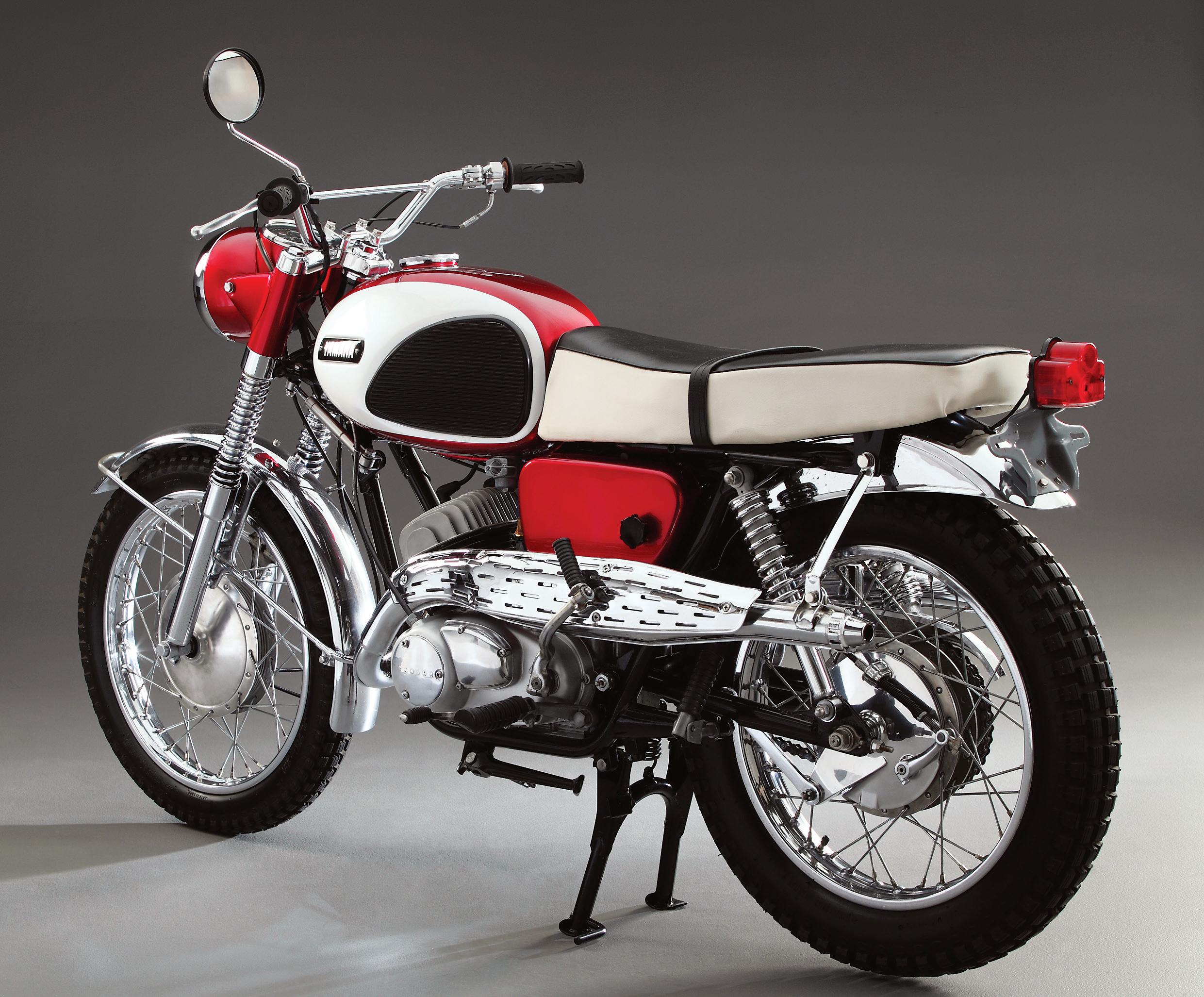
Yamaha’s big news for 1964 was Autolube, a major advancement in oil injection technology. Previously, 2-stroke engines required pre-mixing oil with the gasoline — often a gas tank cap had an oil cup built into the underside for “accurate” lube measurement in whatever ratio was required.
The 125cc Francis-Barnett Merlin, for example, with its Villiers 2-stroke, fea-
tured a built-in gas cap measure to aid meeting its required fuel/oil mixture of approximately 20:1.













Autolube first appeared on the 1964 246cc YDS-3 twin, a 2-stroke road-going sportster rated at 27 horsepower at 7,500rpm. Equipped with a 5-speed gearbox, double downtube frame and low-level exhaust, the 335-pound YDS-3 reached 76mph in 16.6 seconds in the standing quarter mile, as tested in the July 1964 issue of Cycle World
With the road-going YDS-3 gaining acclaim, in 1965, Yamaha introduced the YDS-3C Big Bear Scrambler. A major event on the racing calendar, the Big Bear Run pitted man and machine against the extreme conditions of the Mojave Desert and the San Bernardino Mountains. Yet Yamaha had never won a Big Bear, and some wondered what right the company had borrowing the name.
www.MotorcycleClassics.com 87
Regardless, based on the YDS-3’s 246cc twin-cylinder piston-port 2-stroke engine and frame, the 250cc Big Bear Scrambler was designed for street and trail. The Big Bear wore a high-level exhaust system, with one pipe for each cylinder. Shielded by elaborate chromeplated protectors, the pipes featured large, 18-inch long baffles, each one weighing 3 pounds! The baffles were removable after simply unscrewing an end cap. For their size, the baffles only slightly quelled noise, but without them, the din was shattering.

A cross-braced offroad handlebar sat atop a purposeful fork with exposed chrome springs, and a period Cycle test reported the suspension — both fore and aft — was stiffer than that found on a street-only Yamaha. An under-frame rock guard protected the engine, and the Big Bear weighed in at 350 pounds.

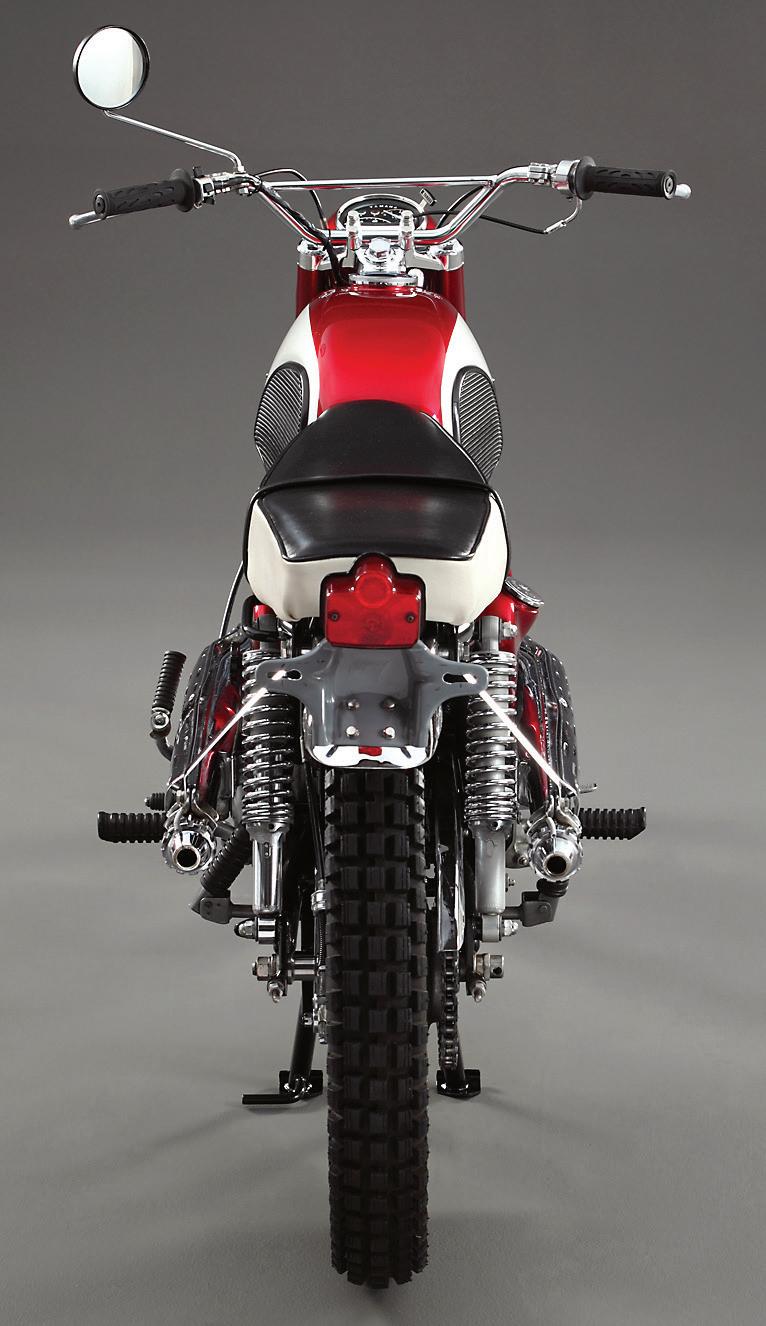
“It’s a stormer!” Cycle editors proclaimed in their July 1965 issue. “The Big Bear is definitely one of the hottest 250 street machines we have tested. But the Yamaha’s speed characteristics are individualistic in that there is a directly noticeable rpm range where the bike really ‘turns on.’ Above 4,500 rpm, the Big Bear
twin seems to ‘explode’ with power.”
Popular in their time and highly sought-after today, the 250cc Big Bear stayed in production with only mild updating through the 1968 model year. With offroad bikes getting more popular and more specialized, that same year Yamaha introduced the revolutionary 250cc DT1. The DT1 would return in 1969, but the Big Bear’s run was over.

Restoration time
In 2006, Al decided it was time to pay some attention to his YDS-3C. Pleased that his Big Bear ran and shifted cleanly through the gears, at first he planned
only to clean and detail a few pieces, but after removing the gas tank, airbox, oil injector tank and the seat, he didn’t stop. Soon, the bike was completely apart, its individual pieces bagged and tagged.
“My twin boys were born right around this time, and that financially strapped me,” Al says. “I had some time, but no money to really spend on the bike.” As a toolmaker, at work Al has access to sandblast cabinets, lathes and mills. He began cleaning and detailing all of the various subassemblies — whatever he could do himself without spending much money.
Al began by media blasting the frame, swingarm, engine guard and stands, followed by a layer of black powder coat paint. The fork required new tubes, as the originals were rust pitted. Those came from Speed & Sport Inc. in Bloomsburg, Pennsylvania.
Yamaha of Port Washington — family owned since 1967 — provided new points and condensers, and the fork seals. Other new-old-stock parts were found on eBay, but Al didn’t need much more.
As found, the Yamaha was surprisingly complete, and unlike many other restoration projects where rubber bits are
88 Motorcycle classics Street Bikes of the ’60s
Al Roller with his Big Bear (center). The non-stock mirror and pearlescent white paint are the only real deviations from stock.
Rated at a claimed 28 horsepower, the Big Bear’s 246cc 2-stroke twin traces its roots to Yamaha’s 1957 YD-1.
perished and control cables are shot, Al got lucky. He cleaned and detailed the cables, and resourcefully restored a single damaged footrest rubber. An end had been ground off one of the passenger peg rubbers, so Al machined an inner blank. With the blank pushed inside the rubber, he sprayed the outside with black undercoating, and the deceptive repair has held — more importantly, Al says, is that no one has ever noticed, either.
Al had the cylinders bored to the first oversize, fitting new pistons and rings in the freshly painted jugs. He blasted the heads and protected them with a high-temperature clear coat. The cases weren’t split, but Al detailed the raw aluminum and then spray painted the outer covers silver. Apart from sandblasting the clutch plates and rebuilding the dual 26mm Mikuni carbs, the engine didn’t require any other attention.
Al didn’t completely disassemble the wheels, but left them together to clean around the spokes and hubs. A little cash was offered to a tool polisher at work to restore the luster to the brake plates and the top fork triple tree. The brake shoes were in good condition, as were the hub bearings. “I’ve probably got 20 hours per hub, though, in steel wool and elbow grease,” Al says. Rims still wear their Yamaha chrome, and Al
installed new tires.
More parts would have been rechromed, but Al’s budget only allowed him to plate the fork springs and covers, top stanchion and triple clamp nuts, rear shock springs, the left exhaust pipe and both heat shields, and the rear pipe struts. The fenders are original and, thankfully, straight, and the previous owner had recovered the seat. Although
of the rebuild, this is where he dropped some dough — and the paint is where he deviated slightly from original. Overall the red/white paint scheme is correct. The candy-apple burgundy is matched as close to factory as possible, but instead of the plain white Yamaha used, Al opted for a pearl white. Matt Pape at Pape’s Chop & Drop Shop in Grafton, Wis., applied the paint.

Al was offered a brand new speedometer/tachometer assembly as a replacement, he opted to keep the original unit. “The old one works well, indicates the original miles and shows the bike is 46 years old,” Al says.
Al coated the inside of the gas tank before sending it and the oil tank, side cover, headlight and fork ears for painting. If he saved money on other parts
After a few minor wiring repairs, Al reassembled the Big Bear, adding an aftermarket mirror to make the machine street legal. He was done and riding the bike by mid-summer 2007. “Two kicks and it’s running,” Al says, adding that it’s a great machine to ride. “My daily rider is a 150 horsepower liter bike. When I’m riding the Big Bear and wind it out, it feels like I’m doing 150mph, and it’s really exciting and exhilarating. I get a big grin riding something this old, with only 28 horsepower as opposed to the 150 of my modern bike.”
Al’s Big Bear turned 5,000 miles at the 4th Annual Road America Motorcycle Classic show in June 2013. While there, he was encouraged to display the Big Bear in the annual Motorcycle Classics Vintage Bike Show and was stunned to be awarded Best Restored Japanese. It was fitting recognition for a lifetime steeped in the brand. MC
www.MotorcycleClassics.com 89
“The candy-apple burgundy is matched as close to factory as possible, but instead of the plain white paint Yamaha used, Al opted for a pearl white.”
TRIPLE HEADER


















Good press wasn’t enough to make Triumph’s new triple the home run Meriden needed

WWhen Triumph launched its new-for-1968 triple, the magazine motorheads took notice: “For you performance buffs, let us state that the Trident is the fastest street machine we have tested, bar none,” Cycle Guide enthused.

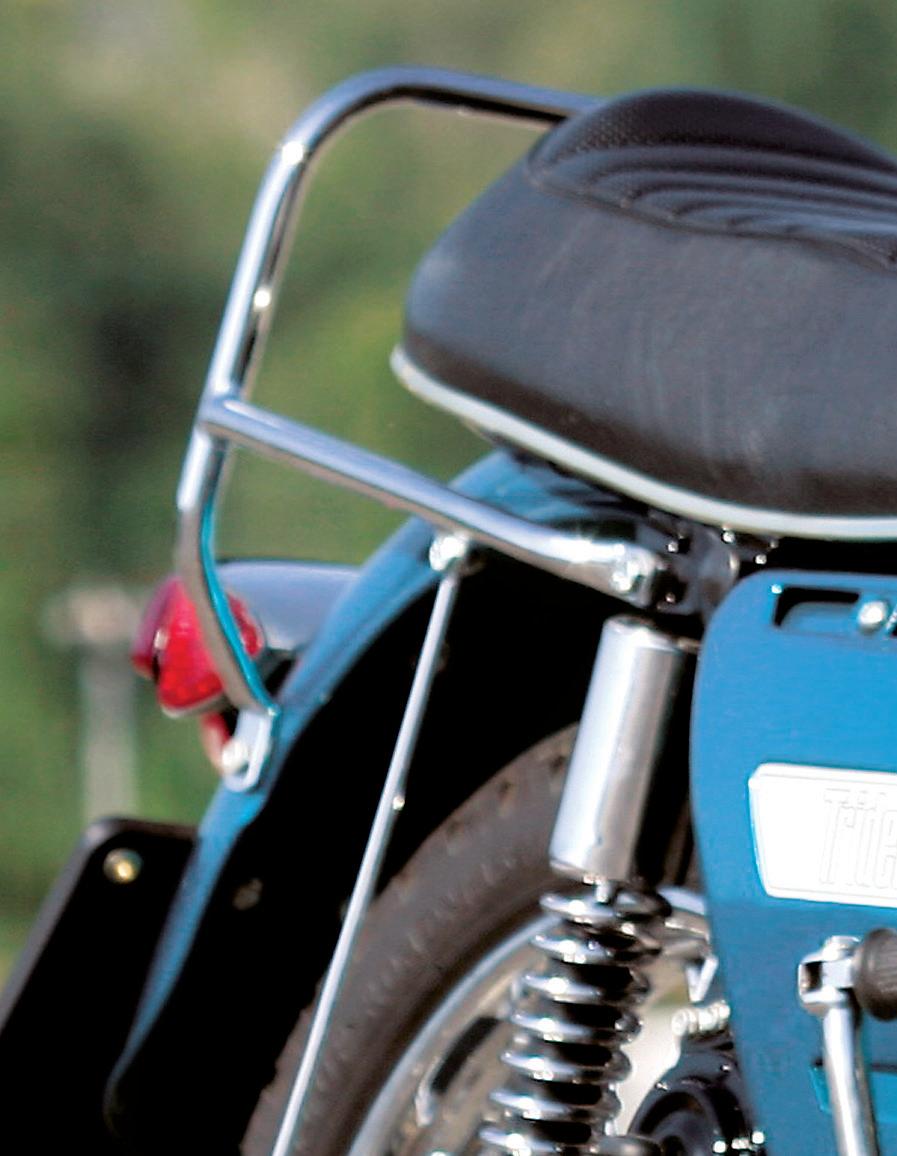

Brit mag Motorcycle Mechanics boasted: “What a fantastic machine! From a standing start to 100mph and back again in approximately 600 yards, plus a top speed of 130mph through the electronic timing gear!”
Back stateside again, Cycle World opined: “The Trident is a prestige motorcycle. An awesome number of people will find that third cylinder irresistible. It will mark its owner as surely as if he were to drive a 427ci hot pink Corvette Sting Ray among the swarming minicars of Triumph’s homeland. Single and twin cylinder bikes are commonplace; even Fours are offered by more than one manufacturer. But there is only one Three.”
The year was 1968, and it looked like Triumph had hit the bull’s-eye with its 58 horsepower Trident.
Years in the making


As early as 1963, Triumph engineering bosses Bert Hopwood and Doug Hele discussed the then-radical idea of a 3-cylinder road bike, but it wasn’t until the threat of a 750cc Honda loomed on the horizon that they got the go-ahead to develop the concept. Housed in a Bonneville frame, the first prototype Trident was completed in 1965, and Hopwood claimed that it was so good from the start that it could have gone into production immediately. But it wasn’t until the end of 1968 that the Triumph T150 Trident and BSA A75 Rocket 3 motorcycles were finally in U.S. dealer showrooms, while European riders had to wait until 1969.
But why BSA and Triumph versions of the triples? American importers needed something to replace the aged BSA twins and, as the BSA group owned Triumph, it was time for a little “badge engineering.” So there were two triples: one with the engine mounted vertically and the name Triumph on the tank, and the other with the cylinder block leaning slightly forward and the tank adorned with BSA badges.
90 MOTORCYCLE CLASSICS Street Bikes of the ’60s
Story and photos by Phillip Tooth

Separated at birth
The engine-gearbox units were mechanically identical, but the BSA unit had smooth, egg-like styling for the timing side to give the Rocket 3 just a hint of A65 (which BSA referred to as the “power egg” concept), while the Triumph engine had a triangular shaped timing side similar to the twins, with an individually shaped gearbox end cover.
This was possible because the crankcase casting was in three sections — the center portion extending back to include the gearbox, while two outer castings divided vertically from the center section. Unfortunately, this resulted in four vertical joints across the width of the engine, each a possible source of oil leaks.
In other respects both engines could be thought of as a Tiger 100 and a half, because the layout was pure Triumph, with the camshafts located fore and aft of the cylinders and gear-driven from the end of the crankshaft. Bore and stroke of each cylinder is a nearly square 67mm by 70mm, for a capacity of 741cc.
The frames were also different — the Trident had a beefed up Bonneville-style frame with a single downtube and a bolted-on rear frame, while the Rocket had a twin-tube, all-welded frame. Triumph-type forks with two-way damping and steel sliders and stanchions looked after the front end, with Girling shocks at the rear.

Other differences were mostly cosmetic: a ribbed seat for
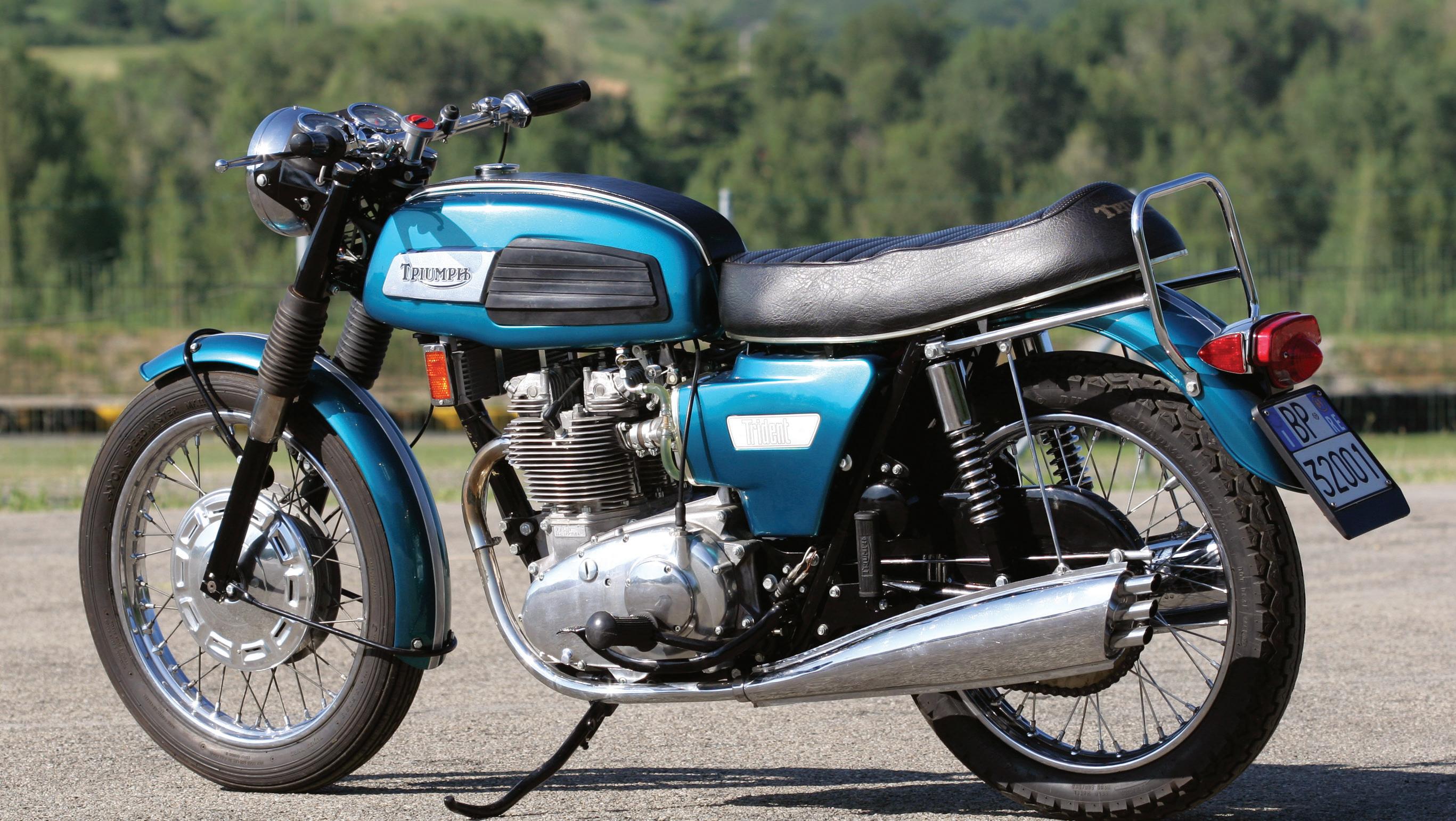
1969 TRIUMPH TRIDENT T150
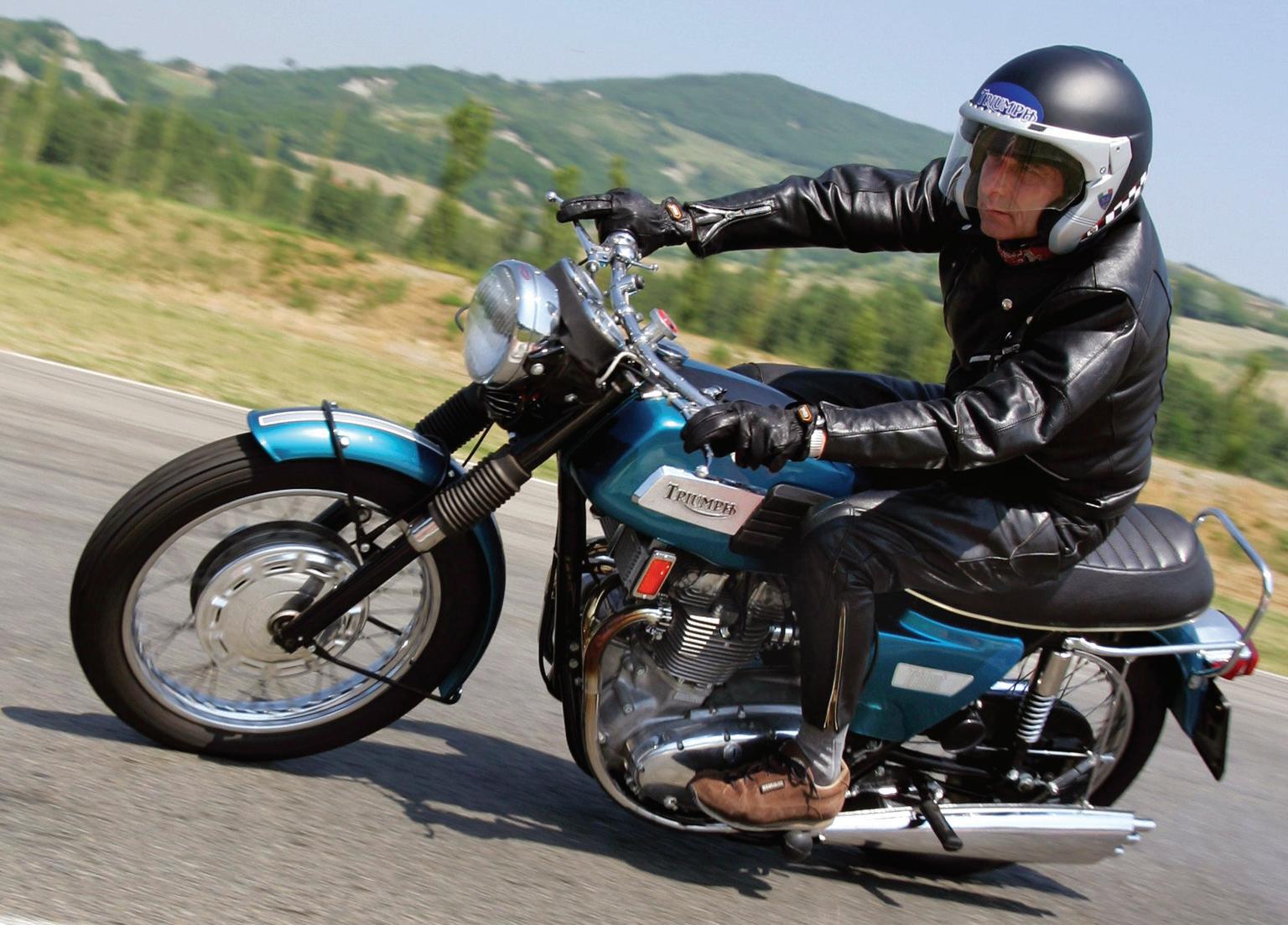
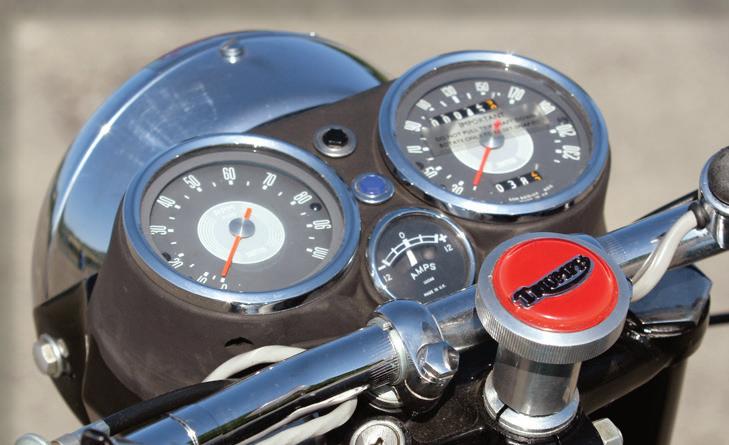
the Triumph and a smooth one with a humped back for the BSA, different grab rails, exposed shock absorber springs on the BSA and shrouded on the Triumph, and the usual Triumph braced front fender on the Trident instead of a pointy front fender with one stay on the Rocket. There were a few different bits of chrome strips and panels, and the BSA was finished in metal flake “Flamboyant Red” or “Flamboyant Blue” while the Triumph came in a sparkling Aquamarine.
The same at heart










But the important thing was the engine, both versions of which were made at the BSA plant in Small Heath, Birmingham, England. Hopwood and Hele had chosen a three because, with the crankpins set at 120 degrees, the even firing intervals would give exceptionally smooth running. And that crankshaft was a work of art — it was a forging, and initially the three crank throws were all in a line. Then they clamped the crankshaft in the center and twisted one end clockwise and the other end counterclockwise.
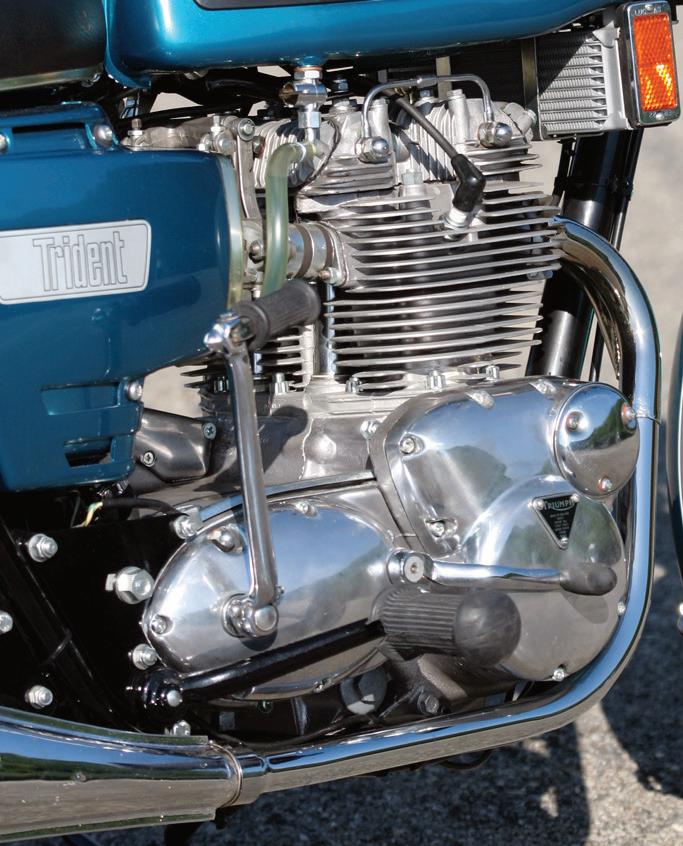
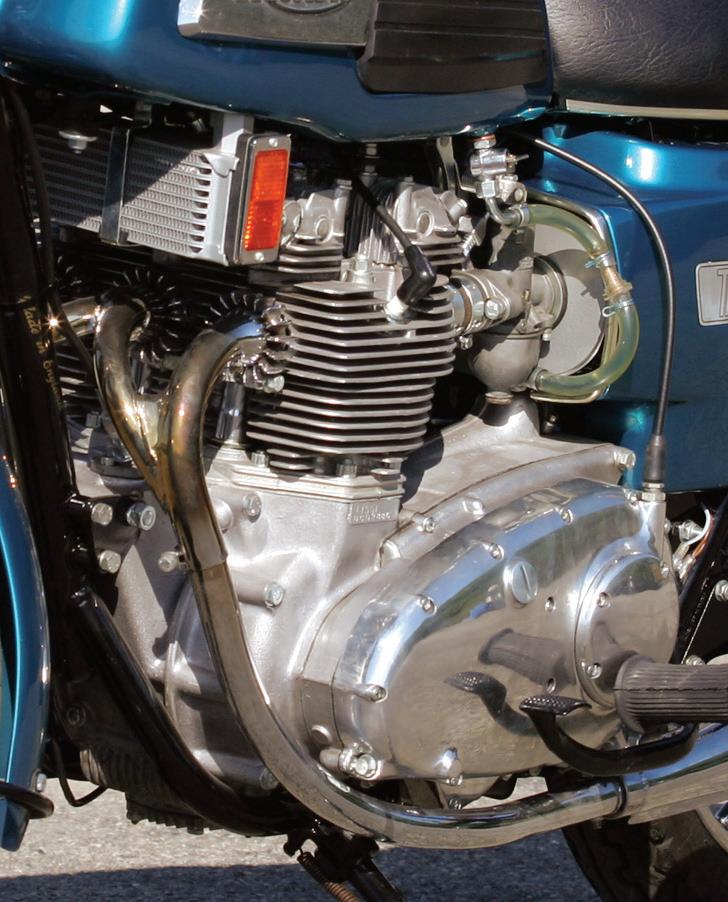
Four main bearings support the crankshaft, with the two center ones either side of the center cylinder being plain bearings. A ball race looked after the drive side with a roller bearing on the timing side. Big-ends have car-type plain bearings of 1-5/8-inch diameter, similar to the ones used on





the Tiger 100. Valve gear was pretty conventional, with pushrods operating the valves through short rockers. Aluminum cylinder barrels were generously finned to keep the engine running cool, while a gear-type oil pump circulated lube three and a half times quicker than the plunger pump of the Bonnie. There was also an oil cooler mounted in front of the engine under the gas tank as standard. Three rubber-mounted 27mm Amal Concentrics took care of the fueling. The exhaust system was a bit more of a challenge for the design team, who decided to split the center pipe in two as soon as it came out of the head. These two pipes are siamesed into their outside neighbor, ending with those famous “Ray Gun” silencers.
Lucas provided the 12-volt alternator electrics, with three separate contact breakers so that the ignition system could be
www.MotorcycleClassics.com 93
The Trident’s 58hp triple sits vertically; in the BSA Rocket 3 it’s canted forward 15 degrees.
The engine spins quickly and freely past 8,000rpm as the exhaust note changes from a barely audible woofle to an urgent whine.






Slab-sided gas tank and “Ray Gun” mufflers look cool today, but were just plain weird in 1968, keeping sales slower than hoped. It didn’t help that Honda announced the CB750 Four the same year.


set up perfectly — something you couldn’t do with a car-type distributor. Of course, that also meant timing on any one cylinder could knock out of synch.
Primary drive was looked after by a triplex chain and single-plate diaphragm spring clutch, said to be a modified version of the Borg & Beck unit used on the Mini Cooper S. There were just four ratios in the gear box, with top gear giving a relaxed 10mph for every 650rpm — or exactly 6,570rpm when cruising at 100mph.
Heavier, but more powerful
Weighing in at a hefty 468 pounds before a drop of gas was sloshed in the tank, the Trident was not going to be as nimble as a Bonnie. In fact, Malcolm Uphill, who had lapped the Isle of Man TT course at a 99.99mph race average in the 1969 Production TT, wanted to stick with the lighter twin for the 1970 event before being convinced that he could win with the more powerful triple.
If you’re lucky enough to ride one, you’ll discover the Trident’s handling has a nice taut feel to it, and the weight makes it seem more planted to the ground — and that’s a nice feeling when you are blasting along at high speed with the throttle pinned.
The engine spins quickly and freely past 8,000rpm as the exhaust note changes from a barely audible woofle to an urgent whine, but there is little torque below 3,000rpm. That doesn’t mean the Trident is a handful around town — in fact it’s as docile as a kitten. But you have to slip the clutch until those 3,000 revs are dialed in, especially with a passenger. Then the Triple takes off like a scalded cat.
Be warned, however: The twin-leading-shoe front brake might look impressive, but it’s barely up to hauling such a heavyweight
projectile down from the high speeds this Brit bike is capable of. The gas tank holds 4.25 gallons of fuel, barely big enough for a high-speed cruiser as the precious liquid can disappear down the pipes at a rate of a gallon every 30 miles if you really screw it on.
While the Trident came here in 1968, the first time British enthusiasts got the chance to look over a production Trident was at the Brighton Motorcycle Show in April 1969. Unfortunately for Triumph, Honda managed to get the spanking new CB750 Four into the country in time for a surprise appearance. With an overhead camshaft engine, electric start, disc front brake and a 5-speed gearbox, the Japanese bike took the shine off the new Trumpet.
Worse was to come. Although the Honda cost European riders a bit more than the Trident, in the U.S. it was the opposite, setting a new owner back just $1,495 — nearly $300 less than the Triumph. Ouch.
That didn’t mean they didn’t sell. About 20,000 T150 Tridents were produced, plus around 7,000 Rocket 3s and another 7,000 electric start, 5-speed T160 Tridents that were introduced for the 1975 season. But despite some outstanding achievements on the race track at Daytona in 1971 and with Slippery Sam at the Isle of Man, the Triumph-BSA triples could not compete with Japanese fours in the showroom. MC
www.MotorcycleClassics.com 95
Trident’s no lightweight at 468 pounds dry, but still fast.
PARTING SHOTS




A Grand Day Out
Iawoke to a beautiful summer’s morning, keen with the desire to ride my fine example of a motorcycle, my Norton Commando. I opened the garage door and inhaled the heady aroma of gasoline, oil and metal, the perfume worn by the Norton that I find so intoxicating. Today would surely be a grand day!
I checked a few points as any good rider does. Off with the seat to look in the oil tank. Hmm, quite low. It was probably a bit thirsty through the night, so I topped it up with the finest Kendall 50 weight. Next, I swung out the kick start lever. Actually, better see to the lever as it has wandered rather far out on the spline. A quick adjustment, a hit with a hammer, retighten it, and now I am ready to go!
I turned the main gas tap on. Damn! The thing is so old and dried up that it practically snaps off in my hand. I will attend to it as soon as I return from my ride. Key and gas on, I prime the carbs. Whoops! The tickler is stuck down and gas is flooding from the right hand carb. Jiggling the tickler, plus just the lightest tap from my hammer, fixes it good as gold. I’m ready to go.
Key on, gas on, carbs flooded, a hint of throttle and a mighty kick. S@#%! It hurts like hell when the kickstart misses a cog and you hyper-extend your leg through to the point where your shin cracks into the foot peg. I try again. Nothing! A quick examination reveals the ignition wire has fallen off, due no doubt to the vibration from the mighty engine. It’s no job to put that on right. Key on, gas on, carbs flooded, bit of throttle, a mighty kick and VROOM! The beast roars into life.
I step off the bike to put on my helmet and gloves as the beast warms up. Oil begins to pour out of the oil tank cap. No matter, probably a sign of an efficient engine that just doesn’t need much oil. The mess cleared up, I prepare to set off on this grand day.





I engage first gear, and the engine dies with a clunk. The clutch appears to be a bit tight. No matter, a quick session with the wrenches and we’re ready. After restarting the engine, I engage first gear and feed power in from the











mighty engine. We’re underway. What a grand day this will be! I try to stop at the street corner but coast right through. The brakes are no doubt worn from trying to reign in this magnificent beast. I’ll attend to them upon my return. The sun is shining and I pick up speed and shift into second. The rubber on the end of the gearshift falls off. No matter, I can get another. I hit the open road, select third, then fourth, and the Norton and I settle in to a steady pace. The beast chews up the tarmac. Something goes POW on the right hand side and I coast to a halt beside the road.
There is an unusual tinkling sound, plus dense black smoke coming from the right-hand side. It is stinking hot so I remove my leather jacket and have a closer look. I remove the spark plug and find the electrodes jammed shut! Must have been a faulty plug. I shall speak to the guy at Canadian Tire as soon as I return. I restart the bike with the plug still out and a well pounded slug of gray metal spits out into my hand. The power of this engine! It spits out pieces it doesn’t need! I adjust the plug, put it back in, and restart. It runs OK but idles pretty rough. Canadian Tire is really going to hear about this.
I put it in gear, let out the clutch, and the bike doesn’t move. The master link has fallen out and the chain has fallen off the sprockets. Canadian Tire had better be prepared for a full dressing down. I install a spare from the small kit I carry in case of roadside emergencies. This kit contains spark plugs, oil, tools, oil lines, cables, nuts, bolts, fuses, an inner tube, the manual, wire, master links, alligator clips, carburetor jets, bungee cords, light bulbs, cable ends, tire valves and a rag.
The day is getting on and I did promise to be home in time to do some other chores. It’s a grand day for it, too. I turn around and ride the two blocks back home, a smile on my face because I am riding a Norton Commando, the finest classic motorcycle there is. I put the beast away in its special spot in the garage, giving it a loving pat for such a grand day out. People who own Japanese machinery do not have any idea what it’s like to own and ride a true classic. I pity them.
— Cam Norris, proud owner of a 1969 Norton Commando S

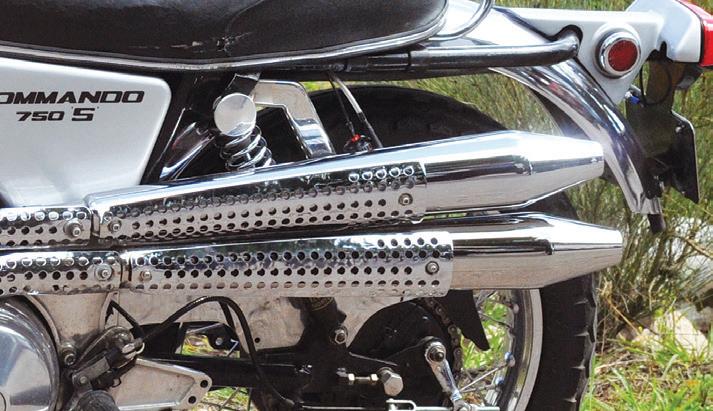



PARTING
SHOTS
96 MOTORCYCLE CLASSICS Street Bikes of the ’60s
KARL JARVIS
ADAPTIVE



The revolution has begun!

J.W. Speaker has developed a breakthrough in technology for night time riding. The bright and precise light pattern of the Adaptive Motorcycle Headlights™ intelligently adjusts for provide maximum comfort and safety for the rider.



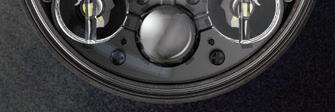


Available as a plug & play upgrade for 7" round and 5.75" round headlights, and more!

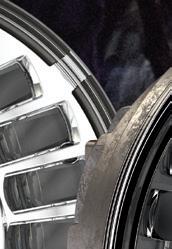
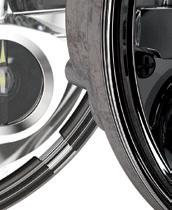






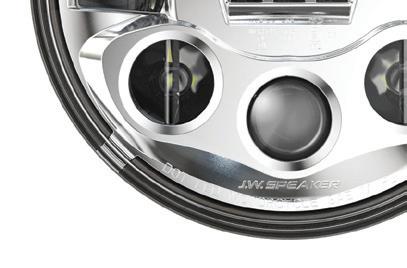



THE WORLD’S FIRST
LED MOTORCYCLE HEADLIGHT
Embedded sensors calculate bank angles in real-time to direct light as the motorcycle leans, filling the dark areas when cornering.
the Adaptive Headlight for your bike at www.jwspeaker.com/Classics
Bank angle
Find
THE LAS VEGAS MOTORCYCLE AUCTION
Thursday 25 January 2018
COMPLIMENTARY AUCTION APPRAISAL REQUEST

To discuss any aspect of selling or buying Collectors’ Motorcycles at auction, please contact the Los Angeles office, Bonhams representative or visit bonhams.com/ motorcycles to submit a Complimentary Auction Appraisal Request



ENTRIES NOW INVITED
MOTORCYCLES (LOS ANGELES) +1 (323) 436 5470 motorcycles.us@bonhams.com
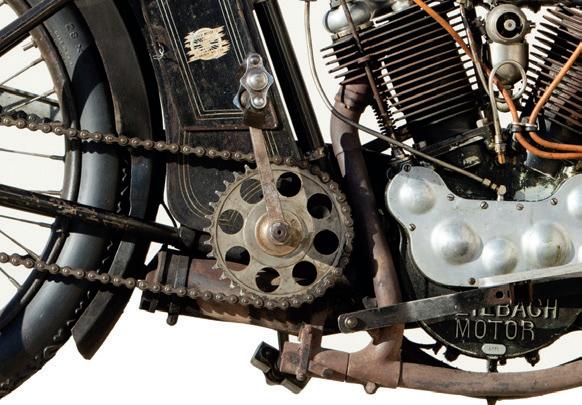
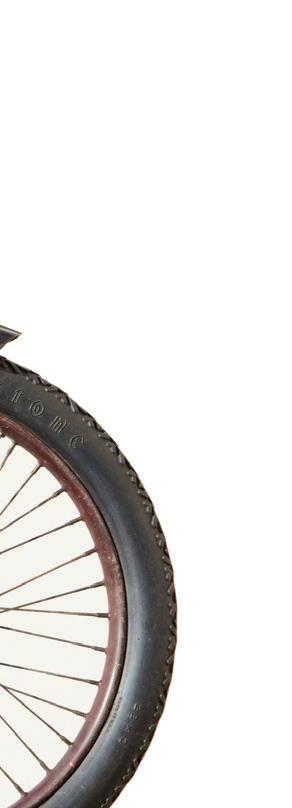

MOTORCYCLE REPRESENTATIVES
David Edwards +1 (949) 460 3545 david.edwards@bonhams.com
Tim Parker +1 (651) 235 2776 tim.parker@bonhams.com
1914 FEILBACH LIMITED 10HP Sold for $195,000

RARE ‘ONE-OF-ONE’ BLACK SHADOW VARIANT IN CHINESE RED, CONFIRMED BY THE VINCENT OWNER’S CLUB 1951 VINCENT SERIES C ‘RED’ WHITE SHADOW Sold for $434,000
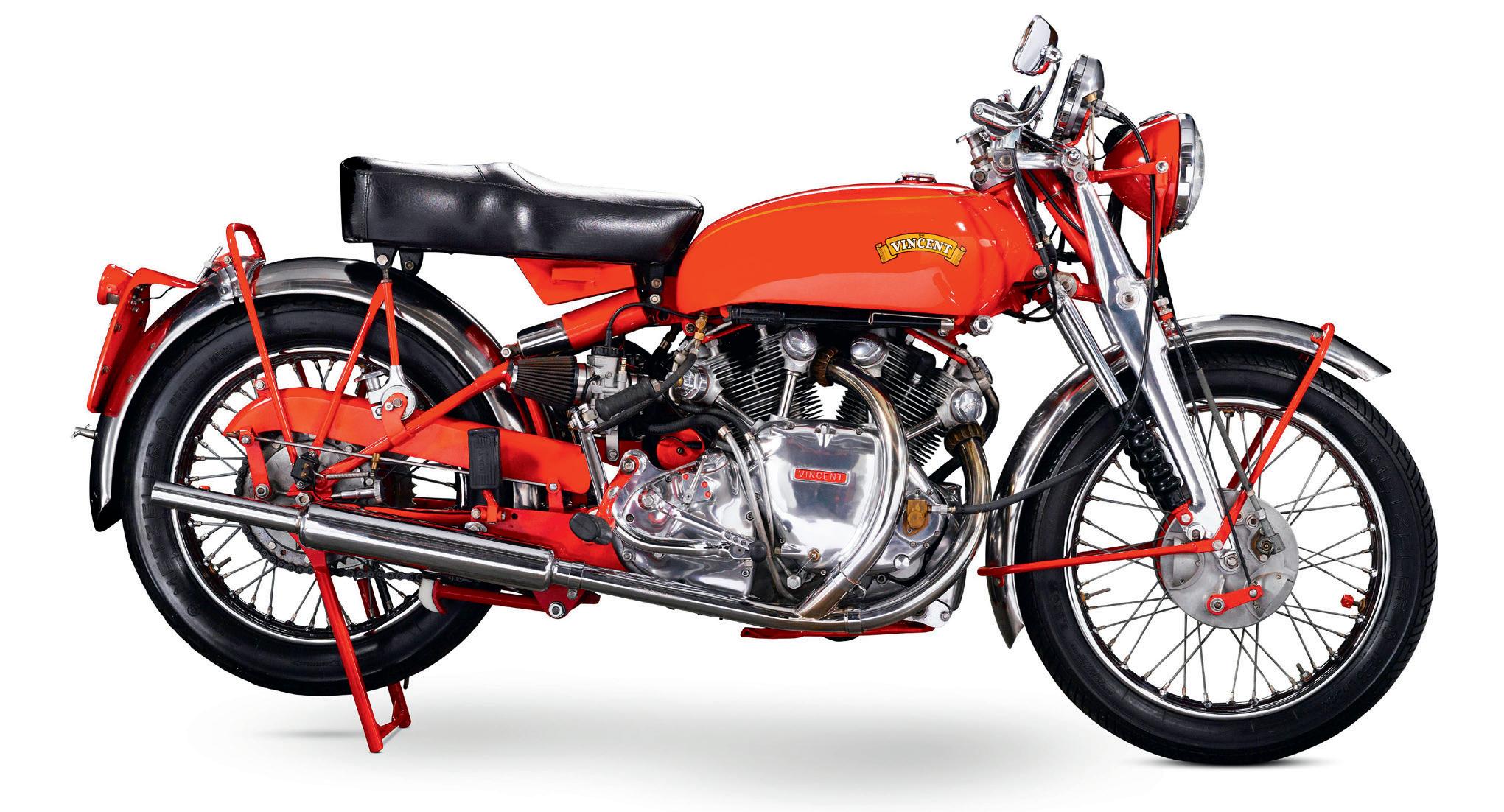
bonhams.com/vegas

 ©2017 Bonhams & Butterfields Auctioneers Corp. All rights reserved. Bond No. 57BSBGL0808
©2017 Bonhams & Butterfields Auctioneers Corp. All rights reserved. Bond No. 57BSBGL0808





































































































































 1932 BROUGH SUPERIOR SS80 DE LUXE $70,000 - 85,000
1911 PIERCE FOUR $100,000 - 150,000
1913 HENDERSON 1,068CC FOUR $90,000 - 115,000
1914 EXCELSIOR SINGLE 2-SPEED $40,000 - 50,000
1949 VINCENT 998CC BLACK SHADOW SERIES-C $65,000 - 75,000
The ex Ivan Mauger, 1968 World Championship Speedway Final winning, 1968 JAWA SPEEDWAY RACING MOTORCYCLE $15,000 - 22,000
1969 MV AGUSTA 750S $65,000 - 85,000
1912 PIERCE 592CC SINGLE $50,000 - 65,000
The ex-Ivan Mauger, 1977 World Championship Speedway Final winning, 1977 JAWA SPEEDWAY RACING MOTORCYCLE $15,000 - 22,000
1932 BROUGH SUPERIOR SS80 DE LUXE $70,000 - 85,000
1911 PIERCE FOUR $100,000 - 150,000
1913 HENDERSON 1,068CC FOUR $90,000 - 115,000
1914 EXCELSIOR SINGLE 2-SPEED $40,000 - 50,000
1949 VINCENT 998CC BLACK SHADOW SERIES-C $65,000 - 75,000
The ex Ivan Mauger, 1968 World Championship Speedway Final winning, 1968 JAWA SPEEDWAY RACING MOTORCYCLE $15,000 - 22,000
1969 MV AGUSTA 750S $65,000 - 85,000
1912 PIERCE 592CC SINGLE $50,000 - 65,000
The ex-Ivan Mauger, 1977 World Championship Speedway Final winning, 1977 JAWA SPEEDWAY RACING MOTORCYCLE $15,000 - 22,000

 Photos by Nick Cedar
Photos by Nick Cedar










































 1969 Ducati 350 Mark 3 D
Story by Greg Williams
Photos by Jeff Barger
1969 Ducati 350 Mark 3 D
Story by Greg Williams
Photos by Jeff Barger



























 Photos by Ken Richardson
Photos by Ken Richardson





























 1962 BMW R60/2
The Albert mirrors are a period accessory (far left). The tool kit hides in a recess in the fuel tank.
1962 BMW R60/2
The Albert mirrors are a period accessory (far left). The tool kit hides in a recess in the fuel tank.








 Story
Story






































































































































 Photos by Sedrick Mitchell
Photos by Sedrick Mitchell





































































































 Story by Greg Williams
Photos by Jeff Barger
Story by Greg Williams
Photos by Jeff Barger

























 Story and photos by Neale Bayly
Story and photos by Neale Bayly









 1967 TRIUMPH T120 BONNEVILLE
1967 TRIUMPH T120 BONNEVILLE

























 Photos by Gary Phelps
Photos by Gary Phelps


























 Blair, co-creator
Bob Blair samples the prototype Ducati Apollo at ZDS Motors, December 1964.
Blair, co-creator
Bob Blair samples the prototype Ducati Apollo at ZDS Motors, December 1964.




































































 Photographs by Nick Cedar
Photographs by Nick Cedar





























 geezer
Story and photos by Robert Smith
geezer
Story and photos by Robert Smith

























 1968 Yamaha Big Bear
Story by Greg Williams
Photos by Jeff Barger
1968 Yamaha Big Bear
Story by Greg Williams
Photos by Jeff Barger























































































 ©2017 Bonhams & Butterfields Auctioneers Corp. All rights reserved. Bond No. 57BSBGL0808
©2017 Bonhams & Butterfields Auctioneers Corp. All rights reserved. Bond No. 57BSBGL0808